Latest News Archive 2012
 Radioactivity MA Marine Aggregates ML Marine Legislation BW Bathing Water MR Marine Reserves RE Renewable Energy OA Ocean Acidification PO Pollution FI Fisheries GW Global Warming CE Coastal Erosion
Radioactivity MA Marine Aggregates ML Marine Legislation BW Bathing Water MR Marine Reserves RE Renewable Energy OA Ocean Acidification PO Pollution FI Fisheries GW Global Warming CE Coastal Erosion
May 2012
MR Historical scientific study confirms the importance of marine reserves
FI Essex fisherman faces £395,000 fine or jail for flouting fishing quota
MR New evidence that marine reserves are supporting fish populations
FI Fishing observers 'intimidated and bribed by EU crews'
PO Southwold oil tanker decision imminent
FI £1 million confiscated from leading trawler captain in Scottish "black fish" crime
 Romney Marsh, Kent, mooted as nuclear high-level waste dump
Romney Marsh, Kent, mooted as nuclear high-level waste dump
Misc Paul Watson, Sea Shepherd, facing possible "extradition" to Costa Rica from Germany
PO North Sea gas leak is sealed
MR UK marine reserves described as little other than "paper parks"
Misc Paul Watson, founder of Sea Shepherd, arrested in Germany
FI Global eel population has declined by 99% during last three decades
GW Warm water species spreading into UK seas, including bluefin tuna
ML European Parliament's Environment Committee makes clear recommendations on CFP reform
RE UK and Denmark to explore electricity "supergrid" connection
BW PO Wet April causes "poor start" to water quality for UK's 2012 sea bathing season
FI ML Action to protect albatrosses in the Indian Ocean
FI Senegal cancels the licences of foreign fishing trawlers
 Speculation that China will invest in new UK coastal nuclear power stations
Speculation that China will invest in new UK coastal nuclear power stations
MA Hallsands revisited — the first evidenced case of dredging induced erosion
CE Happisburgh Houses meet their fate
PO £5m upgrade for NI Water treatment works
ML EU and Defra Workshops struggle to define MSFD Descriptor 3 for commercial fish stocks
April 2012
ML Evidence of longer-term thinking at EU Fisheries Council meeting
CE Further hazards from erosion
ML EU Parliament's Environment Committee tables its amendments to the new draft CFP Basic Regulation
FI Defra says trials to reduce fishing discards are a success
FI The selling of fish being widely "mislabelled" as to species and origin throughout the EU
FI MARINET advises UK Government that EU funding of fisheries must re-establish "food security"
CE Easton Broad could receive increased protection
MR Welsh Government announces public consultation on its Welsh MCZ site selection
PO GW Gas fracking gets the green light in the UK
 French company wants "more incentives" before proceeding with new nuclear plant in Cumbria
French company wants "more incentives" before proceeding with new nuclear plant in Cumbria
Misc "The Sounding of the Whale" — Book Review
Misc Emperor Penguin populations are counted from space
CE Happisburgh homes meet their demise
Misc Should the annual Canadian seal cull continue?
PO Arctic oil rush will ruin ecosystem, warns Lloyd's of London
RE Network of seabed cables to connect UK to alternative energy sources
RE UK government offers £20m "prize fund" to wave and tidal energy developers
PO Awareness and action over marine plastic pollution is beginning to develop
MR C.O.A.S.T. seeks re-establishment of the "flame shell" in Arran's coastal waters
Misc Surprising history revealed at the opening of new British surfing museum
ML Pacific tuna fishing ban is modified
FI Overfishing off West Africa jeopardises political stability of W. African states
GW Oceans started warming 135 years ago, and are now absorbing 90% of overall planetary warming
Misc USA's NASA creates video visualisation of World's ocean currents
PO Surfers Against Sewage launch "Think Before You Flush" campaign
CE "Catastrophic cliff and promenade failure" at Clacton
FI ML EU and "fish pirates" are destroying West African fisheries
FI Misc Trawlers netting archaeological treasures as well as fish
 Withdrawal of German companies creates uncertainty over future of UK nuclear power generation
Withdrawal of German companies creates uncertainty over future of UK nuclear power generation
March 2012
PO Great Barrier Reef under threat from agricultural pesticides
PO Deep sea corals severely damaged by BP's Gulf of Mexico oil spill
Misc Record submarine dive to the deepest point in the oceans
ML Norway urges EU to ban fish discards
ML UK in "a minority" in attempting to secure fishing discard ban
FI Scottish "black fish" scam compared to major bank robberies
MR South Georgia announces creation of large Marine Protected Area
RE Donald Trump funds anti-offshore wind farm campaign
Misc 33 species of seabirds in British Overseas Territories on "endangered list"
 Sizewell residents want emergency zone consideration
Sizewell residents want emergency zone consideration
CE Another new EA flood and coastal risk consultation
 CE 12 of Britain's 19 nuclear sites at risk from flooding and coastal erosion
CE 12 of Britain's 19 nuclear sites at risk from flooding and coastal erosion
FI Misc Over-fishing and rats implicated in continued serious decline in global seabird populations
PO New control of polluting emissions to air will be expensive for shipping industry
FI Suggestion that Government funded fish marketing agency knew about Scottish "black fish" crime
Misc Coastguard Station battle continues
Misc Coastal region aims for extra recognition
 UK nuclear sites at risk of flooding, report shows
UK nuclear sites at risk of flooding, report shows
PO Mining for coal and gas exploration threatens Australia's Great Barrier Reef
MR 5 new Special Areas of Conservation proposed in Scottish seas
ML EU Commissioner Damanaki calls for "commitment to CFP reform"
FI Essex small boat fishermen in court for breaching quotas
CE Your response SMP/SEA needed — again!
FI High Court hears evidence and convicts on massive "fish quota fraud" in Scotland
PO 46% of Ireland's sewage treatment plants fail the Urban Waste Water Treatment Directive
RE UK could lead on marine renewables industry
RE First Scottish Commercial Wave Power Array Approved
FI New study suggests the world's fisheries are in an even worse state than feared
FI World economy losing $50 billion each year due to over-fishing
MA MARINET responds to attack from Marine Aggregate Industry
February 2012
CE Meeting on erosion concern at Pagham and Sidlesham, E.Sussex
MR Marine reserves need to be "dynamic and mobile" rather than fixed
RE Waves and tides could provide one-fifth of UK's power
PO European Parliament wants tighter controls on pollution from marine fuels
FI Illegal trawler fined record £8,000
 Coastline fund to alleviate nuclear store impact
Coastline fund to alleviate nuclear store impact
RE Consultation on plans for one of the world's largest wind farms off Suffolk coast
MA Coalition appeals against dredging permit for Coos Bay
MA Gower Offshore Dredging opposed
FI "There are plenty more fish in the sea" — is this true?
FI Rebuilding EU fish stocks would generate £2.7 billion and 100,000 jobs
Misc Most fish in the sea evolved on land
PO The threat of Microplastics
CE Marram replanting Protection
FI Canadian campaigner against salmon farming is sued and taken to court by Norwegian company
MR Mexican Marine Reserve reveals how a Degraded Fishery can recover
MR The alliance against Blakeney Salt Marshes MCZ gains new voices
CE Saving Overstrand from the SMP dictate
MA Dredging Licence deadlines extended
CE Flood Defence Funding — an utter paradox
FI Prince of Wales launches campaign to combat global over-fishing
FI Al Jazeera investigates the multi-million dollar illegal fishing trade
PO Norfolk Wildlife Trust & RSPB fear Habitat Directive adulteration
RE Wave-power costing less than 2p per KWh
CE Happisburgh homes being demolished
Misc Photographs of Caribbean deep sea vent and a previously undiscovered species of shrimp
PO "Seas At Risk" NGO urges adoption of marine litter reduction targets
Misc Risk of "bird strike" at proposed Thames estuary London airport
January 2012
PO 86% of ocean debris is plastic
RE Renewable Energy Marine Park planned for SW England
 Generation IV Fast Reactor rejected for Sellafield
Generation IV Fast Reactor rejected for Sellafield
MR California's Central Coast Kelp Forest captured on film
MR Strong community support, including amongst fishermen, for new Isle of Man marine reserve
 Independent study says UK Government "stress test" of nuclear power plants was inadequate
Independent study says UK Government "stress test" of nuclear power plants was inadequate
CE 'Human rights at risk' in Shoreline Management Plan
CE True Costs of Coastal Abandonment
CE MA Sea defences for Dungeness nuclear power station threaten surrounding SAC
PO Ships could move from fossil oil to algal oil as their fuel
PO Further concern over oil tanker transfers at sea
 New study records evidence of excess childhood leukaemia around nuclear power stations
New study records evidence of excess childhood leukaemia around nuclear power stations
Misc Could quotas for catching whales lead to their better protection?
Misc 15 new species found in Scottish seas during 2011
Misc Exotic creatures found in Indian Ocean hydrothermal vent, but mining is about to commence
PO CE MA MARINET takes Dredging threat to Parliament
GW Canadian seal cull "unnecessary due to climate change"
ML Spain faces crunch-time over CFP Reform
FI One Bluefin tuna fish sells for nearly £500,000
Misc Pale octopus, hairy-chested yeti crab and other new species found in Southern Ocean
CE GW €3 billion plan to protect Belgium's coast against North Sea sea-surge
Misc Sea Shepherd uses airborne "drones" in its Southern Ocean whaling campaign
Misc Exceptional marine algal event covers seafront near Blackpool in foam
CE GW East Anglian Film Archive film of the last major North Sea surges
PO Now New Zealand's 'Worst Maritime Disaster'
MR Defra is looking for contractors to establish the scientific basis for "recommended MCZs"
Historical scientific study confirms the importance of marine reserves
MARINET feels it is instructive to revisit this article, written by Emma Young, San Francisco, which originally appeared in The New Scientist, 19th February 2001, and which reports on evidence presented to the American Association for the Advancement of Science meeting in San Francisco.
"Vast networks of marine reserves are essential if the world's threatened fish stocks are to be saved, says a group of ocean experts.
Fishing is currently banned in just 0.1 per cent of the world's oceans. This should rise to 30 per cent, says a team of scientists working through the US National Centre for Ecological Analysis in Santa Barbara, California.
Fishing communities are likely to oppose the proposals. But the results of the team's two and a half-year research programme suggests marine reserves boost local fishing industries in the short term, as well as the long term.
The team has evaluated nearly 90 existing marine reserves, conducted new research on fish life-cycles and stocks, and reviewed existing data. They found that even small reserves of a few square kilometres are highly effective at boosting fish stocks. Within two to four years, the number of fish inside a reserve was double the number outside. On average, these fish were also 30 per cent larger and produced three times as many offspring.
"The findings represent the first large-scale synthesis of ecological data on this issue. They have really changed the way we look at marine reserves," says Steven Gaines, director of the Marine Science Institute at the University of California at Santa Barbara.
No-fishing zones were created too late to save certain fish stocks, such as cod around Newfoundland, says Stephen Palumbi of Harvard University. Now new reserves must be established to protect cod elsewhere, as well as other species, he says.
One of the most significant findings of the new research is that fish larvae do not drift as far away from a reserve as had been expected. Genetic analysis shows that in fact, on average they disperse only up to 50-100 kilometres. This means reserves should ideally be 50-100 kilometres in size, says Palumbi. But he says networks of much smaller reserves interspersed with fishing zones would also be effective. The localised drift of fish larvae should mean that the fish available for harvesting rises dramatically close to a reserve, he says.
Callum Roberts of York University found evidence to support this. The Soufriere Marine Management Area in St Lucia encompasses 11 kilometres of coral reef. It contains four fully protected zones interspersed with fishing areas.
The Soufriere reserve "has been a dramatic success," says Roberts. "The intensities of fish in the fishing zones have doubled. Fishers say they think they're better off with the reserve than without it." Roberts and Palumbi hope data of this sort will help convince fishing communities around the world that marine reserves will benefit them, as well as the fish.
Essex fisherman faces £395,000 fine or jail for flouting fishing quota
The Essex Echo reports, 28th December 2011 " A fisherman must hand over more than £395,000 for flouting fishing quotas or go to jail for three years. Paul Gilson, 56, of Undercliff Gardens, Leigh, has been given six months to pay the cash in full. He now faces the prospect of having to sell his home, boat and his other assets to meet the fine.
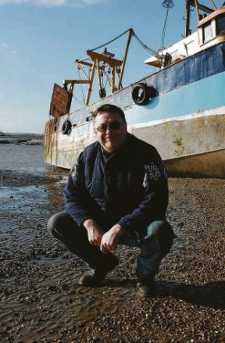
Paul Gilson — facing financial ruin
Gilson was caught out when a routine check on a fish auction in Zeebrugge in March 2007 led to an investigation by officials from the Marine Fisheries Agency in Britain, a court heard. It emerged he had both bought fish from, and sold fish on behalf of, 34 fishermen in the Southend area — yet he failed to supply the necessary documentation which allows fish quotas to be monitored.
Gerard Pounder, prosecuting, told how Gilson's actions had put the UK at risk of being fined by the EU for landing too much Dover sole, which experts say need to be conserved. As well as buying fish from other local fishermen and selling them on their behalf, Gilson also landed fish on his own boat, the "Janeen". Mr Pounder explained; "After he had sorted, weighed and packed the fish into boxes for auction it was impossible to say where it had come from." Gilson should have provided paperwork for fish he caught, purchased and sold. Yet officials, who examined his records, found the necessary documents had not been submitted.
It was estimated Gilson had failed to declare 21 tonnes of Dover sole which had been landed by small boats in the Southend area, which he sold at auction in Belgium for more than £138,000. Mr Pounder said no sales notes existed for a further 40 tonnes of fish. He said: "All this fish went off the radar." Some had been sold at Lowestoft and Billingsgate. Mr Pounder said some of the fish was a result of so-called "black fishing" with the catch never being declared. Gilson had sold fish to hotels, schools, restaurants and members of the public.
At Ipswich Crown Court, Mr Gilson pleaded guilty to three offences of failing to submit a sales note, between April 2006 and March 2007. He also pleaded guilty to 24 other offences including failing to keep an accurate log book for the "Janeen", using a sales note with false details, failing to submit accurate records and furnishing false details of the quantity of fish landed.
The court heard that a financial investigation had put the benefit to Gilson of his offending at £424,372. However his total assets, including his boat, amounted to just £395,139. Judge John Devaux made an order under the Proceeds of Crime Act that Gilson would have to pay the entire £395,139 — or face imprisonment. The Proceeds of Crime Act takes into account all known assets of an offender in an attempt to recoup as much as possible of what they gained from their crimes.
Gilson was described in references, provided to the court, as a "pillar of the community" who in 2000 had been awarded Freedom of the Borough of Southend for his work in support of the community and the lifeboat. Judge Devaux said there was no evidence Gilson had lived a lavish lifestyle or that he had concealed assets. His actions had not been motivated by greed, the court heard.
Judge Devaux imposed a nominal £10 fine, saying it was not realistic to impose the normal £10,000 fine for each offence as there was no prospect of Gilson being able to pay. For the same reason the judge said he was not ordering Gilson to pay any of the £83,796 prosecution costs.
MARINET observes: This Essex fisherman, Mr. Paul Gilson, has paid a very hefty price for concealing the landing and sale of fish beyond his fishing quota. He benefited to the tune of £424,372, and has been ordered by the court to pay £395,139 under the Proceeds of Crime Act. As a result, he is facing bankruptcy.
This appears to contrast greatly with the case reported recently in Scotland where fishermen concealed the landing of fish to the value of £47.5 million, and the principal trawler skipper was ordered by the court to pay £1 million, and the three other trawlers skippers involved were required to pay a total of £187,281.
The question arises: is justice being properly served in these two separate cases? And further, are our fish stocks being adequately protected by the courts given the apparent discrepancies in their rulings?
New evidence that marine reserves are supporting fish populations
Michael Sleak reports in The New Scientist, 24th May 2012… "If you protect fish, there will be more of them to catch. That's the reasoning conservationists have long used to persuade commercial fisheries of the benefits of marine reserves. Now they may have DNA confirmation.
Earlier research had shown that marine reserves result in larger fish that spawn more offspring, but researchers were left speculating exactly where the baby fish ended up and whether they truly help replenish other areas.
Now, with the use of new DNA profiling techniques, scientists have shown that by devoting less than a third of an area to a marine reserve network, you can double the number of juvenile fish that settle in the rest of the area. (Current Biology, DOI: 10.1016/j.cub.2012.04.008)
Garry Russ, one of the authors of the study, said he has spent the last 30 years contemplating how you can confirm exactly where fish born in marine reserves go. "To me, it's a little bit like the holy grail of marine reserves as fishery management tools," he says.
To nail the problem, Russ and colleagues at the ARC Centre for Excellence for Coral Reef Studies in Queensland, Australia caught 1620 adult coral trout and stripey snapper from a series of reserves on the Great Barrier Reef. Both species are popular with commercial and recreational fishing. They then took DNA samples from their tails, and released them alive. Later, they sampled juvenile fish from 19 locations throughout the region and checked to see if they were offspring of the fish in the reserves.
Though the reserves make up just 28 per cent of the area, the team calculated that about half of all juvenile fish were spawned by fish in the reserves — showing that the protected areas "punch above their weight in replenishing fishery stocks", as Russ puts it.
But fisheries ecologist Colin Buxton from the University of Tasmania at Sandy Bay in Tasmania, Australia isn't convinced that these results show reserves will help commercial fisheries. If the adult population isn't suffering from a shortage of juvenile fish — as he says is the case in the area studied — then introducing more young fish won't help. Buxton adds that the only effective way to maintain sustainable fish populations is to limit the number of fish taken out of the water.
Yet Russ believes the new findings provide strong evidence that marine reserves are a useful tool in maintaining fish populations. "Doubling the number of recruits coming into a population is almost always going to affect the adult population size quite substantially," he says.
Russ and his team next plan to look at the genetic make-up of the fisheries' catches to see if they are in fact being bulked up by fish breeding in the reserves. Their future research will also require them to cast a wider net — to see just how far from the marine reserve fish spawned there will travel."
Fishing observers 'intimidated and bribed by EU crews'
Observers monitoring European fish quotas are being regularly intimidated, offered bribes and undermined by the fishing crews they are observing, a Guardian investigation has discovered.
More than 20 former and current observers on Portuguese and Spanish ships said that they had experienced tactics such as beingput under surveillance, deprived of sleep, or threatened with being thrown overboard, or having their official documentation stolen by fishing crews to conceal a culture of overfishing.
Independent observers are deployed on board every fishing vessel operating in the Northwest Atlantic Fishery Organisation (NAFO), working on boats for five months at a time to monitor compliance with quotas shared between countries, which are designed to protect certain overfished species. Until 2004, they were provided by the EU, but are now provided by member states. If the observer witnesses infringements, they must inform a fisheries inspector, who will board the vessel, although the observer is not allowed to provide the inspector with any details about what infringements may have occurred.
Fishing crews on some vessels are believed to have tried numerous ploys to deter observers from carrying out their work. Training material for observers, written several years ago but still understood to be taken as guidance, warns them of "common infringements [that] may include timing hauls to coincide with [observer] meal times", forcing observers to choose between eating and conducting their duties.
The more observers investigate, the more likely they are subjected to this behaviour. Andrew Watson, an experienced observer who co-ordinated the observer programme in 2000, said that "[the crew] would go through my cabin routinely to check the figures I was recording. Attitudes towards an observer change very quickly if they find [an observer recording infringements]."
One observer described how during his deployment in 2010 "the crew didn't let me sleep, always kicking on the door". Several observers recall being warned to back off because "accidents happen at sea".
The behaviour is designed to prevent observers from reporting serious infringements of regulations. The Guardian has seen observer reports detailing illegal catches of hundreds of tonnes of cod, American plaice and Greenland halibut.
Southwold oil tanker decision imminent
The governments Mike Penning's highly controversial plans to create a unique 1.5 mile radius ship-to-ship oil transfer zone off the coast of Southwold is set for a crucial parliamentary battle on Tuesday 22nd May '12 when a House of Commons committee discusses the issue under the Merchant Shipping (Ship-to-ship transfers) (Amendment) Regulations 2012 (S.I, 2012, No.72).
The previous Labour administration had wanted to a blanket ban on all transfers in UK territorial waters in October 2010, but as soon as the current government achieved power Mr Penning delayed the ban, so allowing such oil transfers to continue.
Conservative MP for Suffolk Coastal, Dr Therese Coffey, and Jim Fitzpatrick Labour's shadow shipping minister for transport, will both call on the Seventh Delegated Legislation Committee to consider throwing out the plan, which has met with fierce opposition in the Southwold area. Dr. Coffey will be speaking to the committee on Tuesday to explain why she thinks that the proposed legislation is not correct and why Southwold should not be the only area selected, though she does not expect any of he party colleagues to change their minds. Mr Fitzpatrick will be sitting on the committee as an opposition member and will attempt to and use his influence to scupper the zone plan to prevent it reaching the House of Commons. Former Waveney Labour MP Bob Blizzard was pleased Mr Fitzpatrick's actions had led to Tuesday's crunch committee meeting and a vote on a issue which, he said, was "vital" to Waveney's future, saying "We simply cannot take risks with our coastal environment and our valuable tourism industry. It will be appalling if we become the oil tanker capital of Britain, as the only place where oil transfers at sea are allowed to take place."
If the committee agrees with shipping minister Mike Penning's plans to create an "exclusive tanker transfer zone" in Sole Bay off Southwold zone, it could lead to the scheme being passed by MPs in the Commons a few days later. Under parliamentary procedures, MPs could vote in the Commons without debating the proposals but they would have the committee's decision to help them decide how to vote. If the committee backs the government's plans, and MPs then voted along party line in the Commons, the government-backed zone would be approved.
£1 million confiscated from leading trawler captain in Scottish "black fish" crime
A Scottish trawler skipper has had £1m seized by the courts after pleading guilty to a major role in one of Europe's largest illegal fisheries scandals. Ian Buchan, 55, from Peterhead, was given the £1m confiscation order after he admitted illegally landing and then selling nearly £4.5m worth of mackerel in a highly sophisticated "black landing" scam to evade European fishing quotas.
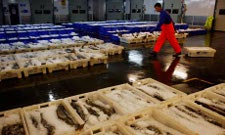
Workers prepare boxes of fish at Peterhead fish market. Tens of millions of pounds worth of illegally caught mackerel and herring were handled at two processing plants in the town. Photograph: Jeff J Mitchell/Getty Images
The confiscation order, made at the high court in Edinburgh under legislation introduced to combat organised crime, is one of the largest ever made against an individual by the Scottish courts. The record remains a £1.3m fine against Michael Voudouri, for a £3m VAT evasion in 2006, while the engineering firm Weir Group was fined £3m and had £13.9m of profits confiscated for evading sanctions against Saddam Hussein's regime in Iraq.
Buchan was among four skippers given confiscation orders for their part in landing over-quota fish at two processing factories in Peterhead, which have also been convicted and fined for handling tens of millions of pounds worth of illegally caught mackerel and herring.
By March this year, 27 skippers and three processing factories, including Shetland Catch outside Lerwick, Shetland, pleaded guilty to illegally landing £63m worth fish over a five-year period. By that point, the largest single confiscation order was £425,900.
The master of the vessel Quantus, Buchan landed at Fresh Catch in Peterhead, which had fitted an underground pipe and switching valves, operated from an anonymous and clandestine hut known as the Wendy House, which was disguised with fake "Danger: high voltage" signs on its door.
The confiscation orders by the same Court against the other three skippers totalled £187,281.
MARINET observes: As MARINET has observed earlier the question in this "black fish" scandal is whether the punishment fits the crime? And this is no ordinary crime. Firstly, it is by legal definition an "organised crime", secondly it is theft of a commonly-owned natural resource (fish stocks) which is scarce and under severe pressure, and thirdly the value of the crime (fish landed) is estimated by the court at £47.5 million.
The £47.5million haul dwarfs the sums stolen in many of Britain's most notorious robberies. The Brinks MAT raiders took £26million in gold from a Heathrow warehouse, and two armed thugs got away with £40million in gems from Graff Jewellers in London three years ago. The UK's biggest ever cash robbery — the £53million raid on a Kent Securitas depot in 2006 — netted just £5.5million more than the fishing scam.
Therefore is the confiscation of £1 million from the principal skipper in this crime and a total of £187,281 from the other three skippers commensurate with the crime and the "profit" made from this illegal action, along with the damage caused to fish stocks which are under severe pressure due to over-fishing and other ecological changes?
Have the trawler skippers had their vessels impounded as compensation for the loss of the common resources stolen (£47.5 million of fish), and have they had their licences suspended or revoked? What is the answer to the question: does crime pay?
In short, is this any fit way to be managing and ensuring the protection of our fisheries?
Romney Marsh, Kent, mooted as nuclear high-level waste dump
A furious row has broken out among local politicians over a proposal to build a nuclear waste dump in Kent. Romney Marshes is being mooted as a site for Britain's first store for high-level radioactive materials by members of Shepway district council but the move has infuriated the leader of Kent county council and a local MP.
"Let's not sell Romney Marsh short; I believe it has and deserves a better future than being the dumping ground for all of Britain's high level nuclear waste," said Damian Collins, MP for Folkestone and Hythe, on his own website. "Shepway council has started a consultation to ask whether residents want to find out more about building this underground storage facility here and my view, and that of the Marsh's county councillor Carole Waters, is that the answer should be 'no'."
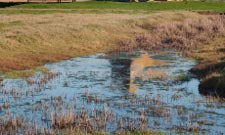
Romney Marsh, in Kent, is the proposed site of the nuclear disposal facility. Photograph: Kyle Tallett/Alamy
Paul Carter, leader of Kent council, told a local website, 'thisiskent', it would be "utter madness" to even consider building such a facility in an area which he said was "both an earthquake zone and one of the busiest shipping lanes in the world".
The government is keen to see the development of a deep-level waste repository as it tries to press ahead with a new generation of atomic reactors to generate lower carbon electricity. Currently some local authorities in Cumbria, close to the UK's biggest nuclear site at Sellafield, are the only ones to open a local debate about whether the high level waste should be buried there. But Shepway council, already home to reactors at nearby Dungeness, has now sent letters out to 10,000 local residents asking them for their views.
David Godfrey, a supporter of nuclear power and one of the local councillors behind the mail-out, told the Guardian that the potential scheme had been discussed as a way of creating jobs after discovering that there was little chance of any new reactors being built at Dungeness. "We are not saying there should be a waste repository, we are just asking people whether they would like to explore the possibility. If they say "no" then that will be the end of it," he said. Asked about the negative reactions from some other local politicians, Godfrey said others were entitled to their views although he was "not quite sure where some of the sensational views are coming from".
A website has been set up by Shepway council giving information on the proposal for a Romney Marshes Nuclear Research and Disposal Facility. Members of the public are informed that they should make their view known to the council by 20 July. The website lists both the pros and the cons. The prospect for creating jobs at a time when the Dungeness power stations are on their way out is emphasised but local residents are also warned there could be "possible adverse health impacts".
Paul Watson, Sea Shepherd, facing possible "extradition" to Costa Rica from Germany
Paul Watson, the veteran anti-whaling activist arrested in Germany on a decade-old charge will be released from jail on bail.
President of the radical Sea Shepherd Conservation Society, Paul Watson has gained notoriety for his direct action tactics against the Japanese whaling industry. However, his current legal difficulties relate to a confrontation with illegal shark fin poachers in Central America back in 2002. He has been told he must remain in the country pending a decision on whether or not to extradite him to Costa Rica.
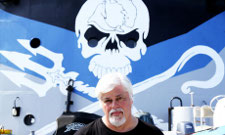
Paul Watson, president of Sea Shepherd, pictured last year. Photograph: Guillaume Collet/Getty Images
Frankfurt's higher regional court has announced that it had put him under preliminary arrest after deciding that an extradition would be permissible under German law. The authorities in Costa Rica now have three months to send the necessary extradition papers to Germany. However, the court said it was ultimately up to the federal justice ministry to decide whether or not to send him to Costa Rica.
Sea Shepherd's spokesman, Peter Hammarstedt, told the Guardian that Watson would be released once the € 250,000 bail funds were available.
The group has vowed to continue to campaign to have the extradition blocked, saying the charges are politically motivated and that Watson would not get a fair trial in Costa Rica. They are also trying to convince the German authorities that his life would be in danger if he were sent there. "I am confident that they will understand our plea for his human rights and recognise that if Captain Paul Watson were to be extradited to Costa Rica that would be the same as a death sentence," Hammerstedt said. "We know that the shark fin mafia put a hit on Captain Paul Watson a couple of years ago," he claimed, adding that Taiwanese poacher gangs had a "long reach in the penal system in Costa Rica".
The 61-year-old Canadian, who was one of the original founders of Greenpeace, was arrested last Sunday at Frankfurt airport at the request of Costa Rica, which wants to see him extradited over a 10-year-old charge of "violating ships traffic".
The incident at the heart of the extradition request occurred back in 2002 when Watson and his crew had a confrontation with a Costa Rican ship in Guatemalan waters. Sea Shepherd says that Watson came across the Varadero I as it was engaging in illegal "shark finning", the practice whereby sharks are caught and their fins — a delicacy in Asia — cut off. They are then thrown back into the ocean to die. According to the WWF, about 73 million sharks are killed each year, primarily for their fins.
Sea Shepherd says it had been instructed by the Guatemalan authorities to arrest and detain the crew. When they reached port in Costa Rica, however, Watson was accused of trying to ram the other ship and kill its captain. When a prosecutor saw a film of the incident, shot by a documentary team that happened to be on board Watson's boat, the charges were dropped.
Yet, in another twist, the maritime violation charges were reinstated by another prosecutor and were then re-activated in October last year, resulting in an Interpol arrest warrant. Sea Shepherd claims this is due to pressure being exerted by the Japanese whaling industry, which is currently filing a civil suit against the organisation in the US. "Ten years later they have decided to reissue the warrant at exactly the same time as we are really battling it out with the Japanese whaling industry," Peter Hammarstedt told the Guardian.
Critics have accused Watson of being a pirate or even eco-terrorist because of his aggressive exploits and he has run afoul of the powers that be before. In 1993 he was arrested by Canadian authorities for chasing trawlers off the coast of Newfoundland. Watson successfully defended his actions on the basis of the United Nations World Charter for Nature, which says that an organisation or individual has the authority to intervene to uphold international conservation rules
North Sea gas leak is sealed
The near two month crisis around a gas well on the Elgin field in the North Sea appeared to have been averted with French operator, Total, saying it had succeeded in plugging the leak.
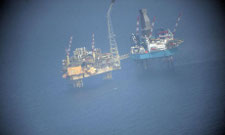
Aerial shot of Elgin Wellhead Platform in the North Sea. Photograph: Martin Langer/Greenpeace
Shares in the company rose more than 2% on the announcement that no more methane was being released into the environment and the company can soon put a halt to its relief operations which have been costing it $3m a day. "A major turning point has been achieved," said Yves-Louis Darricarrere, Total's head of exploration and production, but the company said it was too soon to say when gas and condensate production could resume.
The Elgin platform used to pump about 3% of Britain's total gas output from nearly four miles below the seabed, and the incident comes on top of production problems elsewhere. Safety issues in Yemen and a gas leak in Nigeria have been putting a brake on the company's target of increasing its global output by 2.5% through to 2015.
The oil world is very nervous of offshore incidents after BP's Macondo oil well spill in the Gulf of Mexico in the spring of 2010. That, very different from the Total gas leak, is expected to cost the company around $30bn in compensation and other claims.
Christophe de Margerie, Total's chief executive, has previously said the Elgin leak could cost the company slightly more than $300m in lost production in a worst case scenario where production did not restart before the end of the year.
There was relief in the City among investors. "Obviously good news for the group. Final costs are now awaited, but no bad surprises expected," said analysts at Alphavalue in a research note. Shares in Total had lost 16% of their value since the gas leak began in late March.
UK marine reserves described as little other than "paper parks"
George Monbiot writes, The Guardian 10th May 2012: "What do the terms "marine reserve" and "marine-protected area" conjure up for you? Places in which, perhaps, wildlife is protected? In which the damaging activities permitted in other parts of the sea — such as trawling and dredging — are banned? Wrong.
A marine-protected area in the United Kingdom is an area inside a line drawn on a map — and that's about it. In most cases, the fishing industry can continue to rip up the seabed, over-harvest the fish and shellfish, and cause all the other kinds of damage it is permitted to inflict in the rest of this country's territorial waters. With three tiny exceptions, our marine reserves are nothing but paper parks.
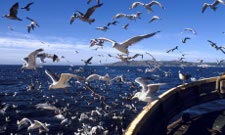
Seagulls follow fishing trawler. In most cases, the fishing industry can continue to over-harvest fish within marine reserves. Photograph: Alex Segre/Rex Features
The exceptions are the pockets of sea around Lundy Island in the Bristol Channel, Lamlash Bay on the Isle of Arran and Flamborough Head in Yorkshire. Together they occupy a grand total of 0.01% of British waters. These are the country's only "no take zones": places in which fishing and other extractive activities are banned.
After conducting a massive review of the evidence, in 2004 the Royal Commission on Environmental Pollution proposed that 30% of the United Kingdom's waters should be designated no-take zones. In 2009 a coalition of environmental groups launched a petition with the same aim: it gathered 500,000 signatures. But this didn't make a damn bit of difference to either the Labour or the coalition government.
The government is now in breach of its promise to designate an "ecologically coherent" network of marine conservation zones by 2012. The excuse it gives for the delay is that "there are a number of gaps and limitations in the scientific evidence base". But as the Royal Commission pointed out in 2004, the seas around this country "have been scrutinised in great detail since at least the mid-19th century", and the data is easily sufficient "to design comprehensive, representative and adequate networks of marine protected areas for UK waters." Perhaps unsurprisingly, the commission, which often voiced inconvenient truths, was shut down by David Cameron's government soon after it took office.
The Westminster government originally agreed to protect 127 sites in English waters, but now it appears to be paring the list down. Within these sites, only the "vulnerable features" will actually be protected; elsewhere it will be business as usual. If the government's record so far is anything to go by, the vulnerable features will amount to a few handkerchiefs of seabed. The remainder of these "conservation zones" can continue to be pulverised by beam trawlers and scallop dredgers.
But even if all 127 proposed marine conservation zones were to be designated, and even if the entire area of these zones were to be protected, that would account for a total of 0.5% of our seas: one sixtieth of the area recommended by the Royal Commission. In Wales the situation is even worse. The government there says it will consider "no more than three to four sites" , covering 0.15% of its seas.
So what about all those other marine reserves, such as our Special Areas of Conservation (EU Habitats Directive)? These are supposed to offer the highest level of protection available under European law, and are officially described as "strictly protected sites". Surely they offer our wildlife some protection? Wrong again.
The Marine Conservation Society has produced a gut-wrenching catalogue of the damage being done to these places by scallop dredgers, rock-hoppers (boats towing gear which turns over boulders to get at the fish sheltering among them) and all kinds of other destructive devices. If they are banned at all, it is only from a few small corners of the "strictly protected sites", often by voluntary agreement, and almost always reactively, after extensive damage has already been done.
The idea of actually protecting special areas of conservation, in their totality, in advance and by law, seems to be unthinkable to our governments. As Client Earth and the Marine Conservation Society point out, this puts the UK in breach of the European habitats directive.
The issue has come to a head once more with reports that scallop dredgers have been operating, apparently for the first time, in two recommended Marine Conservation Zones (Holderness Offshore and Inner Silver Pit) and one candidate special area of conservation (Inner Dowsing) in the North Sea.
The UK has a fleet of nomadic scallop dredgers, mostly based in Scotland and the Isle of Man, which travel from one conservation area to another, ripping them to shreds, aware that our governments will do nothing to stop them. Scallop dredgers operate by raking through the seabed with long metal teeth, dislodging the shellfish and trapping them in a net whose underside is made of chain mail. The teeth rip through the other lifeforms in their path; the steel mesh smashes the animals missed by the teeth. It is hard to think of a more effective method of destroying marine life, yet it is permitted in most of our special areas of conservation and other marine reserves.
The Marine Management Organisation, which is supposed to protect these places, merely wrings its hands. It knows it must apply the government's universal policy: that nothing should interfere with business, however damaging it is, however much it might harm the natural environment and even other businesses. (Local fishermen say that the scallop dredgers in just one of these sites have recently caused £100,000 of damage to their gear. They are likely to have done even greater damage to the fisheries on which local boats rely).
The chances of Richard Benyon, our fisheries minister, whose crashing conflicts of interest I exposed last month, demanding the protection of anything but the profits of the most destructive and short-sighted industries appear to be close to zero. It's intensely frustrating for anyone who loves the marine environment, and it's another powerful indication that "the greenest government ever" is even more destructive than its predecessors.
MARINET observes: Mr. Monbiot has put his finger on an issue that is causing growing concern in marine conservation circles — namely, that the Marine Conservation Zone (MCZ) procedure is not delivering effective results.
MARINET is moving towards the belief that the identification procedure for MCZs has been "designed to fail". In other words, the government is not genuinely interested in a strong conservation-based outcome.
The evidence for this conclusion goes all the way back to the commencement of the MCZ identification process when, instead of asking the Statutory Nature Conservation Bodies (Natural England and JNCC) to identify the best sites for MCZs based on the science and knowledge in their possession and then allowing stakeholders to comment and suggest alternatives if their commercial interests warranted it, the government operated the procedure in the reverse. Under this procedure the government handed the whole identification process over to the stakeholders who, in the main, did not possess the necessary scientific knowledge to be able to conduct a process of truly informed identification, and the government only introduced the Statutory Nature Conservation Bodies at the end of the process, as a kind of back-stop.
Moreover, the government also ruled out co-location of MCZs in connection with commercial sites (windfarms, seabed cable routes, shipping lanes, aggregate extraction areas, oil and gas extraction areas) which, collectively, could easily deliver protection of a substantial area of our seas, perhaps at least 10%.
As a result, the government is now claiming that the MCZs that have been identified (127 to date) lack scientific rigour, and the fear is that the number of sites that will eventually make it through the new vetting process established by the Minister will be a small fraction of the 127.
A result of this kind would be very bad for marine conservation, not least because the network of sites ultimately identified and installed would almost certainly lack "ecological coherence" — a legal requirement of the Marine and Coastal Access Act.
This diagnosis of what is happening over the MCZ identification — the government creating and implementing a procedure that is "designed to fail" — also has wider implications because the current identification procedure for how Descriptor 3 (commercial fish stocks) is defined within the Marine Strategy Framework Directive is displaying a similar tendency too — namely, a definition that is a travesty of what is required to restore commercial fish stocks to a healthy condition — and, if Descriptor 3 of the MSFD is debased, then so also will be the whole reform process currently being undertaken in connection with the EU Common Fisheries Policy.
In other words, little hope of securing a reformed CFP that will re-establish food security by rebuilding fish stocks to their maximum levels of abundance which ecological conditions will permit by means of such tools as closed areas (marine reserves) centred on spawning and nursery grounds where displaced fishermen and their vessels are offered re-employment as the managers of these areas, thus giving them and the fishing industry a financial stake in a new CFP which is conservation-based, rather than extraction-based.
So it is clear, very important issues are at stake here. Its not just marine reserves (MCZs), its not just how the law involved in the MSFD is defined in its detail, and its is not just what reform of the CFP will amount to. It is, in fact, the whole marine environment in all its forms and structure which is in the balance. We know our seas are in serious decline, and we know that our seas (covering two-thirds of the surface of this ocean planet and a key component of its climate and ecology) are crucial to our survival. So make no mistake, if we get these decisions wrong (MCZs, MSFD, CFP) then we are not just playing another game of dice in the last chance saloon — we've blown it.
Paul Watson, founder of Sea Shepherd, arrested in Germany
The veteran anti-whaling campaigner, Paul Watson, has been arrested in Germany on charges relating to an incident in 2002 when the boat he was piloting attempted to stop poachers illegally killing sharks.
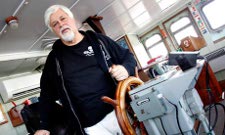
Paul Watson, founder of the Sea Shepherd environmental group, at the helm of the Steve Irwin in the port of Barcelona. Photograph: Albert Olive/EPA
The environmental activist organisation Sea Shepherd said Paul Watson had been detained at Frankfurt airport to answer a Costa Rican extradition warrant for "violating ships traffic".
The incident took place in Guatemalan waters a decade ago when Watson's boat, the Farley Mowat, encountered an illegal shark-finning operation run by a Costa Rican ship, the Varadero. Crew on the Varadero accused Watson of attempting to ram their boat and Watson was charged by Costa Rican authorities with attempted murder.
Watson's charges were subsequently dismissed when a video of the incident filmed by a documentary crew was shown to the Costa Rican prosecutor. However, the charges were later re-investigated by a newly appointed prosecutor.
Established by Watson in Malibu, California, Sea Shepherd — which has had a number of celebrity backers such as Pierce Brosnan and Martin Sheen — has been involved in numerous anti-whaling and environmental protection actions in international waters.
In 2006 Watson was involved in a "daunting chase" when his boat for weeks pursued a Japanese whaling fleet over 4,000 miles along the Antarctic coastline.
Sea Shepherd said: "Captain Paul Watson was arrested on 12th May and has made contact from Frankfurt airport jail. He has been given periodic access to his mobile phone and is being treated well. A fisherman accused Paul of trying to kill him, although it is evident that Paul did not and that evidence is on film. He said the warrant dates back to an event in 2002." The statement added that Watson was scheduled to appear before a judge on 15th May, and that it was unclear why the warrant had been re-issued.
Sea Shepherd said Watson was being assisted by Daniel Cohn Bendit, co-president of the Greens/Free European Alliance group in the European parliament, and José Bové, a group member.
"With Costa Rica's rich biodiversity, it would be a travesty for them not to stand up for sharks, which sit at the highest levels of the food chain assuring balance among ecological communities in the ocean," Sea Shepherd said. "Paul is very touched by the concern on Facebook and Twitter and finds it very encouraging."
Global eel population has declined by 99% during last three decades
Marine biologists are racing to solve a unique problem which is crucial to their efforts to save the world's wild eel populations from catastrophic collapse: recreating a food called "marine snow".
In one of the least-understood global conservation crises, spawning rates for the world's three major eel populations have crashed in the last three decades by as much as 99%, raising fears they could become extinct across the far east, Europe and north America.
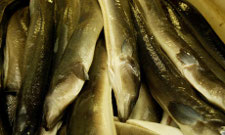
Spawning rates for the world's three major eel populations have crashed in the last three decades by as much as 99%. Photograph: Graham Turner
Biologists in Japan, where eels are an iconic part of the country's cuisine and culture, are on the brink of farming eels from birth to fork on an industrial scale for the first time, potentially in the same way as salmon is farmed worldwide. That breakthrough — being sought too by scientists in Korea and the United States — could dramatically relieve pressure on wild eel populations, and greatly increase the prospects of rebuilding their stocks worldwide.
Yet the goal of producing wholly captive farmed eels, using larvae produced in captivity rather than wild-caught baby eels, is being thwarted by a very significant obstacle: reproducing the larvae's unique natural diet, which is known to scientists as "marine snow". That foodstuff, which is essential to an eel's growth cycle as they develop and mature from larvae to glass eels, is a mixture of marine detritus, organic waste matter suspended in diffuse clouds, which is proving extremely hard to reproduce on an industrial scale.
Eels are being farmed commercially around the world but only by using baby eels trapped in the wild, adding even greater pressure to the last surviving wild populations. In the UK, young eel or elver numbers are now at 5% of their levels in the 1980s.
Scientists have considered the most unlikely ingredients to help create that peculiar food, including the yolk from shark's eggs. To exacerbate the feeding problem, eels stay in a larval stage for three to four months, compared with only a few days for cod, and are extremely sensitive at that stage. Prof Katsumi Tsukamoto, a pioneer in eel conservation in the Pacific who was first discover the Pacific eels spawning grounds, told marine scientists in Edinburgh this week that this obstacle meant it cost €1,000 (£803) to produce a single captive seedling in the laboratory; their goal is to get that cost down to €1.
Speaking after a keynote address to the World Fisheries Congress, Tsukamoto, from the Atmosphere and Ocean Research Institute at Tokyo University, said the focus on devising a wholly self-sufficient domestic eel farming programme, while very expensive, was being driven by the need to preserve remaining wild eels. "We're now trying to establish a special strain, completely cut off from wild stocks," he said. "We want to improve the many different characteristics, for example growth rate, metamorphosis rates and disease resistance. It's a process of domestication, like sheep, pigs, cows or horses."
Pressure to produce wholly captive eels is being driven by the continuing heavy demand from consumers: eels are the main ingredient in kabayaki, one of three most culturally important styles of Japanese cuisine along with sushi and tempura.
David Righton, from the Cefas marine laboratory in Lowestoft, and a leading figure in the Eeliad project on saving the European eel, said the quest to find a substitute food stuff is one of the most competitive areas in eel conservation. "Whoever gets there first has made a tremendous discovery; you're recovering a cultural tradition. Whoever does this is culturally important as well as becoming very rich," Righton said.
Warm water species spreading into UK seas, including bluefin tuna
Exotic warm water marine species such as anchovy, bluefin tuna, stingray, and thresher shark are spreading northwards into British coastal waters, where average sea temperatures are now moving closer to the warmer conditions of southern Europe.
A new study by marine scientists discloses that many species, some better known to holidaymakers in the Mediterranean and the Canary Islands, are now increasingly commonly seen in the seas off Cornwall, Devon, Hampshire and Sussex, providing vivid evidence that climate change is already changing the natural environment.
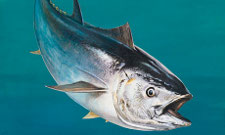
Atlantic bluefin tuna have slowly started reappearing in the waters off south-west England. Photograph: Getty Images/DeAgostini
Off south-west England, fishermen and biologists see bluefin tuna, triggerfish, stingrays, thresher sharks and ocean sunfish in greater numbers. Off the south coast, and in some cases the North Sea, anchovies, red mullet, sea bass and John Dory are now being caught in commercial quantities as these warm water species shift north.
In the North Sea, more trawlers are now fishing for increasingly abundant squid, another staple of Mediterranean restaurants, than are targeting traditional species such as cod and haddock. But the Marine Climate Change Impacts Partnership (MCCIP) report, published by UK and Scottish government ministers, warns that there are serious and potentially dangerous challenges for native species and for the fishing industry, as they struggle to adapt and ward off threats from invasive species and unusual diseases.
"The truth is that climate change is having a big impact on distribution of fish stocks and this is going to present some significant challenges for policy makers, fisheries managers and for fishing industry itself," said Richard Benyon, the UK minister for the marine environment. Benyon told the Guardian that a "whole-seas approach" was now needed. "If fish aren't in certain parts of the sea, but are going to be elsewhere, we need to have fisheries management policies that will make sure that they are sustainable, wherever they are. We realise these are fast-moving ecosystems and we have to be smarter."
The study, a "report card" on the latest scientific data and its implications, says trawlers will have to travel far further north within 20 years to catch Britain's favourite species, the cod, as they follow cold waters northwards, while warmer waters threaten to devastate commercial mussel fisheries. The study warns that if water temperatures rise by 1C in Northern Ireland and Scotland, mussel production will fall by 50%, while predicted increases in violent ocean storms are likely to cause "considerable economic impacts" on salmon farming, by damaging fish cages and allowing millions of salmon to escape and breed with wild stocks.
Drawing on scores of scientific papers and studies, it said that the range of one southerly species, the bib, had extended north by 342km (212 miles) in two decades while common North Sea species such as cod, lemon sole and saithe were swimming at depths which were increasing by 5.5m a decade.
Conflicts between British and foreign fleets could become more common in future, the study reported. A major row over control of north-east Atlantic mackerel stocks between the European Union and the Faroese and Icelandic governments could be a sign of things to come both in European waters and around the world. Fleets from France and Spain are now expected to head into the Channel, chasing anchovies, which have been disappearing from the Bay of Biscay, to the dismay of south coast fishermen.
In 2010, Scottish skippers blockaded the docks at Peterhead to prevent Faroese ships landing their catch, after Iceland and the Faroese unilaterally took a much larger mackerel quota. They argued that due to climate change, the region's mackerel were now spawning in much greater numbers in their waters, a claim being challenged by the EU. Their claims about the influence of climate change are disputed, and the EU is now drafting plans for sanctions on the Faroes and Iceland after they refused to negotiate a much lower quota. The Marine Stewardship Council has now suspended sustainable fishing eco-labels from eight European mackerel fleets, as a result of the dispute, as the greatly increased quotas breached sustainable fishing limits.
The report was launched on Tuesday at the World Fisheries Congress in Edinburgh, the first time the congress has been held in Europe, soon after the Prince of Wales told delegates he had substantial fears that without much greater co-operation and tougher action on sustainability, conflicts over fish stocks would be far more common. Prince Charles said that while his international sustainability unit, a fisheries and environment think-tank funded by his charitable foundation, had established there were numerous success stories where fisheries were sustainable and secure, there were many that were not. "Vast numbers of people around the world rely upon the sea. Their survival depends upon the ocean's capacity for renewal, which can only be maintained if we take an intelligent approach now," he told the congress.
There were a billion people worldwide who depended on fish as their main source of protein, while developing economies exported $27bn (£16.7bn) of fish and seafood worldwide in 2008, exports worth far more than cotton or coffee. The MCCIP report said climate change could cause "significant declines" in tropical regions, leading to losses as high as $30bn by 2050. "It is a serious social and economic issue. If fish stocks fail, then the social and economic consequences will be dire," Prince Charles said.
In one of the most startling changes around the British Isles, Danish and Irish trawlers are now landing huge numbers of boarfish, a small, very bony orange fish, off southern Ireland and in the south-west approaches. Unheard of around the British isles 10 years ago, trawlers landed 130,000 tonnes of boarfish last year, for use as fish meal for fish farms.
The MCCIP said the mackerel dispute was a clear warning that fishing industries, policy makers and governments would have to begin co-operating much more closely on stock management and conservation as the impacts of climate change ignored international boundaries. That also meant that current policies on promoting marine conservation zones or no-catch zones would have to be adapted, since the fish they were designed to protect were now moving to different areas. In the Baltic, spawning cod had been deserting a closure area at Bornholm set up to protect them.
Sea creatures affected by rising temperatures
Farmed mussels: a study of commercial mussel farming in Strangford Lough in Northern Ireland found that if water temperatures rose by 1C, production would fall by 50%, and by 70% if temperatures rose by 4C. Non-native Pacific oysters would be less affected, declining by just 8% under both scenarios, suggesting shellfish farmers could switch to that species in future.
Boarfish: since 2001, there has been a "dramatic increase" in landings of boarfish, a bony, spiny fish which is ground into fish-meal for fish farms, as it has moved into the south-west approaches and the Celtic seas due to global warming. Last year, 130,000 tonnes of boarfish were landed.
Anchovy: the salty fish better known in the Mediterranean and Bay of Biscay, are moving northwards up the Irish and British coast and now being caught at commercial levels in the Channel and North Sea as far north as the Pentland Firth. About 800 tonnes were caught in south-west England in 2011 but biologists believe they are native stocks, which have bloomed in size with warmer British waters.
Salmon farming: fish-farming cages are very vulnerable to storms, which are expected to get more violent and more frequent as climate change takes hold, presenting economic and ecological risks as they escape and inter-breed with wild salmon. Scottish farmed salmon netted £563m in 2010 but over seven years, nearly 2.2m cultivated salmon escaped after storms, with about 820,000 fish escaping during one storm alone in 2005.
Bluefin tuna: once commonly fished in the North Sea until the population collapsed in the 1960s, Atlantic bluefin tuna have slowly started reappearing in the waters off south-west England: one was caught off Dorset last July. Now critically endangered through overfishing, and a favoured target species for sea anglers, there are demands for a total ban on fishing bluefins.
MARINET observes: The Marine Climate Change Impacts Partnership report is of great significance. It demonstrates clearly how our seas are changing, both in terms of species and ecosystem structure. These changes have profound implications for our fishing industry, and the stocks that will be available to us in the future.
We are now faced with the exceptional prospect of Bluefin tuna returning to UK seas. In 1880 the bluefin tuna stock in the North Sea is been calculated to have been around 177,000 tonnes, and fishing for bluefin in the North Sea continued until the 1960s. The stock is now effectively zero — see MARINET Briefing (www.marinet.org.uk/rocfp/northsea1880-2010.pdf). The question therefore arises, how are we going to manage species like bluefin tuna and other migratory species so that their arrival is not immediately "killed off" by over-fishing?
Central to this answer is the manner in which the EU Common Fisheries Policy (CFP) is reformed. This reform is being negotiated and debated in Brussels at the present time, see http://ec.europa.eu/fisheries/reform
For Common Fisheries Policy reform to be effective, and for new and returning fish species like Bluefin tuna to survive and prosper, MARINET believes that the new CFP must establish "food security" as a key, central purpose of fisheries management in EU seas — namely, the ability to feed ourselves from the fish stocks in our seas for all 12 months of the year, year after year, given the present situation that over-fishing has reduced our stocks so considerably that they can now only feed us for 6 months, and still declining. Therefore to deliver and re-establish food security, we have to manage stocks so that they are able to reach the maximum level of abundance which current ecological conditions will permit (e.g. taking warming seas into account), and central to this approach must be the use of closed areas (marine reserves) centred on the spawning and nursery grounds, with displaced fishermen and their vessels offered re-employment as the managers of these closed areas so that they and the fishing industry as a whole has a clear financial benefit from the CFP's new conservation-based management approach.
Importantly, a CFP reformed on this basis — delivering food security, abundant stocks and a revitalised fishing industry based in EU seas — will also eliminate the need for the EU to enter into "arrangements" with developing nations off West Africa and elsewhere in order to fill the food gap, for these stocks too are in need protection and are clearly vital to the well-being of those nations.
So, will the return of Bluefin tuna herald a change in the Common Fisheries Policy? MARINET has told government that we are in "the last chance saloon" with respect to our fisheries; and, through a quixotic change in climate the bluefin tuna has returned and given us another, final chance to allow this species to prosper in our seas once again. MARINET is lobbying hard for reform of the CFP that makes sense and if you want to assist in this, please let us know (www.marinet.org.uk/contacts.html).
European Parliament's Environment Committee makes clear recommendations on CFP reform
The Environment Committee in the European Parliament has voted in favour of measures aimed at rebuilding fish stocks.
With 50 votes against 0 (and 8 abstentions), MEPs in the Environment Committee approved an opinion on the main item in the CFP reform: the Basic Regulation. The draughtsman, Chris Davies MEP (ALDE), said after the vote that he welcomed the endorsement for policies that would ensure working towards restoring European fish stocks. "It sends a strong signal that there is a very large body of members who say we can't carry on as we are, we can't carry on overfishing. If that conviction carries forward to the fisheries committee, we're going to have a very successful outcome," Chris Davies said.
If the European Parliament's Fisheries Committee later this year were to vote differently on crucial issues in the reform, such as achieving maximum sustainable yield, the Environment Committee's vote means that there is opportunity for overturning the Fisheries Committee decision in Parliament, according to Chris Davies. "I think within the Parliament as a whole, those people who pay any attention to the issue overwhelmingly believe that we need to put in place some really sustainable policies," he said.
The report was adopted by the committee with 50 votes against 0, with 8 MEPs abstaining. Originally, there were 542 amendments, but most of them had been replaced by a list of 38 consolidated amendments tabled jointly by several political groups. All of the 38 consolidated amendments were adopted.
A coalition of environmental NGOs — including Greenpeace, Ocean2012, Oceana and WWF — praised the committee for the outcome of the vote. In a press release, the group welcomed the commitment to restore fish populations above sustainable levels by 2015 and the support for preferential access to fishing for the most sustainable operations.
In brief, some of the proposals adopted by the Environment Committee are:
- setting a target of achieving above maximum sustainable yield in all fisheries by 2015 (no overfishing)
- long term management plans to be agreed for all fisheries, based on best scientific evidence or the precautionary principle
- restrictions on the degree to which Fisheries Ministers can set quotas that ignore scientific evidence
- requiring all fish caught to be landed and ending discards, to promote the use of more selective fishing gear
- transferable fishing concessions to be established only on a voluntary basis by Member States
- an assessment of overcapacity in the fishing fleet (too many boats chasing too few fish), and measures to reduce it
- full transparency regarding the allocation of fishing rights
- allocation of fishing rights to benefit small-scale fishermen
- the establishment of fisheries reserves
- long-term goals to restore stocks to levels that can produce the maximum economic yield for fishermen
- support for regionalised decision-making by encouraging MS to co-operate together when they are part of the same sea-basin
- strict sanctions against Member States that fail to comply with the requirements of the Regulation
A Full list of the European Parliament Environment Committee's consolidated amendments
UK and Denmark to explore electricity "supergrid" connection
Ambitious plans to deliver a North Sea 'supergrid' capable of transmitting renewable energy between Northern European countries have taken a leap forward after the UK and Denmark announced the launch of a new feasibility study on a proposed electricity interconnector between the two countries.
UK-based grid operator National Grid and its Danish equivalent, Energinet.dk, confirmed they would work together to produce a "pre-feasibility" study that will look at a range of options for deploying a subsea cable linking the UK and Denmark.
The companies stressed that the proposals were at a "very early stage", but said they would aim to complete the initial study before the end of this year, providing an insight into "different technical solutions, possible project benefits, potential routes and landing points, the capacity of the cable and potential commissioning timetable".
Significantly, the study will also look at how any new cable would help the two countries import and export renewable energy, including the large quantities of offshore wind energy being planned by both the UK and Denmark, and how any interconnector could integrate with the mooted North Sea supergrid.
"This study is an important first step in looking at developing a link between Denmark and the UK," said Terry McCormick, head of UK and European business development at National Grid. "More interconnection with Europe supports the integration of renewable energy and gives us more options to balance our network in the UK. It could also meet European objectives of bringing more competition to the market."
A spokeswoman for National Grid told BusinessGreen that if the results of the initial study prove encouraging, the companies will move towards a full feasibility assessment that would look at precise routes, landing sites and potentially pre-contract requirements. However, she stressed that any project was likely to take a considerable amount of time, noting that previous interconnectors took around 10 years from planning to completion.
The announcement comes just days after British prime minister David Cameron again stressed his support for the creation of a supergrid that would allow the UK to better trade electricity with neighbouring countries.
The UK has signed a number of agreements with northern European countries to explore the proposals for a new network of interconnectors that, according to advocates, would make it easier to manage the additional high levels of renewable energy capacity that are due to come online over the next decade.
"For National Grid, as more wind energy comes online interconnectors are one of the best solutions for handling the issue of intermittency," said the spokeswoman for the company. "It means you can export surplus wind energy and bring in green electricity from elsewhere when you need it."
The UK currently has three interconnectors in place with Ireland, France and the Netherlands, and National Grid is currently investigating new links with Belgium and Norway, which would provide access to Scandinavian pumped hydro power storage plants, as well as increasing capacity with France and Ireland.
The government has also revealed it is considering plans for an interconnector with Iceland, which would allow the UK to import zero emission geothermal power from the country.
Similarly, Denmark has interconnectors with Norway, Sweden and Germany, and is working on a new interconnector to Norway while also investigating an interconnection with the Netherlands.
Wet April causes "poor start" to water quality for UK's 2012 sea bathing season
Heavy recent rains are flushing raw sewage into coastal waters, ruining the water quality at popular beaches around the UK just as the bathing season begins, according to the Marine Conservation Society (MCS).
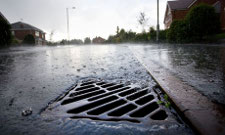
Water quality is affected by contamination from overflowing sewers and run-off from farms or city streets, the MCS says. Photograph: Andrew Fox/Alamy
As it publishes its 2012 Good Beach Guide on Thursday, the MCS reveals that one-third of the 750 beaches it tested failed on water quality, due to contamination from overflowing sewers and run-off from farms or from streets, where dog waste presents a significant problem.
Overall, the proportion of dirty beaches fell by 8%, which the MCS hailed as a "milestone". The south-west, north-east and Wales had the cleanest coasts, with 80% of beaches passing faecal bacteria tests, while Scotland (40%) and the north-west (20%) had the fewest clean bathing spots.
The MCS warning that downpours are harming beaches comes following flood warnings, mainly on the Severn and Stour rivers.
Sewers are designed to overflow into the sea and rivers when treatment plants are overwhelmed by torrential rain. The alternative is sewage spilling into streets or back up toilets. However, MCS said only a quarter of the 31,000 "combined sewage overflows" (CSOs) in operation in the UK are monitored to record how often they allow raw sewage to flow. "Some of the CSOs discharge dozens or hundreds of times a year," said Rob Keirle, pollution programme manager at MCS. "We are calling for openness. Where are they? How often do they discharge? How much? There is a reluctance for the regulator [the Environment Agency in England and Wales] to disclose this information, as they don't like what it reveals."
In the absence of public information, MCS has used freedom of information regulations to obtain data on CSOs. In the region covered by water company Southern Water, for example, CSOs near Bognor Regis and Littlehampton flooded 74 times in the 2011 season, which runs from 1st May to 30th September, while CSOs in Cowes on the Isle of Wight overflowed 49 times. Keirle points out this data covers the summer, when rainfall is much less than in winter.
An Environment Agency spokeswoman said: "There are 15,000 CSOs in England and Wales and around half of these are monitored. Water companies carry out their own monitoring of approximately 6,000 CSOs for operational purposes and we are encouraging them to expand this. We have ordered additional monitoring and reporting at more than 800 CSOs, with a further 500 due to be monitored by 2015."
MCS calculated their total of 31,000 CSOs by including all facilities where raw sewage is flushed into the sea or rivers in the UK, while the Environment Agency, responsible for England and Wales, only includes those specifically involving sewers and not sewage treatment plants or pumping stations.
Keirle said CSOs play a "significant role" in destroying water quality, but added that the run-off from farms and from city streets was also significant. "All the manure from cows, sheep and pigs washes into streams and rivers and into the sea. There is no where else for the waste to go: waste flows downhill," he said. "Dog waste being washed of urban streets is not a trivial problem either. Collectively they have a huge impact on the environment."
Farmers can sign up for schemes where they are paid to implement measures that reduce the flow of manure, but these are voluntary.
Action to protect albatrosses in the Indian Ocean
After long deliberations stretching across five days, the Indian Ocean Tuna Commission (IOTC) has agreed, 26th April 2012, to measures that could result in significant reductions in the deaths of albatrosses, who accidentally get snagged on long-line fishing hooks and then drown. The meeting, held in Australia, announced that all long-line vessels in the Indian Ocean will now be required to use two seabird bycatch mitigation measures from a choice of either bird streamers, also known as tori lines, which scare birds away from the hooks; adding weights to hooks to make them sink more quickly; or setting hooks at night when most birds are less active.
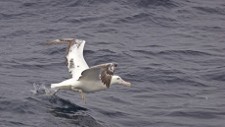
Wandering albatross. Image: Michael Gore
Scientists estimate that upwards of 300,000 seabirds are being killed every year by long-line fisheries; it's believed this is the primary reason behind 17 of the world's 22 species of albatrosses being threatened with extinction.
Home to globally important populations of eight albatross species including the Critically Endangered Amsterdam albatross, the Indian Ocean is popular with fleets of long-liners fishing for tuna. Tuna long-liners typically deploy several thousand hooks, attached by branch lines to a main line that can be more than 100km long. Seabirds, especially albatrosses, are vulnerable to becoming hooked when they take the bait, and are drowned as the line sinks.
Dr Cleo Small, representing the RSPB and BirdLife International, said: "It may seem like an issue that doesn't concern us here in the UK, but in fact this move is great news for UK albatross species such as the wandering albatross, which fly over the Indian Ocean in the non-breeding period and often become victims of bycatch from the long-liners that fish there. Without such measures, these beautiful birds could be lost forever."
Although an understanding of the scale and nature of this threat has been known for a long time, the development of measures to reduce bycatch has been slow. The RSPB and BirdLife International's Global Seabird Programme have been particularly active in devising and testing technologies and fishing practices to reduce the problem and be part of the solution; the Albatross Task Force, founded by the organisations, works directly with fishermen and fishery managers in eight bycatch hotspot countries worldwide to reduce the number of seabirds being killed. The news from the IOTC yesterday follows the strong set of measures put in place last November when the International Commission for the Conservation of Atlantic Tunas (ICCAT) agreed that fishing vessels must use two out of three measures to reduce bycatch when working in areas where albatrosses occur.
Dr Small continued: "The RSPB and BirdLife International have played a key part in getting seabirds measure adopted in the Indian Ocean and in the Atlantic last year, but we're not going to stop just yet. Next on the list is the Pacific; once this is achieved it will mean all long-line vessels worldwide will be required to use two seabird bycatch mitigation measures when fishing in areas overlapping with albatrosses."
The delegation from Japan offered US$20,000 to support training workshops for fishing skippers to help them implement the new requirements. BirdLife International and the International Seafood Sustainability Foundation will work with Japan and other nations to secure additional funding and provide the training.
Senegal cancels the licences of foreign fishing trawlers
The new government of Senegal has cancelled the licences of 29 foreign fishing trawlers, demanding that they offload their catches in the capital Dakar before leaving the west African country's territorial waters. The dramatic move on Tuesday by fisheries minister Pape Diouf follows growing resentment at overfishing and alleged corruption of the previous government's licensing system. It is expected to defuse threats by Senegal's 52,000 small-scale inshore fishermen to take direct action against the owners of foreign trawlers.
In 2006, Senegal cancelled its licensing agreements with the heavily subsidised EU fleet in an attempt to protect its industry from foreign vessels. But dozens of giant 10,000-tonne factory ships registered in Russia, Lithuania, Morocco, Ukraine, Mauritius, Saint Vincent and the Grenadines, China, Belize and elsewhere were able to acquire new licences. Using satellite technology and often working together, they have been able to take hundreds of tonnes of fish a day.
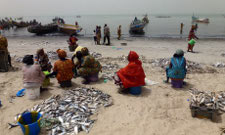
A local fishing community in Senegal. Local industry leaders in west Africa say small-scale, inshore fishing has been decimated in the past 10 years because of commercial overfishing. Photograph: John Vidal for the Guardian
This is in stark contrast to local fishermen, whose small 30-foot "pirogues" are able to catch only a few tonnes of fish a year from waters near the shore. Because of the widespread decline in the amount of fish available — in part a knock-on effect front the industrial fishing further out — they are forced to fish further and further out to sea.
Hunger is growing in Senegal and other Sahelian countries, but much of the catch by the foreign fleets ends up in Britain and the EU after being exported from ports like Las Palmas in the Canary Islands. Local fishing industry leaders in Senegal, Cape Verde, Mauritania and elsewhere say catches from inshore fishing have been decimated in the past 10 years because of overfishing. In addition, many other "pirate" trawlers operate illegally in west African waters, further decimating stocks.
"Senegal's only resource is the sea," said Abdou Karim Sall, president of the Fishermen's Association of Joal and the Committee of Marine Reserves in West Africa. "Unless something changes there will be a catastrophe for livelihoods, employment and food security."
Senegal's decision to revoke the licences is seen as important because the EU is currently under pressure to abandon subsidies for fishing fleets working in the waters of developing countries. It was not clear on Thursday how long the revoking of licences for foreign vessels in Senegalese waters would last. The move may not develop into a future ban, but it is understood the government is now reviewing its fishing policies.
"This decision is a good start to managing Senegal's fishing better. Hopefully, the government will decree a moratorium on the allocation of new fishing authorisations," said Raoul Monsembula, oceans campaigner for Greenpeace Africa, that has been pressing for an end to overfishing in west African waters
Speculation that China will invest in new UK coastal nuclear power stations
China looks set to step into the vacuum left in the UK's nuclear new build programme, after reports this morning revealed two groups from the country are interested in buying the Horizon joint venture put up for sale by E.On and RWE in March.
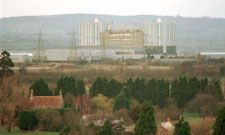
Oldbury nuclear power station in Gloucestershire. Chinese companies are reportedly looking to invest in a consortium in the site. Photograph: Simon Chapman/ISF
The German companies appointed Japanese bank Nomura to find a buyer for sites at Wylfa in north Wales and Oldbury-on-Severn in Gloucestershire, and the Financial Times reports, 7th May 2012, that a number of firms are now involved in negotiations, including a European consortia, sovereign wealth funds, and Chinese state-owned power companies. The paper says the government and Horizon have been talking to two new consortia, while GDF is considering a bid with Iberdrola, its partner in nuclear operation Nugen.
Another consortium involved comprises Westinghouse Electric, owned by Toshiba, along with a western utility, a Chinese group — named by the Financial Times as either China Guangdong Nuclear Power or China's State Nuclear Power Technology Corporation — and potentially a sovereign wealth fund.
The Chancellor George Osborne has been keen to attract Chinese investment to help revamp the UK's creaking energy infrastructure. The government is also under mounting pressure to identify viable investors for its plans for new nuclear reactors, after withdrawals by SSE and Horizon left its plans to build 16GW of new nuclear power in the UK by 2025 in danger of collapse.
However, any involvement from Chinese firms or sovereign wealth funds is likely to further fuel criticism of the government's nuclear plans from green groups, who have already accused ministers of handing control of key energy assets to foreign firms.
Four former heads of campaign group Friends of the Earth wrote to the Prime Minister in March urging him to abandon plans for another generation of nuclear reactors and instead funnel investment towards building up renewable energy sources. Not only were the signatories concerned about the cost of building the plants and dealing with the associated waste, but they also warned that the plans put the UK's future energy policy in the hands of two French companies — EDF and Areva.
Hallsands revisited — the first evidenced case of dredging induced erosion
The first recorded and evidenced instance of serious coastal erosion due to offshore aggregate dredging took place when the South Devon village of Hallsands was swept away in 1917, ninety five years ago, following offshore aggregate dredging of 382,000 cubic metres of sand and shingle between 1897 and 1902. 382,000 cubic metres (660,000 tons) of sand and shingle were taken offshore 1897 and 1902, which soon resulted in a rapid four metre lowering of the entire length of the beach, this leading to the erosion of the cliffs; this followed by the complete destruction of the entire village itself within 18 years. (See www.marinet.org.uk/mad/madbrief.html for details).
Now BBC News has just revisited the issue in an article by Andrew Cooper, BBC's Nature expert, on the BBC's website, under the heading 'How Hallsands was lost to the sea' which we have reproduced in full below.
How Hallsands was lost to the sea
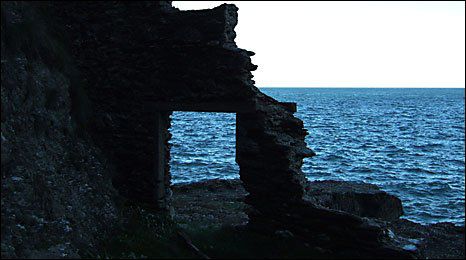
The ruins of Hallsands
When disaster struck a tiny fishing village on the coast of south Devon, the war raging in Europe was entering its third year. In the village of Hallsands the night of 26th January 1917 serves as a reminder of the folly on interfering with the sea.

Hallsands before the 1917 disaster
The village was one of several small communities dotted along the coast that relied on the sea for its living. It supported 128 inhabitants before that fateful day, and was protected by a large pebble ridge. Darkness came early that afternoon as the pending storm blew down the Channel, a rare, strong, easterly wind. Well protected from the prevailing South Westerlies, the village became vulnerable as the winds swung around to the north-east and strengthened.
The tide was exceptionally high that night and, coupled with the fierce onshore winds, the sea came pounding up the beach. It surged over the pebble ridge, crashing across a wall into the houses beyond. Smashing through winds and bursting open doors, it flooded the ground floors of the houses, enveloping them in cold swirling water. The destruction was unbelievable. By midnight four houses had gone.
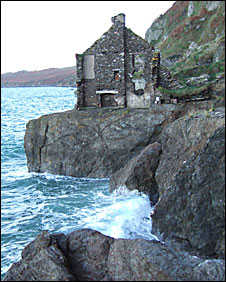
A ruined house in Hallsands
The inhabitants gathered the few belongings they could and assembled on the cliff tops above to watch the final blow. Even the dawn was not to relieve their anguish, for the following day brought another high tide and houses were felled one-by-one by the pounding waves. At the day's end only one house was left standing. The devastation was complete. Altogether some 29 homes had been taken along with the livelihoods and belongings of the entire village.
The greatest sadness was that this disaster need never have happened. Its origins lay in plans, unknown to local fishermen at the time, to extend the naval dockyard at Plymouth.
The plans involved sand and gravel being taken from the seabed further up the coast.
Dredging began in the spring of 1897 and during the next four years some 660,000 tonnes of material were removed.
Activities were eventually stopped when opposition from several fishing villages grew as they saw their shingle beaches being relentlessly carried away. It took 20 years from the start of dredging to the final destruction of Hallsands village.
It had been assumed that the removal of any shingle would be replaced naturally by more material that lay somewhere out in the channel. We now know that the same shingle which protects the nearby villages of Beesands and Torcross was deposited thousands of years ago during the ice ages, and is not being replaced.
Today, a new village built higher up the cliff face overlooks the scene of the disaster. The ruins of some of the buildings still stand as a reminder of man's meddling with the forces of nature.
Call of the Sea is an extract from Andrew Cooper's book, Secret Nature of the Channel Shore.
Happisburgh Houses meet their fate

Houses on Beach Road, Happisburgh being demolished. PHOTO: ANTONY KELLY
After a short postponement due to the discovery of birds nests, notably a starling and a wagtail needing relocation, the demolition of the Happisburgh beach road houses recommenced on May Day. The area will be landscaped once the rubble has been cleared and plans lodged for nine replacement homes in the main village.
£5m upgrade for NI Water treatment works
In the full recognition that almost half of Northern Ireland's sewage treatment works fail to meet both national and EU standards, £5m investment has now been given to more than double the capacity of the treatment works at the Ballynahinch enabling it to treat a population equivalent (PE) of up to 14,500. This is intended to provide new inlet works, new storm storage facilities, sludge treatment facilities and the inclusion of tertiary treatment to meet future NIEA standards and facilitate local requirements to at least 2035. Work is to to commence by the end of May 2012.
The existing works constructed in 1995 was intended to serve a (PE) of 6,000 but is now overloaded due to a rising population.
More detail can be read from WaterBriefing.
EU and Defra Workshops struggle to define MSFD Descriptor 3 for commercial fish stocks
The EU Marine Strategy Framework Directive, 2008/56/EC, holds that the EU's "marine environment is a precious heritage that must be protected, preserved and, where practicable, restored with the ultimate aim of maintaining biodiversity and providing diverse and dynamic oceans and seas which are clean, healthy and productive."
Under this Directive (acronym: MSFD), it is required that this aim and its goal of attaining "good environmental status" is achieved, as far as possible, by 2020 by means of a programme of measures to be developed by 2015 and which must be placed in operation by 2016. The attainment of "good environmental status" is defined by 11 parameters, known as Descriptors, covering a variety of key aspects of the marine environment (see Annex 1 of the MSFD). Central to these is Descriptor 3, dealing with commercial fish and shellfish, which requires that "Populations of all commercially exploited fish and shellfish are within safe biological limits, exhibiting a population age and size distribution that is indicative of a healthy stock."
A key question therefore arises: how is Descriptor 3 to be defined in scientific terms, thus providing the basis for its implementation?
This was the question addressed by a Defra MSFD workshop on 20th April, and an EU workshop on 24/25th April. MARINET attended both of these workshops, presenting its own thinking in a paper presented both to OSPAR and the EU workshop.
Currently, the scientific definition for Descriptor 3 is being determined for the EU by the independently-based International Council for the Exploration of the Sea (ICES) and the EU's own scientific staff (the Joint Research Centre — JRC).
MARINET has advised the EU and Defra that it sees serious weaknesses in the current scientific definition being prepared by ICES and JRC. These weaknesses are two fold. One concerns how the criterion "within safe biological limits" is defined, and the other concerns how the criterion "exhibiting a population age and size distribution that is indicative of a healthy stock" is defined.
At present, the definition for "safe biological limits" is being based on a determination of whether the "spawning stock biomass" of a commercial fish/shellfish population is in a sound condition i.e. the spawning stock is of sufficient size and health to ensure that the stock is able to reproduce safely and yield a regular harvest based on the principle of fishing at the level of a stock's "maximum sustainable yield" or MSY — with MSY being defined in accord with the definition in the new draft Basic Regulation for the EU's Common Fisheries Policy, namely "maximum sustainable yield" means the maximum catch that may be taken from a fish stock indefinitely". [ref. Article 5(1). ]. MARINET believes that this scientific definition is inadequate.
MARINET has explained to the EU and Defra that the central aim of the reformed Common Fisheries Policy must be to re-establish food security — the ability to feed ourselves from our own fish stocks for all 12 months of the year, year after year.
At present, EU stocks are so severely depleted (largely due to over-fishing) that our stocks can only meet our needs for 6 months of the year. Therefore, when determining whether a stock and its population is in a healthy condition, we must not reference the "spawning stock biomass" and the level at which it can be harvested (MSY) to the current depleted population levels, but rather we must seek to rebuild the population and its spawning stock to the maximum level of abundance that current marine ecological condition will permit because only by this means can we re-establish food security. This means, at a very minimum, doubling fish stock sizes throughout EU seas so that they can feed us for 12 months of the year instead of for 6 months at present.
Thus we need a "safe biological limit" definition based on maximised stocks, and not the current depleted levels. This MARINET believes is what returning our seas to a "healthy and productive" condition, as the MSFD requires, is really all about.
Further, the ICES/JRC definition of a "safe biological limit" (and its related spawning stock, i.e. population) which is being advanced at present does not permit the development and maintenance of a stock which possesses "an age and size" distribution that is indicative of a healthy population. This failure can be illustrated by the North Sea cod stock.
An individual cod can live to an age of 25 years, becomes sexually mature around the age of 6 years, and every time the adult doubles in size it produces twice as many eggs/sperm — in other words, older adult fish are far more fecund than younger adult fish. Thus, in order to rebuild stocks to achieve "food security", stocks need to contain a strong presence of older, more mature adults. Unfortunately the North Sea cod stock no longer contains any adults beyond the age of 6 years (they are all fished out), and so the North Sea cod stock only contains adults who are sexually mature for 1 year. Thus, the North Sea stock is being expected to reproduce and maintain its "safe biological limit" simply on the basis of a sexually mature adult contingent which is only present for 1 year, because current fishing practies ensure there are no adult cod in the stock older than the age of 6 years. In simple terms, this is akin to asking the human population to survive on the reproductive capabilities of its teenagers. Clearly, this is a situation that is not just morally but also practically absurd.
Moreover the scientific definition for Descriptor 3 being advanced presently by ICES and JRC, and being accepted in principle by the EU and Defra, argues that there is no need to define the second part of MSFD Descriptor 3 — that part of the Descriptor which reads " exhibiting a population age and size distribution that is indicative of a healthy stock." It is being argued that if the spawning stock biomass is within safe biological limits, then it can be assumed that the "population age and size" profile is in a sound condition. This is clearly incorrect.
Not only is it incorrect, it is also placing the survival of the stock at severe risk if ecological conditions deteriorate (e.g. sea temperature and acidity levels alter), and it is also actively hindering the rebuilding of stock levels to the maximum levels of abundance that the seas will support — the key requirement if we are to re-attain food security.
Therefore, it is essential that the second criterion in Descriptor 3 — exhibiting a population age and size distribution that is indicative of a healthy stock — is clearly defined by ICES/JRC for the EU and Defra. This must be done for all stocks of all species (the collapse in age and size profile affects the populations of all over-fished species in EU seas, and not just North Sea cod). This is not a difficult or costly task. To take cod again as an example — healthy stocks exist in Icelandic, Norwegian and Arctic seas, and so the scientific data is readily available simply by sampling these populations.
It is imperative that the scientific definition of Descriptor 3 is arrived at in a proper manner. The scientific definition is the fundamental basis for ensuring that commercial fish stocks are restored to a healthy condition. Indeed, with the central importance of fish populations within the marine ecosystem as a whole, it is a cardinal requirement in order to deliver and secure the central aim of the MSFD — ensuring that our seas are, by 2020, in a condition that is "clean, healthy and productive".
The Defra workshop on 20th April struggled to advance the scientific definition of Descriptor 3 onto this proper basis, and the same shortcoming was clearly evident at the EU workshop on 24/25th April.
The scientists and government officials working on this scientific definition for Descriptor 3 are charged with an important and fundamental responsibility to get this matter right. Upon the proper discharge and fulfilment of this duty rests the future success of the Marine Strategy Framework Directive. If we fail in this task, our seas will unlikely be able to recover from their serious decline. This is the measure of how fundamental the debate around the scientific definition of Descriptor 3 is — we are now in the "last chance saloon". There is no way back if we get it wrong this time, as the collapse of the cod stocks and marine ecosystem in the Newfoundland Banks off Canada has shown.
Ocean2012 produces a Briefing on "maximum sustainable yield" with respect for the CFP and fish stocks
The principle, indeed the concept, of "maximum sustainable yield" (MSY) is now central to fisheries management and reform of the EU Common Fisheries Policy (CFP). MSY has become the technical procedure by which fishing limits (total allowable catch/quotas) are being set.
However, how is "maximum sustainable yield" defined? Ocean2012 has produced a Briefing which seeks to address this question.
The Ocean2012 Briefing identifies two principal means by which "maximum sustainable yield" can be defined. One is on the basis of the total biomass (size) of the stock, and the other is on the basis of fishing mortality (rate at which the stock is fished). In the former case, the acronym BMSY is used, and in the later the acronym FMSY. The Ocean2012 Briefing states:
"BMSY: BMSY is the biomass that enables a fish stock to deliver the maximum sustainable yield. In theory, BMSY is the population size at the point of maximum growth rate. The surplus biomass that is produced by the population at BMSY is the maximum sustainable yield that can be harvested without reducing the population."
"FMSY: FMSY is the maximum rate of fishing mortality (the proportion of a fish stock caught and removed by fishing) resulting eventually, usually a very long time frame, in a population size of BMSY. FMSY is a constant and can be applied to any stock that is not impaired in its reproductive capacity."
The EU Commission and a reformed CFP is proposing to require all fish stocks to attain a level capable of producing MSY by 2015. Yet, is this target and thinking actually adequate in order to rebuild fish stocks?
The Ocean2012 Briefing observes: "Stocks that are already at or below BMSY levels should be fished at rates slightly below FMSY, to account for scientific uncertainty and fluctuations in stocks sizes. Fishing below FMSY would also bring economic benefits. In order to restore stocks that are below BMSY to above levels where they can produce maximum sustainable yield, fishing pressure needs to be further relieved to enable the stocks to recover. The larger the reduction, the faster the recovery."
MARINET observes: "Whilst the two definitions of Maximum Sustainable Yield [ BMSY and FMSY ] are scientifically correct in a technical sense, they are definitely not adequate in a practical sense. The truth is that over-fishing has been so great, and for such a long period of time, that today nearly all fish stocks are very heavily depleted and a mere shadow of their former selves. Even more significantly, these stocks are just a fraction of what the ecological conditions in the sea can actually sustain if these stocks were to be better managed.
"In other words, if we accept that the primary purpose of fisheries management (the CFP) is to manage fish stocks in such a way that they can deliver food security i.e. the ability of the stocks to feed the population for all 12 months of the year, year after year [Note: currently EU stocks are so depleted they can only feed us for 6 months of the year] — then a fundamental question arises: is the idea of fixing catch levels (total allowable catch/quotas) on the basis of "maximum sustainable yield" referenced to these current depleted stocks levels sensible?
"The short answer is, no. If we fix MSY (catch levels) at current depleted stock levels — which are only able to yield catches that can feed us for just six months of the year — then we are never going to be able to re-establish food security (the ability of our stocks to feed us for all 12 months of the year).
"Instead, what responsible fisheries management requires is that we rebuild fish stocks to the maximum levels of abundance that current ecological conditions in the sea will permit (i.e. to the largest size possible taking the changes in habitat, sea temperature, acidity and other factors into account). Then, when we have rebuilt stocks sizes to levels that the sea can genuinely and realistically support, we must set the "maximum sustainable yield" (the catch) at a level linked to the size of these newly rebuilt stocks. Very simply, when we have rebuilt stock levels to their maximum levels of abundance, we will then once more be able deliver food security.
"This is responsible fisheries management. Achieving this objective is what fisheries management based on "maximum sustainable yield" should really be about. This is a practical, rather than a technical, view of fisheries management. This approach, and its definition of MSY, is the only one that makes genuine sense.
"Therefore MARINET has, with the support of Chris Davies MEP, Linda McAvan MEP and Julie Girling MEP, secured the tabling of an amendment to the proposed new CFP Basic Regulation to be voted upon when this matter is considered by the European Parliament's Fisheries Committee in early July. The amendment to the draft text of the new CFP Basic Regulation seeks to redefine the definition of "maximum sustainable yield" to read as follows: 'maximum sustainable yield' means the maximum catch that may be taken from a fish stock indefinitely and that provides for the restoration of stocks to maximum levels of abundance that current ecological conditions will permit [amendment to the definition is in bold], ref. Article 5(1).
"MARINET believes that the CFP Basic Regulation must legally embrace this revised definition of MSY. If it does, then we can rebuild fish stocks in EU seas to the level where they can once again deliver food security, and thereby guarantee that the fishing industry will also survive and become a major economic force once again.
"MARINET will be lobbying MEPs on the Parliament's Fisheries Committee for this amendment in the period prior to the July vote, and asks all people who agree with this amendment to do so too. To assist you, the membership and contact details of the MEPs on the European Parliament's Fisheries Committee can be seen here.
Evidence of longer-term thinking at EU Fisheries Council meeting
Proposals to give European Union member states a greater say over how their fisheries are managed moved a step closer to acceptance at the April meeting of the EU Fisheries Council in Luxembourg. This proposal is part of a wider package of reforms that represent the biggest shake-up of the fishing industry in decades. The meeting concluded without major upset, giving ministers the chance to concentrate in future meetings on the more controversial components of the package, such as the proposal to ban the wasteful practice of discarding edible fish at sea.
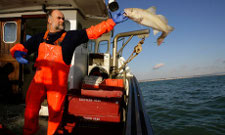
About 1m tonnes of fish are estimated to be thrown back into the North Sea each year. The EU Fisheries Council wants to ban the practice. Photograph: James Boardman
Giving member states greater powers over how to manage their fisheries is broadly popular with national governments. It could help to defuse tension over how the total catch in the EU's fisheries should be divided into quotas for each country.
Richard Benyon, the UK fisheries minister, said the meeting had made "progress, but there's still a long way to go" on the full package of measures. He said: "We are in favour of greater localisation because it will lead to better management of fisheries — the situation in the western Mediterranean, for instance, is very different to that in the North Sea, and the centralisation of powers in the hands of the European Commission does not always reflect that."
He said the changes would also mean countries could adopt an approach to fisheries management and quotas that spanned several years at a time — in contrast to today's system, where the yearly wrangling over quotas means most fisheries are managed a year at a time, without a long-term view.
No decisions will be taken on the reforms to the common fisheries policy until June. Then, serious rows are expected over the discard ban. Though conservationists are in favour, some countries and their powerful fishing industries want to postpone the ban or stop it altogether.
Further hazards from erosion
Just before Easter over thirty feet of sand was stripped from the beach between Newport and Winterton, so undermining and eroding the natural dune defence face and cutting them back by some fifty feet to leave an unstable overhang and a near vertical frontage some thirty feet high. On Good Friday, on holiday at Hemsby over Easter, two little girls, unsupervised by their parents, decided to attempt to climb the bank, when it collapsed on top of them leaving one buried up to her neck and the other to her armpits, unable to move, whilst the sand crumbled further on top of them.
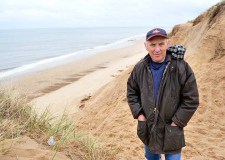
Kenny Chaney on Hemsby beach. He helped rescue two young girls after the cliff collapsed and buried the children. Picture: Nick Butcher
Luckily for them, retired fisherman Kenny Chaney, one of our colleagues, happened to be there on the beach, busy with his metal detector hunting for valuables uncovered, so was able to rescue them after hand digging for half an hour. Both survived, but only just. Spades could not be used as such use could have damaged the children's hidden limbs.
The full story by Sam Russell appeared on 12th April in the Great Yarmouth Mercury under the heading 'Warning after two girls nearly buried alive in sand at Hemsby'.
Such sand burials are not uncommon where the dune base has been eroded to leave an unstable overhang at the top where the marram grass fauna binds it. Only two weeks earlier two boys almost met the same fate at nearby Caister on-Sea, and just three years ago an airman from nearby RAF Coltishall was tunnelling into the dune face at Hemsby when it collapsed on him. He became totally buried and did not survive.
There are no sea defences other than this last remaining eroding dune of four along this popular stretch of coast, which has been decreed as to have 'no active intervention' under the Shoreline Management Plan. Soon now the last six remaining bungalows of an original ninety-eight will be lost, together with the lifeboat shed, deckchair shop, the beach cafe and the few remaining bungalows. The remains of some of the previously destroyed bungalows now pose a further hazard as the buried wreckage is being uncovered as the sand cover is lost, leaving glass from the windows and metal on, in and under the sand. Caches of bottles have been buried, become broken glass, and form another menace. In addition, World War II defences such as rusting steel poles, barbed wire and coupling clamps are being uncovered, another threat to beach users' feet and hands.
The dunes also form an important and vital habitat for lizards and adders, and the nests of fulmars and sand martins, thus are of environmentally essential also.
Sam Russell reported that a few months ago Children's BBC carried an item about Japanese deep hole digging contests, in which the presenter made a comment along the lines of "for those of you who like to dig holes at the beach". This was considered to be a thoroughly irresponsible item, linking the idea of deep hole digging with the seaside in the minds of child viewers. Plus the cliffs at Scratby-California-Hemsby are home to fulmar and sand martin in season and they should not be disturbed.
So it's not just the threat of erosion, the risk of drowning or being taken out to sea in toy dinghies, or the sewage content of the sea that poses a risk. The seaside can be a dangerous place in many ways.
EU Parliament's Environment Committee tables its amendments to the new draft CFP Basic Regulation
The European Parliament's Committee on the Environment, Public Health and Food Safety has tabled its amendments to the new draft Basic Regulation of the Common Fisheries Policy. Chris Davies MEP, Rapporteur for the Environment Committee, states in the introduction to their report: "The urgent need for reform of the Common Fisheries Policy (CFP) could not be more clear.
"Fish stocks in European waters have declined dramatically over recent decades and there is a risk that some may collapse entirely. One in four of the fish that are caught is wasted entirely, being thrown overboard dead, yet more than 60% of the fish that Europe consumes is now imported.
"There are too many fishing boats chasing too few fish, but the capacity of Europe's fleet is still increasing by 3% each year. The fishing industry is hardly profitable, and in many instances is kept alive only by subsidies; the acute financial difficulties promote short term thinking and unsustainable bad practices that have severely damaged the marine environment. We cannot continue like this.
"Fish stocks were declining long before the CFP came into being in 1983. Historical evidence suggests that in some cases the wooden fishing fleets of 100 years ago, dependent on sail and wind, were landing a greater tonnage of fish than the high-tech vessels of today, and on average the fish were much larger in size.
"Overfishing has a long history but the CFP has done little to curb it. The fault lies not with the idea of the EU having common rules but with the policy, and in particular with its application. Short term thinking has triumphed. Ministers meeting each year to set quotas are said on average to have exceeded scientific recommendations by as much as 48%.
"In consequence the number of fish has declined and the size of the fish caught has diminished. Current practices cannot provide a sustainable supply of food from the seas. Fortunately, our waters are capable of supporting many more fish than they now possess, and not every policy decision has proven wrong. Declines in some fish stocks have been reversed. In a small but growing number of cases EU policy is succeeding in helping fish stocks recover to levels that exceed maximum sustainable yield. This must be our ambition for them all.
"The European Commission is proposing far reaching reforms that include the following key elements:
- Establishment of long term management plans for all stocks, with the aim of achieving maximum sustainable yield by 2015;
- Annual allocation of fishing opportunities firmly based on scientific advice or, in itsabsence, on application of the precautionary principle;
- A ban on the discard, dead, of commercial species of fish;
- The introduction across Europe of rights-based management (transferable fishing concessions or TFCs) giving fishermen a commercial incentive to fish sustainably and addressing the problem of overcapacity;
- An end to micro-management from Brussels, with decentralisation of day-to-day decisions to regional bodies that can take account of local circumstances;
- Requirements that Europe's fleet will adhere to high standards when fishing in the waters of third parties;
- Encouragement for the development of aquaculture across Europe.
"The European Commission is leading the demand for change, and the Opinion Writer [Chris Davies MEP] welcomes and endorses the proposals it makes in this draft Regulation. But the text does not always make clear how the proposed arrangements will work in practice. There is a need for additional safeguards to ensure that the objectives are met and to promote sustainability, and for further measures to secure compliance.
"Through his amendments the Opinion Writer seeks to achieve the following:
- Promote measures intended to restore fish stocks;
- Strengthen the primacy of long term management plans, and curb the ability of governments to ignore scientific advice when setting annual quotas;
- Pave the way for extending a discard ban to all fish species;
- Provide greater protection for the marine environment;
- Demonstrate that systems of rights-based management (TFCs) can be shaped by Member States to meet national priorities and protect particular interests;
- Create greater opportunities for small scale and low impact fishing practices;
- Tighten the standards required of EU vessels fishing in foreign waters;
- Address concerns about aquaculture development;
- Emphasise that fishing policy must be transparent and open to public scrutiny.
"In drafting amendments the Opinion Writer has welcomed suggestions made by representatives of the following bodies: European Commission; governments of Denmark, France, Iceland, Norway, Sweden and the United Kingdom; Aquaculture Stewardship Council; BalticSea2020; Birdlife; Client Earth; Greenpeace; New Under Ten Fishermen's Association; Ocean 2012; Oceana; Pew Environment Group, UN FAO; WWF. However, responsibility for the proposals made lies entirely with him."
A full list of the amendments tabled
Defra says trials to reduce fishing discards are a success
UK fishermen have radically cut the amount of fish they discard following the success of the Government's 'Catch Quota' trials, Fisheries Minister, Richard Benyon has announced.
Last year's 'Catch Quota' trial was introduced to reduce discards of North Sea cod and for sole in the Western Channel and results show that those participating in the trail have been successful in reducing discards of both stocks to just 0.2%. In 2010, the average discard rates were 38% for North Sea cod trawlers and 28% for Western Channel sole beam trawlers.
Commenting on the trials Fisheries Minister Richard Benyon said: "This is a tremendous result and I applaud the contribution which fishermen have made to this success. I am very pleased that more fishermen have joined the 2012 catch quota scheme and I believe that we can build on the success of last year. Discards are a product of the broken Common Fisheries Policy and I will continue to press the EU until we eliminate this wasteful practice. I want to continue to work with industry to develop innovative solutions, such as the Catch Quota scheme, which reduce unwanted catches and work towards the elimination of discards. In doing so I want to ensure the fishing industry remains viable and profitable."
The UK is testing Catch Quota management which counts what is caught rather than what is landed at port. It is a key tool in reducing the wasteful practice of discards while maintaining a profitable fishing industry.
The scheme is being carried out on behalf of Defra by the Marine Management Organisation (MMO). James Cross, Chief Executive of the MMO said: "I'm really proud of our work and the contribution from the fishing industry in helping to develop innovative solutions to challenges facing both fishermen and the marine environment. The fantastic results of the trial demonstrate how beneficial it is for us to work together in looking at alternative ways of managing fisheries. We look forward to continuing this work in 2012-13 and achieving a more sustainable future for the industry."
Discards represent a waste of natural resources and one of the Government's priorities for reforming the broken Common Fisheries Policy (CFP) is to ensure the practice is eliminated. The UK Government hopes that a reformed CFP can bring an end to discards and believes the best way to do this is through an approach that addresses the problems which are specific to each fishery.
Discarding perfectly good fish can happen for many different reasons. For example, when fishermen have hit their quota or when they catch a fish they have no quota for. The trial has operated on a voluntary basis and fishermen who join the scheme have to account for everything they take out of the sea and land everything they catch, regardless of size, with CCTV used to check that they are sticking to the rules.
Participating fishermen have also drastically reduced discards of undersized fish of all species to between 0 and 3% of their total catch indicating the effectiveness of selectivity methods being used by the participating fishermen.
The final results of the catch quota trials for 2011 can be found using this link
The selling of fish being widely "mislabelled" as to species and origin throughout the EU
A Briefing, titled "It's fish, Captain, but not as we know it!" has been published by Ocean2012. This briefing exposes how overfishing impacts on the quality of fish people in Europe are eating. It is part of a series of briefings illustrating the impacts of overfishing on people or marine ecosystems caused by the excess removal of millions of tonnes of marine life every year.
Ocean2012 states: "A great fraud is being committed on an unsuspecting public in some EU member states: fish is being mislabelled and passed off as more expensive or even sustainably caught species. Why is this happening? Our demand for seafood is growing just as the availability of locally caught fish is declining because of overfishing. So the EU needs to import more and more fish, and these cheaper fish are flooding European markets — and often sold to us fraudulently.
"Did you know that 28 percent of all cod sold in Ireland is fake? Mislabelled pollack, saithe and whiting is passed off as cod — breading, smoking or battering the fillets disguises how the imposters look, smell and taste.
"These startling results were discovered when scientists collected random samples of fish bought at fish and chip shops, supermarkets and fishmongers in Ireland and tested the DNA.
"The tests also discovered that some fish labelled as 'sustainably sourced Pacific cod' was actually overfished Atlantic cod. So fraudsters are taking advantage of their customers' desire to buy sustainably caught fish. But the deception doesn't stop there: such widespread fraud is likely to hoodwink many unsuspecting people into thinking that cod stocks from Irish and North Sea waters are healthy because the species appears so readily available.
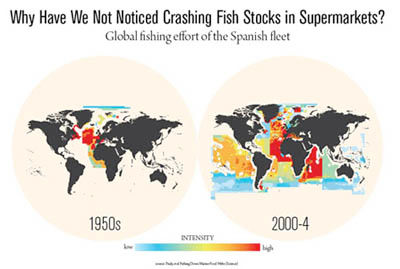
"Cod is to the Irish and British what hake is to the Spanish. Studies by the University of Oviedo, Spain, in 2004, 2006 and 2010 revealed high levels of mislabelling and species substitution: between 31 and 39 percent of hake was found to be cheaper African hake rather than the more expensive European-caught or American-imported hake. Even though, from a scientific perspective, there is no difference in the quality of the various hake species, Spanish consumers perceive a difference and are willing to pay more for locally caught, fresh hake. Average prices for European hake in 2010 (€11.72/kg) were almost double the price of African hake (€6.79/kg). The EU imports more than 100,000 tonnes of hake a year, of which up to 60 percent goes to Spain to make up for a significant shortfall in supply. Fraudsters cash in by claiming that hake from other parts of the world has been caught in local waters.
"Meanwhile in Germany, consumers are buying more, cheaper and poorer quality fish to fill the void left by overfishing. To make up for shortfalls in supplies of traditional cold-water, Northern Atlantic-caught species, Germany's supermarket freezer cabinets are stocked with pangasius, a fish farmed in the warm, fresh and brackish waters of southeast Asia, and also known as Vietnamese river cobbler or striped catfish.
"Until seven years ago it was virtually unknown, but now Germany has become a major market and the fish is offered on restaurant menus all over the country. It is now the fifth most purchased fish in Germany. From 1999 to 2009, imports of pangasius into the EU rose steeply from around 2,000 to more than 220,000 tonnes, replacing traditional markets for cod and hake. Some people believe it to be bland, almost devoid of flavour, while others wonder how anyone could expect it to taste of our cold northern seas when it is grown in muddy freshwater and brackish ponds in the rivers and deltas of South-east Asia? Even so, some consumers have been swindled — in 2009 several UK fish and chip shops were prosecuted for passing pangasius off as cod.
"Economists and trade analysts do not have to look very far to understand why the EU is importing vast quantities of pangasius and other species. According to researchers, if the EU relied solely on wild-caught fish from European waters to meet its yearly needs, the supply would run out by early July. Overfishing and increasing demand, on average a 15 percent annual increase by EU consumers creates an ever greater shortfall in supply which is made up by fish caught by EU vessels in distant waters, aquaculture and imported fish. It is the pressure on the fishing, processing and retail sector to find new sources of fish products and to keep making profits that creates the incentive to mislabel cheaper fish and sell them as more expensive species. Hiding 'imposter' fish in processed products such as oven-ready meals covered in sauces or fish-fingers and selling them in supermarkets or take-away outlets is pretty easy because we, as consumers, usually cannot tell the difference.
"How do we end overfishing? Politicians have responsibility for making the decisions that will end overfishing; citizens have the responsibility of choosing carefully what they eat, and encouraging and supporting their politicians to make those decisions. You can help end overfishing by speaking up and taking action to achieve a far-reaching ecological vision of healthy oceans and sustainable fisheries."
For further details of Ocean2012 Briefings, visit www.ocean2012.eu/pages/90-how-overfishing-impacts-you
MARINET advises UK Government that EU funding of fisheries must re-establish "food security"
The European Commission is currently reviewing the basis and objectives of its funding of the Common Fisheries Policy (CFP).
Europe has funded the CFP throughout its existence, ostensibly on the one hand in order to promote conservation by bringing the level of fishing in line with the level of stocks (i.e. to eliminate over-fishing), and on the other hand to promote the marketing of fisheries and their produce. The reality has been that whilst a great deal of finance has been given to "conservation objectives", over-fishing has persisted to the point where stocks are now heavily over-fished and depleted.
As part of the current review and reform of the CFP, the EU Commission is reformulating its objectives for CFP funding, and has put forward a new set of objectives for consultation, naming the new fund as the European Maritime and Fisheries Fund.
MARINET has commented to the UK Government, Defra, which has been conducting its own public consultation on the objectives of the new EMFF and CFP funding.
MARINET has informed Defra that CFP funding must, as its primary purpose, secure the re-establishment of food security from EU seas for the EU population. This must be the key strategic objective of CFP reform. Fish food security is defined as the ability to feed ourselves from our own seas for all 12 months of the year, year after year. Currently, EU fish stocks are so depleted that we can only meet this requirement for 6 months of the year, and have to make up the deficiency by importing fish from non-EU seas (Iceland and Norway) and via fishing agreements with nations elsewhere in the world — often developing nations who really need these stocks for their own populations and benefit.
The advice to the UK government from MARINET is that CFP funding must be targeted at the re-establishment of food security which is achieved by restoring fish stocks throughout EU seas to the maximum levels of abundance that current ecological conditions will permit (i.e. rebuilding fish stocks to a size where they can be harvested sustainably to meet all our needs) and that central to this achievement is the use of closed areas (marine reserves) centred on spawning and nursery grounds so that fish stocks can be rebuilt, with displaced fishermen and their vessels given a new economic role as the managers of these closed areas (i.e. patrolling in order to prevent illegal fishing and collecting scientific data) as the process of stock rebuilding is undertaken, thus guaranteeing a new and assured future to the fishing industry.
MARINET has told Defra that CFP funding via the new European Marine and Fisheries Fund (EMFF) must be focused in this manner, thereby bringing over-fishing strictly under control, and shifting the CFP onto conservation-based management principles rather than extraction-based principles. Nothing else makes sense. If we do not do this, EU fish stocks will continue on their relentless decline, the fishing industry will become wholly bankrupt and thus effectively extinct, and the EU population will no longer even to be able to eat fish from our seas — in short, a disastrous situation.
View the full text of the MARINET recommendations to the UK government on the EMFF and EU funding of the CFP.
Easton Broad could receive increased protection
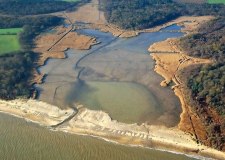
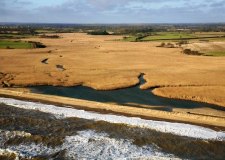
Easton Broad. Pictures by Mike Page in 2006
Easton Broad, close to Easton Bavents and Southwold, is fronted by a sand and gravel ridge tidally shaped by the tide with an open stretch of salt water immediately behind it. Beyond the open saline water is the UK's second largest freshwater reed-bed. The Easton River flows through the reed-bed and on, via a pipe under the sand and gravel ridge, into the sea. The area is quite unique and so is rightfully internationally designated as an SAC (Special Area of Conservation ) under the Habitats Directive.
It of course very vulnerable to the escalating coastal erosion, increasing wave attack, rising sea level and worsening climate, so is to receive increased protection from such damage under new plans drawn up by the Environment Agency that should maintain the status for the next 30 — 50 years. These should further protect the B1127 Reydon-Wrentham Road from flooding, whilst at the same time providing a new footpath along the lower berm of the new embankment as a safer route along the Suffolk Coast Path. (The Suffolk Coast Path is one of three long distance routes within the Suffolk Coast and Heath's Area of Outstanding Natural Beauty — for further information go to www.suffolkkcoastandheaths.org)
The EA plans to protect the conservation area follow after home-owners in nearby Easton Bavents secured a land rights pledge from Waveney District Council. It offers people whose homes are threatened by erosion to move to safe land nearby while retaining residential land use rights that allow them to build a similar property on the new site.
Welsh Government announces public consultation on its Welsh MCZ site selection
This consultation by the Welsh Government seeks views and information on the 10 potential site options in Welsh waters that have been identified by the Marine Conservation Zone (MCZ) Project Wales. Start of consultation: 19/04/2012 — End of consultation: 31/07/2012.
According to the Welsh Government press release, 19th April 2012 "The consultation explains how the potential sites options have been identified and the process that the MCZ Project Wales has followed. The aim is to end up with 3-4 sites for designation, through an iterative, phased consultation process. This consultation is the first of 3 consultation phases you will have the opportunity to comment on. Please respond either by e-mail or post.
"There will also be the opportunity to tell us your views by attending one of the public/sector specific events which will be held during the consultation period. Further information regarding the location and timing of these events will be available on this website soon.
"We have created a Geographical Information System (mapping) application to supplement the consultation document. It enables you to navigate the sites and see the ecological basis for the 10 potential site options. The application also allows you to view the potential sites in terms of scale and important habitats present.
"How to respond: Please submit your comments by 31st July 2012, in any of the following ways: Email Marine&wales.gsi.gov.uk. Post: Lindsey Powles, Marine Branch, Department for Environment & Sustainable Development, Welsh Government, 2nd Floor, CP2, Cathays Park, Cardiff CF10 3NQ. Additional information: If you have any queries on this consultation please telephone: 029-2080 1258."
Gas fracking gets the green light in the UK
Ministers have been advised to allow the controversial practice of fracking for shale gas to be extended in Britain, despite it causing two earthquakes and the emergence of serious doubts over the safety of the wells that have already been drilled. The advice of the first official British government report into fracking is all but certain to be accepted by ministers, with the result that thousands of new wells could be drilled across the UK.
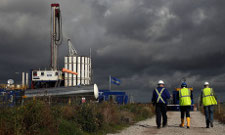
Cuadrilla shale fracking facility in Lancashire. The controversial method of extracting gas has been given the green light by experts. Photograph: Matthew Lloyd/Getty
The experts say hydraulic fracturing, whereby a well is drilled hundreds of metres deep and pumped full of water, sand and chemicals in order to release methane gas, should be allowed on a wide scale, although they accept that two small earthquakes in Blackpool last spring were caused by the first stages of fracking activities in the only British plants operating.
The government's own data revealed serious questions around the safety of fracking in areas of known seismic activity, such as the two wells in Lancashire, because of evidence that the resulting earthquakes have damaged the integrity of at least one well. There is also apparent confusion over which government agencies should be overseeing the process to ensure its public safety, with the responsibility shared among several bodies that appear not to be co-ordinating.
The report, written by Peter Styles, professor at Keele University, Brian Baptie of the British Geological Survey, and Christopher Green, an independent fracking expert, found that fracking "should include a smaller pre-injection and monitoring stage", which did not take place at the existing sites, and called for "an effective monitoring system to provide near real-time locations and magnitudes of any seismic events [as] part of any future fracking operations". Styles warned that further fracking in the Blackpool area was very likely to lead to further tremors: "The similarity of the seismic events suggests this is a highly repeatable source."
Andy Atkins, the executive director of Friends of the Earth, said: "We don't need earth tremor-causing fracking to meet our power needs — we need a seismic shift in energy policy. There should be a full scientific assessment of all the impacts of fracking — a short consultation on one of the problems is completely inadequate."
In the US, fracking has been associated with the contamination of water supplies and soil, and the danger of explosions. But Mark Miller, the chief executive of Cuadrilla Resources, which drilled the British earthquake sites, said: "We are pleased the experts have come to a clear conclusion that it is safe to allow us to resume hydraulic fracturing, following the procedures outlined in the review."
In April last year, around Cuadrilla's main Blackpool site, there was a tremor measuring magnitude 2.3 and in May one measuring magnitude 1.5. These tremors are enough to be felt but do not in themselves cause serious damage.
The report, titled Preese Hall Shale Gas Fracturing: Review and Recommendations for Induced Seismic Mitigation, concluded that both earthquakes were related to the drilling. The report also revealed another concern — instruments showed the second tremor had caused "deformation" to the structure of the well.
This is of concern because if the integrity of a well is compromised, it could cause future problems with leakage and contamination, and raises longer term concerns about the design and viability of such wells, according to Mike Hill, an industry expert. He is worried that the monitoring of the cement casings for the fracking wells is inadequate, as officials have been unable to provide detailed information on their monitoring.
Christopher Green, one of the authors of the report, said: "We have indicated we would like further tests to be done to check the well integrity by the Health and Safety Executive." David Mackay, chief scientific adviser at the Department of Energy and Climate Change (Decc), said: "This comprehensive independent expert review of Cuadrilla's evidence suggests a series of robust measures to makes sure future seismic risks are minimised, not just at this location but at any other potential sites across the UK." A Health and Safety Executive spokeswoman told the Guardian: "Damage to the Preese Hall well was minor and mechanical and below the level where gas would be extracted and therefore not significant enough to have an effect on safety." She said Cuadrilla had been asked to conduct tests on whether the well was still intact or had been damaged.
The scientific group advising Decc proposed that fracking operations should be subject to a "traffic light" system in future, with the presumption of a green light, followed by amber if the drilling led to a small earthquake of less than 0.5 magnitude (a level that could not be felt on the surface), and a red light if earthquakes exceeded that level. They stressed that even the two earthquakes felt in Lancashire last year would not cause lasting damage, but could add to "public alarm".
Implementing this recommendation is likely to add significantly to the cost of drilling operations — the experts estimate it could be more than £100,000, but other experts suggested it could be many times that for each well, which would make exploration less attractive.
When a fracking well is drilled, the initial well extends hundreds of metres below the surface. Thousands of litres of water mixed with sand and chemicals are then blasted through to open up small fractures in the dense rock at the base of the well. This shale rock contains tiny bubbles of natural gas that are released by the fracturing process, and which eventually — over the course of years — find their way to the surface to be collected in pipelines.
Shale gas is now one of the major sources of energy in the US, following years of intensive fracking operations, but critics point to ravaged landscapes, contaminated water supplies and potentially damaging pipeline installations left by industrial-scale operations, as well as concerns over the long-term safety of the wells. Although natural gas is supposed to be a "cleaner" fuel than coal, releasing less carbon when burned, evidence also suggests fracking produces more carbon than exploring for conventional gas supplies, making the fuel less attractive from an environmental point of view.
Estimates of the amount of shale gas in the UK vary widely. Cuadrilla puts the potential resources in Lancashire alone at a 200 trillion cubic feet — an amount that could supply the whole of the UK's gas needs for more than five decades.
But using more conservative methods, the British Geological Survey put the likely resources at 4.7 trillion cubic feet, one-40th of the company's figure. Even then, only about 5% to 10% of that figure is likely to be recoverable. In order to wring the maximum from the UK's resources, there will need to be six to eight wells per square mile around each of the tens of sites to be explored, including as many as 800 in Lancashire and more in areas such as Sussex.
Some groups — including The Global Warming Policy Foundation, the climate-sceptic think tank led by Lord Lawson — have been enthusiastically advocating the take-up of the technology. But residents in the areas affected have been mobilising against the plans.
Environmental groups are worried not just about the potential dangers from earth tremors caused by fracking, but about the effects on the UK's push to tackle climate change. Last month, the chancellor, George Osborne, and the new energy secretary, Ed Davey, launched a new "dash for gas" when they announced measures to encourage the building of new gas-fired power stations across the UK. Green groups argue this will put carbon-cutting targets out of reach, by locking in high-carbon emitting infrastructure and crowding out investment in renewables. "We should be developing the huge potential of clean British energy from the sun, wind and waves, not more dirty and dangerous fossil fuels," said Atkins.
French company wants "more incentives" before proceeding with new nuclear plant in Cumbria
Then UK government's energy policy has suffered a fresh blow when GDF Suez, the French firm behind plans to build a new nuclear plant in Cumbria, said it needed more financial incentives if it was to proceed.
Gérard Mestrallet, chairman and chief executive of GDF, said he wanted talks with the government about the right fixed or minimum price for producing nuclear energy: "We are, with our partners, going to take a decision in 2015 [on building a new plant at Sellafield]. Today it is very difficult to invest in a nuclear power plant without clear visibility."
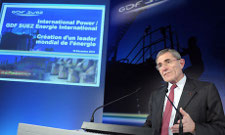
GDF Suez's chief executive Gérard Mestrallet says the government's proposed fixed carbon price is not enough. Photograph: Eric Piermont/AFP/Getty Images
The UK government has promised to provide a fixed carbon price to make nuclear investment more attractive, and has proposed a "contract for difference" which some say will act as a price guarantee. But Mestrallet said what was on offer was "not enough and something is missing".
The comments will send a shock wave through Whitehall because they come just weeks after the German utilities RWE and E.ON said they would not proceed with plans to build new nuclear plants at Wylfa in Wales and Oldbury in Gloucestershire.
The German firms run the Horizon joint venture in Britain. They cited concerns about financing the projects as well as costs associated with Germany's abandonment of nuclear power in the aftermath of the Fukushima accident in Japan. This would leave only GDF and the major French electricity producer EDF in the race to build new atomic plants in the UK.
GDF has its own joint venture with Iberdrola of Spain called NuGen which insisted after the E.ON and RWE announcement that it remained "committed" to its planned 3.6 gigawatt plant at Sellafield. But Mestrallet's words make clear that GDF will only proceed if the British government makes further concessions to nuclear, something industry critics feared would happen.
The GDF warning came as the French grip on Britain's energy infrastructure tightened with a plan to take full control of International Power (IP) for about £6.5bn. IP operates key power stations around the country including the gas-fired plant at Satend near Hull and a coal-fired facility at Rugely, in Staffordshire, as well as many others abroad.
The move could exacerbate concerns about the undue influence of companies partly owned by the French state such as EDF, Areva and GDF — which have already big stakes in the British energy market. The French government is the biggest shareholder in GDF with 36%. GDF, the world's largest independent power producer, bought 70% of IP in 2010, but has now agreed to buy the remaining stake for 418p a share.
Mestrallet said the acquisition of the minority stake in IP constituted a major step that would "allow the group to fully capture growth in fast growing markets". He denied further control by GDF of the UK business could be anything but good and said EDF was a "competitor" not a French state collaborator.
An earlier offer from GDF at 390p a share had been resisted by the British company's board but Sir Neville Sims, chairman of the committee of independent directors at IP, said he had no difficulty recommending the new offer. It represented a price that "fairly reflects the company's position in international power generation markets and its inherent growth potential," he said.
The independent directors will recommend that shareholders vote in favour of the deal at the annual meeting on 15 May. The deal would be the second biggest this year after Glencore International's offer for mining group Xstrata. Angelos Anastasiou, a utility analyst with Investec Securities, said this was the right price for a business of this sort, adding: "We see the offer progressing smoothly to its conclusion." But the acquisition by GDF follows the purchase by EDF of nuclear operator British Energy and the growing influence of French nuclear engineering firm, Areva.
Jonathon Porritt, director of sustainability group Forum for the Future, recently expressed deep misgivings about the situation. He said in the Guardian last month: "UK energy policy is being manipulated and subverted to make it possible for French nuclear power companies (EDF and Areva) to start building four new reactors in the UK — two at Hinkley Point in Somerset and two at Sizewell in Suffolk."
IP runs six UK power stations including some wind farms. It has recently reduced the power output from a Teesside gas plant from 1,875 megawatts to 45MW, describing the commercial environment in Britain as "challenging". But of particular interest to GDF is IP's 6,600-MW building programme abroad, mostly in developing countries. Almost three-quarters of recent operating income has come from nations like Brazil, Indonesia and Saudi Arabia.
"The Sounding of the Whale" — Book Review
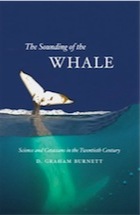
The Sounding of the Whale is a remarkable book, an astounding piece of research that presents subtle, original arguments in a stylish and readable (if sometimes mannered) prose. Burnett's subject is the development of whale science in the 20th century, which takes in the work of zoologists, paleontologists, biological oceanographers, ecologists, neurologists and mathematicians, among others. The individual scientists are brought to life and their work is beautifully contextualised. Burnett shows us the many ties that bound whale scientists, disastrously, to the whaling industry. He also does a wonderful job of placing the science of cetology in its institutional settings, both academic and political.
Emperor Penguin populations are counted from space
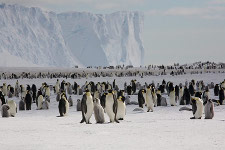
Emperor penguins on the sea ice close to Halley Research Station. Photo British Antarctic Survey
Emperor penguins have become the first creatures to be counted from space. The first census of a entire species using satellite images reveals double the number of the birds, meaning the impact of climate change can be monitored far more accurately.
New research using very high resolution satellite images has revealed almost double the number of Emperor penguins living in Antarctica — 595,000 birds — compared to the last survey in 1992.
Happisburgh homes meet their demise
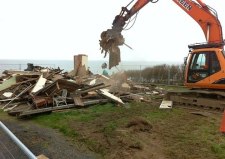
Flattened — the first house to be demolished is reduced to rubble.
The end is imminent for nine cliff top homes at Happisburgh, the first of which came on 11th April when bulldozers moved in to start demolition, the owners of all but one house having finally accepted 40% of their value provided under the 'Pathfinder' scheme by North Norfolk Council. (See previous 'Happisburgh homes being demolished' and many previous mentions on this website that can be found by searching on this website with the key word 'Happisburgh).
Later may follow the demolition of the old Beach Road car park and the former lifeboat and coastguard stations, before the machines return to the destroy the remaining homes on Beach Road.
Just one house was spared, that belonging to Bryony Nierop-Reading, who chose to reject the offer of money from the Pathfinder scheme and opted to stay in her home, knowing its days were numbered. Close to tears, she stood in her garden to watch as the demolition contractors move in to cart away the rubble made of her neighbours house.
The Happisbugh home owners have put up a long and fight for justice over many years in an effort to save their homes, which were threatened when the original sea defences were not renewed and the government consistently refused to stump up the cash needed to shore up the coast under their Shoreline Management Plan (SMP). Actions such as rock bunds placed by North Norfolk District Council had some effect in slowing down the rate of erosion, but with sea rise, storms elevating and offshore aggregate dredging still continuing, the loss of the cliff face relentlessly continued.
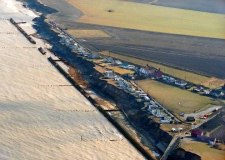
An aerial shot of Beach Road in Happisburgh in 1998. PHOTO Mike Page.
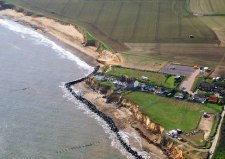
An aerial photograph of Beach Road in Happisburgh in recent days. PHOTO: Mike Page.
The self-same demise of people's homes and businesses will be a regular feature in the future where many other parts of our coastline have been denied protection by way of maintaining sea defences under the government's SMP where 'no active intervention' i.e. 'let it go to the sea' have been indicated. (See under 'Coastal Defences and Shoreline Management Plans at www.marinet.org.uk/coastaldefences.html)
Should the annual Canadian seal cull continue?
Mimi Bekhechi reports in The Guardian: "Thursday, 12th April, marks the official start of Newfoundland's and Labrador's spring seal-slaughtering season. More than two thousand seals have been killed so far this year. Many more will be clubbed or shot before sealers hook them in the eye, cheek or mouth and drag them across the ice floes off Canada's east coast. Some will be skinned while they are still alive. Each one of them is a victim of the Canadian government's desperate efforts to keep the failing sealing industry afloat. Many had hoped that the seal slaughter would not happen this year. The Canadian government's decision to go ahead with this annual bloodbath — despite the fact that there is no longer any market for seal fur — makes no economic sense.
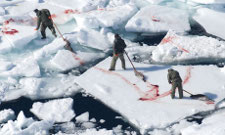
'The majority of Canadians are opposed to the annual seal slaughter.' Photograph: Stewart Cook / Rex Features
What should have been the final nail in the coffin of the seal slaughter came last December when Russia — which had been buying 95% of Canadian seal pelts — joined the EU, Mexico and the US in banning seal-fur imports. Russian president Vladimir Putin has called seal hunting a "bloody business that should have been banned long ago" and later ended seal imports after Pamela Anderson led an international appeal on behalf. In September, the EU rejected an obviously orchestrated attempt by the Canadian government, in its challenge of the EU ban on seal products, to play the "native Canadian Inuit" card. But the Inuit live far from "the front" — the area where the mass commercial slaughter takes place — and are responsible for only about 3% of Canada's annual seal kill. The EU already exempts Inuit seal products from the ban.
The seal slaughter most definitely doesn't continue because of support in Canada. Polls have consistently shown that the majority of Canadians are opposed to the slaughter. Millions in taxpayer money are being wasted to prop up this dying industry. The federal government pours up to CAN$7m (£4.4m) a year into maintaining an industry that nets only about $1m. While seal pelts used to earn sealers more than $100 each, the Canadian Department of Fisheries and Oceans reported that in 2010, pelts were sold for only about $20 to $25. At this rate, sealers can hardly cover their operating costs.
Very few sealers took part in the 2011 slaughter, and they killed less than 10% of the 400,000-seal quota. One of the largest seal-processing companies, NuTan Furs, has just announced that it will not buy any seal pelts this year. The Canadian government has been trying to peddle seal products in China, but groups like PETA Asia have been working hard to ensure that doesn't happen. Desperate times call for desperate measures, and the provincial government of Newfoundland and Labrador even just announced it would provide $3.6m in financing for a fur processor.
So why does the Canadian government still allow thousands of seals to be slaughtered in such barbaric ways, squandering millions in tax dollars and staining the country's international reputation in the process? It likely won't surprise you to learn that the answer is politics. Both the liberal and conservative parties are desperate to control the swing seats in Newfoundland. But now even Canadian politicians are openly questioning the slaughter. Ryan Cleary, a member of the Canadian parliament who represents one of the regions in which the seal slaughter takes place, summed up the general feeling when he acknowledged: "Part of our history is also whaling, for example, and the day came when the whaling industry stopped. Now, is that day coming with the seal hunt? It just may be".
That day has come, in fact it's long overdue. It's more important now than ever for people to speak out against this cruelty.
Arctic oil rush will ruin ecosystem, warns Lloyd's of London
Lloyd's of London, the world's biggest insurance market, has become the first major business organisation to raise its voice about huge potential environmental damage from oil drilling in the Arctic. The City institution estimates that $100bn (£63bn) of new investment is heading for the far north over the next decade, but believes cleaning up any oil spill in the Arctic, particularly in ice-covered areas, would present "multiple obstacles, which together constitute a unique and hard-to-manage risk".
Richard Ward, Lloyd's chief executive, urged companies not to "rush in [but instead to] step back and think carefully about the consequences of that action" before research was carried out and the right safety measures put in place. The main concerns, outlined in a report drawn up with the help of the Chatham House think-tank, come as the future of the Arctic is reviewed by a House of Commons select committee and just two years after the devastating BP blow-out in the Gulf of Mexico.

The report, by Chatham House analysts, warns: 'Other than the direct release of pollutants… there are multiple ways in which ecosystems could be disturbed.' Photograph: Alamy
The far north has become a centre of commercial attention as global temperatures rise, causing ice to melt in a region that could hold up to a quarter of the world's remaining hydrocarbon reserves.
Cairn Energy and Shell are among the oil companies that have either started or are planning new wells off the coasts of places such as Greenland and Canada, while Total — currently at the centre of a North Sea gas leak — wants to develop the Shtokman field off Russia. Shtokman is the largest single potential offshore Arctic project, 350 miles into the Russian-controlled part of the Barents Sea, where investment could reach $50bn.
A BP joint venture is planning to spend up to $10bn on developing onshore oilfields in the Yamal-Nenets autonomous area of Russia, despite its experiences with the Macondo oil spill in the relatively benign waters of the Gulf. A series of onshore mining schemes are also planned, with Lakshmi Mittal, Britain's richest man, wanting to develop a new opencast mine 300 miles inside the Arctic circle in a bid to extract up to £14bn of iron ore.
But the new report from Lloyd's, written by Charles Emmerson and Glada Lahn of Chatham House, says it is "highly likely" that future economic activity in the Arctic will further disturb ecosystems already stressed by the consequences of climate change.
"Migration patterns of caribou and whales in offshore areas may be affected. Other than the direct release of pollutants into the Arctic environment, there are multiple ways in which ecosystems could be disturbed, such as the construction of pipelines and roads, noise pollution from offshore drilling, seismic survey activity or additional maritime traffic as well as through the break-up of sea ice."
The authors point out that the Arctic is not one but several ecosystems, and is "highly sensitive to damage" that would have a long-term impact. They are calling for "baseline knowledge about the natural environment and consistent environmental monitoring". Pollution sources include mines, oil and gas installations, industrial sites and, in the Russian Arctic, nuclear waste from civilian and military installations, and from nuclear weapons testing on Novaya Zemlya. The report singles out a potential oil spill as the "greatest risk in terms of environmental damage, potential cost and insurance" — but says there are significant knowledge gaps in this area.
Rates of natural bio-degradation of oil in the Arctic could be expected to be lower than in more temperate environments such as the Gulf of Mexico, although there is currently insufficient understanding of how oil will degrade over the long term in the Arctic. Sea ice could assist in some oil-spill response techniques, such as in-situ burning and chemical dispersant application, but this could lead to air pollution and the release of chemicals into the marine environment without knowing where moving ice will eventually carry them.
Unclear legal boundaries posed by a mosaic of regulations and governments in the Arctic are an additional challenge. The Lloyd's report notes that there is no international liability and compensation regime for oil spills. An EU proposal under discussion would apply to offshore oil projects in the Arctic territories of Norway and Denmark, and possibly to all EU companies anywhere they operate.
Meanwhile, a task-force is drawing up recommendations for the intergovernmental Arctic Council on an international instrument on marine oil pollution designed to speed up the process for clean-up and compensation payments, due for release next year. This may include an international liability and compensation instrument. Greenland has argued that "different national systems may lead to ambiguities and unnecessary delays in oil pollution responses and compensation payments" and that any regime must adapt as understanding of the worst-case scenario in the Arctic changes.
The Lloyd's report says the "inadequacies" of both company and government in the event of a disaster were demonstrated after the Macondo blow-out. A smaller company than BP, faced with estimated $40bn clean-up and compensation costs, might have gone bankrupt, leaving the state to foot the bill, it notes.
Lloyd's says it is essential that there is more investment in science and research to "close knowledge gaps, reduce uncertainties and manage risks". It calls for sizeable investment in infrastructure and surveillance to enable "safe economic activity" and argues that "full-scale exercises based on worst-case scenarios of environmental disaster should be run by companies".
The Arctic's vulnerable environment, unpredictable climate and lack of a precedent on which to base cost assessments have led some environmental NGOs to argue that no compensation would be worth the risk of allowing drilling to take place in pristine offshore areas. Others are campaigning for more stringent regulations and the removal of the liability cap for investors.
Network of seabed cables to connect UK to alternative energy sources
The volcanoes of Iceland could soon be pumping low-carbon electricity into the UK under government-backed plans for thousands of miles of high-voltage cables across the ocean floor.
The energy minister, Charles Hendry, is to visit Iceland in May to discuss connecting the UK to its abundant geothermal energy. "We are in active discussions with the Icelandic government and they are very keen," Hendry told the Guardian. To reach Iceland, which sits over a mid-ocean split in the earth's crust, the cable would have to be 1,000 to 1,500km long and by far the longest in the world.
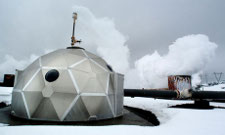
Iceland could soon be pumping low-carbon electricity into the UK under government-backed plans for thousands of miles of high-voltage cables across the ocean floor. Photograph: Alamy
Hendry has already met the head of Iceland's national grid about the plan. The web of sea-floor cables — called interconnectors — planned for the next decade would link the UK to a Europe-wide supergrid, which is backed by the prime minister. The supergrid would combine the wind and wave power of northern Europe with solar projects such as Desertec in southern Europe and north Africa to deliver reliable, clean energy to meet climate change targets and reduce dependence on fossil fuel imports.
There are two existing international interconnectors, to France and the Netherlands, but nine more are either in construction, formal planning or undergoing feasibility studies. The next to open, in autumn 2012, will be a link between the Republic of Ireland and Wales, allowing green energy from the windswept Atlantic coast of Ireland to be delivered to British homes.
The UK has been energy independent for virtually its entire history. But with the North Sea's oil and gas failing and coal banned as too polluting, Hendry is frank about the future: "We will be dependent on imported energy." The cables "are an absolutely critical part of energy security and for low carbon energy", he said.
The government's legally binding targets to reduce carbon emissions is another key driver for the new interconnectors, which if all built could supply a third of the nation's average electricity demand. Renewable energy, such as the offshore wind power at the heart of the government's renewable plans, is zero carbon once built but is also intermittent, meaning back-up gas plants or energy storage are needed. A 900km interconnector to Norway, due to open by 2019, would enable excess wind energy to pump water into storage lakes above the fjords. Then, when the electricity is needed, floodgates are opened and the water flows back down through turbines. Both the pump storage and the high-voltage direct-current interconnectors lose very little energy.
Another ambitious interconnector would link England to Alderney, where very strong tides could produce 4GW of electricity, and then on to France and the new 1.6GW nuclear power plant being built at Flamanville. Commercial agreements for this were signed in February.
Interconnector cables can be laid very rapidly — at over 30km a day — but remain significant engineering projects, with each kilometre containing 800 tonnes of copper. The most time-consuming aspect is settling international agreements and preparing landing sites and pylons to handle and distribute a large amount of electricity. "It's like taking a large nuclear power station onshore," said Hendry.
He argued that a web of high-voltage cables ending the energy isolation of the British Isles will help keep household energy bills down, by allowing access to the cheapest energy at any particular time.
Tony Glover, at energy grid trade body the Energy Networks Association, said: "For consumers the ability to link electricity supplies from the rest of Europe is good for competition and will generally help to keep prices competitive." The interconnectors can be built commercially with operators paying for the investment by taking a cut on the electricity transferred.
As well as consumer energy bills, Hendry also argued that interconnectors will help reduce the cost of the intermittency of renewable energy. "Interconnectors are an incredibly effective way to counter the argument that you need to back up each gigawatt of wind with a gigawatt of gas — they quite clearly show you do not," he said.
Interconnectors require large investments. The Britain-Netherland interconnector, which opened in 2011 and was the first international link in 25 years, cost £500m. But Greenpeace's Doug Parr said: "Interconnectors are the cheapest way of backing up wind, because you avoid the greater capital cost of building power stations. We will of course be buying power in when the wind is not blowing, but the interconnectors mean we can sell our wind power when it does, and we have the best wind resource in Europe."
However, Simon Less at the thinktank Policy Exchange, urged caution in relying on interconnectors for back-up: "Major new interconnection in north western Europe might not offset much of the need for backup plant because winter high pressure weather patterns can extend low wind conditions right across Europe."
Norway's pump storage could counter that fear but there is competition for access to that resource, with Germany also negotiating over an interconnector. "We are keen we should be first," said Hendry.
UK government offers £20m "prize fund" to wave and tidal energy developers
Companies making devices that generate renewable energy from the ebb and flow of tides and waves around the UK could win a share of a new £20m government prize.
It is hoped the scheme, the Marine Energy Array Demonstrator (Mead), will encourage growth in the industry, which has been struggling to create a commercially viable projects. Ministers believe wave and tidal power could in the future generate up to 20% of Britain's energy needs and create 10,000 jobs in the sector.
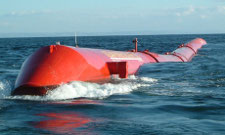
Marine energy companies such as Pelamis, the manufacturer of this wave 'snake', could win a share of a new £20m government prize announced on Thursday. Photograph: Pelamis
The energy and climate change minister, Greg Barker, claimed Mead would help move the industry into the next stage of development. "This will take us one vital step closer to realising our ambitions of generating electricity from the waves and tides, powering homes and businesses across the whole of the UK with clean, green electricity," he said.
The prize money will be shared between two winners, who will develop the first wave and tidal devices to sit in array formation — much like clusters of wind turbines create a windfarm.
Pelamis, a leading wave technology company based in Scotland, said it intended to enter the competition. A spokesperson for the Scottish-based company said: "The prize will provide much needed capital support to the industry. The increasing activity and utility support demonstrates a real excitement within the sector as the technology matures towards commercial deployments."
As an island situated in choppy waters, Britain is well placed to become a world leader in wave and tidal technology. Of the eight full scale prototype devices installed around the world, seven are in UK waters, and about half of the world's leading marine technology companies are based here. But there is a growing fear that Britain will lose its early lead in the race to harness the power of the sea.
In February MPs called on the government to increase their support of wind and wave technology, claiming the UK could be overtaken by competing countries if it did not continue to provide subsidies and support to the industry.
The funding was welcomed by the UK's professional body for the renewable wind and marine industry, RenewableUK. David Krohn, the organisation's wave and tidal development manager, said: "The marine energy industry has the potential to allow us to generate clean electricity using the inexhaustible power of the sea. The Mead scheme will help kick-start the industry." Yet Krohn claimed more money would still be needed if marine technology was to reach its full potential. "Our research shows that £120m of capital support is required to overcome barriers to commercial development and unlock our share of this global industry," he said. "It is important to recognise that this is only the beginning of the road to building marine energy into a fully commercial industry."
Pelamis agreed further support was needed. "To truly support marine renewables through to commercialisation will require project investors to be able to access substantially larger amounts of Government support over the coming years." Companies can enter the competition online via the Decc website. The closing date for applications is 1st June 2012.
Awareness and action over marine plastic pollution is beginning to develop
John Elkington reports in The Guardian's Sustainable Business section, 1st June 2011: "Ian Kiernan is one of the most interesting people I have met. When I saw him in Sydney last year, he told me of a defining moment in his life: when he was involved in the BOC Challenge solo yacht around-the-world race and found himself in the legendary Sargasso Sea. Having looked forward for years to seeing the fabled golden weeds, he came on deck to find his boat surrounded by plastic debris.
As he put it later: "I can't overstate the disappointment I felt when I found this sea of magic and myth littered with rubbish from discarded thongs, plastic buckets and disposable nappies, to toothpaste tubes and plastic bags."
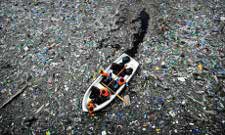
Despite decades of efforts to prevent and reduce marine debris, the problem continues to grow. Photograph: Dimitar Dilkoff/AFP/Getty Images
In 1989, at the same time we were developing the green consumer movement, he decided to make a difference in his own backyard, Sydney Harbour. He organised the first Clean Up Sydney Harbour Day, motivating 40,000 volunteers to remove rusted car bodies, plastics of all kinds, glass bottles and cigarette butts. His conclusion: if a city could mobilise to take action, so could the whole nation. Almost 300,000 volunteers turned out on the first Clean Up Australia Day in 1990 — and that involvement has steadily increased over the ensuing years.
Julia Hailes, my co-author on The Green Consumer Guide in 1988, had previously served as crew on a yacht with the late Teddy Kennedy — and recalled hearing those aboard complaining about the plastic litter they were sailing through, while their crew gaily tossed sacks of rubbish overboard.
All of this was brought forcefully back to mind when David de Rothschild followed in the wake of one my all-time heroes, Thor Heyerdahl. But instead of building his raft out of balsa, like the Kon-Tiki, the Plastiki was constructed from plastic bottles. And, in addition to seeing far fewer top predators than Heyerdahl did, the Plastiki crew were appalled by the immense amounts of plastic debris they found in great, swirling gyres in mid-ocean, areas that now go under the collective title of the Great Pacific Garbage Patch.
Despite decades of efforts to prevent and reduce marine debris, such as discarded plastic, abandoned fishing nets and industrial waste, the problem continues to grow. When I spoke at the PlasticsEurope PolyTalk '11 conference in France in May, I discovered that organisations that many see as brakes on progress — trade associations and industry federations — are finally coming together to tackle the problem.
The Fifth International Marine Debris Conference earlier in the year, which brought together experts from 35 countries, governments, research bodies, corporations including Coca-Cola, and trade associations such as Plastics Europe, resulted in new commitments and partnerships to address the issue of marine debris.
One key outcome was the Honolulu Commitment, hopefully symbolising a new, cross-sectoral approach to help reduce marine debris, as well as the growing damage they can cause to marine habitats and, ultimately, the global economy. At least 267 marine species worldwide are affected by entanglement in or ingestion of marine debris, including 86% of all sea turtles species, 44% of all seabird species and 43% of all marine mammal species.
There is also growing concern over the potential impact on human health of toxic substances released by plastic waste in the ocean. Small particles (known as microplastics) made up of disintegrating plastic items or lost plastic pellets used by industry, may accumulate contaminants linked to cancer, reproductive problems and other health risks.
One of the key themes to emerge from the Honolulu Marine Debris Conference was the need to improve global waste management. Improving national waste management programmes not only helps reduce the volume of waste in the world's seas and oceans and subsequent damage to the marine environment, but can also bring real economic benefits.
In the Republic of Korea, a policy of "extended producer responsibility" has been enforced on packaging (paper, glass, iron, aluminium and plastic) and specific products (batteries, tyres, lubricating oil) since 2003. This initiative has resulted in the recycling of 6m metric tonnes of waste between 2003 and 2007, increasing the country's recycling rate by 14% and creating economic benefits equivalent to $1.6bn (£971m).
Waste management is one of ten economic sectors highlighted in Unep's (United Nations Environment Programme) Green Economy Report, launched in February. The report highlights enormous opportunities for turning land-based waste — the major contributor to marine debris — into a more economically valuable resource. The value of the waste-to-energy market, for example, which was estimated at $20bn in 2008 is projected to grow by 30% by 2014.
You still find plenty of people in the industry prepared to argue that plastic products — particularly plastic bags — are but a small part of the problem. Ignore them. As Ian Kiernan has put it, "Just like climate sceptics, our political leaders continue to listen to the self-interests of industry that claim plastic bags are not a problem."
Yet a Unep report, Marine Litter: A Global Challenge, found that plastic, especially plastic bags and PET bottles, is the most pervasive type of marine litter on the planet, with plastic making up over 80% of all rubbish found in seas worldwide. "Plastic bags alone make up almost 10%," Ian Kiernan stresses.
One chink of light comes from the fact that PlasticsEurope helped convene 47 plastics industry organisations in Honolulu to sign a joint declaration on solutions for marine litter. Interestingly, Cleaning Up Sydney Harbour is now a global phenomenon, in the form of Clean Up the World, which mobilises an astounding 35 million volunteers in 130 countries each year. Little more than a drop in the ocean of the overall problem, but a powerful indication of the potential muscle of the anti-litter movement. Now all people like Ian Kiernan, David de Rothschild and the rest of us have to do is breathe down the necks of these associations for the next 40-50 years.
C.O.A.S.T. seeks re-establishment of the "flame shell" in Arran's coastal waters
The Community of Arran Seabed Trust (COAST) reports: "Research into the ecological history of our local seabed has revealed that flame shells disappeared within recent times. What led to the local extinction of this important habitat-forming mollusc and might it return to Arran's coastal waters?
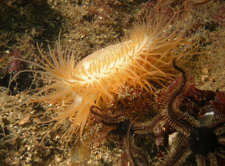
Limaria hians — disappearing flame shells reveal seabed potential
Recent evidence has emerged from local research that the now rare flame shell Limaria hians was once widely distributed in the Clyde and common in Lamlash Bay. Detailed study of historical records reveal that the bivalves were collected from the Clyde by several Victorian naturalists, with the Rev. Dr. C. P. Miles (1810-91) stating that 'although rare in many localities they have an extensive range in the Clyde, the nests being found between Largs and the Cumbraes, and on the Argyllshire side, as high up as Hunter's Quay, Dunoon. But the station where it is really abundant is Lamlash Bay'.
Unfortunately the beautiful flame shell, which forms important biogenic reefs or nests of shells linked by byssus threads, is now only found at a few places in Scotland and has not been recorded in Lamlash Bay for many years. While it is likely that the species and its habitat have been heavily impacted by the action of scallop dredgers and bottom trawlers, this evidence shows that the seabed of the Clyde once provided suitable habitat for the creature, and may do so again if the waters of the Clyde were to be sustainably managed.
COAST believes that this is possible with the support of Clyde communities and political will from the Scottish Government to stop damaging fishing practices in favour of sustainable methods. To help achieve this COAST is currently campaigning for a Marine Protected Area around the south of Arran.
In the 19th Century the waters of the Clyde were a popular destination for marine naturalists who carried out detailed studies of the marine life found here. Two notable researchers were Dr David Lansborough of Salcoats (1779-1854) and Thomas Henry Huxley (1825-1895) who became an early supporter of Darwin. Huxley noted the diversity of marine life in Lamlash Bay, which seemed to be acting like a giant nursery for a huge number of life forms. Besides their inherent beauty and intrinsic value, it is the functional importance of habitat forming species such as the flame shell which makes it, and other species such as maerl, crucial to the regeneration of the Clyde marine environment. The flame shell is recognised by Scottish Natural Heritage as a Marine Priority Feature and it is surely worth encouraging its return as much as protecting its current distribution.
The historic sources cited above were taken from The Marine Species of Lamlash Bay in the Nineteenth Century by Colin Cowley, 2012. Read more about the flame shell in this issue's Featured Species: Limaria hians.
Birds Eye claims that all of its annual sales of 185 million fish fingers are "sustainably sourced"
Birds Eye, the UK's leading frozen food brand, has announced that its entire range of cod and haddock fish fingers has achieved MSC certification. The move will switch 5,200 tonnes of fish products to sustainably certified produce in the UK market and increase the total weight of MSC labelled products sold by 20 per cent.
The UK consumes over 185 million of the fish fingers each year. Today's news means that 62 million British mealtimes will now be made from certified, sustainably sourced produce.
The move comes at the beginning of the 15th year of the MSC, which was co-founded by the Birds Eye brand, WWF and international conservation leaders, to create an independent certification and ecolabel programme for sustainable and well-managed fish. The MSC certification means the fishery has demonstrated that it is well managed and sustainable through a comprehensive, independent scientific assessment. The switch to more MSC certified supply forms part of Iglo Group's company-wide sustainability plan, Forever Food, which aims to certify 100% of its fish range to help protect global fish stocks.
Iglo Group, which owns Birds Eye, operates across eleven European markets and sells MSC certified fish in more countries than any other food brand. Birds Eye sells cod and haddock fish fingers to 3.4 million homes each year. Martin Glenn, CEO of Iglo Group — Birds Eye's parent company — said: "As Europe's leading frozen fish manufacturer, we have an important role to play in working to ensure the long-term security of our oceans, but also in making it easier for consumers to eat in a more sustainable way.
The UK is the world's second largest consumer of cod, a fish whose stocks were previously under serious threat. As part of our Forever Food programme, we have worked hard to protect and rejuvenate this species and I am proud to announce that both our cod and haddock fish fingers have been certified by MSC as sustainable."
Birds Eye helped rejuvenate depleting cod stocks in 2007 with the introduction of the Alaska pollock omega 3 fish finger — a move which encouraged 78 per cent of consumers to switch from cod to Alaskan pollock, resulting in a 3,000 tonne reduction in its yearly cod catch. The business has actively campaigned for reform of the EU Common Fisheries Policy, in particular, driving support for an end to the wasteful practice of discards and calling for a revised fisheries management framework, such as regionalisation, which would help fisheries manage resources better.
Birds Eye's entire fish portfolio — from cod to salmon — is now either in assessment or is already MSC certified.
Rupert Howes, Chief Executive of MSC, said: "The growth in engagement and support for the MSC programme over the past 15 years has been amazing. We are starting to see clear evidence that commitment to certification is fostering real and lasting change in the way the oceans are fished and we could not achieve that without the support and leadership of companies like Birds Eye."
All Birds Eye cod and haddock fish fingers will carry the MSC ecolabel from September.
Surprising history revealed at the opening of new British surfing museum
It is the sport of kings: not horse-racing, but surfing. Rare photos have emerged showing King Edward VIII, then the Prince of Wales, riding a wave in Hawaii in 1920 in what is believed to be the earliest ever picture of a British surfer — royal or otherwise.
The images were obtained from a descendant of legendary Hawaiian surfer and Olympic swimmer, Duke Kahanamoku, who gave the future king board-riding lessons off Waikiki beach. They will go on show in an exhibition at the new Museum of British Surfing in north Devon. The new museum reveals the genteel aristocratic roots of a sport that came to be embraced by hippies and punks in the spirit of counter-culture and rebellion in the 1960s and 1970s and is now enjoyed by up to 500,000 regular surfers in the UK.
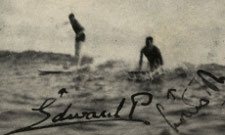
This rare photo shows King Edward VIII, then the Prince of Wales, riding a wave in Hawaii in 1920, probably the earliest ever picture of a British surfer — royal or otherwise. Photograph: British Museum of Surfing
The grainy black and white shots have never been seen before outside Hawaii and show the Prince of Wales gliding down the face of a wave, arms akimbo and using an unorthodox, but apparently effective, feet-together stance. The future king, who would later abdicate to marry Wallis Simpson, was on a private, three-day surfing trip to the Pacific Ocean island with Earl Mountbatten, also pictured in the water, although the future admiral of the fleet struggled to get to his feet.
"The earliest photo so far of a Briton standing on a wave is Edward, Prince of Wales," said Peter Robinson, the founder of the museum in Braunton, who acquired the images last year from Duke Kahanamoku's grand niece. "He had gone to Hawaii in April 1920 on HMS Renown and was taken out by Duke Kahanamoku on an outrigger canoe. He had a surf lesson and did OK, but absolutely loved it. He later ordered the royal yacht to go back to Hawaii so he could surf for three days. Duke was out of the country when he returned so David Kahanamoku took him out and these pictures were taken then."
According to an interview with David Kahanamoku published in a Hawaiian canoe club newsletter in 1950, the two young royals were keen. They surfed for two hours every morning and three hours every afternoon during their July stay. "The prince learned quickly to ride the board standing, although he did have some spills," Kahanamoku told the newsletter, adding: "Louis Mountbatten never mastered the art but was content to lie prone."
The pictures of the earliest origins of British surfing emerged as the sport in Britain reaches new heights of popularity. South West Tourism estimates that surfing is worth around £100m a year to Devon and Cornwall alone and surfing industry sources estimate that half a million holidaymakers every year try the sport for the first time while the same number again are regular surfers.
At the highest level professional British surfers are also starting to win international recognition, in particular for big wave riding. Croyde surfer Andrew Cotton, 35, was last month nominated against surfers from America and Australia for the international Billabong XXL ride of the year award for a 50ft-plus wave he caught off Mullaghmore Head, on the north-west coast of Ireland. This Easter weekend surf schools and water-sports shops around the UK are bracing themselves for another influx of novice surfers, pulling on unwieldy wetsuits and braving water temperatures of less than 10C as they get their first taste of Britain's distinctive surf culture.
The new Museum of British Surfing reveals the sport was originally an upper-class pastime in the UK that only took on its adrenalin-fuelled, macho image after the arrival on British beaches of US and Australian servicemen during the second world war, and the advent of beach lifeguards in the late 1950s. "It was a genteel, stately exercise activity, mainly of belly-boarding," said Robinson. "Wealthy holidaymakers from London or the home counties would come down for a spot of surf-riding in the morning, have cucumber sandwiches for lunch and play croquet in the afternoon."
Agatha Christie was an early exponent of the sport who learned to surf on a trip to Honolulu and wrote in her memoirs: "Nothing like that rushing through the water at what seemed to you a speed of about 200 miles an hour; all the way in from the far distant raft, until you arrived, gently slowing down, on the beach, and foundered among the soft flowing waves."

King Edward VIII, then the Prince of Wales, riding a wave in Hawaii in 1920. Photograph: Museum of British Surfing
The early equipment was rudimentary. In 1919, Tom Tremewan, an undertaker from Perranporth on the north Cornish coast, started marketing coffin lids as surfboards. Boards in the exhibition from the 1950s look more like pieces of ship work, held together with shiny brass screws instead of today's aquadynamic fibreglass. Wetsuits were home-made, and woollen sweaters were used to try and keep warm in the water.
The English aristocrats weren't the first Britons to become fascinated by the simple pleasure of being propelled to shore by the power of a wave. The exhibition features extracts from Captain Cook's 1779 journal as he described Hawaiian "natives" paddling out with their boards.
"It was a blast," recalled Kevin Cook, 61, a museum trustee who started surfing in Woolacombe in 1968. "It was young guys down at the beach. All the lifeguards started talking with Australian accents even if they were from round here. Now people are starting to appreciate that on its day north Devon has waves that stand up to anything in the world, although it is not there every day, the water is cold and it is a pain getting into a thick wetsuit."
Many British surfers agree that conditions can be tough. Occupational hazards include "ice-cream headache" from the frigid waters, waves battered out of shape by gales, and long drives to get to the most reliable spots.
Wave data shows that the growth in British surfing is more than a triumph of hope over reality. Surf forecasting company Magic Seaweed, calculates that swells averaging 10ft reach Newquay in Cornwall 58% of the time, more than at Sydney where the ratio is 44%, although a third of Newquay surfing days are marked by strong wind, compared to 10% in Sydney. Neither bear much comparison with southern California, spiritual home of the Beach Boys, where surfers are blessed with 6ft waves 80% of the time and hardly any strong winds. But the allure of British waves is growing for all generations.
On Saunton Sands in Devon this week, teachers Misa and Fearghal Magee had brought their six-month-old baby Perrin down to the beach while they took it in turns for a late afternoon surf in clean swell. "We moved from Ireland to be close to these waves," said Fearghal. "It was the main reason. We know lots of couples who have moved down here to surf."
So, does British surfing deserve a better reputation? "I don't think we want the rest of the world finding out just how good it is."
Onshore Shetland windfarm, said to be "the world's most productive", is given the go-ahead despite many objections
A major windfarm on Shetland, which could be the most productive in the world, has been approved by ministers despite a bitterly fought campaign against the scheme by local residents. The Viking windfarm will straddle the hills and moors of Shetland's main island, where the onshore wind speeds are frequently the highest in Europe, and lead to earnings of £30m a year for islanders and Shetland's wealthy charitable trust.
The project has been cut in size by Fergus Ewing, the Scottish energy minister, from 127 turbines to 103, to protect safety for Scatsta airport near Sullom Voe oil terminal.
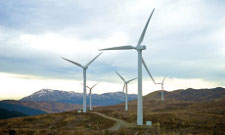
Cruach Mhor windfarm in Argyll, Scotland. The Shetland windfarm will be comprised of 103 turbines. Photograph: Kevin Walsh/Photolibrary RM
The joint venture between energy giant SSE and Viking Energy Ltd, owned by the trust, will have 370MW capacity and is expected to generate enough energy for 175,000 homes — sixteen times the number of homes on Shetland.
One small turbine on a hill north of Lerwick, called Betsy, already holds a world record for its efficiency, reaching 59% of its potential output, thanks to the consistently powerful winds which sweep Shetland. The developers said that meant the Viking scheme had the potential to be the most productive in the world. Councillor Bill Manson, chairman of Viking Energy Partnership, said: "This is good news for Shetland, good news for Scotland and good news for the fight against climate change."
The Viking scheme has been vigorously opposed by many Shetland residents, who have complained about its dominant position through the centre of the main island, and its impact on the scenery and recreation value of the moors and hills. The project received 2,772 objections, more than 10% of Shetland's 22,000 total population, but was supported by 1,115 people. Protesters at Sustainable Shetland said any scheme should be much smaller and designed to supply local energy needs.
Conservationists at the Royal Society for the Protection of Birds, which had originally supported the project, were also highly critical. The scheme will damage peat and blanket bog, and nesting grounds for rare birds. Reacting to its approval on Wednesday, the RSPB said the scheme still damaged crucial breeding sites for rare birds such as red-throated divers and whimbrel, since 90% of the UK's whimbrel population nest on Shetland. Aedán Smith, RSPB Scotland's head of planning, said it was "absolutely critical" that the developers made substantial efforts to protect the affected environment. "The developers and Scottish ministers should have gone much further to try and ensure that any negative consequences would be minimised, and it is disappointing that they have decided to risk the Shetland environment, as well as birds like whimbrel, with such a large scale proposal in their heartland."
It was originally due to have up to 200 turbines, creating what was then Scotland's largest onshore windfarm and helping Shetland become a major net exporter of renewable energy, and in turn kick-starting a much larger marine energy industry. The scheme, which is expected to cost about £566m and create 140 jobs during construction, is due to become operational in 2017. An expensive new subsea interconnector cable between Shetland and north-east Scotland, to help feed Viking's electricity to the national grid, has already been approved but has not yet been laid. Viking Energy is still waiting for the energy regulator Ofgem to cut its extremely high transmission charges, which are based on the distance between the power source and south-east England, to improve the project's profitability.
Currently, the island's electricity is generated by a highly inefficient diesel-fuelled combined heat and power plant on the outskirts of Lerwick, which uses fuel shipped in by tankers. Quality of life on Shetland has been significantly improved by an annual levy on every barrel of oil landed at Sullom Voe, paid into the Shetland charitable trust.
Ewing said the project would bring "enormous benefits" to the islanders, by creating further green energy jobs in future and helping develop community energy schemes. He said a 12,500-acre rehabilitation project paid for by the Viking scheme would help protect vulnerable peatlands. "Last week, figures showed Scotland exceeded our ambitious renewable electricity targets for 2011, with more than a third of our electricity demand coming from renewables," Ewing said. "Developments like Viking will help us meet our 2020 target, and will make a huge contribution to our target of 500MW from community and locally owned renewable energy by 2020, while benefiting communities, cutting emissions, and helping to keep energy bills lower."
Pacific tuna fishing ban is modified
Pacific nations have reopened the Pacific high seas to commercial tuna fishing after a two-year ban imposed to preserve declining bigeye tuna stocks.
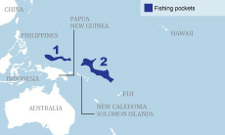
The permitted areas for tuna fishing in the Pacific Ocean
In a meeting in Guam, member countries of the Western and Central Pacific Fisheries Commission (WCPFC) lifted the fishing ban on pockets 1 and 2 of the Pacific Ocean. The WCPFC is a 25-member organisation including Australia, the EU, Japan, Papua New Guinea, and the Philippines that oversees and regulates migratory fish stocks such as tuna and marlin in the Pacific. Its jurisdiction covers 20% of the planet's surface.
In January 2010, the WCPFC placed the ban on parts of the Pacific Ocean, where 60% of the world's tuna are sourced, to conserve the population of the bigeye tuna, which scientists classified as overfished. Other tuna species like skipjack, yellowfin, and albacore also found in the Pacific high seas but their numbers have not reached an alarming low.
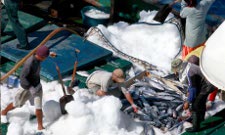
The Western and Central Pacific Fisheries Commission turned down an appeal for full access to the Pacific for tuna fishing. Photograph: Alex Hofford/AFP/Getty Images
Although it lifted the ban, the commission maintained that entry to the marine reserves would be limited, refusing proposals from the European Community and South Korea for a free-for-all access to one of the world's richest fishing grounds. "The Pacific Commons is now open. But for all practical purposes, access will be limited," said Mark Dia of Greenpeace. "They knew that everybody would suffer if a free-for-all access is granted," he added.
The WCPFC approved the request of the Philippine government, the third top tuna harvester in the Pacific after Japan and South Korea, to fish in pocket 1 of the Pacific, which is bounded by the island nations of Micronesia, Palau, Papua New Guinea, and Indonesia.
In exchange for fishing access, the Philippine government must report its catch and limit the number of fishing vessels to 36, Dia said. Filipino vessels must also apply for international fishing permits before entering pocket 1.
The Philippines' fisheries director Asis Perez said the ban brought hard times to the local fishing sector. He also noted that the fishing ban was counter-productive for the Philippines as it forced fishing companies to harvest in its national waters, which is considered to be a spawning ground for various types of tuna, he said.
Overfishing off West Africa jeopardises political stability of W. African states
Jon Vidal (travel costs paid by Greenpeace) reports in The Guardian, 2nd April 2012: "Abdoulaye Gueye cannot see any Chinese, Russian or European trawlers as he lands his meagre catch of sardinellas and mackerel into waiting horse-drawn carts on the beach at Joal. But he knows there are 30 or more of them just over the horizon, hoovering up the fish he cannot reach.
A decade ago he could catch enough in a three-day trip to fill his 30ft-long wooden pirogue; today, he and his colleagues say they are lucky to earn enough to pay the diesel for their vessels. They are angry at what is happening to their fishing grounds and are demanding change from the new government.
Now, in a move aimed to put pressure on the developed countries to curb their fleets, community leaders in Joal and across Senegal have warned that overfishing by foreign fleets could lead to piracy and violence on the scale of Somalia, as well as a flood of economic migrants leaving west Africa to find work in Europe.
"Catches are 75% down on 10 years ago," said Samb Ibrahim, manager of Joal's fishing port. "In 2004 we landed 220,000 tonnes, now we catch only 120,000 tonnes year. It's a very serious situation." The port is the biggest in the country, with 1,500 fishermen competing to land declining catches. At this rate, in 10 years time there will be no fish left. So, unless something changes there will be a catastrophe for livelihoods, employment and food security," added Ibrahim.
"Senegal's only resource is the sea," said Abdou Karim Sall, president of the Fishermen's Association of Joal and the Committee of Marine Reserves in West Africa. "One in five people work in the industry, but if you put those people out of work then you can imagine what will happen. Europe is not far away and Senegal could become like Somalia. People are getting desperate. For sure, in 10 years' time, we will carry guns. The society here destabilises as the fishing resource is overexploited. As the situation becomes more difficult, so it will become more and more like Somalia."
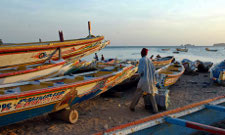
A fisherman returns home from Dakar's Soumbedioune fish market. About 1 million people in Senegal depend on the fishing industry for food. Photograph: Reuters
Senegal has 52,000 fishermen, but tens of thousands of others work in the industry — building and repairing boats and nets, transporting, selling and processing fish, and generally servicing the industry. Approximately 1 million people depend on fish as a primary source of food.
Blame for the continuing fall in catches is levelled equally at the giant, foreign-owned trawlers that take up to 300,000 tonnes of fish a year from Senegal's waters, and corrupt local politicians who sell illegal licences for "pirate" fishing vessels that take an unknown quantity. Fishermen in Joal say they cannot compete with the trawlers, which are meant to stay off the 12-mile limit but — because there is no cash for monitoring or policing — come in much closer at night.
The foreign fleets respond by saying they aim to catch different fish and do not undermine local artisan fishing. Locals counter that the trawlers catch fish on such a large scale that none of the traditionally valuable species are left for them. One large trawler, it is calculated, can catch as much as 250 tonnes of fish a day, roughly what 50 pirogues might catch in a year.
"We used to catch the bigger fish like the barracuda, the capitaine and the dorade. But now there are none left, so we have to catch the low quality sardines and sardinella," said Ibrahim.
In April 2011, small-scale Senegalese fisheries demanded the government revoke licences to foreign trawlers allowing them access to local waters. More than 20 licences for Russian, Belizean, Mauritian, and Ukrainian vessels were cancelled. But the fishermen say they want more action. "We are now prepared to take direct action against the foreign boats," said Sall. "It is they, not we, who would be acting as pirates. We want people in Europe to be aware that, when this happens, they should not call us pirates. The pirates are the vessels taking our fish."
As populations in West Africa grow rapidly, the number of people drawn to the coasts to seek work in the fishing industry has also greatly increased, adding to pressure on coastal waters and fish stocks. "The town of Joal has grown from 6,000 to 40,000 people in 45 years," said Ibrahim. "People are coming in from Burkina Faso, Mali, all over west Africa. They pay fishermen to fish for them. There used to be 750 pirogues working here, but now there are 1,500."
Tens of millions of people in West Africa are dependent on fish for their diets, so any reduction in catches could impact directly on people's health, says Raoul Monsembul, an oceans campaigner for Greenpeace Africa. "Millions of Africans depend for their diets on fish caught by local fishermen, but as a consequence of overfishing by the European and other fleets, stocks are rapidly decreasing. Local fishermen are now forced to fish further out at sea," he said.
According to the UN, overfishing threatens to cause further instability by driving communities that live off the sea toward crime. Officials point to the precedent set in Somalia, where illegal fishing in the 1990s encouraged fishermen to turn to piracy. "Illegal fishing in west Africa is essentially out of control," said David Doulman, senior fisheries planning officer at the Food and Agriculture Organisation (FAO).
Doulman believes any deterioration in the livelihoods of coastal communities from Mauritania down to South Africa could have a devastating impact on social conditions in countries already struggling to overcome poverty and unemployment. While there is no clear evidence that local fishermen are behind the hijacks of ships in west Africa, says Doulman, fears are growing that their declining livelihoods could push them into piracy.
US diplomats, based in Sierra Leone and quoted in Wikileaks documents published in 2009, say piracy by fishermen is on the increase, with foreign trawlers attacked and robbed of their catch. "Most of the pirates are reported to be from Guinea," say the documents. "The government of Sierra Leone estimates that the country loses at least $30m in revenue per year to illegal and unreported fishing."
In the first two months of this year, the International Maritime Organisation has recorded 10 piracy incidents off the coasts of Benin, Congo, Ivory Coast, Ghana and Nigeria.
Shell near to securing permission to explore for oil in the Arctic after its "oil spill" plan is approved
United States Federal authorities have approved an oil spill response plan that could allow drilling to commence this summer in the Beaufort Sea, the first major offshore drilling in the Arctic since the early 1990s. Though Shell Alaska still needs several final permits, the oil spill plan has been the most debated aspect of the upcoming drilling program, with fears that cleaning up an offshore blow-out in the turbulent, often icy seas of the Arctic could be a formidable challenge.
"We have conducted an exhaustive review of Shell's response plan for the Beaufort Sea," James A. Watson, director of the federal Bureau of Safety and Environmental Enforcement, said in a statement. "Our focus moving forward will be to hold Shell accountable and to follow up with exercises, reviews and inspections to ensure that all personnel and equipment are positioned and ready."
Shell, which has spent nearly $4 billion and five years preparing to drill exploratory wells in the Beaufort and nearby Chukchi seas, said it hopes to begin drilling as early as July 10 and continue until just before the onset of ice in the fall. The programme calls for halting operations during the late summer hunt for bowhead whales undertaken by local native Alaskans.
The oil spill response plan is beefed up from an earlier plan, planning for a worst-case scenario three times bigger than what was studied before the Deepwater Horizon spill in the Gulf of Mexico sent planners back to the drawing boards.
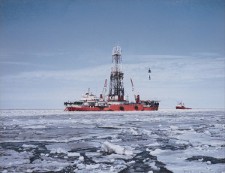
Shell Alaska's earlier drilling programme in the Chukchi Sea.
The current plan requires Shell and its fleet of offshore oil response vessels to be ready to contain and clean up a discharge of up to 480,000 barrels of oil, representing a blow-out of 16,000 barrels a day over a 30-day period. Such a spill would probably send oil pluming many miles offshore in a swathe extending from just east of Prudhoe Bay to about 45 miles further east, at Brownlow Point on the edge of the Arctic National Wildlife Refuge, according to the document.
The plan suggests the likelihood of that happening is quite small: Shell is designing and prepositioning a containment device, similar to that which eventually halted the Deepwater Horizon blow-out, that would theoretically be quickly clamped onto the well in the event that, as happened in the gulf, the built-in blow-out preventer failed.
Federal officials say the chances of a blow-out are much less likely at the substantially shallower depths and lower pressures of the Arctic. But the plan does explore in some detail the scenario drilling opponents fear most: a spill at the end of the operations season in October, at the onset of the Arctic winter and the ice, darkness and powerful storms it brings.
The plan concedes that traditional mechanical means such as booms will become ineffective once freeze-up occurs and provides for "alternative response countermeasures" including in situ burning with helicopter-deployed torches and application of dispersants "when feasible and permitted."
It suggests that icebreakers may still be able to open up leads to allow skimmers to access oil trapped next to or within heavier ice concentrations, and once oil is trapped under the ice, it can be tracked through the winter with the use of ground-penetrating radar, laser fluorosensors and other high-tech devices, the plan says. While some work may be done atop coastal shorefast ice to remove oil trapped underneath, there is little likelihood of attacking oil under ice further out to sea, the plan concedes, acknowledging it will be "impractical and unsafe" to work from moving ice floes.
"They have all this high-tech equipment, and imagine trying to get it to work in the kind of conditions they have in an Arctic winter," Chris Krenz, Arctic programme manager for the conservation group Oceana, said in an interview. "Even to think we can track oil during the summertime, when there might be fog and other things, is a pretty big leap of faith, but to think we'd be able to track the oil under the ice in real-world conditions during the winter is just ludicrous — especially if it's a major blow-out."
Drilling opponents are pointing to a still-uncontrolled gas leak near a Total platform in the North Sea off the coast of Scotland as an example of what can go wrong during offshore operations. Officials at the French energy company have said it could take six months to halt the release of gas.
"The gas spill in the North Sea and other recent disasters, including a recent natural gas blow-out in Alaska, remind us that the risks are too great, particularly in places like the Arctic where the challenges are foreboding," Alaska Wilderness League director Cindy Shogan said in a statement. "We can only hope that President Obama shows the leadership he promised and refuses to bow to the demands of Big Oil by not granting Shell the final permits it needs to begin drilling in July," she said.
The Obama administration, pursuing what the president has described as an "all-of-the-above" energy strategy, announced Wednesday it is also moving forward with studies of offshore oil development in the mid and southern Atlantic Ocean. U.S. Interior Secretary Ken Salazar said the department will be accepting comments on a draft environmental impact statement looking at whether, and where, offshore leasing might be appropriate.
Alaskan officials have welcomed approval of offshore drilling as a means of keeping oil flowing through the trans-Alaska pipeline as the ageing onshore fields on the North Slope continue to decline.
Shell officials also were celebratory. "Today's approval of our Beaufort Sea oil spill response plan, on the heels of the recent approval of our Chukchi Sea oil spill response plan, is another major milestone achieved. It further reinforces that Shell's approach to Arctic exploration is aligned with the high standards the Department of Interior expects from an offshore leader and adds to our confidence that drilling will finally commence in the shallow waters off Alaska this summer," spokeswoman Kelly op de Weegh said in a statement.
She said several additional approvals still are needed before drilling can commence, including letters of authorisation from U.S. Fish and Wildlife Service, and authorisation for incidental harassment of wildlife from the National Marine Fisheries Service. There still has been no ruling from the Environmental Protection Agency's appeals board on an air permit issued for Shell's Kulluk drilling unit. And the company still needs individual federal permits for each of the wells it proposes to drill this year.
Oceans started warming 135 years ago, and are now absorbing 90% of overall planetary warming
The world's oceans have been warming for more than 100 years, twice as long as previously believed, new research suggests. The findings could help scientists better understand the Earth's record of sea-level rise, which is partly due to the expansion of water that happens as it heats up, researchers added.
"Temperature is one of the most fundamental descriptors of the physical state of the ocean," said the study's lead author, Dean Roemmich, an oceanographer at the University of California, San Diego. "Beyond simply knowing that the oceans are warming, [the results] will help us answer a few climate questions."
From 1872 to 1876, the HMS Challenger sailed the world's oceans along a 69,000-nautical-mile track, crossing the Atlantic, Indian and Pacific oceans. During the voyage, scientists among the 200-person crew took 300 ocean-temperature profiles, or measurements at several depths in each spot, with pressure-protected thermometers.
Roemmich and his colleagues compared Challenger temperatures with data from the modern-day Argo project, which uses 3,500 free-drifting floats to measure the temperature and salinity, or salt content, of the world's oceans every 10 days. The comparison showed a 1.1-degree Fahrenheit (0.59-degree Celsius) temperature increase at the ocean's surface over the last 135 years, a result corroborated by a large body of sea-surface temperature data that goes back more than 100 years. "That is a substantial amount of warming," Roemmich told LiveScience. Ocean warming has been previously linked to glacial melting and mass coral bleaching.
The team also looked at subsurface temperature differences between Challenger and Argo, taking into account several sources of error in the Challenger readings. One issue with the Challenger data, Roemmich explained, is that the vessel's scientists didn't directly measure the depth of their thermometers; they measured only the length of the line extending the instruments into the water. Because of ocean currents, it's nearly impossible to get a line to be completely vertical in the water, resulting in an actual depth that is a little less than the full length of the line.
"What you are then going to see is a temperature that is a little warmer than it would have been if the line has been perfectly vertical," Roemmich said, referring to the fact that temperatures are typically warmer at shallower depths. Other Challenger errors include incorrect measurements of pressure effects on the thermometers and faulty thermometer readings, he added.
Accounting for these issues, Roemmich and his team found that, on average, global ocean temperatures increased by 0.59 degrees F (0.33 degrees C) in the upper ocean down to about 2,300 feet (700 metres). This global temperature change is twice what scientists have observed for the past 50 years, suggesting that the oceans have been warming for much longer than just a few decades.
Given that thermal expansion is believed to be a major contributor to sea-level rise, Roemmich believes that the results of the study will help scientists better understand the historical record of the rising sea levels, which have been increasing since the 19th century.
Roemmich also thinks the results have important implications for understanding the imbalance of the planet's energy budget. Previous research has shown that the Earth is absorbing more heat than it is radiating, and that 90 percent of the excess heat added to the climate system since the 1960s has been stored in the oceans. "So that means that the ocean temperature is probably the most direct measure we have of the energy imbalance of the whole climate system," he said.
USA's NASA creates video visualisation of World's ocean currents
The US National Aeronautical and Space Administration (NASA) has created a short video visualisation of the movement of the planet's ocean currents, showing the patterns and motions that exist in the oceans of the globe.
See www.huffingtonpost.com/2012/03/26/ocean-currents-time-lapse-nasa-video_n_1380778.html
Surfers Against Sewage launch "Think Before You Flush" campaign
From Surfers Against Sewage (SAS) website (www.sas.org.uk/campaigns/marine-litter/think-before-you-flush :
The Problem
Every day people are flushing objects such as cotton buds, sanitary products, condoms and razors down the toilet instead of putting them in the bin. Known in the business as sewage related debris or SRD, this can have a huge impact on the water environment. The only things that should be flushed are stuff that has passed through you and the toilet paper you use to wipe your arse!
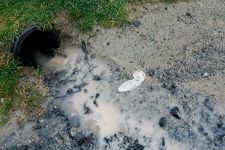
Flushing other items can cause many problems, both in the sewage works and later in the marine environment.
Larger items such as sanitary towels and tampons block screens and clog pumps and pipes in sewage treatment works. This results in reduction of flow, causing water to back up and overflow either untreated through a CSO or into streets and gardens if all other routes get blocked. Water companies can spend a large amount time and money unblocking their systems that could otherwise be spent elsewhere.
SRD that escapes from the sewage system causes aesthetic problems, littering our near shore waters and beaches. Such incidents could have detrimental effects on tourism. Some items such as sanitary towels will slowly decompose but other items (being made of plastic) will remain in the marine environment indefinitely. These can then become hazardous to wildlife and ruin a surf session!
The Solution
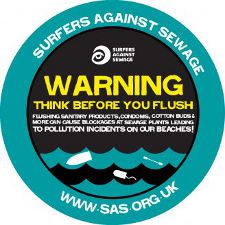
Think Before You Flush!!!! Any item that has not passed through you should not be flushed down the toilet, other than toilet paper. It's as simple as that really. While some other products may claim to be flushable, they still can cause blockages so don't risk it!
Check out some of the more environmentally friendly sanitary products instead — biodegradable cotton buds or washable sanitary towels!
The Surfers Against Sewage 'Think Before You Flush' campaign is really getting under way — here is their latest press release.
"Catastrophic cliff and promenade failure" at Clacton
Reporter Chris Harris wrote in the East Anglian Daily Times of 12th March telling how Tendring District Council (Essex) are stepping up the fight to protect their coastline at Clacton and Holland-on-Sea, where urgent repairs are needed to prevent (quote) "catastrophic cliff and promenade failure". The beach along that part of the coastline has sunk 20 feet in the past ten years, and to quote council leader Neil Stock, has "made it an unattractive place to go".
Councillor Neil Stock said a new funding arrangement would come into force in April placing more responsibility on councils to find money for flood defences. In the past the Department for Environment, Food and Rural Affairs (DEFRA) fully funded coastal protection works, such as the £2.3 spent at Cliff Road, Holland-on-Sea, but is now looking more to councils and other organisations to provide, in this case £25m for the most crucial works. Cllr. Stock said a report was going before the authority's cabinet that recommends appointing an engineering consultant to find solutions and costings to address the problem. "We have got the longest coastline of any district in the country," he said. "We want to protect it and make sure it's Clacton-on-Sea rather than Clacton-in-the-Sea. It's important for tourism, particularly in Holland-on-Sea" He added "We want to consider every option that's available, it does not matter how crazy it sounds. If we cannot get Government funding we will have to do it ourselves."
Both MARINET and Sustainable Coastlines have written to the Council leader and to the Council's environmental member Nick Turner with advice and the not-so-crazy suggestions that they can read on 'Why Canute Failed' — MARINET's treatise on coastal defences'. No response has resulted so far.
EU and "fish pirates" are destroying West African fisheries
John Vidal, The Guardian, reports 2nd April 2012: "Sea-fishing areas of west Africa have fallen prey to the world's largest and most modern fishing fleets. Mauritania's waters are crowded. Twenty-five miles out to sea and in great danger from turbulent seas are small, open pirogues crewed by handfuls of local fishermen, taking pitifully few fish. Also here within 50 miles of us are at least 20 of the biggest EU fishing vessels, along with Chinese, Russian and Icelandic trawlers and unidentifiable pirate ships.
"We are closest to the Margaris, a giant 9,499-tonne Lithuanian factory trawler able to catch, process and freeze 250 tonnes of fish a day, and a small Mauritanian vessel, the Bab El Ishajr 3. Here too, in the early mists, its radio identification signal switched off, is Spanish beam trawler the Rojamar. The Arctic Sunrise, Greenpeace's 40-year-old former ice-breaker, is shadowing one of Britain's biggest factory trawlers — the 4,957-tonne Cornelis Vrolijk. Operated by the North Atlantic Fishing Company (NAFC), based in Caterham, Surrey, it is one of 34 giant freezer vessels that regularly work the west African coast as part of the Pelagic Freezer Association (PFA), which represents nine European trawler owners.
The ship, which employs Mauritanian fish processing workers aboard, is five miles away, heading due south at 13 knots out of dirty weather around Cape Blanc on the western Saharan border. By following the continental ledge in search of sardines, sardinella, and mackerel, it hopes to catch 3,000 tonnes of fish in a four to six-week voyage before it offloads them, possibly in Las Palmas in the Canary Islands. But, says NAFC managing director Stewart Harper, while most of its fish will end up in Africa, none will go to Mauritania, despite the country facing a famine in parts. "Unfortunately Mauritania does not yet have the infrastructure to handle cargoes of frozen fish or vessels of our size," he says.
The west African coast has some of the world's most abundant fishing grounds, but they are barely monitored or policed, and wide open to legal and illegal plunder. According to the UN's Food and Agriculture Organisation, all west African fishing grounds are fully or over-exploited to the detriment of over 1.5 million local fishermen who cannot compete with them or feed their growing populations.
Heavily subsidised EU-registered fleets catch 235,000 tonnes of small pelagic species from Mauritania and Moroccan waters alone a year, and tens of thousands of tonnes of other species in waters off Sierra Leone, Ghana, Guinea Bissau and elsewhere.
A further unknown amount is caught by other countries' vessels, but the individual agreements made between west African countries and foreign companies are mostly secret. Despite possible ecological collapse, and growing evidence of declining catches in coastal waters, west African countries are now some of the EU's most-targeted fishing grounds, with 25% of all fish caught by its fleets coming from the waters of developing countries.
Willie MacKenzie, a Greenpeace ocean campaigner, said: "Europe has over-exploited its own waters, and now is exporting the problem to Africa. It is using EU taxpayers' money to subsidise powerful vessels to expand into the fishing grounds of some of the world's poorest countries and undermine the communities who rely on them for work and food. The EU has committed some € 477m for agreements with Mauritania over the past 10 years, essentially paying for vessels like the Cornelis Vrolijk to be able to access these waters," he adds.
According to the PFA, about 50 international freezer-trawlers are active in Mauritanian waters at any one time, of which 30 originate from countries such as Russia, China, Korea or Belize. "By targeting fish species that cannot be fished by local fishermen, we avoid disrupting local competition and growth and always fish outside the 12-13 mile fishing limit for our type of vessel," says a spokesman. "Not all international operators active in Mauritanian waters meet the EU's safety and environmental standards. This threatens our efforts to foster sustainable practices in the region."
Greenpeace says the over-exploitation of African fisheries by rich countries is ecologically unsustainable and also prevents Africans from developing their own fisheries. It takes 56 traditional Mauritanian boats one year to catch the volume of fish that a PFA vessel can capture and process in a single day. Since the 1990s, the once-abundant west African waters have seen a rapid decline of fish stocks. Local fishermen say their catches are shrinking and they are forced to travel further and compete with the industrial trawlers in dangerous waters unsuitable for their boats.
"Our catch is down 75% on 10 years ago. When the foreign boats first arrived there was less competition for resources with local fishermen and fewer people relied on fishing for food and income. Governments have become dependent on the income received by selling fishing rights to foreign corporations and countries," says Samb Ibrahim, manager of Senegal's largest fishing port, Joal. "Senegal's only resource is the sea. One in five people work in the industry but if you put those people out of work then you can imagine what will happen. Europe is not far away and Senegal could become like Somalia," said Abdou Karim Sall, president of the Fishermen's Association of Joal and the Committee of Marine Reserves in West Africa. People are getting desperate. For sure, in 10 years' time, we will carry guns. The society here destabilises as the fishing resource is over-exploited. As the situation become more difficult, so it will become more and more like Somalia," he said.
There is now growing concern that illegal or "pirate" fishing is out of control in some waters. According to the UN, across the whole of sub-Saharan Africa, losses to illegal fishing amount to about $1bn a year — 25% of Africa's total annual fisheries exports. Guinea is thought to lose $105m of fish to pirate fishing a year, Sierra Leone $29m, and Liberia $12m. An investigation by Greenpeace and the Environmental Justice Foundation in 2006 found that over half of the 104 vessels observed off the coast of Guinea were either engaging in or linked to illegal fishing activities.
Surveillance and monitoring of overfishing is now urgently needed or fish stocks will collapse, leading to humanitarian disasters in many countries, says the UN. Increasingly, ships are transferring their catches to other vessels while at sea, rather than directly off-loading in ports. This conceals any connection between the fish and the vessel by the time the fish arrives on the market, meaning the true origin of the catch is unknown. However, the PFA says banning EU vessels from African waters would not be sensible.
In a statement it said: "Less regulated, less transparent and less sustainable fishing operators would replace the European vessels. This would be a bad deal for Europe and the African countries we partner with. "They would see less strategic infrastructure investment, reduced transfer of skills and knowhow, as well as scientific research and more depleted fish stocks. And in Europe we would damage a viable part of EU's fishing economy to the benefit of countries such as China. All of the fish caught by the PFA is destined for west-central African communities rather than consumers in developed countries. In fact, the fish caught and distributed by the PFA is often the only source of essential protein for the people in countries such as Nigeria."
BP Gulf of Mexico consequences on marine life and ecosystem now feared to be worse than first thought
A new study of dolphins living close to the site of North America's worst ever oil spill — the BP Deepwater Horizon catastrophe two years ago — has established serious health problems afflicting the marine mammals. The report, commissioned by the National Oceanic and Atmospheric Administration [NOAA], found that many of the 32 dolphins studied were underweight, anaemic and suffering from lung and liver disease, while nearly half had low levels of a hormone that helps the mammals deal with stress as well as regulating their metabolism and immune systems.
More than 200m gallons of crude oil flowed from the well after a series of explosions on 20th April 2010, which killed 11 workers. The spill contaminated the Gulf of Mexico and its coastline in what President Barack Obama called America's worst environmental disaster.
The research follows the publication of several scientific studies into insect populations on the nearby Gulf coastline and into the health of deep water coral populations, which all suggest that the environmental impact of the five-month long spill may have been far worse than previously appreciated.
Another study confirmed that zooplankton — the microscopic organisms at the bottom of the ocean food chain — had also been contaminated with oil. Indeed, photographs issued last month of wetland coastal areas show continued contamination, with some areas still devoid of vegetation.
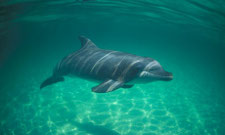
A study of bottlenose dolphins in Barataria Bay, Louisiana, showed that many of the marine mammals were suffering from lung and liver disease. Photograph: Alamy
The study of the dolphins in Barataria Bay, off the coast of Louisiana, followed two years in which the number of dead dolphins found stranded on the coast close to the spill had dramatically increased. Although all but one of the 32 dolphins were still alive when the study ended, lead researcher Lori Schwacke said survival prospects for many were grim, adding that the hormone deficiency — while not definitively linked to the oil spill — was "consistent with oil exposure to other mammals". Schwacke told a Colorado based-publication last week: "This was truly an unprecedented event — there was little existing data that would indicate what effects might be seen specifically in dolphins — or other cetaceans — exposed to oil for a prolonged period of time."
The NOAA study has been reported at the same time as two other studies suggesting that the long-term environmental effects of the Deepwater Horizon spill may have been far more profound than previously thought.
A study of deep ocean corals seven miles from the spill source jointly funded by the NOAA and BP has found dead and dying corals coated "in brown gunk". Deepwater corals are not usually affected in oil spills, but the depth and temperatures involved in the spill appear to have been responsible for creating plumes of oil particles deep under the ocean surface, which are blamed for the unprecedented damage.
Charles Fisher, one of the scientists who jointly described the impact as unprecedented, said he believed the colony had been contaminated by a plume from the ruptured well which would have affected other organisms. "The corals are long-living and don't move. That is why we were able to identify the damage but you would have expected it to have had an impact on other larger animals that were exposed to it." Chemical analysis of oil found on the dying coral showed that it came from the Deepwater Horizon spill.
The latest surveys of the damage to the marine environment come amid continued legal wrangling between the US and BP over the bill for the clean-up. BP said the US government was withholding evidence that would show the oil spill from the well in the Gulf of Mexico was smaller than claimed. Last week BP, which has set aside $37bn (£23bn) to pay for costs associated with the disaster, went to court in Louisiana to demand access to thousands of documents that it says the Obama administration is suppressing.
The US government is still pursuing a case against BP despite a deal the company reached at the beginning of March with the largest group of private claimants. That $7.8bn deal, however, does not address "significant damages" to the environment after the spill for which BP has not admitted liability. And it has not only been the immediate marine environment that has been affected. A study of insect populations in the coastal marshes affected by the catastrophe has also identified significant impact.
Linda Hooper-Bui of Louisiana State University found that some kinds of insect and spider were far less numerous than before. "Every single time we go out there, the Pollyanna part of me thinks, 'Now we're going to measure recovery'," she said. "Then I get out there and say: 'Whaaat?'" She had expected that one group of arthropods might be hit hard while others recovered, but her work, still incomplete, shows a large downturn among many kinds. "We never thought it would be this big, this widespread," she said.
For its part BP has claimed in a recent statement that it has worked hard to fulfil its responsibility to clean up after the spill. "From the beginning, BP stepped up to meet our obligations to the communities in the Gulf Coast region, and we've worked hard to deliver on that commitment for nearly two years," BP chief executive Bob Dudley declared recently.
Trawlers netting archaeological treasures as well as fish
Trawlerman Dennis Hunt was crossing Colwyn Bay in his boat in 1995 when its nets snagged on the seabed. Unable to free them, Hunt contacted diver Keith Hurley, who swam 60ft down to the sea floor — and found that the nets were caught on a rusting submarine's conning tower. Hunt and Hurley had found the Resurgam, one of Britain's first submarines, which sank in 1880. It was a key historical discovery but certainly not a first for fishermen.
Every day hundreds of items, ranging from Spitfire engines to ancient stone tools, are dragged up by fishing vessels while wreck sites are revealed after nets become snagged on sunken craft.
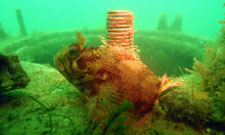
A fish swims in front of a wreck. Photograph: Observer
As fishing intensifies, more discoveries are being made this way, a process that threatens to run out of control. As a result, English Heritage will launch a pilot scheme this month that aims to keep in order the avalanche of historical finds now produced by our fishermen. "There are about 46,000 recorded shipwrecks, crashed aircraft and sites of archaeological finds in English waters that we know of," said archaeologist Simon Davidson. "However, these recorded sites only make up about 10% of the total down there, we estimate."
In addition, it is reckoned that, in the second world war alone, 13,000 aircraft were lost in UK waters, including the plane that carried the American swing band leader Glenn Miller on a flight that disappeared, presumed lost in action, on 15 December 1944. "This collection of lost ships and aircraft represents an enormous historical resource," said Davidson. "Certainly, given its size, it is not surprising so many items get dredged up by fishermen."
The pilot scheme will be in Sussex. About 400 fishing boats sail from its nine ports and every day about half of these craft dredge up a historical item. Leaflets about the scheme, which will be administered with the help of Sussex Inshore Fisheries and Conservation Authority, will provide fishermen with the details of those to contact after a find is made and provide information about salvage rights. The scheme, if successful, will be spread throughout the country.
The project's importance was stressed by marine archaeologist Alison James. "Britain has 61 protected historic shipwrecks and a significant number were found by fishermen. Some were the result of net snags, but others — like the wreck of the 16th- or 17th-century Dunwich Bank off the Suffolk coast — occurred when a length of timber was dredged up in a net. It is important that we continue to work closely with fishermen."
Other finds have included the Admiral Gardner, which sank off Dover harbour in 1809 and which was found by routine investigations into a net snag, and the wreck of the Irish paddle steamer Irishman, which sank en route to Portree in 1862 and was found by scallop divers. At the same time, hoards of stone implements have been dredged up from Dogger Bank and other shallow parts of the North Sea, demonstrating that our stone age ancestors hunted mammoths and other creatures on land that was later inundated by the melting ice caps.
Fishermen make a significant contribution to our understanding of Britain's past. An example is provided by oyster fisherman Michael White, who has assembled nearly 300 artefacts including prehistoric flint tools while dredging in the Solent. The collection, which ranges from stone age axe heads to metal tools from the bronze age, has been described by Channel 4's Time Team archaeologist Phil Harding as extraordinary.
"All of these have helped us reconstruct how the landscape was used before the English Channel flooded it 10,000 years ago," says Harding. "If it hadn't been for Michael collecting all this material and telling us about it, we may never have encountered it — and our knowledge of the prehistoric Solent would be all the poorer."
Withdrawal of German companies creates uncertainty over future of UK nuclear power generation
The government's nuclear energy policy is in disarray after German utilities RWE and E.ON scrapped plans to build two reactors in the UK, prompting warnings of serious knock-on effects for jobs and economic growth.
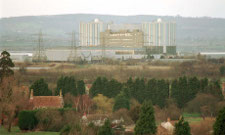
Oldbury nuclear power station in Gloucestershire. Photograph: Simon Chapman/ISF
Nuclear power is a cornerstone of the government's low-carbon agenda and the Horizon joint venture, co-owned by RWE and E.ON, was a key contributor due to its plans to construct new stations at Wylfa in Wales (Anglesey), and Oldbury in Gloucestershire (Severn estuary).
Progress on those projects was shelved when Horizon's owners put the business on the market, citing doubts over financing the projects and costs associated with the German government's decision to abandon nuclear power in the wake of the Fukushima disaster. "A combination of these strategic factors, together with the significant ongoing costs of running the Horizon joint venture, has led to a situation where capital investment plans have been reviewed," the companies said in a joint statement.
The government has identified nuclear power as one of three energy sources — including renewables and carbon capture storage — that will help the UK cut carbon dioxide emissions by 80% by 2050. Wylfa and Oldbury were two of the eight sites identified by the government as possible locations nuclear power stations. The decision sent shock waves through the sector. A senior nuclear industry figure told the Guardian: "It's a total train wreck — you can't imagine the importance of this to the economy of north Wales. This programme is bigger than the whole Olympics. The government now has to try to find another buyer."
Horizon's owners had made the the economic benefits of their plans a key part of their pitch, pledging to invest at least £15bn in nuclear power, creating a total of 800 permanent jobs at each site and employing 10,000 people during construction of Wylfa and Oldbury with construction due to begin on the first site in 2015. Horizon had planned up to 6GW of new nuclear plants in Britain by 2025, encouraged by a government that has been more pro-nuclear than other countries with eight sites earmarked for development. The three companies planning new nuclear power plants in the UK — EDF, Horizon and NuGen — were preparing to generate 16GW of electricity capacity from their new sites, enough to replace Britain's current nuclear output. Without new sites there will be only one operational nuclear plant left in the UK by 2023: Sizewell B in Suffolk.
France's EDF (ÉElectricité de France), the biggest player in nuclear power in the UK with four reactors under development and eight in operation, has been mooted as a potential buyer of Horizon. However, a bid is not thought to be likely although government sources said they were confident that the Wylfa and Oldbury sites would attract interest from other bidders.
EDF stood by plans to build two new plants at Hinkley Point in Somerset, with hopes to open the first in 2019, but a final investment decision is contingent on the government underwriting long-term electricity prices. EDF and other nuclear power companies are wary of investing multi-billion pound sums in facilities without a guarantee on how quickly their investments will be paid off.
The French state-controlled company, which is building the stations in partnership with British gas owner Centrica, used the Horizon news to step up the pressure on government over financial support on Thursday. It made clear the consequences on the Hinkley Point project of failing to provide adequate financial assistance. It said: "Clearly that decision depends on having a profitable project which meets the financial targets."
One analyst said uncertainty over returns on investments and doubts over reform of the electricity market were contributing to an uncertain outlook for an energy industry that will lose large amounts of capacity over the next decade when older coal and nuclear plants — representing 20% of capacity — shut down over the next ten years. "The UK's future energy outlook is quickly moving from uncertain to fragile. There needs to be a replacement for the Horizon consortia and quickly," said Andrew Horstead, a risk analyst at Utilyx, an energy consultancy.
The energy minister, Charles Hendry, said the "disappointing" decision did not reflect badly on Britain's nuclear policy. "The partners have clearly explained that this decision was based on pressures elsewhere in their businesses, and not any doubts about the role of nuclear in UK's energy future," he said. "The UK's new nuclear programme is far more than one consortium and there remains considerable interest. Plans from EDF/Centrica and Nugen are on track and Horizon's sites offer new players an excellent ready-made opportunity to enter the market."
The TUC said the RWE and E.ON move was a "major jobs blow" for the construction and engineering sectors. Brendan Barber, the TUC general secretary, said: "If you think nuclear power has an important role in decarbonising the economy, as ministers say, then you have to make sure that these kinds of very long-term investments occur.You cannot let your strategy for dealing with climate change — our biggest long-term challenge — be subject to the short-term whims of the market."
The Institute of Directors said the withdrawal was "bad news" for the future of stable energy supplies in the UK. "Without enough reliable and affordable power to underpin our economy, businesses will find it harder to deliver growth. This decision is disappointing, and the Government needs a far better energy strategy to ensure the lights stay on and the factories keep running," said Simon Walker, director general of the IoD.
The Horizon news also raises questions over E.ON's and RWE's bills to UK consumers. High bills have been justified by the need to finance major investments in nuclear power. That explanation faces challenges in the wake of today's news. RWE owns npower in the UK.
Great Barrier Reef under threat from agricultural pesticides
Australia's Great Barrier Reef will suffer damage as a result of a decision to allow farmers in far north Queensland to resume using a pesticide, according to environmental groups.
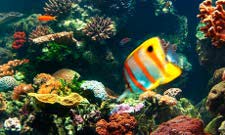
The Great Barrier Reef is being contaminated by the pesticide diuron, says the WWF. Photograph: Doug Steley B / Alamy/Alamy
The World Wildlife Fund says a decision by the Australian government to lift a three-month moratorium on the use of the pesticide, diuron, on tropical crops like bananas, pawpaw, pineapples and sugar cane is a "disaster" for the reef. "We are very disappointed at this institutional failure," said Nick Heath, WWF's spokesman on pesticides.
WWF says diuron has been detected in the reef hundreds of kilometres from its point of application. Nearly a third of the reef has been exposed to pesticides. "Diuron accounts for 80% of the pesticide load in the reef and is persistent and toxic," said Heath, adding that it damages sea grasses, which dugongs and sea turtles feed on.
In December a three-month ban on diuron came into force. It covered the wet season when soil run-off is at its greatest. From this weekend, farmers can resume spraying, with some restrictions still in place — spraying is not allowed if 50mm of rain is expected within three days of application or if the land has a slope greater than 3%.
The Australian Pesticides and Veterinary Medicines Authority, which regulates the use of pesticides, says more analysis is needed before any long term decision on diuron's future use is made. "Yes, diuron is toxic on the grasses and yes it will kill the aquatic organisms, but we need to ask whether there is a risk of it getting from the (farming) properties to those areas (on the reef)," said the APVMA's public affairs manager, Susan Whitbread. She says her department is analysing further data and stringent controls are still in place. "Yes there's an environmental concern, but what we have to do is quantify it and look at whether those risks are capable of being managed before we come to a final decision," she said.
The sugarcane industry, which is worth about A$2bn (£1.3bn) annually in Queensland alone and is the state's second biggest agricultural commodity, after beef, has welcomed the APVMA's decision to allow spraying to resume. "Diuron is a critical and cost effective tool for the sugar cane growing industry," said Steve Greenwood, CEO of Canegrowers, the peak body for sugarcane farmers. If diuron was banned, it's very likely a lot of the cane farmers would have to revert to old practices like burning to control weeds, which would have a significant environmental impact," he added.
The acrimony over pesticide use comes just weeks after a UN environmental team visited the reef amid fears its world heritage listing could be placed in jeopardy after a rapid rise in coal exports from the area.
Queensland's resources boom has led to an expanding number of developments along the state's coast where the 1,600-mile reef stretches. Nick Heath added that a combination of this development, climate change and pesticide pollution will cause the reef to die a death of a thousand cuts. "Most people dream about going to see the Great Barrier Reef. If we don't start turning this around there won't be a reef in the future."
Deep sea corals severely damaged by BP's Gulf of Mexico oil spill
Deep sea corals appear to have been seriously harmed by the Deepwater Horizon oil spill, according to scientists.
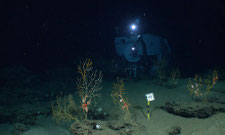
Scientists use the robot-armed submersible Alvin to find evidence of coral damage by the Deepwater Horizon oil spill. Photograph: Chuck Fisher Of Penn State Unive/PA
A survey of one site near the well in the Gulf of Mexico uncovered "compelling evidence" of pollution damage. Coral communities more than 1,220 metres (4,000ft) below the surface of the ocean appeared stressed and discoloured. Tests showed that oil from the site bore Deepwater Horizon's chemical "fingerprint". Determining the impact of oil spills at the bottom of the ocean can be difficult because oil seeps naturally from cracks in sea floor.
The explosion, in April 2010, poured an estimated 405m litres (160m gallons) of oil into the Gulf, causing a major environmental disaster.
Scientists looked at 11 deep-water coral sites three to four months after the well head was capped.
Healthy coral was found at all locations more than 12 miles from the Macondo oil prospecting site, where the blowout occurred. But at one site, seven miles south-west of the well, coral colonies presented "widespread signs of stress", including bleaching and tissue loss. Almost half of the 43 corals observed at that site showed evidence of impact.
The US scientists used an automated submersible, Sentry, and a manned robotic-armed vehicle, Alvin, to obtain images and samples at a depth of more than 1,300 metres. Their findings are published in the journal Proceedings of the National Academy of Sciences. Professor Charles Fisher, from Pennsylvania State University, took part in the initial dive, by a remotely operated vehicle (ROV), which identified the site. He said: "We discovered the site during the last dive of the three-week cruise. As soon as the ROV got close enough to the community for the corals to come into clear view, it was clear to me that something was wrong at this site. I think it was too much white and brown, and not enough colour on the corals, and brittle stars. Once we were close enough to zoom in on a few colonies, there was no doubt that this was something I had not seen anywhere else in the Gulf: an abundance of stressed corals, showing clear signs of a recent impact. This is exactly what we had been on the lookout for during all dives, but hoping not to see anywhere."
A second, more detailed look, including six dives by Alvin, confirmed the findings. An advanced "fingerprinting" technique called comprehensive two-dimensional gas chromatography was used to determine the source of the oil.
The scientists wrote: "The presence of recently damaged and deceased corals beneath the path of a previously documented plume emanating from the Macondo well provides compelling evidence that the oil impacted deep-water ecosystems."
Record submarine dive to the deepest point in the oceans
The sunlight faded to an enduring darkness only a minute or so after James Cameron's submarine slipped beneath the waves and began its descent to the bottom of the planet's deepest chasm, the Challenger Deep fissure in the Pacific Ocean's Mariana Trench.
For two hours and 36 minutes the filmmaker peered into the gloom and counted off the kilometres. The depth of the Bismarck came and went, at 2.9 miles (4.8km) not half way to this ocean floor. At five and a half miles, the submarine was deeper than Mount Everest stands high. When Cameron touched down, in the hadal zone, he was almost seven miles from the surface of the sea.
It was a moment seven years in the making for the Canadian film director, whose thirst for ocean exploration inspired his films Titanic, and The Abyss. Only two people had made the dive before: Don Walsh, a US navy submariner, and Jacques Piccard, a Swiss engineer, who, in 1960, took the plunge to the fissure in their bathyscaphe the Trieste.
"When I came down and landed, it was a very, very, soft, almost gelatinous flat plane, an almost featureless plane, that went out of sight as far as I could see," Cameron said during a press meeting aboard Octopus, the yacht owned by his friend, the Microsoft co-founder, Paul Allen. "Once I got my bearings and started moving around, I drove across it for quite a distance and I finally started to come to the slope that went up to the [trench] wall and I started working up that wall."
Cameron surfaced from the fissure — which is about 300 miles from the Pacific island Guam — at noon local time on Sunday, having spent more than three hours on the ocean floor. The expedition brought 52 years of technological progress into sharp relief. Walsh and Piccard endured ominous leaks and cabin-shaking cracks, and took so long to descend they had only 20 minutes on the ocean floor. On landing, they stirred up such an impenetrable cloud of sediment that any photography was pointless.
Cameron's trip in the Deepsea Challenger submarine was not impervious to the extreme environment. Under the intense pressure of 1,000 atmospheres, the submarine, which is almost 30ft long and hangs in the water like a vertical torpedo, was squeezed and became seven centimetres shorter. (The observation window bulged inward.) Before cramming his body into the tiny spherical capsule forming the habitable part of the submarine, Cameron took up running and yoga to improve his flexibility.
On the surface of the sea the capsule was swelteringly hot, but as the submarine descended into the icy waters, the temperature plunged too. "Within a minute or two, you're out of the sunlight and in total darkness for most of the dive," he said.
Though Cameron is gathering 3D film footage of his deepsea adventures, the submarine was built for scientific exploration. An enormous bank of floodlights illuminates the murk, and the vessel has robotic tools, including a claw and "slurp gun", that can gather sediment samples, rocks and small sea animals. There is plenty of science to do at great depths. Marine biologists have explored ocean trenches with tethered robotic vehicles and free-falling "landers" that sit on the ocean floor. They have filmed ghostly white snailfish at depths of five miles — but that could be the deepest level where fish can survive. Small shrimps are plentiful, working as scavengers of carcasses from the waters above. But knowledge about whatever else lives there is sketchy.
Cameron said: "I didn't see anything bigger than an inch long. I was hoping to get to rock outcroppings where I expected to see filter feeders and a different community there, but unfortunately I ran out of power before I got that far. We're going to have to do that on a different dive. You have to remember that the Challenger Deep, which is only a small part of the Mariana trench, is something like 50 times the size of the Grand Canyon. There is a vast frontier that's going to take us a while to understand. The impression to me was that it was very lunar, a very desolate place, isolated. My feeling was one of complete isolation from all of humanity. We'd all love to think there are giant squid and sea monsters down there. You can't rule it out, but my bet is there aren't."
The submarine was built by engineers in Sydney and tested in February during dives to the New Britain Trench off the coast of Papua New Guinea. During preparations that month, two of Cameron's collaborators, Andrew Wight and Mike deGruy, died in a helicopter crash in Australia. "A part of me was so sick at heart I didn't want to proceed with the expedition, but there seemed to be this consensus of what they stood for as individuals — they stood for living your life boldly and by your own rules," Cameron said.
Beneath the waves a technological hitch occurred when a hydraulic cable that was used to control the submarine's robotic claw ruptured and disabled the arm. With that out of action Cameron was unable to collect samples. He had hoped to bring back rock to help scientists investigate the geology of the trench, a product of the vast Pacific plate bending beneath the Philippine sea plate. The work might also shed light on the subsea processes that unleash such devastating tsunamis in the region.
"I want there to be more funding for the science of understanding the deep ocean. When people hear about a robot descending it doesn't have the same value. A human pilot will come back and tell you how it felt: how cold it was and how remote it was."
Monte Priede, director of Aberdeen University's Oceanlab, has designed underwater vehicles for 25 years. His group's robotic landers have gone more than six miles down into the Tonga-Kermadec Trench off New Zealand's north coast and explored at least four other trenches in the Pacific Ocean. Priede said of the Cameron adventure: "The technology his team has developed is truly outstanding, they have made some major leaps forward. Because [the submarine has] an upright design it can descend and surface very quickly, so you get more time on the bottom to explore. It does have the downside of not being able to move back or forward very fast, but it can carry far more lighting than a horizontal submarine. It's a masterpiece of design. He may well discover something. I'm a great believer in going out there and taking a look."
Cameron and his co-designer, Ron Allum, plan to do three or four more dives into the trench over the next few weeks. "I see this as the beginning. It's not a one-time deal. It's the beginning of opening up this frontier," Cameron said.
Norway urges EU to ban fish discards
Giving up the wasteful practice of discarding edible fish at sea is not only possible, but can result in greater profits for fishermen, according to the fisheries minister in Norway, which has banned the practice.
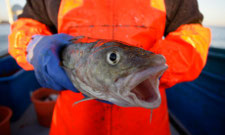
Norway faced a public outcry over the huge quantities of cod being discarded, particularly at a time when stocks were dwindling. Photograph: James Boardman
Up to two-thirds of the fish caught in some European waters are thrown back dead because of the way the EU's common fisheries policy works. Proposals to end the waste have faced opposition from fishing groups and some EU member states, several of which attempted to scupper the ban at a recent meeting in Brussels. In the end, the attempt to block a ban on discards did not materialise, in part because of strong opposition from the public and high-profile campaigns such as FishFight initiative spearheaded by the TV chef Hugh Fearnley-Whittingstall. But the issue will be discussed by European legislators several times this year before going to a final vote.
It is 25 years since Norway introduced a ban on discards amid the steady decline of the Arctic cod. As a result, stocks of the species have recovered.
The experiences of Norway, which is outside the EU, should be taken as an example to member states, says the country's fisheries minister. Lisbeth Berg-Hansen. She told the Guardian: "I hope the rest of Europe will see this ban can be possible. Fishermen saw it as difficult at first but they have seen the quick results of this ban — the quota got bigger year by year."
Some fishermen, mainly in companies with industrial-scale vessels, want to keep the present discards arrangement because they can maximise their profits by throwing back lower value, though edible, fish.
Berg-Hansen said Norway's discards ban was introduced as part of a package of measures that meant fishermen saw other benefits, and shared in the bigger catches that were allowed as the species recovered. "We looked at the problem as a whole, took scientific advice and used several different methods," she added.
Technology was used extensively: selective gear meant smaller fish slipped through the net, preventing juveniles being caught and helping to avoid by-catch. Some fishing grounds were also closed temporarily to allow stocks to recover, particularly in areas where there was a high proportion of young fish.
The amount of allowable by-catch was also curtailed, with rules brought in which meant that fishermen netting a large amount had to change location to avoid breaking the law. Fishing was more closely monitored, and the value of any fish caught in contravention of the regulations was made forfeit to the state.
One key part of the plan, said Berg-Hansen, was public backing of the ban — there was a growing outcry in Norway over the huge quantities of cod being discarded, particularly at a time when stocks were dwindling. "People saw that discarding fish is an absolute waste and irresponsible resource management," she said.
UK in "a minority" in attempting to secure fishing discard ban
The Guardian reports, 19th March 2012: " The UK vowed to hold firm against plans to continue the wasteful practice of throwing away edible fish at sea, at a meeting in Brussels. France and Spain have written a "joint declaration" to be discussed at an all-day meeting of fisheries ministers in Brussels which if adopted would mean the proposed ban on discarding healthy fish at sea would be lost. But as the meeting France had not tabled the document, leaving it uncertain whether the signatories had enough support to push through the change.
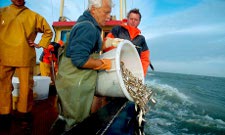
Campaigners, including Hugh Fearnley-Whittingstall, have been calling for a ban on discards — by which as many as two-thirds of healthy fish caught by fleets are thrown back into the sea. Photograph: Alamy
Under the declaration, the fish discards ban would be abandoned as "unrealistic" and "too prescriptive", meaning fishing fleets could carry on discarding edible fish at sea, while fish stocks continue to dwindle. Campaigners have been vociferous on the internet, calling over Twitter and other social media for ministers to stick to the original plan of banning discards.
Campaigners, including Hugh Fearnley-Whittingstall, have been calling for a ban on discards — by which as many as two-thirds of healthy fish caught by fleets are thrown back into the sea, dead, because they are less valuable than the species fishermen are trying to catch — for more than a year. In his series, Hugh's Fish Fight, he said half of all fish caught in the North Sea are thrown back. He called moves to block the proposed ban "worrying in the extreme".
At the meeting, ministers are also discussing a ban on shark finning at sea, and ways of preventing EU fishing fleets from overfishing in African waters.
The discards issue has been the subject of heavy lobbying in the past year, since the EU fisheries chief, Maria Damanaki, backed a change to the European common fisheries policy (CFP) to ban discards. Her reforms would mean fishermen would be forced to land all fish they catch, in return for compensation.
Some fishermen — mainly in companies with industrial-scale vessels — want to keep the present arrangement because by throwing back lower value, though edible, fish they can maximise their profits.
Discarding is a consequence of the strict quotas in the EU under the common fisheries policy on the amount of fish that boats may land. When fishermen exceed their quota, or catch species of fish for which they do not have a quota, they must discard the excess.
While the UK is standing firmly in favour of a ban, the Portuguese, Belgian and Irish ministers are thought to favour the France-Spain joint declaration. However, they may not wish to do so publicly at the meeting.
"Ending this horrendous waste has to be the number one priority of a reformed CFP, and I'm going to do all I can to keep it on the top of everyone's agenda," said Fearnley-Whittingstall. "Over three quarters of a million people have already signed the Fish Fight petition calling for an end to discards… Now its time for the politicians and decision makers to make it happen."
Scottish "black fish" scam compared to major bank robberies
Shetland Fishing ScamTrawler skippers and a processing firm netted £47.5million in the biggest fishing scam in Scots history. The colossal "black fish" scheme was worth £21million more than the notorious Brinks MAT bullion robbery in 1983. An insider said: "The amount of money involved is incredible."
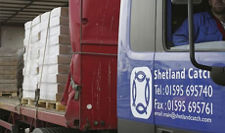
Shetland Fishing Scam
Seventeen skippers who took part in the Shetland scam have been hit with massive confiscation orders of the kind normally used on drug barons. The sums involved range from £425,900 to £2700. The men also face unlimited fines. Others have yet to come to court.
The astonishing size of the scam had been kept secret by a court order, which was lifted by Lord Turnbull at the High Court in Glasgow. The judge also allowed reporters to reveal how the crime was carried out — using an elaborate dodge to rig the scales at processing firm Shetland Catch.
Inspectors from the Scottish Fisheries Protection Agency watched computer screens in the plant's main hall to make sure skippers were not breaking strict EU rules on the size of their catches by landing too many herring and mackerel. They didn't know the screens had been doctored, using a computer programme which made sure they showed lower catch weights than had really been landed. The true weights were only shown on another screen in the plant's engineer's room — where the SFPA watchdogs were not allowed to go.
Shetland Catch have pled guilty to helping skippers land black fish. They have yet to learn how much of their cash will be confiscated. The company have been taken over since the offences were committed.
The scam was carried out between February 2003 and March 2005, but its scale still shocks insiders nearly seven years on. One source said: "It made quite a few millionaires. These men went out of their way to hoodwink the authorities. They dragged as many fish as they could out of the sea, without any regard for the consequences and despite having strict quotas. There are a lot of angry people in the fishing community. They feel they are being made to look guilty by association despite making an honest living."
The scam was eventually uncovered when accountants brought in by the SFPA realised Shetland Catch were spending more money than they could have earned legally. An investigation was launched and the dodgy scales system was discovered.
The £47.5million haul dwarfs the sums stolen in many of Britain's most notorious robberies. The Brinks MAT raiders took £26million in gold from a Heathrow warehouse, and two armed thugs got away with £40million in gems from Graff Jewellers in London three years ago.
The UK's biggest ever cash robbery — the £53million raid on a Kent Securitas depot in 2006 — netted just £5.5million more than the fishing scam.
The Court hearing paved the way for the 17 skippers who have admitted their involvement to be fined next month. They will not face prison terms.
The men — all from Shetland unless stated — have already been ordered to pay the following sums in compensation.
- Hamish Slater, 52, of Fraserburgh — £425,900
- Robert Polson, 48, of Lerwick — £371,300
- Victor Buschini, 51, of Poulton Le Flyde, Lancashire — £341,000
- Alexander Masson, 65, of Fraserburgh — £283,000
- John Irvine, 68, of Braeside, Symbister — £236,000
- William Williamson, 64, of Symbister, Whalsay — £213,200
- Laurence Irvine, 66, of Symbister, Whalsay — £210,700
- Alexander Wiseman, 60, of Banff — £196,000
- David Hutchison, 66 of Symbister — £140,900
- Thomas Eunson, 56, of Symbister — £140,500
- Allister Irvine, 63, of Symbister — £120,600
- Gary Williamson, 52, of Symbister, Whalsay — £118,500
- George Henry, 60, of Clousta, Bixta — £51,300
- John Stewart, 56, of Lerwick — £41,300
- George Anderson, 55, of Symbister — £40,700
- Colin Leask, 38, of Symbister, Whalsay — £12,000
- Allen Anderson, 55, of Symbister — £2700
South Georgia announces creation of large Marine Protected Area
The Government of South Georgia and South Sandwich Islands (GSGSSI) has announced the establishment of a large sustainable use Marine Protected Area (MPA) covering over 1 million square km.
As part of a long-term management and conservation strategy for the Territory, the announcement establishes in law one of the largest areas of sustainably managed ocean in the world. Nigel Haywood, Commissioner for South Georgia and the South Sandwich Islands, who formally signed the legislation, stated: "The waters around South Georgia and the South Sandwich Islands are among the most productive in the Southern Ocean, with very high biodiversity. We remain committed to the highest standards of environmental management in this unique and globally important UK Overseas Territory. Whilst the MPA announcement represents a hugely significant step in our management of South Georgia and the South Sandwich Islands, we will not rest on our laurels and will continually strive to improve our already excellent management of the Territory"
Dr Martin Collins, Chief Executive of the Government of South Georgia and South Sandwich Islands said: "South Georgia and the South Sandwich Islands are remarkable places, supporting an amazing density of wildlife. Establishing the South Georgia and South Sandwich Islands MPA is a key part of our long-term stewardship of the islands. Our continued good management of this UK Overseas Territory demonstrates that, even in a place as special as South Georgia, you can have sustainable fisheries with minimum impact on the ecosystem. This announcement is the culmination of a considerable amount of work by GSGSSI staff, the FCO and scientists from the British Antarctic Survey and our fisheries consultants MRAG"
Dr Phil Trathan, Head of Conservation Biology at the British Antarctic Survey, who advised the Government of South Georgia on the establishment of the MPA said: "South Georgia is a globally important island that deserves the strongest level of protection. I believe that this is a major step forward for conservation, not just at South Georgia, but also for the wider Antarctic. As a first step, it creates an important legal framework that will provide opportunities to enhance conservation and protection into the future."
David Attenborough, who recently presented the BBC's Frozen Planet series, said: "I am delighted to hear of the decision by the Government to create one of the world's largest marine reserves, which will help protect the unique and precious wildlife of South Georgia and Antarctica. This is extremely timely given the dramatic change that the polar regions are currently undergoing".
The MPA declaration enshrines in law much of the existing marine protection policy, and creates one of the largest MPAs on the planet. Within the MPA all commercial bottom trawling will be prohibited and commercial bottom fishing (primarily longlining) will be restricted to depths greater than 700m. The ban on bottom trawling protects the benthic marine environment from the damaging effects of bottom trawling, whilst the 700m depth minima for bottom fishing protects juvenile toothfish.
The MPA includes significant areas of no-take zone (IUCN Category I) around the coast of each island. These no-take zones (over 20,000 km2 in total, equivalent to the total area of Wales) will protect the foraging grounds of many of the Territory's land-based marine predators such as penguins, seals and seabirds and protect the spawning areas of many demersal fish species.
Fisheries campaigner and chef Hugh Fearnley-Whittingstall said: "Having just returned from a filming expedition to South Georgia, I welcome the new Marine Protected Area for South Georgia and the South Sandwich Islands as a vital step in protecting this extraordinarily abundant and diverse Southern Ocean marine habitat. And I know those who closely follow our Fish Fight campaign will welcome it too. As acknowledged by its creators, this MPA effectively enshrines in law the existing levels of protection and the current access to fishing in the seas around South Georgia."
Fearnley-Whittingstall added: "This is clearly a great step forward for marine conservation in the region, and the beginning of an outstanding opportunity. I count myself among the many conservationists and NGOs who would urge the South Georgia and UK governments to go further in the coming months. We would like to see the arbitrary 12-mile No Take Zone around South Georgia extended to include the entire continental shelf area and its margins, since this is a vital krill habitat and consequent feeding ground for the millions of krill-dependent fish, birds and mammals that inhabit South Georgia and its waters. Beyond that even, a fully fledged, no take Marine Reserve for the entire 200 mile zone surrounding these islands would set an outstanding global example of commitment to marine conservation. For many of us, that remains a visionary objective for this exceptional part of the ocean."
GSGSSI will continue to licence fisheries for toothfish, icefish and krill in the MPA (outside of the no-take zones) and use the revenue to patrol the region to prevent illegal fishing and undertake research and monitoring. These fisheries are extremely carefully managed, with both the icefish and toothfish fisheries certified as sustainably managed by the Marine Stewardship Council.
A scientific workshop, to be held in Cambridge in April 2012, will consider the need for further spatial and temporal protection within the MPA.
Key points
- South Georgia and the South Sandwich Islands is one of the UK's most remote and environmentally pristine Overseas Territories. It is internationally recognised for its biological importance, including its biodiversity and breeding populations of seabirds and marine mammals and was regularly featured in the recent BBC series Frozen Planet.
- On 27th February 2012, as part of a long-term management and conservation strategy for the Territory, the Government of South Georgia and the South Sandwich Islands (GSGSSI) has announced that a large (over 1 million km2) sustainable use Marine Protected Area (MPA) in a key part of the Southern Ocean.
- Declaration of the MPA, one of the largest in the world, enshrines in law the existing ban on bottom trawling throughout the South Georgia and South Sandwich Islands Maritime Zone (equivalent to an EEZ) and prohibits any bottom fishing (primarily longlining for toothfish) in depths less than 700m.
- Within the MPA fishing continues to be highly regulated, with licences issued to fish for Patagonian toothfish, krill and mackerel icefish. The South Georgia Patagonian toothfish fishery is currently one of the highest rated of the Marine Stewardship Council certified fisheries.
- This multiple-use MPA includes over 20,000 km2 of no-take zones (equal to the size of Wales), which protect inshore, shelf areas from any form of fishing, and includes all depths less than 100m. These no-take zones will protect the foraging grounds of many of the Territory's land-based marine predators such as penguins and seabirds (including several species of albatross) and also protect the spawning areas of many demersal fish species.
- The MPA is patrolled by a dedicated patrol vessel to prevent illegal fishing activity and ensure that therequirements of the MPA are upheld.
- The GSGSSI is committed to a programme of scientific research to determine requirements for further protection, including additional no-take zones in the Marine Protected Area.
- This work has been underpinned by scientific investigations undertaken by the GSGSSI, British Antarctic Survey, the Marine Resources Assessment Group and many other scientific organisations.
Donald Trump funds anti-offshore wind farm campaign
Donald Trump, the American property tycoon, is bankrolling a £10million fighting fund for British anti-windfarm campaigners. The move follows proposals for 11 giant turbines off the Aberdeenshire coast, which Mr Trump says will spoil the view from his golfing resort on the Balmedie estate, near Menie.
The billionaire believes the structures, each as high as a 64-storey building, will besmirch the unspoilt landscape surrounding the £750million, 1,200 acre complex. But with the resort being built over a site of special scientific interest, Mr Trump's sudden lust for preserving the environment may open him to accusations of hypocrisy. Locals campaigned in vain to save the sand dunes — home to numerous species of wading birds and wildlife — but they were finally bulldozed to make way for the fairways.
George Sorial, vice-president of the Trump Organisation, told the Sunday Times hundreds of groups fighting plans for windfarms had approached them already. Mr Sorial said the money would not just go to groups focusing on Scotland, but would help fight plans for windfarms across the country.
Meanwhile, construction on Trump International Golf Links resort has been halted, and the tycoon has threatened to sue Scottish ministers if the turbines get the go-ahead. However, some of Mr Trump's critics have pointed out that when work was suspended last summer, he blamed the global downturn rather than the wind energy proposals.
Mr Trump earlier this month wrote an open letter to Scottish First Minister Alex Salmond calling the wind plan 'disastrous and environmentally irresponsible.' In a blistering attack on his policies on renewable energy, Trump accused Mr Salmond of being 'hell bent on destroying Scotland's coast line and therefore Scotland itself'. The ill-tempered letter added: 'With the reckless installation of these monsters, you will single-handedly have done more damage to Scotland than any event in Scottish history!'
The bitter words were a far cry from the love-in the two men enjoyed four years ago when Mr Salmond boosted the resort plan by overruling local councillors who rejected it because of its environmental impact.
Other wind farm projects that have attracted Mr Trump's ire include proposals for up to 150 turbines overlooking Loch Ness. Mr Sorial told the Sunday Times: 'If you stop 90 per cent of the people in the street in New York they would associate Scotland with Loch Ness.
Renewable campaigners were furious at Mr Trump's planned contributions to the anti-windfarm campaign, saying that the intervention risked damaging Britain's ability to become a world leader and exploit its 'world class' wind resource. Gordon Edge, director of policy at RenewableUK, told the Sunday Times: 'It's astonishing that an American multi-billionaire feels he's entitled to circumvent the democratically decided policy of the Scottish and UK governments by supporting a shrill anti-wind minority, just because he might have to see a few wind turbines from his golf course.'
Britain currently has about 3,000 onshore wind turbines and several hundred offshore. A further 6,000 to 10,000 turbines are needed onshore and up to 25,000 around the coasts if greenhouse gas emission cuts targets are to be met, the energy and climate change department estimates.
33 species of seabirds in British Overseas Territories on "endangered list"
They are more exotic than the gulls, gannets and terns of Britain's home coastlines, but many of the fascinating and charismatic species of birds on the remote shores of UK overseas territories are now close to extinction. In a report to the government, the RSPB warns 33 species of birds, including penguins, parrots and albatrosses, are now critically endangered across the remnants of the empire. And that means we have a duty to fulfil.
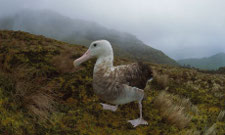
Under threat: the Tristan wandering albatross on Gough Island in the South Atlantic. Photograph: Tui De Roy / Minden Pictures
"Our overseas territories hold more threatened bird species than the entire European continent," said RSPB official Graham Madge. "Yet only £1.4m a year is spent by the government protecting habitats that provide homes for these endangered creatures. We need to spend 10 times that amount to save them."
The society's report is part of a series of submissions to the Foreign Office, which is preparing a white paper on Britain's strategy regarding its 14 overseas territories, including Montserrat, Bermuda, the Falklands, Tristan da Cunha and the atolls of the British Indian Ocean Territories as well Gibraltar and a chunk of the Antarctic. The white paper will propose economic and political changes in policies for running these areas and will outline ways to use them more actively to bolster Britain's defences.
The key concern for environment groups such as the RSPB is the need to improve care of the alarming number of threatened and endangered animals now found in these territories. "The overseas territories hold 85%of the threatened biodiversity for which the UK is responsible," said Jonathan Glenn-Hall of the RSPB. A typical example is the Tristan albatross, which breeds almost exclusively on Gough Island, part of the Tristan da Cunha archipelago.
The albatross's numbers have been destroyed by invasive species that have been brought to the island, in particular, rats, cats and pigs which eat albatross chicks. These invaders were eradicated several years ago in a campaign that only triggered a new threat to the Tristan albatross: mice. Without predators, mice on Gough Island have thrived and now grow to three times their normal mainland size. They burrow into the flesh of nesting chicks so that the birds bleed to death. Then the mice eat them. About 1,000 Tristan albatross chicks are thought to be killed each year this way. One recent survey has shown that, in 2008 numbers of Tristan albatross chicks that have managed to fledge is five times lower than normal.
"Invasive species — pests like rats and cats — are a major problem for the overseas territories," added Madge. "The remnants of our empire consist mainly of the odd remote island on which a small number of species have settled and evolved into forms unique to that place. They have evolved in a little bubble and that makes them very vulnerable to threats introduced by humans and gives us a special responsibility for looking after them." In the case of Gough Island, it is estimated that at least £5m will be needed to eradicate its giant mice and save the Tristan albatross from extinction. "We estimate that in total, Britain needs to spend £16m a year for the next five years to halt the worst threats to the habitats of its overseas territories," added Glenn-Hall.
Birds are not the only concern, the RSPB admits. For example, on St Helena introduced plants such as bilberry and furze have pushed many native plants to the edge of extinction with the St Helena olive tree being declared extinct in 2004. "It is unthinkable that this would have been allowed to drop off into extinction if the last species had been found in Britain, but all too often the overseas territories are out of sight and out of mind," added Glenn-Hall.
Other threatened species include the blue iguana on the Cayman Islands and turtles in the Caribbean which will lose many nesting sites as global warming melts ice caps and causes sea levels to rise. However, it is the importance of the bird populations of the overseas territories that is stressed by Madge, and in particular seabirds. When it comes to these, Britain is in second place among countries with the most threatened populations, he says. Only New Zealand has more endangered seabirds. "Thanks to our overseas territories, we outrank the US, Mexico, South Africa and other large nations when it comes to being responsible for saving endangered birds."
Apart from feral invaders, ecologists have highlighted three other main dangers facing birds in overseas territories: climate change, poor planning controls and weak management of local fisheries. A typical victim of climate change is the Northern Rockhopper penguin, also found on Gough Island and suffering, not from mice, but from disruptions to its food chain brought about by global warming. Populations have declined by more than 90% in the last 50 years.
By contrast, the white-chinned petrel — which breeds on several South Atlantic islands including South Georgia and the Falklands — is suffering major population reductions because birds are getting caught in longlines towed by fishing vessels and being dragged underwater.
And in the Cayman Islands, uncontrolled development is destroying the habitats in which the Grand Cayman parrot and the Cayman Brac parrot breed, again with disastrous consequences for populations. "Many of these places rely on money brought by tourists who visit to see the exotic wildlife," added Madge. "We have a responsibility to make sure that wildlife survives."
Sizewell residents want emergency zone consideration
With hind sight of last years Fukushima disaster when 170,000 people were evacuated from within a 20-km radius of the nuclear plant and thousands more self-evacuated from an even wider area, the Sizewell Stakeholder Group (SSG), the local nuclear liaison group, is calling for an extension of the emergency zone around the nuclear power station site.
They also want to see an improvement on the flow of information between the site and its neighbours, for consideration given to a full-scale mock evacuation involving the local population and for the routine issue of anti-radiation tablets to be extended to local schools, whether or not they lie within any revised emergency zone. At present the Sizewell emergency zone — the area subject to a detailed major accident response plan — extends to just 2.4 kilometres, within which up to 900 people live or work, depending on the season. The zone does not cover most of the built-up area of Leiston and its four schools.
Suffolk's emergency planning committee is undertaking a routine review of the Sizewell plan and will be taking into account the lessons learned in Japan. They also want more information on potential radiation doses from a Sizewell accident to be made available, and state in a letter to be sent to emergency planners this week: "While the SSG does not feel competent to propose an exact area which should form an extended emergency planning zone, it does feel that an area of up to 20 kilometres should be considered."
Another new EA flood and coastal risk consultation
On Friday 9th March 2012 launched a new consultation on its proposals for flood and coastal erosion risk management of the Clacton-on-Sea and Holland-on-Sea coastline.
The Environmental Agency has been working in tandem with Tendring District Council and Essex County Council to look at how to sustainably manage the coastline over the next 100 years, and in doing so has now developed recommendations which are set out in its draft Plan 'Clacton and Holland — Managing the coastline for our future'. The document explains why we the draft Plan has been produced and what the next steps are.
The Agency also carried out environmentally assessments of a list of options which inform its final recommendations. The assessment is presented in the Strategic Environmental Assessment Environmental Report. In addition, a more detailed document providing technical information on how the draft Plan recommendations were developed has been produced. The Clacton and Holland Flood and Coastal Erosion Risk Management Plan — Technical Document is available upon request, presumably from their office, as no website coverage is given.
However, the EA are now seeking comments both on the contents and conclusions of the draft plan and the Environmental Report. Deadline for submission of responses to the consultation is 3rd May.
The Agency will use the responses to finalise its recommendations for coastal management at Clacton-on-Sea and Holland-on-Sea. The results of the consultation will be available in July 2012.
12 of Britain's 19 nuclear sites at risk from flooding and coastal erosion
Probably triggered by MARINET's communicated concerns (see Refs: www.marinet.org.uk/mad/objection/430pat1metoc.pdf — www.marinet.org.uk/mad/parliament12jan.html — www.marinet.org.uk/mad/sizewell.pdf and thirty other references to be found under a search on this website for 'Sizewell') an unpublished document compiled by the Department for Environment, Food and Rural Affairs (DEFRA) obtained by a national newspaper showed that 12 of Britain's 19 nuclear sites, including the threatened new build at Sizewell, are at high risk from flooding and coastal erosion because of climate change. The risk analysis was carried out by officials from DEFRA's floods and coastal erosion team as part of an investigation into the impacts of climate change said that Sizewell, which has been identified by the Government as a suitable site for new nuclear build, was at "high risk" of flooding. Altogether 12 of Britain's 19 nuclear sites are at risk from flooding and coastal erosion.
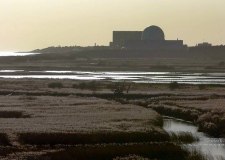
Sizewell — at 'high risk' of flooding
However, EDF Energy, owners the Sizewell nuclear power station, said they were confident their safety measures were adequate to protect against such dangers. Their spokesman claimed that they were confident that the site was adequately protected against potential storms and coastal flooding, but did not mention the serious threat of underminement that would evolve as the level of the beach and offshore sandbanks are reduced and the seabed lowered. "Such safeguards are part of our nuclear site licence for each station," he said. "Protection from flooding has also been factored in to our new build plans and will be covered by a robust regulatory regime, should consent be granted."
Tom Griffith-Jones, from the Shutdown Sizewell Campaign, said: "I don't think it's a surprise but it just highlights the stupidity of wanting to build a new nuclear power station on that site. Even with the most stringent of safeguards how can you predict what will happen in 100 years? Erosion is taking place at an extreme rate."
Over-fishing and rats implicated in continued serious decline in global seabird populations
Almost half of the world's seabirds have populations that are thought to be in decline, according to a new review. The study, published in Bird Conservation International, has found that 28% of species are considered to be in the highest categories of risk. Conservationists are particularly concerned by the albatross family.
Threats to the birds include commercial fishing and damage to breeding colonies caused by rats and other invasive species.
Seabirds make up just a small proportion (3.5%) of the world's bird species. But researchers say they are an important indicator of the health of the oceans. The review, carried out by BirdLife International, found that of 346 species, 47% are known or suspected to be in decline. It says that seabirds are now more threatened than any other group of birds.
Prof John Croxall, Chair of BirdLife's Global Seabird Programme, told the BBC: "They are top predators in their marine systems. The fact that almost a third are globally threatened should really be telling us something about how we need to look after where they occur to breed on land and where they go to feed in the ocean."
BirdLife assesses the threat status of seabirds on behalf of International Union for Conservation of Nature (IUCN), which compiles the internationally-recognised Red List. On that list, 5% of seabirds are in the highest category of Critically Endangered. One of those is the Balearic shearwater, which can be found in UK waters in the summer. The review also found that 17 out of 22 species of the albatross family are threatened with extinction.
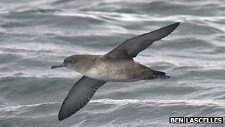
Critically endangered Balearic Shearwater
Conservationists say commercial fishing is one of the key threats to seabirds with large numbers killed as a bycatch in nets and on lines. Another is the impact that invasive species such as rats and feral cats have on breeding colonies, either damaging habitats or eating chicks and eggs.
Some of the most important breeding colonies are on remote islands in UK overseas territories. Last year an Royal Society for the Protection of Birds (RSPB) project, part-funded by the UK Government, carried out a programme to eradicate rats on Henderson Island in the South Pacific. Helicopters guided by GPS dropped rat poison pellets on the island, which is the only known breeding site of the endangered Henderson petrel.
Grahame Madge of the RSPB said: "Without projects like this, these seabirds would have a finite life. On Henderson Island the rats were bringing birds towards extinction." A pilot study is being carried out to look at the feasibility of removing mice from another important breeding site, Gough Island in the South Atlantic.
New control of polluting emissions to air will be expensive for shipping industry
The financial cost of tighter controls on pollution from shipping would be outweighed by health benefits estimated at £1.1bn a year by 2020, MPs said in a report by the Commons Transport Select Committee which urges the government to work with fellow EU members to block the EC's "gold-plating" of the regulations with the additional restrictions on passenger ferries.
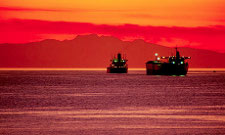
The financial cost of tighter controls from shipping would be outweighed by health benefits, say MPs. Photograph: Ron Watts/Corbis
"Tighter emissions limits have been under discussion for many years, during which time shipping has enjoyed favourable treatment when compared with the emissions limits and fuel costs faced by the road haulage industry," the committee said in a report. "However, we acknowledge that these regulations will impose significant costs on operators, and we therefore agree that the commission should impose no additional burdens on operators at this time over and above the requirements of Annex VI."
Maritime UK, which represents shipping and ports, said the regulations would cost jobs.
The vice chairman, Lars Olsson, told the committee the regulations would place an additional financial burden of up to £3.6bn on shipping. "The problem we have as an industry is that we cannot absorb this additional cost and we have to offset it by adding it to transport prices, for both passengers and freight," he said. "This, we believe, will lead to modal shift. It will affect our businesses in a radical way and it may lead to route closures and loss of jobs, investment and so forth."
Overall, the strict new pollution controls will cost thousands of British shipping jobs, force ferry fares to rise by a fifth and may even drive operators out of business, said the UK maritime industry. It warned that ports including Newcastle, Hull, Harwich, Teesport and Rosyth would be particularly badly hit by tougher limits on sulphur emissions in the North Sea.
Ferry companies said their fuel bills would rise by tens of millions of pounds a year, resulting in passenger fare increases of 20%, fewer services and job losses. They also claimed that more traffic would be transferred to the roads and that higher freight costs would mean imported goods would cost more.
The so-called Annex VI controls, to come into force from 2015, are backed by the British government as part of an international convention revised in 2008. The European Commission wants to bring the regulations into European Union law, but with additional requirements — resisted by the UK — for passenger ferries to observe the limits even when they are outside special emission control areas. Steve Todd, national secretary of the Rail, Maritime and Transport Union, said: "You are talking about thousands of seafarers' jobs being at risk if companies are forced into having to withdraw vessels because they cannot comply by a certain date."
P&O Ferries said its fuel costs would rise by about £60m a year, adding: "This will change routes which today are marginal, to be heavily loss making routes. This is completely unsustainable, with job losses inevitable." It said ferry services within the North Sea emissions control area would face "severe economic cost pressures" from 2015 and non-economic routes would have to be closed. "Within the UK, short sea and ferry services on the longer North Sea Routes from Rosyth, Newcastle, Teesport, Hull and Harwich are particularly exposed to these job losses," it said. "Many of these areas are already suffering from high unemployment due to the ongoing recession over the last three years, and further job losses will hit these communities hard."
Brittany Ferries told the committee its costs would rise by at least £40m. "To absorb additional costs of this magnitude passenger fares and freight rates would have to increase by 20% which will inevitably result in a fall in business," it said in written evidence to the committee. "Because of our longer routes, which unavoidably use more fuel, our passenger fares and freight rates are already significantly higher than those on the Dover Straits. We are, consequently, relatively more sensitive to fuel prices so these increases would make us uncompetitive, particularly as the Tunnel will not be affected by these regulations. This will result, at the very least, in a reduction in frequency of services and the closure of routes and, at the worst, a cessation of business."
The Transport Committee chairwoman Louise Ellman said: "Clearly the government must work with industry to identify available abatement technologies and help overcome barriers to the development of this equipment. But when tough emission standards were first imposed on cars, suitable technology emerged far more rapidly than much of the motor industry forecast and cost far less than was predicted at the outset."
A Department for Transport spokesman said: "We welcome the Transport Select Committee's report which broadly supports our position in relation to the Commission's proposal for a revised directive on sulphur in marine fuels. Along with representatives from the international shipping industry, the UK supported the reduction in sulphur limits when they were agreed in 2008. This agreement represents a global compromise following lengthy and difficult negotiations. We are confident that the new limits will significantly reduce emissions from ships, improving air quality and delivering benefits to both the environment and human health."
Suggestion that Government funded fish marketing agency knew about Scottish "black fish" crime
The Guardian reports, 24th February 2012: " An inquiry into the UK's largest fishing scandal has uncovered "serious and organised" criminality by Scottish trawlermen and fish processors in an elaborate scam to illegally sell nearly £63m of undeclared fish. Three large fish factories and 27 skippers have pleaded guilty to sophisticated and lucrative schemes to breach EU fishing quotas, in what one senior police officer described as "industrial level" deception. They went to extraordinary lengths to conceal their illegally caught fish, installing underground pipelines, secret weighing machines and extra conveyor belts and computers to allow them to land 170,000 tonnes above their EU quota of mackerel and herring between 2002 and 2005.
The extent of the "black landings" scandal emerged as 17 skippers and one of the three factories were given fines totalling nearly £1m at the high court in Glasgow on Friday, after admitting repeated breaches of the Sea Fishing (Enforcement of Community Control Measures) (Scotland) Order 2000. Another six skippers pleaded guilty at the same hearing to landing undeclared fish worth nearly £7m at Lerwick, in the Shetlands, and Peterhead, Aberdeenshire. Four skippers pleaded guilty in January and a further four in the ring, who can't be named for legal reasons, are still to be prosecuted. Judge Lord Turnbull, told the 17 skippers sentenced on Friday they were guilty of a "cynical and sophisticated" operation, which brought embarrassment and shameon them and their families. "The motivation was purely financial," he said. "Those who were already making a good living saw this as a way more income could be generated and were prepared to participate in deliberate lies and falsehoods."
Once the illegally caught fish had been sneaked past Government inspectors, it was put on sale in the Lerwick and Peterhead markets, where it was sold to wholesalers and fishmongers as if it had been legally landed, in defiance of strict EU regulations designed to protect Europe's fish stocks from over-fishing.
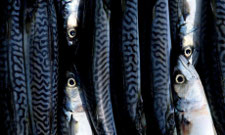
Nearly 30 fishing skippers and three processing factories have admitted schemes to breach EU quotas. Photograph: Cathal Mcnaughton/PA
The Guardian can reveal that the illegally landed fish was sold with the knowledge of the government-funded industry marketing authority Seafish, which took a £2.58 levy for every tonne of over-quota mackerel and herring. That earned it £434,000 in fees before the Scottish Fisheries Protection Agency, now part of Marine Scotland, raided two factories in September 2005.
The headquarters of Seafish in Edinburgh were raided by police and documents seized in 2008, but five months later prosecutors decided not to take any further action. It is thought the Crown Office, the Scottish prosecution body, believed there was no evidence that could lead to the agency being accused of involvement in the scam.
With a series of court cases stretching back to 2010, the scandal has implicated more than half the Scottish mackerel and herring fleet active at that time. It is understood that the true value of the illegal landings linked to the factories involved is closer to £100m, but prosecutors decided to pursue just £63m of landings.
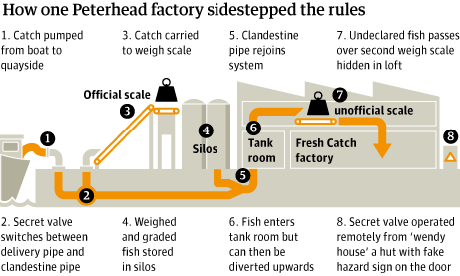
Black fish factory graphic How one Peterhead factory sidestepped the rules. Source: Guardian graphics
Prosecutors have also confiscated £3.1m from 17 skippers who landed catches in Lerwick, and against two of the three firms so far convicted, under proceedings of crime legislation introduced to tackle serious criminal gangs and drugs lords. The largest confiscation order, £425,9000, was against Hamish Slater, the skipper of the trawler Enterprise from Fraserburgh, Aberdeenshire, who admitted landing £3,980,000 worth of undeclared fish. A number of skippers landed fish worth more than £2m.
At Shetland Catch in Lerwick, one of Europe's largest fish processors, the company installed a duplicate conveyor belt when its new factory was built, fitting a secret weight-reading device in the loft and a computer in an engineer's workshop "a considerable distance" from the factory floor.
In its processing plant at Peterhead, north of Aberdeen, Fresh Catch installed an underground pipe to divert fish to secret weighing devices, which used remotely operated pneumatic valves. It built a secret storage room, and operated the clandestine machinery from a hut known to workers as the Wendy House, disguised with fake "Danger: high voltage" signs on its door.
A second factory in the town, Alexander Buchan, which has since closed, fitted a secret scale and conveyor belt, which allowed up to 70% of a boat's catch to go undeclared. It printed a guidance manual showing its staff how to handle undeclared landings, and its staff misled trading standards officers about its purpose.
Detective Superintendent Gordon Gibson, of Grampian police, the senior investigating officer in Operation Trawler, said: "Make no bones about it: it was serious, it was organised and it was criminal. The element of preparation involved was significant, given the methods and means that all these individuals went to. "Was I surprised? Absolutely. I was surprised at the levels they had gone to disguise their criminal conduct."
An industry source admitted: "This wasn't casual or by accident. It was organised, it was systematic, it was deception. No one disagrees with that."
In a further penalty, which is thought to have cost the convicted skippers millions, the European Commission cut the quotas soon after the scandal was reported to Brussels by the UK government in 2005, calling it a "quota payback". Although none of the trawlermen have been banned from fishing, their quotas were cut by more than 116,000 tonnes of mackerel and nearly 47,000 tonnes of herring over a seven-year period. That payback will end next year.
One source with detailed knowledge of the case said this had damaging consequences for skippers and crews involved, as the market value of mackerel and herring since 2005 had been as much as double the price 10 years ago.
The convictions follow a complex, 10-year investigation involving forensic accountants from KPMG, who analysed the paperwork for thousands of landings, a core team of 25 detectives and support staff from Grampian and Northern police, four British sea fishery officers with Marine Scotland, the Home Office Holmes police computer system, money laundering experts with the Scottish Crime and Drug Enforcement Agency, and specialist prosecutors at the Crown Office.
Operation Trawler has brought to an end a practice which was once endemic in the British fishing industry, but has been made extremely difficult by hi-tech monitoring and tracking of every registered trawler at sea, and much tighter controls on landings at processing firms.
The skippers and firms involved have refused to discuss their convictions; Shetland Catch is still facing confiscation proceedings. But sources with detailed knowledge of the scandal have admitted the practice was widespread within the pelagic fishing industry. Lawyers for one of the convicted men, George Anderson, 55, from Whalsay, Shetland, claimed this year that he evaded the controls because he believed that discarding under-sized fish was "repugnant".
"Black landings" are still common practice across the EU, and prosecutions still take place. In Lerwick and Peterhead, some insist that the undeclared landings, which helped many of the skippers and their crews enjoy comparatively luxurious lifestyles, were well-known within the industry and among regulators.
Asked about its knowledge of the illegal landings, Seafish told the Guardian it was legally required to take the levy, and insisted it had tipped off the authorities to the over-quota landings. However, one source said that the issue was discussed in board meetings, "but the Seafish line was that we weren't a fishery protection agency, our job was to take a levy on every tonne landed." He added: "They were totally aware they were getting a levy on quota and over-quota fish."
The source denied it was serious and organised crime: the skippers involved paid income tax and business taxes alongside the Seafish levy on all their illegal landings, largely because the over-quota fish was sold in the fish markets as if it were legally declared. Fraud charges were dropped by prosecutors at an early stage, he said. But he added: "There is nobody defending this. It was morally wrong; it was ecologically wrong and sustainably wrong. There is no excuse. A lot of the skippers are saying, 'What we did wasn't right; it was wrong. We really want to draw a line under this and move forward.'"
He said the scandal had the effect of transforming Scotland's pelagic fishing industry into one of the most sustainable in the world: after the raids, the mackerel and herring fleet introduced very strict monitoring and quota management. Since 2008, its fisheries have won a prized Marine Stewardship Council eco-label, and are now the largest in Europe with MSC certification.
But the "black landings" scandal is coming back to haunt the industry. It is expected to lose its MSC accreditation later this year after a bitter dispute with the Faroe Islands and Iceland: both countries have claimed much larger mackerel quotas than is sustainable for the north-east Atlantic stocks, in breach of MSC rules. The Faroese in particular believe the over-quota prosecutions puts the Scottish industry's credibility in severe doubt. "It's not a proud moment for what is a very proud industry," one senior figure conceded.
Richard Lochhead, the Scottish agriculture secretary, said the convicted were guilty of appalling behaviour. "These illegal activities are a stark and shameful reminder of the culture that existed in some sectors of the fishing industry in past years," he said. "Thankfully, there has been seismic change in the attitude and behaviour of the fishing fleet, which can only be good thing in securing a viable future for the industry."
Dr Mireille Thom, a senior marine policy officer for the conservation group WWF Scotland, said: "Deliberately ignoring quota rules by landing 'black fish' isn't a victimless offence. Such landings not only undermine the conservation of fish stocks and the fortune of the fleets that fish them, they also distort competition by depressing fish prices. In short, they threaten the public good for the benefit of a few."
Coastguard Station battle continues
Coastguards, scuba divers and boat users have all come together in an attempt to prevent the axing of Great Yarmouth's coastguard station, with their hopes now pinned on the Government's closure plans falling foul of health and safety rules.
In January Norfolk County Council passed a motion calling on the Government to reconsider its decision, and at a further County Hall meeting on 27th February county councillor for South Smallburgh Paul Rice called on the Government to carry out a risk assessment before shutting the Maritime Rescue Co-ordination Centre at Havenbridge House, saying "We're asking for a proper risk assessment. I think we could get it (the closure) reversed based on that." Colin Mead from Sheringham Coastwatch slammed the plan as "sheer lunacy".
The Welsh Assembly has called for a risk assessment on the nationwide closures and the Scottish Parliament is also understood to be considering a similar move.
For the earlier information details of the governments planned closure of eight of the nineteen coastguard stations, including that at Great Yarmouth, go to 'Government confirms Coastguard Centres closure' at: www.marinet.org.uk/archive/archivelatestnews2011.html#gccc.
Coastal region aims for extra recognition
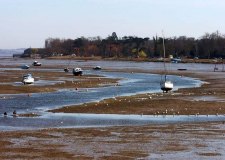
The River Stour at Manningtree
Under "Manningtree and Mistley: Coastal region aims for extra recognition" the East Anglian Daily Times of 5th March '12 reports that Tendring District Council have produced a comprehensive report to Natural England in an effort to seek special status — that reserved only for the country's most treasured rural areas — for the southern shore of the River Stour.
Currently, the Suffolk Coast and Heaths Area of Outstanding Natural Beauty (AONB) only takes in the northern shoreline, whilst if the bid is successful, the designation would be expanded to the Essex side of the river and would include both Manningtree and Mistley. A previous bid for such status was launched in May 2010 with the full support of Essex County Council and the wider AONB partnership of local authorities and organisations such as the Essex and Suffolk Wildlife Trusts, the RSPB, and the Council for the Protection of Rural England. The bid also has the backing of the Harwich and North Essex Conservative MP Bernard Jenkin who launched a parliamentary campaign on the issue in 2010, but so far no decision has come forth.
To add your support, call Clive Dawson, the council's tree and landscape officer, on 01255-686155 or e-mail cdawson@tendringdc.gov.uk
From Poo to Power
Waterbriefing of Monday 6th March, reporting from a paper published in the Science Journal on 1st March, described how a novel combination of microbial fuel cell technology with reverse-electrodialysis can be used to provide 0.9 kilowatt/hours of electricity per kilogram of organic waste, so turning waste water treatment plants into power stations.
Professor Bruce Logan, one of the scientists at Pennsylvania State University involved in developing this technology, said that it could "take care" of the whole water system — the treating and pumping of water as well as treating the organic matter much faster. He feels that there is great potential for the use of this technology in developing countries as sewage treatment plants would be better maintained given their new function of generating electricity for the local population. He said "By combining the two technologies we overcame the limitations of the fuel cell and synergistically generated energy for the reverse electrodialysis system"
UK nuclear sites at risk of flooding, report shows
As many as 12 of Britain's 19 civil nuclear sites are at risk of flooding and coastal erosion because of climate change, according to an unpublished government analysis obtained by the Guardian.
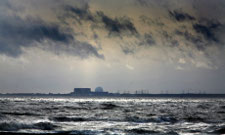
Unpublished government analysis shows sites are at risk from flooding due to climate change. Photograph: Graham Turner for the Guardian
Nine of the sites have been assessed by the Department for Environment, Food and Rural Affairs (Defra) as being vulnerable now, with others in danger from rising sea levels and storms in future decades. They include all of the eight sites proposed for new nuclear power stations around the coast, as well as numerous radioactive waste stores, operating reactors and defunct nuclear facilities.
Two of the sites for new nuclear stations are said to have a "high risk" of flooding now: Sizewell in Suffolk and Hartlepool in County Durham, where there are also operating reactors. Shutdown and running reactors at Dungeness in Kent are also classed as currently at high risk.
Another of the sites most at risk is Hinkley Point in Somerset, where the first of the new nuclear stations is planned and there are reactors in operation and being decommissioned. According to Defra, it already has a "low" risk of flooding, and by the 2080s will face a high risk of both flooding and erosion.
Other new reactor sites that face some risk now and high risks by the 2080s are Oldbury in South Gloucestershire and Bradwell in Essex. The huge old nuclear complex at Sellafield in Cumbria is said to face a "medium risk" of flooding now and in the future.
Mining for coal and gas exploration threatens Australia's Great Barrier Reef
A UN environmental team has arrived in Australia for a crunch 10-day assessment of the Great Barrier Reef, warning that the coral ecosystem is at a "crossroads" due to the soaring activity of the mining industry in the World Heritage Area.
United Nations Educational, Scientific and Cultural Organisation (Unesco) visit comes amid fears that the reef's world heritage listing, which it has held since 1981, could be placed in jeopardy after rapid escalation in coal exports and gas exploration.
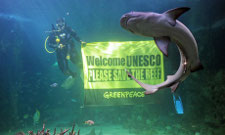
Divers unveil a Greenpeace banner at Sydney Aquarium urging Unesco to protect Australia's Great Barrier Reef. Photograph: Greg Wood/AFP/Getty Images
"The Great Barrier Reef is definitely at a crossroad and decisions that will be taken over the next one, two, three years might potentially be crucial for the long-term conservation [of the reef]," said Fanny Douvere, from Unesco's World Heritage marine programme.
Australia's coal boom is set to open up the previously undeveloped Galilee Basin in central Queensland, greatly increasing the number of developments along the state's coast, where the 1,800-mile reef stretches. The proposed infrastructure includes Abbott Point, which would become the largest coal export port in the world. At full capacity, the expansion would see more than 10,000 coal-laden ships a year cross the Great Barrier Reef by the end of the decade — a sizeable increase on the 1,722 vessels that entered the World Heritage Area in 2011.
Environmentalists are concerned that ships navigating reef passageways — many of which are narrower than the English Channel — will run aground, as a Chinese vessel did in 2010, tearing a two-mile gash into the coral and spilling several tonnes of oil. There are also warnings that the reef's six species of turtle, including the endangered loggerhead and Olive Ridley turtles, and the snubfin dolphin, Australia's only endemic dolphin, would be affected by any mass industrialisation of the Queensland coast. Any reduction in visitor numbers to a region that generates AUS$6bn a year from tourists would also be keenly felt by local businesses and the Australian economy at large.
Douvere and Tim Badman from the International Union for Conservation of Nature are set to meet with government ministers and NGOs, as well as visit the reef to assess the impact of new developments. The specially arranged trip follows a minor diplomatic incident last year when Unesco's World Heritage Committee said it was "extremely concerned" that the Australian government had not informed it of the approval of a major liquefied natural gas hub on Curtis Island, off the Queensland coast.
The expansion of the hub at Gladstone has been blamed for a sharp drop in water quality and widespread disease of marine creatures. More than 45m cubic metres of sea floor is to be dredged in the World Heritage Area to accommodate the boom in shipping, with the government warning that it will penalise mining companies that dump accumulated waste on the corals.
Douvere said: "When it comes to dredging issues I think that a big part of our discussions need to focus on what the alternatives are." Speaking to the Guardian from Paris, prior to her departure to Australia, Douvere said that there were multiple threats to the reef's wellbeing. "We won't just be looking at the increase in shipping, but also issues such as how climate change and the recent cyclone and extreme weather has affected the reef," she said. "We will look at the overall impact of these things. We don't regularly make these kind of trips but it was asked for by the World Heritage Committee after issues were raised last year."
Environmental groups have claimed that Unesco's visit is an embarrassment for the Australian government. Greenpeace Australia spokesman James Lorenz said: "We are looking at an enormous, unprecedented increase in coal, oil and gas exploitation here." Unesco is clearly very worried about this and if they decide the reef is in danger, that places it at the same level as sites in places such as Afghanistan, which is deeply embarrassing for Australia. The Great Barrier Reef is priceless but it is being treated like it's a worthless. It has been mismanaged for years and we are now at a tipping point."
Both the federal Australian and state Queensland governments have launched their own 18-month assessments of the reef, although ministers have come under fire for considering several large developments, including Abbott Point, during the review.
Tony Burke, Australia's environment minister, has defended his handling of the issue, telling ABC Radio: "Let's not forget, with Abbot Point, there is already a significant level of industry that occurs there. One of the largest levels of concern here is shipping, as the vessels move through the reef area. So those shipping movement issues are issues that really have to be front of mind throughout all of this."
5 new Special Areas of Conservation proposed in Scottish seas
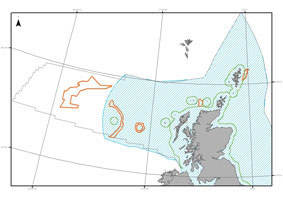
Scottish SACs Consultation Map
The Joint Nature Conservation Committee (JNCC) is currently formally consulting on five new possible SACs (pSACs) in UK offshore waters. These are Hatton Bank, Anton Dohrn Seamount, East Rockall Bank, Pobie Bank Reef and Solan Bank Reef in Scottish offshore waters. The closing date for the 12 week formal consultation is 25th May 2012
EU Commissioner Damanaki calls for "commitment to CFP reform"

In a keynote address to the EC Inter-Parliamentary Committee, titled 'Working Together Towards Sustainability', Commissioner Damanaki said: "We are all convinced that we need to shift to a more sustainable approach; that good and lasting economic performance for our industry can only come from healthy stocks. Sure, some would have wanted an even more ambitious set of proposals; others are rather critical; others still agree on almost every point. But we have one thing in common and that is that we all want to get this reform right and reverse the decline of the sector.
"But let us look at some of the more controversial points. There is one recurring criticism in several opinions: the mandatory character of changes. Let's look for example at Maximum Sustainable Yield [MSY] by 2015: most of you say 'yes', but would like to add 'where possible'. The discard ban: you say yes in principle, but we need more time and flexibility. Transferable concessions: yes again, but please not mandatory. And so on.
"We need a more binding approach in our reform. We can not avoid political responsibilities. 'Where possible' may mean 'never'. Without deadlines, without a specific target for implementation, we will postpone again and this reform will fail.
"I know the target dates we have set are strict and difficult and sometimes soon. But this is the only way that we can provide for a viable future for our fishermen. Getting to sustainable exploitation is an urgent matter; we need to draw a precise roadmap with realistic, but progressive and concrete milestones.
"Take for example MSY. If we are to achieve sustainable levels for all the stocks, we must set a target date for it. For some of you, it should not be 2015. I think it should, for at least three reasons.
"The first: working towards MSY can be done and has been done quickly in a number of fisheries. In 2009, out of 38 stocks assessed, only five of them were at sustainable levels; now we have 20. Eastern Baltic cod, a stock that used to be severely overfished up until recently, is on its way to sustainable levels; the same is true for anchovy in the Bay of Biscay, North Sea Herring, Northern hake… We have let the stock recover for a few years and now quotas and revenues are on the rise. So it is possible.
"The second reason: when we relieve fishing pressure, very quickly more catches can be made, as the fish grow in size and weight. It also becomes easier to catch them, reducing the costs of fishing and increasing the profits. This month an independent body, the New Economics Foundation, reminded us once again of the huge potential of good fisheries management. They say that every year in the EU27 the fishing industry could have an extra €1.8 billion — almost three times the subsidies we grant — and we could create around 83,000 jobs — a third of the current employment in the EU fishing sector — if stocks were restored to MSY levels. In the current economic climate, we can't afford to miss these opportunities. We cannot afford to say 'later'. Reaching MSY is an economic imperative.
"And the third reason: rebuilding fish stocks by 2015 is a legal obligation under the United Nations Convention on the Law of the Sea and the Johannesburg Plan of Implementation of 2002 — both of which the European Union has signed, together with other partners. Do we really want to show the international community that we simply give up, when we argue for the EU leading the fight for a better environment?
"Let me now come to the discard ban. We will implement it gradually and we need to find pragmatic solutions for mixed fisheries. Public opinion is massively against discards. Right now there are at least 70 anti-discard initiatives around Europe. Either by the fishermen, who are finding ways to fish more selectively; or by European retailers, who are de-listing species from their supply whenever stocks are endangered or non-selective fishing techniques are used.
"Through the new European Maritime and Fisheries Fund, we will provide financial support to the industry for this kind of initiatives and to implement the ban. We will incentivise selectivity. We will reduce the pressure on the most popular and fragile species by promoting diversity of supply. But we need to go for the ban with clear target dates. Otherwise, consumers will decide for us and may boycott perfectly good products simply because they no longer accept the waste that goes with them. Again: if we do not set on ourselves strict but realistic deadlines, we will only open the way to short-term interests and to new excuses for inaction.
"Let me now come to transferable concessions. I know that many of you fear that TFCs may lead to concentration, and that no safeguards will prevent that. But by exempting small-scale fleets, which account for 80 per cent of the EU fleet, we can avoid that. And Member States can introduce their own additional safeguards as well.
"Nobody can deny that the road to sustainability will be a rocky one: but the solution does not lie in waiting even longer, because that will only make things worse. We rather have to help operators through the transition. This is where the new Fund comes in.
"We have to think first of what the sea is able to produce and then fish according to that — and not the other way round. The sooner we start doing this the better — because this is the highway to social and economic wellbeing of our fishing industry and our coastal communities. Think sustainable and the economic benefits will come."
Essex small boat fishermen in court for breaching quotas
Terry Stimpson, Daniel Swallow and James Craig could face fines totalling more than half a million pounds if found guilty of the charges against them. The trio appeared at Colchester Magistrates' Court yesterday accused of breaching the conditions of their fishing licences.
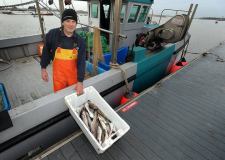
Brightlingsea fisherman Terry Stimpson brings in the days catch aboard his boat Seaglory II.
Swallow, 25, of Charleston Court, West Mersea, faces seven separate charges, spanning from February to October 2011, for exceeding monthly skate and ray quotas and for fishing during closed periods while 19-year-old Craig, of Woodstock, West Mersea, is charged with breaching skate quotas in April last year. Stimpson, 51, of Tudor Green, Clacton, who is thought to be the last remaining fisherman in Brightlingsea, is accused of three counts of breaching cod and skate quotas and one of failing to submit an EU log book and a landing declaration. His offences span from February to May.
Each of the charges carries a maximum fine of £50,000. None of the men entered pleas and the cases were adjourned until April.
James Hartley, the solicitor representing the Marine Maritime Organisation, which is bringing the prosecution, told the court: "Fishing boats are prohibited unless they have a licence. Magistrates have the power to impose conditions on licences and part of that are quotas.
It is alleged that Stimpson exceeded his quota in relation to cod and skate in three months. Mr Hartley claimed: "He has landed 3,007kg of cod in February when his quota only allows 1,000kg."
At the weekend, North East Essex MP Bernard Jenkin called for a radical overhaul in UK fishing policy to protect the industry. He is proposing a trust be set up for local fishermen which would build up a quota to allocate annually to small fishing boats, which he says are in danger of going out of business.
All three men will appear at Colchester's new magistrates court building at St Botolph's Circus on 11th April.
MARINET observes: In a week when Scottish trawlermen were convicted of landing £62.8 million of fish in excess of their quota, but faced a financial penalty of only around £4 million, we now find that small boat fishermen in Essex who receive a paltry share of the UK fishing quota from Defra (it is estimated that small boat fishermen, who represent about 80% of the licensed UK fishing fleet, receive roughly only 5% of the UK's annual fishing quota from Defra) are being prosecuted for the same offence (fishing beyond their quota) in order to simply make ends meet, financially.
Thus we have the absurd situation where small boat fishermen feel compelled to break the law in order to remain financially solvent with the result that the fines threaten to bankrupt them, whilst the big boat fishermen, who have all the fishing gear and the lion's share of the UK quota, break the quota out of sheer greed and receive a fine that is only a mere fraction of their illegal financial gains.
It is clear to MARINET that Common Fisheries Policy (CFP) reform — quotas originate from the CFP — must address the question of the survival of the small boat fisherman. Small boat fishermen fish in a far more ecologically-friendly manner, and yet their quota allocation is so meagre that, like the pauper who is forced to steal to sustain body and soul, they find themselves crossing the line in order to survive.
The reformed CFP must become conservation-based (spending its subsidy on rebuilding fish stocks and employing fishermen to manage the rebuilding of these stocks rather than to fish them), instead of being extraction-based at present (with the CFP granting subsidies to increase the technology and engine power of the big boat fishermen).
Unless these changes are made to the Common Fisheries Policy, fish as a food resource are going to disappear from our seas. In has already happened in the North West Atlantic, off Newfoundland, where the cod fishery which was the largest in the world collapsed in the early 1990s due to over-fishing and is now closed and has not recovered. The same is now happening in the North East Atlantic, with the cod fishery in the North Sea, Irish Sea and North West Scotland now effectively commercially extinct, and the grave danger is that the fate of other fish species are not far behind. Is anyone in the EU and UK corridors of power listening to this message?
Your response SMP/SEA needed — again!
As you all of you will well know, the earlier Draft Unit 3b Kelling to Lowestoft Ness Shoreline Management Plan was rejected by 98.7% of the public who responded to the consultation in 2006. More than 2,400 responses opposed it. Only two of those consulted found the SMP acceptable, whilst there were six others who 'didn't know'. Now, after a few tiny tweaks, they are pushing for acceptance yet again.
This communication was not sent to MARINET but here below is a copy thoughtfully sent to us by one of our group, a very aware coastal councillor.
Although you may feel that you have already covered this ground before and/or that your opposition to the SMP may continue to be ignored, it is important that your views are placed, else a determined supporters lobby could dictate a majority for acceptance.
===================================================
February 2012
Dear Sir / Madam
Subject: Kelling Hard to Lowestoft Ness Shoreline Management Plan, Strategic Environmental Assessment second consultation
Background
In November 2008, the process of finalising the Kelling Hard to Lowestoft Ness SMP (Second review) began, taking account of feedback received in response to the original consultation on the draft plan in 2005. The Government asked us to undertake a Strategic Environmental Assessment. This was completed and we held a public consultation in June 2010. That led to some amendments to the SMP policies. So we have updated the Strategic Environmental Assessment (SEA) report, and now we are required by law to consult again, this time on the revised SEA. In the remainder of this letter we have given you more details of the SMP and the SEA, where you can obtain more information and how you can respond to the consultation.
Purpose of the SMP
The purpose of the SMP is to provide a high level assessment of a length of shoreline to identify the risks to the development, historic and natural environment in a sustainable way. The SMP identifies policies for each section of the coast. These policies include holding the existing line of defences, realigning the defences inland or undertaking no active intervention (i.e. letting nature take its course). While the SMP provides a long term policy framework, it does not exactly identify how we might achieve this. Where the policy is to hold the line or manage the realignment of defences, more detailed studies will be undertaken, such as strategies or to look in more detail at specific aspects of the coast. in the form of a Coastal Strategy Study. These will look at the most appropriate ways in which the policy can be delivered, whether it provides good value for money, assess the impacts on people and the environment etc. They will do this in much more detail than the SMP.
Strategic Environmental Assessment
The Strategic Environmental Assessment, Environmental Report was published along with the final draft SMP in June 2010 for a six week period. Over one hundred consultation responses were received. These responses covered a range of issues including loss of value to houses, a need for protection, dredging, effects of Great Yarmouth Harbour, sediment and drift beaches, loss of heritage, wildlife and consultation including time to respond, publicity and the process. Following receipt of these comments a number of changes have been made to the SMP. As changes have been made to the SMP changes were also made to the SEA to reflect these. There is a statutory requirement to re-consult on the SEA for a second period even though we have not identified any significant impacts as a result of the changes.
Consultation
The documents will be made available on Friday 24th February for a period of seven weeks. Our aim is for as many people as possible who are affected by the issues covered by the SEA to be able to access the information they need. The documents will be made available at the following website www.northnorfolk.org. We are happy to make special arrangements if parish councils, local coastal groups or others wish the documents to be presented in some other way.
A response form is attached to this letter and is also available on the web site.
We hope that you find this information useful.
Yours sincerely,
Nigel Pilkington, AECOM House, 179 Moss Lane, Altrincham, Cheshire WA15 8FH 0161-927 8200
============
Kelling Hard to Lowestoft Ness Shoreline Management Plan Strategic Environmental Assessment (SEA) Consultation Feedback Form
Public Consultation Feedback Form
Public Consultation on the Strategic Environmental Assessment, Environmental Report was undertaken in June 2010 for a six week period. Over one hundred consultation responses were received. These responses covered a range of issues including loss of value to houses, a need for protection, dredging, effects of Great Yarmouth Harbour, sediment and drift beaches, loss of heritage, wildlife and consultation including time to respond, publicity and the process.
Following receipt of these comments a number of changes have been made to the Shoreline Management Plan (SMP). As changes have been made to the SMP, the SEA Environmental Report has also been updated to consider the effect of these changes on the environment. As the SEA Environmental Report has been updated there is now a statutory requirement to re-consult on the SEA for a second time. However the key finding is that no additional significant environmental effects have been identified as a result of the changes to the SMP.
This feedback form has been produced for comment on the SEA Environmental Report.
Contact Details
Name...........................................................................................................................................
Address.......................................................................................................................................
Contact number ........................................................................................................................
Email address ............................................................................................................................
Please return the completed form and any associated information by 9th April 2012 to:
Nigel Pilkington, AECOM, 179 Moss Lane, Altrincham, Cheshire, WA15 8FH
Or email a copy of your response to charlotte.clinton@aecom.com
Thank you.
High Court hears evidence and convicts on massive "fish quota fraud" in Scotland
A total of 17 skippers and a fish processing company have been fined almost £1 million for their part in a £62.8m black fish scam.
The fishermen operated a sophisticated deception, which allowed them to land £47.5m more mackerel and herring in Shetland than they were allowed under European Union quotas.
Judge Lord Turnbull told the men at the High Court in Glasgow yesterday they had been involved in a "cynical and sophisticated" scheme, which was "a deliberate and calculated attempt to evade the quota system".

Victor Buschini and Hamish Slater leaving court. Picture: Neil Hanna
The fine was welcomed by the Crown Office, the Scottish Government and animal protection charity WWF Scotland, which accused the fishermen of threatening "the public good for the benefit of a few".
Grampian Police Detective Superintendent Gordon Gibson, who led the police investigation, said the scale of crime committed by the men was "at a level rarely seen before". He said: "It was apparent during our investigations that these individuals totally disregarded any legislation to prevent this occurring, and as can be seen from the landings made, they amassed huge sums of money through their own greed. Today this caught up with them in a court of law."
Lord Turnbull described the men as normally law-abiding, but added: "The motivation was purely financial. Those who were already making a good living saw this as a way more income could be generated and were prepared to participate in deliberate lies and falsehoods."
The 17 skippers in court were ordered to pay fines totalling £720,000.
Fish processing plant Alexander Buchan Ltd, which no longer operates, had already admitted landing £4.8m black fish at Peterhead over a two-year period.The firm was fined £240,000 by Lord Turnbull, who said the landing of black fish "depended entirely on the willingness of fish processing companies to install systems to disguise the actual landings figures", which he called "the great deception".
A second Peterhead processing plant, Fresh Catch, admitted landing £10.5m of illegal fish on the same day.
A third company, Shetland Catch, has already pleaded guilty to landing £47.5m of black fish.
Fresh Catch and Shetland Catch have still to be sentenced, along with a further six skippers who admitted being involved in the scam.
In court, it was revealed that the true extent of the black fishing in Scotland from 2002 to 2005 was £62.8m, with hundreds of illegal landings at Shetland and Peterhead. Stephen Bellamy, 49, from Fraserburgh, John Smith, 36, and James Smith 54, both from Peterhead, Ernest Simpson, 64, Allan Simpson, 42 both of Fraserburgh, and Oswald McRonald, 63, from Banff, and Fresh Catch Limited admitted landing illegal catches. The offences were committed between 2002 and 2005. They will be sentenced in May.
All 23 fishermen and three fish processing companies were snared during Operation Trawler mounted by the Scottish Fisheries Protection Agency — now known as Marine Scotland — and the police.
Suspicion first fell on Shetland Catch and Fresh Catch when accountants examined their books and discovered that the earnings they were paying tax on far exceeded their declared landings of fish. This led to a full-scale investigation carried out jointly by the Scottish Fisheries Protection Agency and Grampian Police and Northern Constabulary.
Alexander Buchan, based in Peterhead, was also investigated when an extra conveyor belt was discovered. Using this device, up to 70 per cent of a catch could go undeclared. This company, which is no longer trading, has been ordered to pay back £165,000.
Scales at Lerwick-based processing company Shetland Catch Ltd and at Fresh Catch in Peterhead were set to underestimate the weight of the fish being landed by the boats. The true readings were on a computer screen in the loft area of both buildings.
The fines imposed by Lord Turnbull come on top of almost £3m in proceeds of crime which has been confiscated from them. The skippers have also been penalised by having their fishing quotas slashed.
Speaking after the hearings, Lindsey Miller, head of the serious and organised crime division of the Crown Office, said: "Organised crime takes many forms. These individuals may not have been involved in drug dealing or prostitution, but let us make no mistake that they were involved in significant and serious organised criminality. "The legislation is there to protect the marine environment for the good of all and to safeguard the future of the fishing industry. These men disregarded it for their own financial gain and, in a clear example of successful working between the law enforcement agencies involved, have now been brought to justice and made to pay for their crimes." He added that police investigations into other landings were continuing.
Welcoming the fines, fisheries secretary Richard Lochhead described the case as a "shameful reminder" of the culture that once existed in some sectors of Scotland's fishing industry. "These cases demonstrate Scotland's commitment to transparent, sustainable fishing in our waters, backed up with effective enforcement. It is important all countries in Europe do what we have done in Scotland by stamping out such illegal activity. There is no doubt that these illegal activities are a stark and shameful reminder of the culture that existed in some sectors of the fishing industry in past years, but they do not reflect the much improved culture we see today."
Dr Mireille Thom, senior marine policy officer at WWF Scotland, said of the skippers' actions: "Deliberately ignoring quota rules by landing 'black fish' isn't a victim-less offence. Such landings not only undermine the conservation of fish stocks and the fortune of the fleets that fish them, they also distort competition by depressing fish prices. In short, they threaten the public good for the benefit of a few."
MARINET observes: Amongst many disturbing realities brought to light by this case, perhaps the most regrettable and worrisome in terms of fisheries protection is the fact, crime pays.
MARINET notes: "A total of 17 skippers and a fish processing company have been fined almost £1 million for their part in a £62.8m black fish scam." Thus, even when the additional £3 million in proceeds that has been confiscated by the High Court is taken into account, it is clear that the "profit" from this crime still remains only a fraction short of £60 million.
Quotas exist because scientific evidence shows that the stocks are already heavily depleted due to over-fishing. So, in terms of the nation's food supply and in terms of the long-term health of fish stocks, such a crime has enormous consequences. It threatens the nation's food security, and the survival of the fishing industry itself.
Therefore, for the perpetrators of this crime to still retain their vessels, to still retain their licences, and to appear to have made a good profit from their crime really does send the wrong signal to the fishermen who might be similarly tempted, and undermines the efforts and belief of all those people in government, the fishing industry and civil society who are working their hardest at the present time to restore health to our sadly depleted and over-fished fish stocks.
To paraphrase a much quoted maxim: the time has come not just to be hard on crime, but also on the perpetrators of crime. Unless we do, we can reform fisheries management in any way we like, but it will all come to nought if the criminals can commit crimes and still retain their profits.
Let us be clear. If we are to save and secure our fisheries for the future, then punishment must fit the crime — and it must be seen that punishment fits the crime.
46% of Ireland's sewage treatment plants fail the Urban Waste Water Treatment Directive
From 'WaterBriefing' of Thursday 16th February 2012 comes the disappointing news that almost half of Ireland's waste water treatment plants are failing to meet national or EU standards, according to a recent report released by Ireland's Environmental Protection Agency (EPA). The report is the first review of the operation of waste water treatment plants at 529 urban areas since they became subject to a new licensing regime.
The EPA said that 46% of waste water treatment plants did not meet waste water quality standards or EPA guidelines. Eleven large urban areas do not meet the Urban Waste Water Treatment Directive (UWWD) requirement to have secondary treatment in place These include Bray and Ringaskiddy where the provision of treatment is now ten years overdue, Clifden, where the old plant is impacting on bathing water and Moville where discharges are causing serious pollution to the River Bredagh. In addition, eight urban areas do not meet the UWWD requirement to provide nutrient reduction in addition to secondary treatment for discharges to sensitive water areas by specified date given for compliance Areas affected include the cities of Cork, Dublin and Kilkenny.
In 2007, 112 plants did not take the requisite number of samples demanded, although this figure has reduced to 38 in the current report
Gerard O'Leary, Programme Manager, in the EPA's Office of Environmental Enforcement said "This level of performance is poor and needs to improve. In order to meet EU targets further investment in infrastructure is required and we need a step change in the operation and maintenance of these valuable assets."
UK could lead on marine renewables industry
The UK could become a leading exporter of wave and tidal power equipment and expertise if the Government adopts a more visionary approach to developing marine renewables, according to a new report by the Energy and Climate Change Select Committee. The Future of Marine Renewables in the UK argues that with the largest wave and tidal resources in Europe, up to 20% of the UK's electricity could eventually come from this reliable and predictable low-carbon source.
The UK is currently the world leader in the development of wave and tidal energy technologies. Of the eight full-scale prototype devices installed worldwide, seven are in the UK. The MPs attribute this success to a number of factors — an abundant natural resource, a long history of academic research, world-class testing facilities and a strong skills base in other maritime industries.
However, the report identifies a number of potential obstacles that could hinder the development of a marine renewables industry in the UK. Investor confidence, policy certainty, public-private risk sharing, improved grid connections and a workforce with the necessary engineering skills are all crucial if the UK hopes to retain its lead in this industry.
The committee MPs say that while technologies that can harness the power of the sea to generate electricity are still in their infancy, developing a thriving wave and tidal industry could bring economic benefits to the UK. Companies based here could export equipment and components for marine devices to other markets, and also provide specialist skills and expertise, such as offshore surveying. Committee chairman Tim Yeo MP said "Britannia really could rule the waves when it comes to marine renewable energy. We are extremely well placed to lead the world in wave and tidal technologies, which could potentially bring significant benefits in manufacturing and jobs, as well an abundant supply of reliable low-carbon electricity".
First Scottish Commercial Wave Power Array Approved
From 'Waterbriefing' comes the news that consent for the first Scottish shore commercial wave power array that will power more than 1,000 homes, has been approved by Scottish Energy Minister Fergus Ewing with the application granted subject to the implementation of a suitable Environmental Monitoring and Mitigation Plan to ensure suitable measures are taken to protect the environment.
Two new 'Oyster' wave energy converters will be added to the existing device at the European Marine Energy Centre (EMEC) at Billia Croo, Orkney in order to allow operators Aquamarine Power to test the devices as an array. Each of the machines has a capacity of 800 Kilowatts, bringing the total capacity of the array to 2.4MW. They will form the first near shore wave array in Scotland to be connected to the National Grid, and will supply enough electricity to power more than 1,000 homes.
Energy Minster Fergus Ewing said:"Scotland is in the midst of a renewables revolution, and it is innovation and creativity such as that behind the Oyster device which will help us meet our ambitious renewable electricity targets and help us re-industrialise Scotland."
New study suggests the world's fisheries are in an even worse state than feared
The Economist reports, 25th February 2012: "Off Chile's Pacific coastline, between December and February, divers take to the chilly waters in search of a predatory sea-snail, the loco (Concholepas concholepas). Boiled and daubed in mayonnaise, it is a local favourite. Asian gourmets prefer it stir-fried or as sashimi. The snail's popularity rocketed when Chile opened its markets in the late 1970s. This was nearly its undoing: it fetched $15,000 a tonne at export and a snail rush ensued. In 1980 Chilean fishermen landed 25,000 tonnes; by 1989, when the fishery was officially closed, stocks had collapsed. That is a sad and familiar tale. But it has an inspiring sequel.
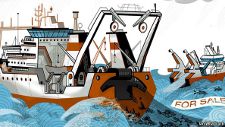
On reopening the fishery, the government changed the rules. Small groups of artisanal fishermen, registered as co-operatives, had exclusive rights to harvest loco and other benthic creatures in a defined area of seabed. They were also encouraged to chase away illegal snail-gatherers. This has been good for man and snail. Chile's 50,000 artisanal fishermen now produce a steady, and lucrative, 2,500-5,000 tonnes of loco a year.
Such hopeful stories are urgently needed, as new research from Chris Costello and Steve Gaines of the University of California, Santa Barbara, indicates. Using an array of catch and fish life-cycle data, they have devised a new statistical method to gauge the health of fish stocks, and applied it to over 7,000 fisheries. Most, probably making up 80% of the global catch, had previously been subject only to sketchier estimates compiled by the UN's Food and Agriculture Organisation, based on official figures.
The new study (under peer review for the journal Science) reckons that those unassessed fisheries are gravely depleted, with on average about half the fishy biomass they need to maintain their maximum annual yield (the usual definition of sustainability). Another analysis, using the same method, of around 1,500 fisheries last year reached similar results. Both suggest the least-known fisheries are the most damaged.
This conflicts with the sunnier analysis of industrial fishing fleets, based largely on expensive studies of a few hundred fisheries, mostly in European and American waters. These are depleted but generally recovering, thanks to recent reforms.
That these turn out to be exceptional cases is unsurprising. The rapacious habits of fishermen and perverse effects of the subsidies some extract from governments are well known. Sometimes overfishing stems from ignorance and sometimes from short-termism, exacerbated by the belief that whatever they don't take, others will. The cost is enormous. Besides harbouring millions of species, fisheries provide the primary source of protein for a billion people and livelihoods for hundreds of millions, most of them poor. The World Bank reckons that benefits (such as income and food) lost by overfishing between 1974 and 2008 amount to $2.2 trillion.
More happily, the new assessment reckons that only 2% of fisheries have so far collapsed — defined as a fall to less than a tenth of the historical biomass. Previous estimates were higher, at up to 30%. Yet incidences of collapse are rising, the researchers stress; and once collapsed, fisheries do not necessarily recover. Shoals of northern cod have not yet returned to the Grand Banks fishery off Newfoundland, which collapsed in 1992.
On 24th February, at a conference in Singapore hosted by The Economist, the World Bank's outgoing head, Robert Zoellick, announced plans for a new assault on the sea's troubles, which also include acidification (a result of climate change) and pollution by human and agricultural waste. The ambitious aims are to raise an additional $1.5 billion for marine management; to rebuild at least half of the fish stocks identified as depleted; to double the number of marine protected areas; and to halve the economic losses in fisheries, partly by scrapping ruinous subsidies.
Above all, fishermen need better incentives to manage stocks properly. This has been tried in several ways. In Iceland and elsewhere they have a tradable share of a scientifically determined quota. Or they can be given long-term rights — akin to property rights — over an expanse of sea, as Chile's loco snailers have.
According to a 2008 study by Messrs Costello, Gaines and others, this approach works: fisheries where such rights are in force are only half as likely to collapse as the average fishery. Yet the spread of such schemes has been woefully slow; only a few hundred mainly rich-world fisheries have adopted them so far. Though sensible in theory, rights-based schemes are hard to get right in practice. Getting locals on board can be difficult and is a slow process at best. If the target species is especially valuable or slow-growing, overfishing (at least in narrow economic terms) is rational. That may make monitoring and enforcement impractically costly.
Rights-based fisheries are not the only answer to overfishing. In particular, a lot more of the sea needs protecting from any fishing at all. Yet there are few better ways to make fishermen control themselves. Chile's predatory snails, and their human predators, will vouchsafe that.
World economy losing $50 billion each year due to over-fishing
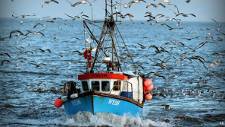
Acidification, warming, the destruction of coral reefs: the biggest problems facing the sea are as vast, deep and seemingly intractable as the oceans themselves. So long as the world fails to cut its emissions of greenhouse gases, cause of the global warming behind these troubles, they will grow. By comparison, overfishing, another great curse, should be easier to put right, especially in the coastal waters where most fishing occurs. And yet it goes on, year after year.
Fishermen have every reason to do something. Many fisheries are hurtling towards collapse; stocks of large fish have been reduced by up to 90%. When stocks are overfished, they yield a smaller catch. The cost of mismanagement, in lost economic output, is huge: some $50 billion a year, according to the World Bank.
One reason why the pillage continues is that knowledge of fish stocks is poor, especially in developing countries. A new statistical attempt at estimating the remaining shoals (see article www.economist.com/node/21548212), from the University of California, Santa Barbara, is therefore welcome — even if that is not true of its findings, that stocks are even more ravaged than previously thought. The study found that better-understood fisheries are likelier to be healthy. Another reason for overfishing is new technology (developed, aptly enough, for battlefields), which makes shoals easier to detect. As large boats and refrigeration have spread, fishing fleets have covered greater distances and hoovered up larger catches. Because technology lets fishermen fish with less effort, it disguises just how fast the stocks are depleting.
Fishermen generally understand the risks of overfishing. Yet still they flout quotas, where they exist. That is often because they take a short-term view of the asset — they would rather cash in now and invest the money in something else. And it is invariably compounded by a commons-despoiling feeling that if they don't plunder, others will.
In most fisheries, the fishermen would make more money by husbanding their resource, and it should be possible to incentivise them to do so. The best way is to give them a defined, long-term right to a share of the fish. In regulated industrial fisheries, as in Iceland, New Zealand and America, this has taken the form of a tradable, individual share of a fishing quota. Developing countries, where law enforcement is weak, seem to do better when a group right over an expanse of water is given to a co-operative or village fleet. The principle is the same: fishermen who feel like owners are more likely to behave as responsible stewards. The new statistical study confirms that rights-based fisheries are generally healthier.
Yet only a few hundred of the oceans' thousands of fisheries are run this way, mainly because such schemes are hard to get right. Limiting access to a common resource creates losers, and therefore discord. Cultural differences affect success rates; not everyone is as law-abiding as Icelanders. Almost everywhere it takes time to convince fishermen, the last hunter-gatherers, to change their habits. But, barnacled by caveats though it may be, the rights-based approach is the best available.
In rich countries, satellite imagery will increasingly help, by making monitoring cheaper and better. In many poor ones, devolution is making it easier to form local organisations. Another promising idea is to incorporate rights-based fisheries with no-catch zones. These safeguard breeding-stocks and are easier to monitor than individual catches. Where stocks are recovering, as a result of these reforms, fishermen are likelier to see scientifically determined quotas as in their self-interest. In the end, that may be the only hope.
MARINET responds to attack from Marine Aggregate Industry
We provide here MARINET's response by Pat Gowen to the severe criticism levelled at MARINET by Martin Drury, British Marine Aggregate Producers Association (BMAPA), concerning the evidence base for the belief that marine aggregate dredging does cause severe damage to the seabed and its marine ecology, and the adjacent coastline and beaches.
Meeting on erosion concern at Pagham and Sidlesham, E.Sussex
Recognising the rising level of local concern, public exhibitions and an opportunity to to discuss the risks arisng from flooding and erosion are being held by the Environment Agency on Monday 27th and Wednesday 28th February at St Ninians United Reform Church in Pagham, and on Thursday 1st March at St. Mary's Church Hall at Sidlesham.
Officers from the EA, Arun District Council, Chichester District Council and Natural England will be available at the events so that residents can ask any questions about their concerns at the flood and coastal erosion risks.
For further information please visit www.environment-agency.gov.uk/paghamharbour or telephone 08708-506 506
Marine reserves need to be "dynamic and mobile" rather than fixed
The idea that only fixed areas of ocean can be designated as no-catch zones is out-dated, and does not reflect the very dynamic behaviour of some ocean creatures, argue scientists at the American Association for the Advancement of Science (AAAS).
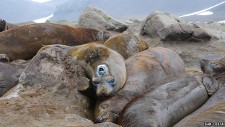
Tags on an elephant seal will record details of temperature, depth and the salinity of the water
The marine experts made their call at the AAAS meeting — a major American science festival in Vancouver, Canada. They say the huge volumes of data from animal tracking studies demand new approaches to conservation in our seas.
"Less than 1% of the ocean is protected at this point, and these marine parks tend to be built around things that sit still like coral reefs and seamounts," explained Prof Larry Crowder from Stanford University. "But tracking studies show that many, many organisms — fish, marine mammals, sea turtles, seabirds and sharks — respond to oceanographic features that don't have a fixed point. These features are fronts and eddies that may move seasonally, from summer to winter, and from year to year based on oceanographic climate changes like El Nino or the Pacific Decadal Oscillation."
The challenge now, argue Crowder and other marine scientists, is to try to build a system of marine reserves that are as dynamic as the creatures they trying to protect.
The spur for this new thinking is the avalanche of data coming from tagging projects. All manner of creatures are being tracked over vast distances, using increasingly sophisticated devices. Many of the innovations that have improved the performance and functionality of mobile phones are being incorporated into the latest generation of tags.
"We can now put multiple sensors in a single tag and when you boost the battery with something like a solar assist panel, you just get this incredible opportunity to view what an animal is doing in multiple dimensions and for long periods of time," said Dr Kristin Hart, a research ecologist with the US Geological Survey, who showed the meeting some of tiniest tags now in operation. Size is important, particularly when you want to answer questions about juveniles or really fast-moving individuals such as tuna — you do not want to encumber the animal with something big and clunky or you will affect its behaviour."
Research has shown how species will respond to upwellings, fronts and eddies in the water, and how creatures will chase the nutrients and the food webs built in these oceanic features. Critically, though, these features may come and go, or shift their position. Future marine reserves will need to reflect this dynamism, says Prof Crowder.
Implementing Marine Protected Areas has proved something of a struggle for conservationists, and some interests may baulk at the idea of reserves being defined by anything other than co-ordinates on a sea chart.
Prof Crowder is convinced the concept he and his peers are proposing is realistic, however. "In addition to knowing where the animals are and how they respond to ocean features, we also know a lot more about where the fishermen are. The fishermen have very precise GPS. So I don't think it's outside the realm of possibility to get fishermen to observe where the edge of a mobile reserve is."
Also, The Guardian reports:
Some of the world's most endangered marine life could be saved from extinction by establishing mobile nature reserves that would protect vulnerable species as they moved around the oceans, scientists say.
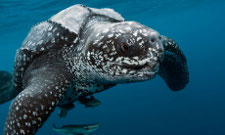
Mobile reserves could provide safe havens for leatherback turtles and other travelling species. Photograph: Michael Patrick O'Neill/Alamy
The initiative could provide safe havens for endangered loggerhead and leatherback turtles, albatrosses, sharks and other travelling species, and sea life that is abandoning its historic territories in response to climate change.
Under the proposals, trawlers would agree to avoid certain stretches of the sea at set times of the year when endangered species are mating, spawning or passing through. Those ocean regions might move with the seasons, ocean currents and long-term environmental events like El Niño, the researchers said.
Mobile marine reserves could bolster existing protected areas that draw an invisible cordon around fixed regions of the oceans, such as coral reefs and sea mounts, where ecological diversity is linked to geographical features. Instead of restricting areas by their location, mobile reserves would identify particular conditions that attract marine life "The stationary reserves do little to protect highly mobile animals, like most of the fish, turtles, sharks and seabirds," said Larry Crowder, science director at the Centre for Ocean Solutions at Stanford University. "We think of protected areas as places that are locked down on a map. But places in oceans are not locked down, they move."
The idea was proposed at the annual meeting of the American Association for the Advancement of Science in Vancouver.
One potential mobile marine reserve could protect the north Pacific convergence zone, a region where two giant currents meet head-on, bringing plankton, small fish, turtles and major predators together. The zone is always teeming with life, but it moves from season to season. "In the summer, it's 1,000 miles [1,800 kilometres] further north than in the winter, so if you were going to protect something there, it makes no sense to protect that latitude, because it moves," said Crowder. Similarly, as the oceans warm, some marine species are shifting their territories to find more comfortable habitats. Marine reserves will be no benefit if they do not track the species as they move, Crowder said.
Hopes of creating mobile marine reserves have been around for more than a decade, but Crowder said that only in recent years has the concept become plausible because of improvements in satellite imaging and GPS tagging of species. With these technologies, marine biologists have learned in great detail the movements of different sea creatures.
Another area of interest to conservationists is known as the white shark café, a patch of water 2,000km off the Californian coast that is teeming with sharks and is probably a mating ground. Environmental changes may see the meeting spot drift in future years, but a mobile reserve would move with them. The new reserves could work in favour of fisheries by opening areas of the ocean that might otherwise be restricted. Modern trawlers are fitted with GPS equipment and could have maps updated each year or season to make clear which areas were off limits to protect vulnerable species.
The initiative would not prevent unlawful fishing, but would help trawlers that were trying to work the oceans without pushing species to the brink of extinction.
"People might say the only way to achieve conservation for some marine life is to protect it everywhere in the ocean. But if we know where they move to, we don't need to close the entire Pacific Ocean, we just need to close this place where they are really concentrated," Crowder said. "The time is right for this idea. We are scientifically primed to do it."
Waves and tides could provide one-fifth of UK's power
A report by the Energy and Climate Change Select Committee of the House of Commons has suggested that energy generated from waves and the movement of tides could supply a fifth of the UK's power.
The MPs said the UK could lead on developing the technology, which would boost manufacturing and jobs and allow Britain to export equipment and skills to other countries looking to make use of marine resources for power. The industry could directly provide 10,000 jobs by the end of the decade and as many as 68,000 by mid-century, when the sector could be worth £76 billion in the UK alone.
The UK is currently the leader on wave and tidal stream power, which are more reliable than some other renewables such as wind, and seven of the eight prototype devices installed around the world are in British waters. But the report from the MPs warned that an "overly cautious approach may allow other countries to steal the UK's lead", highlighting that the UK was once a leader in wind turbines but failed to establish a domestic manufacturing industry."
They urged the Government to simplify funding for supporting development of the marine renewable technologies. And while the proposed increase in subsidies for electricity from wave and tidal stream power would encourage investors, there was a lack of certainty about what would happen after 2017 when the current subsidy regime finishes.
Responding to the report, Friends of the Earth energy campaigner Paul Steedman said: "The right support for this pioneering industry would create tens of thousands of new jobs and provide a home-grown source of clean energy. The Government must make it easier for marine power developers to transform our broken energy system and shift us off our dangerous reliance on coal and gas."
The Renewable Energy Association's head of marine, Dr Stephanie Merry, said: "We are particularly keen to see the Government avoid repeating the mistakes it made with wind in the 1980s, when it missed out on the chance to seize a huge manufacturing opportunity which eventually went to Denmark."
A spokesman for the Department of Energy and Climate Change said: "We are fully committed to spurring on the growth of this industry and have already taken great strides to make this happen. Last month Climate Change Minister Greg Barker launched the South West Marine Energy Park and there are plans to create similar parks in Scotland and Northern Ireland."
Also, BBC News reports:
The Energy and Climate Change Committee says the UK had in the past lost its early lead on wind power through lack of support, and must not make the same mistake again on marine energy. Its report recommends increasing funding and improving links between UK and Scottish programmes. The Carbon Trust recently said marine power could create 10,000 jobs by 2020. By 2050, it said, the global market could be worth £340bn, with the UK claiming about one-fifth of the business. And with the UK possessing seven out of the eight large-scale prototypes deployed anywhere in the world, it was well-placed to lead the global race, the MPs said.
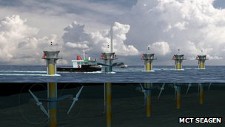
Artist's impression of proposed Skerries Tidal Stream Array Scheme off Anglesey"
"In the 1980s the UK squandered the lead it had in wind power development, and now Denmark has a large share of the worldwide market in turbine manufacturing," said Tim Yeo MP, the committee's chairman. It should be a priority for the government to ensure that the UK remains at the cutting edge of developments in this technology and does not allow our lead to slip."
The Committee's report, The Future of Marine Renewables in the UK, included an examination of tidal stream generators, where devices such as big rotors are turned by the incoming and outgoing tides, but excluded barrage technologies such as the mooted Severn Barrage, which tend to be much more expensive and can cause big ecological problems. It has been estimated that wave and tidal technologies could supply about one-fifth of the UK's current electricity demand, and many other nations are becoming interested, in particular the Nordic countries, South Korea and China. But currently they are expensive — about five times the price of onshore wind, for example.
As with other new technologies, the government expects costs to fall dramatically once devices and installation become standardised. But there is little chance of marine power making a major contribution by 2020.
The government recently reduced its estimate of the 2020 contribution from 1-2 gigawatts (GW) to 200-300 MW, and the committee says that should be looked at again, as several industry experts have said the new target can be met easily. The size of the UK funding pot for marine renewables, at £20m, should also be re-examined, they say. And deployment of that money should be co-ordinated better with the Scottish government, which has a separate £18m budget. The level of subsidy companies receive up to 2017 is secure, the MPs say — but longer-term clarity is needed in order to give investors confidence.
David Clarke, chief executive of the Energy Technologies Institute, a government-industry collaboration, said time was of the essence.
"The marine renewables industry must demonstrate its ability to be cost-competitive, compared with other low-carbon technologies, in the next 5-8 years if it is to engage commercial investors," he said. "If it doesn't, other technologies will be built as alternatives; investors will feel more assurance in them and see more opportunity for return."
With projects such as Marine Current Turbines' tidal generator in Strangford Lough showing the technologies can work with no discernible impact on local ecology, the next step will be to build arrays of several connected devices; but each array would cost around £40-50m, the committee heard, meaning current levels of support could be inadequate. Another recommendation from the committee is that with many of the best sites in remote locations around northern and western Scotland and in the Orkneys and Shetlands, finance for grid connection needs ramping up.
Environment groups who have long bemoaned the slow pace of development on wave and tidal power endorsed the committee's recommendations. "This report is a great reminder of the massive potential of marine renewables in the UK," said Nick Molho, head of energy policy at WWF-UK. "Investment certainty holds the key to reducing the costs of marine renewable and creating jobs; the government would be mad to miss this boat."
A spokeswoman for the Department of Energy and Climate Change said the government welcomed the report and was studying its recommendations. "We are fully committed to spurring on the growth of this industry and have already taken great strides to make this happen," she said.
European Parliament wants tighter controls on pollution from marine fuels
Environment Committee MEPs want to see the EU apply stringent new limits on the sulphur content of marine fuels more widely and to a broader range of ships than the European Commission proposed last year.
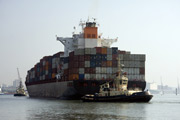
Voting on Finnish Green MEP Satu Hassi's draft report, the Committee backed the Commission's plans to lower sulphur limits for fuels used in designated sulphur emission control areas (SECAs) from 1.5% to 0.1% in 2015. This will bring the EU in line with International Maritime Organisation (IMO) rules on SECAs.
The Committee also wants the commission to consider setting up new SECAs beyond the existing ones in the English Channel, North and Baltic Seas.
The Commission suggested the 0.1% limit should also be applied to passenger ships from 2020 but the Committee went further backing an extension to all ships by 2020, with an interim 0.5% limit for 2015, and to any ship operating within 12 nautical miles of a member state's coast from 2015.
However, Ms Hassi's recommendation that the 0.1% limit apply to passenger ships from 2015 was dropped. The Committee also rejected an amendment from the Greens calling for more action to tackle particulate and NO2 emissions from berthed ships — especially from cruise ships, which use more electricity than cargo vessels.
NGOs were also disappointed to see an amendment dropped requiring a minimum number of inspections or the installation of equipment to monitor emissions. "The Parliament just missed an opportunity to control the actual implementation of standards by national authorities in a more systematic way and at low cost," said Louise Duprez of green group EEB.
The full Parliament is due to vote on the resolution in May. Member states will also need to approve the rules but are yet to discuss the issue; national experts will do this before the end of February. No date has been set so far for minister-level discussions.
European shipping associations support a reduction in emissions but already have concerns about the Commission's proposal. They said the Parliament's 2015 deadline was unrealistic.
Illegal trawler fined record £8,000
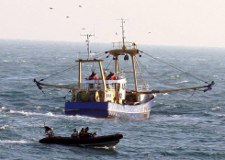
HMS Mersey's boarding team approaching Dutch fishing vessel 'FV Elizabeth. PICTURE: Crown Copyright/MOD 2012
A Dutch fishing vessel, the FV Elizabeth, was fined a record on the spot £8,000 when found by the Royal Navy patrol ship HMS Mersey to be trawling with undersized nets off the Norfolk coast.
The Royal Navy patrol ship HMS Mersey, one of three ships from the Navy's Fishery Protection Squadron, was on routine duties when she spotted the Elizabeth sailing 74km off the county's shoreline, and decided to send over a boarding party headed by Marine Enforcement Officer Midshipman Phill Fordham. On inspection the team found that the two cod ends, that section of the net that catches and holds the fish, were significantly undersized.
Coastline fund to alleviate nuclear store impact
Project launched to help offset impact to Sizewell and Blyth estuary coastline
EDF, the Energy's Amenity and Accessibility Fund (AAF) managed by Suffolk Coastal District Council and Suffolk County Council in consultation with the Suffolk Coast and Heaths AONB Unit are seeking ideas to help offset to offset and alleviate the impact created on the surrounding Suffolk Coast and Heaths Area of Outstanding Natural Beauty (AONB) by the new dry fuel store at Sizewell B nuclear power station, near Southwold. The dry fuel store was given the go-ahead in July last year. It will house spent nuclear fuel from 2015.
An initial £120,000 is being paid into the fund by EDF Energy with further payments of £20,000 made each year. The AAF is a rolling programme with an annual deadline of March. Successful projects will be selected by the funding panel who will meet once a year. Anyone can apply for funding including charities, businesses and individuals, but projects suggested must take place within the locality of the Sizewell B site from the Deben estuary in the south to the Blyth estuary in the north.
MARINET offers an excellent suggestion, that is to carefully note the history of nuclear power as evidenced by Winscale, Three Mile Island, Chernobyl and Fukushima, to study the findings of the health of those close to such establishments, and learn from this so to abort the project altogether
To view the full fund guidelines and download an application form visit www.suffolkcoastandheaths.org
Consultation on plans for one of the world's largest wind farms off Suffolk coast
Following extensive technological and environmental surveys for a Preliminary Environmental Information Report (PEIR) East Anglia Offshore Wind (EAOW), the company behind the massive wind power scheme off the coast of East Anglia is about to unveil the first details of its plans, including the route of cabling to connect the development to the national power network.
The joint project by Scottish Renewables and Swedish group Vattenfall involves an area around 25 miles off the coast of Suffolk and represents the first of six phases of development in the Southern North Sea region, details the routing of offshore cables, landfall points, the preferred location of an onshore converter station and the underground onshore cabling.
When completed it will have the potential to deliver 7,200 megawatts of power, equal to the needs of five million households, with phase one alone accounting for 1,200MW.
Copies of the PEIR will be available for inspection from 10th February until 30th March at the main county library in Ipswich and at the libraries in Felixstowe, Woodbridge, Hadleigh, Lowestoft and Great Yarmouth.
Coalition appeals against dredging permit for Coos Bay
American West Coast oppose dredging
From Dredging News Online of 8th February 2012 comes the news that a coalition of local residents, grass roots environmental and clean-energy groups has filed an appeal against the Oregon (USA) Department of State Lands' decision to issue a dredging permit for the Port of Coos Bay, which if granted, would allow the Port to export dirty coal and liquefied natural gas (LNG).
It tells that while the 'multi-purpose' dredging permit was initially sought to develop an LNG import terminal, the Port of Coos Bay recently entered into a confidential agreement with an undisclosed coal export company seeking to export coal overseas annually, and that LNG backers have changed their plans to export domestic gas instead. The permit would authorize the single largest dredging project in an estuary the state has ever approved, and would facilitate massive LNG, coal tanker and heavy ship traffic that could interfere with recreational boating and fishing in the region. Coalition members appealed the dredging permit in part due to concerns about the harmful impacts on Coos Bay waterways that serve as salmon and oyster habitat that in turn support commercial and recreational fisheries.
Coos Waterkeeper, Friends of Living Oregon Waters, the Sierra Club, Greenpeace, and Climate Solutions are represented by Earthjustice attorneys Jan Hasselman and Janette Brimmer and local counsel Karl Anuta. Jan Hasselman, handling the appeal, said "The people of Coos Bay, not international mining corporations, should decide the future of this community. The port should stop conducting this business behind closed doors and start levelling with the public. Shovelling American rocks onto China-bound boats is not an economic development strategy. Oregon's future lies in preserving our unique natural resources, not exporting them across the world, threatening public health, and destroying resources in our estuary for the benefit of foreign corporations."
David Petrie, Confederated Tribes of the Coos, Lower Umpqua and Siuslaw tribal member and Coos Waterkeeper said "Oregon's future lies in preserving our unique natural resources, not exporting them across the world, threatening public health, and destroying resources in our estuary for the benefit of foreign corporations. This destructive project is unnecessary and damaging to the surrounding community. Industries that depend on the health of the estuary and marine life, such as oyster farms and salmon fisheries would be adversely impacted. We can do better for our community and the environment."
Oregonians are concerned about potential economic and public health consequences of allowing coal and liquefied natural gas exports at the Port of Coos Bay. Mile-long, open-top coal trains could pass through communities in the Portland area, Eugene, the Columbia Gorge and along the coast, exposing families to toxic coal dust and increasing the risk of respiratory illness. The proposed Pacific Connector LNG pipeline would run across 234 miles of the state, elevating the risk for gas spills, pipeline explosions, and other accidents. Exporting LNG could also result in significant increases in energy prices for Oregon families and businesses.
Local residents, community leaders and environmental groups are also alarmed by the lack of transparency from the State and Port of Coos Bay regarding potential coal exports. Public records requests filed by concerned parties have been met by unclear answers from the Port. In June 2011, Oregon Governor John Kitzhaber commented on the concerns with development fossil fuel export terminals, saying that coal export development in Oregon "should not happen in the dead of night. We must have an open, vigorous public debate before any projects move forward."
Gower Offshore Dredging opposed
Welsh opposition to dredging
From Sand and Gravel News of 16th January 2012, listed under Dredging News on Line comes the report that South Wales West Assembly Member (AM) Byron Davies intended to fight the 'Resource Management Association' syndicate's application to remove up to 27 million tonnes of sand from off the Gower coast.
He is opposing the application made to the Welsh Assembly by the consortium to take up to 1 million tonnes of sand per year for 15 years from an area approximately 10km south west of Worm's Head for use by the construction industry.
He states: "Dredging operations in the past have affected sand levels on beaches in Gower, which relies on tourism for jobs. It is the Welsh Government which will be making this decision, not the UK government in London, so residents opposing the plan should put pressure on their AMs to get it turned down. The Bristol Channel has given more than its fair share of materials for the aggregates industry. They (the dredging companies) must look elsewhere otherwise irreparable damage will be done to our marine environment in South Wales"
A further report in the South Wales Evening Post of Saturday, 14th January 2012 entitled Battle vow over Gower dredging. Even more detail can be seen on the Byron Davies' AM's website where he writes "Gower's beaches have already been affected by dredging, as have beaches along the whole of Swansea Bay and the Bristol Channel. Sand has leached away off our beaches into the big holes in the channel created by dredging. Some beaches have lost considerable quantities of sand. Places like Gower rely on tourism for their livelihood. Seaside resorts with no sand don't have much future."
He adds: "Gower is a designated Area of Outstanding Natural Beauty which we must fight hard to protect" and further urges that "residents opposing the plan should put pressure on their AM's to get it turned down."
"There are plenty more fish in the sea" — is this true?
Geoffrey Lean, Environment editor for The Telegraph, writes 10th February 2012:
"Mike Park was 21 when he skippered his first fishing boat. Back then, in the early 1980s, he recalls, Scottish fishermen landed 120,000 tons of cod a year. Now the catch has slumped to just 15,000 tons. So far, so familiar: the world's oceans are full of collapsed, over-exploited fisheries. But Park — now chief executive of the Scottish White Fish Producers Association, the largest fishermen's body in Europe — is heading a remarkable rescue bid that has doubled the number of cod in the country's waters in just six years. "We crashed the stocks," he says. "Now we are rebuilding them."
Half a world away, Paulo Kolikata has an even happier tale to tell. Twenty years ago fishermen in Kubulau, Fiji, were also dealing with a declining resource. They set up reserves where exploitation was banned and where stocks of fish quickly increased and spread into open waters. "Before, we would spend all day fishing," says Kolikata. "But now we can fish for two to three hours and catch the same amount." Better still, tourists now pay to dive in the reserves; the income has so far sent 130 young people from this remote area to university.
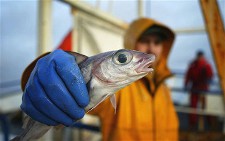
Scottish trawlermen on board the Carina haul in their catch of Haddock. Photo: GETTY
These are among 50 stories cited by the Prince of Wales's latest campaign. Launched almost unnoticed (except by The Daily Telegraph), it aims — like so many before it — to save the world's rapidly diminishing fisheries. But, unlike others, it focuses on the positive, showing what fishermen are already doing to turn things round, and demonstrating that — in his words — managing fisheries sustainably is "actually more profitable than perennially succumbing to the temptation of maximising short term income".
Not that, as he says, the present "mismanagement of our oceans" is anything other than alarming. Eighty five per cent of the world's fisheries, a report by his International Sustainability Unit concludes, are either a over-exploited or at the very limit of what they can take. Catches from the world's seas multiplied fivefold after the Second World War, peaking at around 93 million tons in 1997, before steadily declining.
A paper by leading experts, published in Science, forecast that if present trends were to continue, every commercial fishery worldwide could be obliterated by 2050. Yet a billion people depend on them for their main source of protein.
Governments subsidise the destruction to the tune of some £13 billion a year and blithely permit over-exploitation. Another report, published yesterday by the New Economics Foundation, shows that more than two thirds of the fishing quotas set by EU ministers since 1987 have exceeded official scientific advice. About a quarter of the marine harvest is taken illegally. And almost one in every 10 fish caught is chucked back dead or dying, as "discards".
But, as the Prince's report shows, fishermen themselves are beginning to pioneer change. Mike Park's drive to revive cod fisheries — for which he received an international award last year — persuades a reduced number of boats to concentrate on less vulnerable species such as hake and haddock, permitting them to spend more days at sea if they catch few cod. It is, he says, "a way of incentivising the industry, not punishing it".
Ninety per cent of the trawlers operating out of Brixham, Devon, now use modified nets which allow smaller fish to escape, slashing discards by half and cutting fuel costs by a fifth because they reduce drag in the water. Setting up reserves around the Isle of Man has so boosted previously declining stocks of queen scallops that, according to local fisherman Frankie Horne, "we have never seen as many queenies in the sea". And conservation measures have almost doubled the number of North Sea herring in just two years.
Establishing reserves has trebled catches from Dauin in the Philippines in a decade and increased eighty-fold the area's income from tourism and fishing. Illegal catching of Patagonian and Antarctic toothfish has been cut by 97 per cent. Regulating a race for crabs in the Bering Sea, which caused people to overload their boats, has cut a five to seven-person annual death rate to one in five years, while increasing wages fourfold. And setting up co-operatives with rights to fish clams in Vietnam has quintupled incomes and increased the number of benefiting households from 9,000 to 13,000 in four years.
In all, says the World Bank, managing the world's fisheries sustainably could increase production by $50 billion a year. But obviously there is an enormously long way to go; these are merely a few bright spots in the gloom. But, as the Prince says, they show that decline is not inevitable and that there are "many possibilities for gaining more value from a resource, if only we manage it well".
Floods and Coastal Erosion
DEFRA's report 'Floods and Coastal Erosion' under the section 'Focus on Erosion of Coastal Areas' gives that around 3000 km (17%) of the UK coast is currently eroding, and that climate change could lead to a 100% to 400% increase in the current erosion rate. There is no mention of the contribution given by offshore aggregate dredging in their report.
It states that agricultural land lost due to coastal erosion will be between around 6500 ha and 10,000 ha by the 2080's (0.06-0.09% of total agricultural land area in England and Wales). The loss of priority biodiversity habitat (Habitat designated under the Biodiversity Action Plan) in England due to coastal erosion is given as between 140 ha and 280 ha by the 2050s, rising to between 290 ha and 540 ha by the 2080's.
This loss, while still affecting only a very small proportion of the UK's total land area, could have significant local implications for communities and habitats.
Rebuilding EU fish stocks would generate £2.7 billion and 100,000 jobs
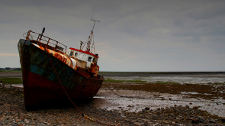
New research published by the News Economics Foundation (nef) reveals the huge loss of jobs and profits due to overfishing of EU stocks.
Research published by nef finds that poor management of fish stocks is draining jobs and profits. The report Jobs Lost at Sea estimates the benefits of rebuilding 43 European stocks (out of more than 150) and finds that:
- Restoring these 43 stocks to their maximum sustainable yield (MSY) would generate 3.53 million tonnes of additional landings; enough to meet the annual demand of fish for almost 160 million EU citizens.
- Value of restoring fish stocks is worth £2.7 billion (€3.2 bn) per year to all countries. It is worth £1.5 billion (€1.8 bn) per year to the EU27, or almost three times its annual fishing subsidies.
- Value of restoring these fish stocks could support 100,790 new jobs, around 83,000 to the EU27 (31% more than current employment in the EU fishing sector)
- Restoring fish stocks could increase catch values from these stocks by 81% for the EU27, and more than double for most countries, including the UK (+109%) and Germany (+116%).
- Worst affected fish are cod (lost 970,000 tonnes/yr), haddock (lost 378,000 tonnes/yr), herring (lost 854,000 tonnes/yr) and whiting (lost 834,000 tonnes/yr).
Overfishing means the EU is getting much less out of its fish stocks than if they were restored and sustainably managed. nef has analysed the difference between the current size of catches compared with their potential ('maximum sustainable yield') to highlight the scale of the overfishing that has hijacked revenues and employment.
Author of the report, Rupert Crilly, Environmental Economics researcher at nef/OCEAN2012, said:
"Overfishing is bad for the economy. With the stroke of a pen, European fisheries ministers are wiping out millions of pounds and thousands of jobs each year by allowing overfishing to continue.
"A third of the UK population's annual fish consumption could be provided by just the UK's share of restoring these fish stocks. The industry could employ an extra 46 per cent more people. Over £400 million could be invested in coastal communities every year, 24 times the annual subsidy the UK receives precisely to mitigate the costs of overfishing.
"Restoring fish stocks is within politicians' power. And in the current economic climate the stakes are higher than ever."
Most fish in the sea evolved on land
Family histories don't come much more bizarre. Three-quarters of the fish in the sea can trace their origins back to a freshwater ancestor. The finding highlights how important rivers and lakes are as a source of new species, just as that supply is under threat from disappearing freshwater habitats.
Fish first evolved in the sea. The oceans have been teeming with them for almost half a billion years, so there is no reason to doubt that the fish living there today did all their evolving in salt water — until you take a closer look at their family tree.
All the fossils belonging to the ancestral group that gave rise to ray-fins some 300 million years ago, which comprise 96 per cent of all freshwater and marine fish species on the planet, came from freshwater deposits. In fact, according their evolutionary tree, the ray-fins may not have taken to the sea in large numbers until about 170 million years ago. Their descendants now make up three-quarters of all marine fish.
The threat of Microplastics
Mark Kinver, environment reporter for BBC News, told on 27th January 2012 how the accumulating threat from 'microplastics', the plastic debris from washing clothes emanating from sewage outfalls, is accumulating in the marine environment and that it could be causing huge problems world-wide by entering the food chain. This can be read on the BBC website.
The full story is in 'Environmental Science and Technology'. It tells how once the plastic in the form of polyester, acrylic and polyamides (nylon) mainly smaller than 1mm had been eaten, it transferred from the animals stomachs to their circulation system and accumulated in their cells. The team took samples from 18 beaches around the globe, including the UK, India and Singapore, and found that there was not a single sample from around the world that did not contain pieces of microplastic. The data also showed that the concentration of of these was greatest in areas near large urban centres.
In order to test the idea that sewerage discharges were assuredly the source of the plastic discharges, the team worked with a local authority in New South Wales, Australia, and found exactly the same proportion of plastics from source, then going on to carry out a number of experiments to see what fibres were contained in the water discharge from washing machines. They found that some polyester garments released more than 1,900 fibres per garment, per wash.
Marram replanting Protection
The article 'Marram grass grown at North Burlingham is heading north to Tyneside dune' by Chris Hill, rural Affairs correspondent appeared in the Eastern Daily Press of Wednesday, 8th February, 2012
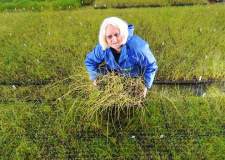
Linda Laxton of British Wild Flower Plants at North Burlingham with some of the thousands of Marram and lime grass plants she has grown for a project on Tyneside. Photo by Simon Finlay
It tells how 268,000 Marram and Lyme plants have been cultivated in Norfolk to be replanted at Tyneside's Sandhaven beach to stabilise the sand dunes for South Tyneside Council
Marram was first brought to Norfolk by the Dutch long ago. It is an amazing plant that grows up to over one metre high, seemingly without any nutrient whatsoever. It is saline tolerant and has roots going down well over one metre too, thriving in pure sand even under severe drought conditions. But it has a trick up its sleeve inasmuch as the moist air coming from the sea at night condenses on the fronds to run down the plant stems to feed the roots. What's more, when the dry beach sand is blown inland, the fronds will slow it down and capture it, so steadily building up a major dune system. (See how to build your own marram dunes at 'DIY Dune System' by going to www.marinet.org.uk/coastaldefences/diydunesystem.html.)
But although Marram Grass is tough, it can be destroyed by people pressure in that walking over the plants even a few times will flatten the fronds and so stop its water supply. Furthermore trampling over the plants crushes the root system. And that's the reason that chestnut fencing is employed for protection of most of Europe's beach, but few in the UK.
Such planting would make an excellent group project or an undertaking for those miscreants placed on an ASBO, giving them a few days at the seaside on a community project of great value by so maintaining our denuding seaside resorts. Such was attempted by Pat Gowen, but the cost of insurance and transport ruled it out.
Canadian campaigner against salmon farming is sued and taken to court by Norwegian company
If money talks, then the geyser of financial support that has sprung in the past few days for salmon activist Don Staniford's legal defence speaks volumes. Staniford — who has been described by aquaculture trade media as salmon farming's "public enemy number one" — is being sued by the world's second largest farmed salmon producer, Oslo-based Cermaq (operating as Mainstream in Canada), for defamation. The trial, expected to run 20 days, is being held at the British C Supreme Court in Vancouver, Canada.

Don Staniford
The company, whose biggest shareholder is the Norwegian Government, may have been banking on Staniford submitting to its demands out of court due to a lack of funds to pursue the case — but any chance of that happening disappeared over the past weekend when the activist raised over $20,000 in public donations for his legal battle.
Staniford has been building his case, giving depositions and collecting evidence over the last several months but only went to the public for funding this past Friday, when he launched a page on the community fundraising site gofundme.com. Since then, as of this printing, over $11,000 have tumbled in — in contributions that range from $10-500 a pop, most of them being in the $30-50 region. The goal of the gofundme.com campaign is to raise $50,000 in total.
On top of those online donations, a Norwegian fishing group, The Wild Salmon Warriors of Norway, announced this morning it was kicking in 60,000 Norwegian Krone ($10,000 CAD) of its own. As the former director of the global Pure Salmon Campaign, Staniford frequently travelled the world of the aquaculture industry, drawing together an international alliance of over 30 groups and coalitions battling the industry in Norway, Scotland, Ireland, Iceland, Chile, the United States and Canada. (Full disclosure: I've worked with Staniford on the Pure Salmon campaign — including my film "Farmed Salmon Exposed" and other initiatives over the years).
Staniford has already received $20,000 in legal funding from West Coast Environmental Law — directed toward his lawyer David Sutherland, an expert in defamation law. The injection of up to another $60,000 would be an enormous boon to Stanford's case, which revolves around a recent campaign of his targeting the open net pen salmon farming industry.
The campaign employs a series of graphical representations resembling a cigarette package — emblazoned with messages similar to surgeon general's warnings, such as "Salmon Farming Kills" — to highlight problems with the industry. Cermaq's defence is based on the notion that statements like these, coupled with the cigarette iconography, give the impression that farmed salmon is hazardous to human health. Staniford's counsel will likely counter that the implication is salmon farms kill things like seals and sea lions (often shot by salmon farmers to prevent predation of their stocks) and wild salmon, through the incubation and transference of sea lice and diseases by farmed to wild fish. Moreover, it will make the case that the analogy to the tobacco industry derives from comparable approaches to denying science that is critical of industry.
According to the Canadian Press, "The company's trial brief states it's seeking $100,000 in general damages, $25,000 in punitive damages and a permanent injunction to stop Staniford from writing, printing or broadcasting defamatory words against Mainstream." (emphasis added) It's that last piece — the concept of a lifetime ban from speaking out against the company — that has Staniford determined to fight. In a recent Victoria Times-Colonist story on the case, Staniford told reporter Sean Sullivan, "This is about justice for wild salmon and freedom of speech."
Clearly, this David-and-Goliath battle has captured the public's attention, as the dollars roll in to support Staniford's case. But it's Cermaq that sees itself, ironically, as the David in this battle. According to CP, spokesperson for Cermaq subsidiary Mainstream Canada — the second largest fish farm operator in BC — "[Laurie] Jensen said the company is playing the role of David. 'I think we're on the righteous end of things in that we have to defend ourselves,' she said. 'If we don't, we do a disservice to our communities, our partners, our employees.'"
For his part, Staniford appears ready for the duel. Further emboldened by this outpouring of public support, he claims, "I am going to fight until the bitter end and win."
Mexican Marine Reserve reveals how a Degraded Fishery can recover
The Cabo Pulmo National Park in Mexico's Gulf of California imposed a ban on fishing and other extractive activities 15 years ago, and since then, the total mass of its residents has increased five times the amount, a new study has revealed.
According to the study, which was conducted by researchers at the Scripps Institution of Oceanography at UC San Diego from 1999 to 2009, the total number of fish in the reserve ecosystem increased over 460 percent with 10 years. Researchers published the findings of the study in the Public Library of Science journal.
It was in 1995 that the Cabo Pulmo National Park was protected to preserve the largest coral community in the Gulf of California. After four years, when researchers checked the marine park, they didn't find so many fishes, except of a few medium-sized ones.
In 2009, researchers again dived into the water of Cabo Pulmo again to monitor the fish population, and were surprised to see that fish biomass at the park increased to 463 percent and the biomass of top predators and carnivores increased by 11 and 4 times, respectively.
Researchers found thousands of large fish, such as snappers, groupers, trevally, manta rays, and even sharks. However, fish biomass in other marine protected areas or open access areas did not change significantly over the same time period.
"The most striking result is that full, complete recovery of a degraded fish community is possible (when placed in the right area and governed correctly), even to the level that is comparable to remote habitats that never have been impacted by fishing and other local human impacts," researchers stated in the journal.
The increase in fish biomass at Cabo Pulmo within a decade is the largest measured in a marine reserve worldwide. It has also resulted in significant economic benefits, indicating that community-managed marine reserves are a feasible solution to untenable coastal development and fisheries collapse in the Gulf of California and elsewhere.
The alliance against Blakeney Salt Marshes MCZ gains new voices
North Norfolk MP Norman Lamb will lead a delegation to Westminster to explain community concerns over a restrictive conservation regime to environment minister Richard Benyon.
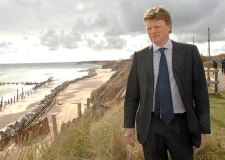
Defra minister Richard Benyon during a visit to Happisburgh
Natural England's controversial proposals to create a Marine Conservation Zone (MCZ) to preserve the wildlife and habitats across Blakeney salt marshes have been staunchly opposed by many residents and coastal visitors. They fear the proposals, which include no-go Reference Areas (RAs) where human activity could be banned or severely curtailed, could interfere with traditional uses of Blakeney marshes and harbour.
Natural England said RAs would be very small, highly-protected sites set aside for marine life to recover "unimpacted by human activities," which opponents say could limit sailing, walking, samphire picking, bait digging, shooting and fishing.
Mr Lamb said he was pleased to have been given the opportunity to put those concerns to Defra minister Mr Benyon at the meeting in London, which is due to take place on 7th March. "These proposals have attracted an astonishing level of public opposition," he said. "More than a hundred people have written to me criticising the proposals, which are also being opposed by Blakeney Parish Council and the National Trust. I am glad that we will now have a chance to make our arguments directly to the minister, and I hope that common sense will finally prevail."
Marie Strong, a county councillor for Wells, said the "considerable concern" she had heard from parish councils and residents included doubts over the research behind the proposals. "Flawed or not it is more than apparent that the key stakeholders for this area were not consulted. It is suggested that concerned parties wait until the public consultation takes place later this year. Waiting will only give rise to greater frustration and will I believe cause embarrassment to all concerned."
In a recent letter to the minister, the National Trust claimed the proposed MCZ is "compromising the good name of nature conservation on the Norfolk Coast."
Mr Benyon, the minister responsible for coastal access and conservation announced, in November that "there are a number of gaps and limitations in the scientific evidence base supporting the MCZ recommendations".
Saving Overstrand from the SMP dictate

Overstrand Beach, cliff and sea defences
Overstrand is yet another North Norfolk cliff top village facing disaster by being left to the mercy of the sea under current Shoreline Management Plan (SMP) policies that propose to abandon the sea defences and let the erosion of the shoreline and undermining of the sand cliff and cliff top continue unabated.
But the villagers have come up with an idea by which they may be able to save their community by introducing a voluntary tourism donation scheme, the proceeds of which could be used to help shore up the village sea defences and protect its attractions.
Visitors and tourists would be invited to contribute to the protection and continuity of the attractive village and landscape they have come to visit and enjoy to prevent it from slipping off the map. Among the ideas being discussed by the parish council's shoreline management committee is to introduce a 'tip' on restaurant bills asking diners to put down extra cash and by getting local businesses on board to contribute toward the defence fund.
Dredging Licence deadlines extended
Many 'stakeholders' who have opposed the continuing dredging of aggregate from off our coastline may already have received the document(s) attached direct from AODA/BMAPA. But many may not have done so, so would need to read about the latest move and hopefully react accordingly. To MARINET this smacks of a rather cosy relationship requiring united opposition.
The latest issue is that recent changes have been made in respect of those 15 year duration dredging licences allowing extraction from the seabed offshore to the Great Yarmouth area and the Humber inasmuch as they terminate in 2012, after which further extraction would be illegal. Such closure of supply would undoubtedly bring about a major financial impact to the considerable profits of the dredging companies, the Crown Estate and the Treasury, as it is unlikely that the new licences aplied for in this area now being planned will be ready in time, possibly not until 2015.
Thus, the dredging industry, without consultation with the stakeholders or for recognising the need of further EIAs (Environmental Impact Assessments) have had private discussions with the Marine and Fisheries Agency (MFA) to overcome the production gap that would come about when the current dredging has to stop until the new licences are issued. (From past experience there is little doubt but that they will be issued, as it will be most unlikely that the Marine and Coastal Access Act (MCCA) MFA recognition will heed the need for anything other than the conditionsalready given by the Environmental Impact Assessments (EIA's) supplied by those employed by the dredgers themselves, which ignore the research proving the damage of the activity).
Further, the points of issue raised in our MARINET meeting with EMU (the AODA consultants) that jointly established the vital need of meaningful tests and realistic Environmental Impact Assessments to be employed before a licence to dredge was issued have finally been shunned by the dredgers. After over a year of awaiting a response, hopefully an agreement, AODA finally indicated that they would continue as before without implementing or taking into consideration any of our needs, or positively answering any of our questions. Our points and questions put to AODA through EMU included the following:
- How is it that only the partisan claims of those selected by, appointed by and paid by the dredging companies themselves are considered when a dredging licence is sought, whilst the copious reports from non-aligned international expert bodies evidencing and recognising the erosive impact remain ignored.
- Why is no second opinion permitted when considering granting licences for offshore aggregate dredging when the view of the body selected by the dredging company conflicts with wider and well established independent findings?
- Why do the Environmental Impact Assessments continue to employ data based upon computerised outputs made using inputs of models created from speculative and assumed data rather than actual empirical findings? Why indeed have these modelled claims been made without testing them against meaningful and realistic empirical findings?
- Why have BMAPA and AODA consistently refused to carry out a sand-tracking study of material transported from the eroding coastlines to the dredging site voids in order to reveal the actual mobility and offshore transport of the original shoreline material?
- Why are Aggregate Extraction Licences (EIA) issued without any attempt to evaluate the movement of offshore sand which feeds the coastal dune system? (Recent examples are EIAs issued for Area 457 Liverpool Bay and Areas 401/2 and 202/436 off Great Yarmouth. See www.marinet.org.uk/mad/objection.html for details) Such omissions of data obviously reduce ability to anticipate the effect extraction will have on the neighbouring coast, and therefore fail to protect the coast from erosion. Currently the EIA's do not track the sand lost from our shoreline, do not employ topical current data and neither do they perform practical empirical research. They only rely upon assumed data. We asked that they recognise the correlation between dredging and erosion, but this point was declined to be considered by AODA.
- Why do Suffolk Coastal District Council, Halcrow, The Environment Agency, DEFRA, The Crown Estate, AODA and BMAPA combined still maintain that massive dredging operations are not responsible for coastal erosion when there exists not a shred of evidence to support that claim?
- Why have no significant and meaningful post-dredging impact studies been carried out following dredging, particularly cumulative mass dredging of multiple associate areas of the offshore seabed?
- On what basis do DEFRA and the dredging companies ignore the copious independent international evidence that offshore aggregate dredging is responsible for coastal erosion? Even on the most simplistic basis is it not blatantly obvious that digging extensive deep holes offshore will promote gravitational tidal assisted sand movement from higher level areas, e.g. coastal deposits, and so steepen the shore profile, and therefore lead to beach draw-down and coastal erosion?
- Why is there no attempt to look for, and to sponsor, significant research that would show up the causal connection between dredging and coastal erosion?
- Is it not now generally accepted that Halcrow's 1992 predictions for the sea approach over the Norfolk coastline covering 60 years, i.e. up to 2052, were underestimates by a factor of twelve, the forecast lines of approach given having already been crossed within 5 years? Is it not that this error was the consequence of Halcrow's failure to take into account the effect of aggregate dredging off the coast? When the impact of dredging is taken into account, do not the actual coastal loss figures closely agree with this and so become fully explainable?
- Why do the Dutch use aggregate dredged off our coast, but ban dredging at similar depths and distances from off their own? Is it not because they evaluate and understand the damage to sea life and coastal erosion caused?
- Why is it that dredging off our coastline continues and additional dredging sites are being sought offshore to Norfolk and the Humber when BMAPA announced three years ago that the deposits on the East Coast were exhausted and that these areas would be abandoned in favour of the South Coast and Channel sites? Is it not apparent that these 'new findings' off Great Yarmouth and Southwold have been deposited by migration of material from the beaches, dunes, soft sand cliffs and protective sandbanks of the East Anglian and Humber coastlines?
- What influence on coastal shoreline stability do you feel is contributed by the loss of beach and seabed cohesivity due to the decreasing ratio of the coarse granular sand removed and that of non-cohesive 'soft sand' dumped overboard in dredging operation?
- Have BMAPA and the dredging companies considered the implementation of the Dutch idea of sub-seabed suction extraction so less destroying the surface fauna and flora in order to assist stability and retain the existing eco-system?
- In the absence of government re-imbursement of losses brought about by those losing their housing, businesses, income and amenity, have BMAPA considered overwriting these losses with a fund built from the considerable profits of their companies?
MARINET asserts that if all these questions were satisfactorily answered, then, and only then, would the dredgers be able to make their case and establish their claim that the considerable escalation of erosion has not been brought about by their activities.
As you see, we have quite a battle with vested interests on our hands, one in which we could do with far more active support, particularly from MPs, Councillors and the media. No doubt but this controversy will continue throughout 2102, possibly ongoing until we have no beaches remaining, unless we can make some united headway.
Flood Defence Funding — an utter paradox
…who pays the ferry man?
Despite the fact that it mainly concerns inland riverine flooding as distinct from coastal, Emily Beaments 'Fears over money to maintain flood defences' in the Independent of 31st January 2012 is relative as it gives the points of concern raised by the MPs of the Public Accounts Committee (PAC) following the Association of British Insurers warning that as many as 200,000 at-risk homes face problems getting insurance after the deal with the Government and insurance industry expires in 2013.
It concerns the reaction to last weeks parliamentary assessment that the annual costs of flooding could increase to between £1.5 billion and £3.5 billion by the 2020s, and £2.1 billion to £12 billion by the 2080's for England and Wales, and that the Environment Agency's prediction is that its flooding budget needs to increase by 9% during the current spending period in order to maintain levels of flood protection. Yet government funding is being reduced by a further 10%. (In full, a year-on-year 27% cut between 2010 and 2011 on capital spending on flood defences).
DEFRA told the MPs constituting the Public Accounts Committee that it shared responsibility for flooding with the Environment Agency and local bodies, and that they could between them make efficiency savings and improved use of resources. However, the PAC raised concern over whether there will be enough money to maintain and improve flood defences to protect millions of at-risk homes in the future and warned the department that they had no way of knowing if local flood management was adequate and when they should step in. They further warned that it was unclear "where the buck stops" for managing the risk of flooding, as the Department for Environment, Food and Rural Affairs (DEFRA) had said it is not ultimately responsible for the issue.
DEFRA said they hoped to encourage more funding for flood defences from sources such as businesses and local authorities, boosting contributions from £13 million in the last spending period to £43 million — but it has not yet secured the increase. Margaret Hodge, chairwoman of the PAC, said the committee was "sceptical" of the possibility of raising funds locally when councils and businesses were facing financial pressures" and that it was "unclear where the buck stops and who is ultimately responsible for managing the risk of flooding".
Shadow environment secretary Mary Creagh accused the Government of playing "Russian roulette" with people's homes and businesses. She said: "The Government is passing the buck to local councils, asking them to choose between repairing roads and protecting homes from flooding. The irony is that this approach may cost more in the long run, as the Environment Agency is unable to predict what schemes will proceed which means procurement costs rise."
Prince of Wales launches campaign to combat global over-fishing
A report published by one of the Prince's charities, the International Sustainability Unit (ISU), will say that fisheries around the world could be pulled back from the brink of collapse by tackling wasteful fishing practices.

Prince Charles will use the opportunity of his Trust's report to encourage governments, retailers and the fishing industry to adopt more sustainable practices, pointing to evidence that it could allow more fish to be taken from the seas rather than fewer Photo: AP
In a speech at the report's launch, the Prince warned of "dire" long-term consequences unless action is taken to manage fish stocks more effectively. He used the opportunity to encourage governments, retailers and the fishing industry to adopt more sustainable practices, pointing to evidence that it could allow more fish to be taken from the seas rather than fewer.
The move comes on the back of the Prince's campaign save the rainforests, which has been credited with having played a significant role in getting the international community to sign up to initiatives to tackle deforestation. Campaigners fighting to stop overfishing and end destructive policies such as discards, where fishermen throw dead fish back into the sea to avoid exceeding quotas, have backed the Prince's move.
While the Prince will not mention the European Common Fisheries Policy (CFP) in his speech, environmentalists who blame the policy for encouraging discards have welcomed his decision to speak out on the wider issues.
A Clarence House spokesman said: "The Prince of Wales has been concerned about the marine environment for many years. "He wants to focus on the fishing industry and how to promote a more sustainable approach to managing the marine environment. The work of the Prince's Charities' ISU's Marine Programme is about promoting sustainable approaches towards fisheries to preserve a long-term livelihood for the communities and industries that rely on them, to preserve the fish stocks, and to protect biodiversity and ecosystems in the sea."
Twenty five per cent of the world's fish stocks are now believed to be overexploited, depleted or recovering from depletion. Half of the world's fish stocks are already suffering catches at or close to the limit that allows them to be sustainable. The report by the ISU was launched at an event hosted by the Prince at Fishmongers' Hall in London, attended by 250 industry representatives and officials. It argues that the solution lies in readdressing the economics of fishing so governments and the industry recognise the benefits of preserving stocks. It highlights research that shows the oceans are capable of providing $50 billion (£31 billion) per year more value than they currently do if managed in an optimal manner.
Tony Juniper, special adviser to the ISU, said: "The automatic preconception that most people have is that sustainability is about taking less. What we have found, in fact, is that if fisheries were managed optimally then we could be taking more. The key to it is how you get the economics lined up. Then you can deliver value for the consumer, value for conservation and value for the fishing communities themselves to ensure they are rewarded for a hard job under tough conditions."
The report analyses ways to keep fish stocks healthy while also providing more fish for consumers. It will argue that reducing supply for certain species would raise market prices, allowing fish stocks to recover while giving fishermen the ability to continue making a living. Fishing a more diverse range of species could also help to reduce pressure, while new technology could be used to reduce by-catch — unwanted fish that are caught up in nets — and return them to the ocean alive. It also suggests removing subsidies for building new fishing vessels and fuel, which could help to control the number of fishing vessels operating. Currently the EU provides £2 billion a year in subsidies.
The Prince, who has a long record of environmental campaigning, has previously backed attempts to reform the CFP and has described the issue of by-catch and discards as "immoral".
Campaigners now hope that his international influence will persuade governments, regulating bodies, fishermen, seafood processors and retailers to adopt more sustainable fishing practices. Hugh Fearnley-Whittingstall, the chef who led a campaign to change the CFP and is set to begin filming a third instalment of his Hugh's Fish Fight programmes for Channel 4, welcomed the Prince's involvement. He said: "This is absolutely the right approach. If the world's fish stocks were sustainably fished they could be more productive, not less. The Prince's involvement in environmental issues has the ability to rouse political will and business commitment. It is extremely welcome that he is to continue to turn the spotlight on the problems and the solutions."
A spokesman for the Marine Conservation Society said: "We welcome this approach of tackling the economics to incentivise sustainable fishing. It is something that will work and should appeal to governments no matter what their political persuasion."
Al Jazeera investigates the multi-million dollar illegal fishing trade
In a two-part documentary the English Channel of the television station, Al Jazeera, records how the precious marine resources of some of the world's poorest people are being targeted by industrial-scale pirate fishing operations, to feed the seafood hungry markets of Europe and Asia.
The problem is particularly acute in West African waters where fish is a vital — and often the only — protein source for millions of people.
In a special two-part investigation, People & Power sets out to identify and expose some of those involved in the multi-million dollar trade and to look in particular at its consequences for the impoverished West African nation of Sierra Leone. In this film — part one of Pirate Fishing — reporter Juliana Ruhfus and producer Orlando von Einsiedel take to the seas off Sierra Leone with an NGO, the Environmental Justice Foundation (EJF), which has been trying to raise awareness about the issue.
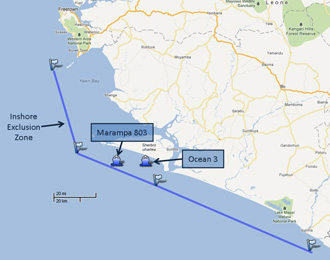
The location of two vessels observed by People & Power within the Inshore Exclusion Zone on 22nd October, 2011
In a dramatic opening sequence they manage to catch two South Korean trawlers in the act of fishing illegally inside a coastal exclusion zone. But contrary to international maritime regulations, the trawlers have covered up ship-board markings making it impossible to determine their names and ports of origin. The vessels refuse all their requests to stop and eventually make good their escape.
What follows is a remarkable piece of forensic journalism as the Al Jazeera team strives to track down and identify the vessels. Along the way they investigate disturbing allegations that the trade is flourishing because of rampant local corruption, in which officials are paid to turn a blind eye to the activities of foreign trawlers. With their time in Sierra Leone fast running out and the authorities seemingly reluctant to help, it looks as though the two vessels might evade justice. But then the team gets a vital clue that cracks the mystery wide open.
In part two of Pirate Fishing, the identity of one of the trawlers is revealed and in a nail biting climax, the captain and crew are confronted with the evidence of their crimes.
Taken together the two films are akin to a dramatic detective story, but the issue they address is deadly serious. Sierra Leone is one of the poorest countries in the world — currently ranked 180th out of 187 countries on the Human Development Index. After coming out of a brutal civil war that lasted 11 years, the country has struggled to rebuild its devastated infrastructure. Its waters contain some of the richest fish stocks in the world and could, if sustainably developed and managed, one day provide the country with much-needed income.
Even as things stand, fishing currently represents 10 per cent of Sierra Leone's GDP and is a crucial component in its food security (contributing 64 per cent of the total animal protein eaten in the country). But the pirate fishing activities of foreign trawlers are stripping these fishing grounds so quickly that unless the practice is stopped there will soon be nothing left to develop. And most important of all, local people will be deprived of a crucial food source — just to satisfy the appetites of seafood lovers in Europe and Asia.
The two 30 minute parts of the Al Jazeera programme are now available on YouTube. Part 1 and Part 2.
Norfolk Wildlife Trust & RSPB fear Habitat Directive adulteration
Extracted from 'Fears raised about DEFRA review of how habitats directives are applied in England' from the East Anglian Daily Times of Wednesday, 14th December, 2011
Fears exist among conservationist and wildlife groups that Government Ministers risk sacrificing some of the most cherished parts of our natural world in their haste to create an environment where development and industry can bloom.
One particular announcement in Chancellor George Osborne's autumn statement provoked widespread alarm among the custodians of East Anglia's wildlife, when the Chancellor told MP's that he wanted to make sure that "gold-plating of EU rules on things like habitats" were not putting "ridiculous costs" on British firms, pricing them out of the global economy. He said "If we burden them with endless social and environmental goals — however worthy in their own right — then not only will we not achieve those goals, but the businesses will fail, jobs will be lost and our country will be poorer".
Immediately following this the Department for Environment, Food and Rural Affairs (DEFRA) announced a review of how the EU habitats and birds directives are being applied in England, "with a view to reducing the burdens on businesses while maintaining and, where possible, enhancing environmental benefits". This was welcomed by Harry Cotterell, president of the Country Land and Business Association (CLA) who said: "The government is starting to melt the gold-plating on this directive. We support conservation, but it is important that humans are considered as important as bats, newts and dormice". Others too, including some builders and some farmers, considered that the directives are being imposed too rigorously 'by preserving wildlife sites at all costs — to the detriment of the industry required to kick-start the UK's failing and ailing economy'.
But East Anglia's wildlife charities said watering down these legal safeguards would threaten not only protected plants and animal habitats, but also the substantial tourism industry which flourishes around them. Paul Forecast, the RSPB's regional director for the east of England, said: "At this stage, until we know exactly what's going to happen in the review, we don't know what the full implications might be. Clearly, from George Osborne's statement, he wants to weaken the legislation that protects our important wildlife sites in the region. The east of England has a higher number of these important areas for wildlife than many other parts of the country. When you think about the Broads, the Brecks, the Wash and the North Norfolk coast — there are so many areas of land protected by this legislation. The fear is that for short-term economic gain, we might threaten some of the environment which makes the region so distinctive. All of us who live in the East do so because we love the area we live in, and that's part of attracting business and tourism into the area. You meddle with that at your peril."
EU legislation restricts development in special areas of conservation (SACs) under the Habitats Directive, and also in special protection areas (SPAs) under the birds directive. Such designation applies to the RSPB's reserves at Snettisham and Titchwell Marsh. These are overseen by senior sites manager Robert Coleman, who said "The habitat we're looking at here is a very wild place, and there are not many landscapes like this left in the UK. The habitats and birds directives have been in place for a good number of years and they have done a good job helping us to protect these places for wildlife. It is easy to look at these places in isolation, but we need to look at the wider context. We are part of the 'Natura 2000' network of SACs and SPAs across Europe. This legislation is not just about protecting it for the UK. Wildlife does not recognise boundaries, so what happens here affects birds migrating from places like Greenland and Iceland."
Norfolk Wildlife Trust (NWT) chief executive Brendan Joyce said the habitats directive in particular had been an important "last resort" in protecting its reserves, saying "The sort of places that the habitats directive protect are the most important places on a European scale. If they were not, they would not have the designation as an SAC. You cannot just say you are going to let those places go. We are not anti-development. We are not standing in the way of progress. We should have modern networks and housing and we do need economic security, but to be prepared to trash the wildlife jewels in the crown for the sake of it seems to me to be crazy."
The review expects to publish its recommendations in the March budget. It will consider where implementation of the legislation gives rise to the greatest compliance costs and delays, whether the requirements are "applied too or insufficiently rigorously", and "whether competent authorities and statutory conservation advisers could explore more creative solutions".
Wave-power costing less than 2p per KWh
From WaterBriefing Newsletter of 25th January 2012 comes the news that Ecotricity are developing an innovative wave-power technology called 'Searaser', the brainchild of Devon engineer Alvin Smith. It is rugged, gives variable output, and can produce electricity costing less than 2p per kilowatt hour, this four times cheaper than the lowest-priced renewable energy source currently on the marketplace.
'Searaser' thus addresses two of the biggest barriers to the deployment of renewable energy on the scale that Britain needs, that of cost and variable output.
Inventor Alvin Smith said the main barrier to making wave-power efficient and therefore cost-effective was to provide resilience against the hostile ocean environment. Searaser pumps seawater using a vertical piston between two buoys, one on the surface of the water, the other suspended underwater and tethered to a weight on the seabed. As the ocean swell moves the buoys up-and-down the piston works like a bicycle pump to send volumes of pressurised seawater through a pipe to an onshore turbine to produce the electricity. This technique produces the additional option to supply energy on-demand. By pumping seawater into a coastal storage reservoir, it can be released through a generator as required — thus making not just energy from the Sea but energy that can be turned on and off as required, so overcoming the problem of renewable energy's naturally intermittent output on Britain's electricity grid.
It is hoped that the first commercial Searaser will be on stream within 12 months and that two hundred will be operational in five years
Happisburgh homes being demolished
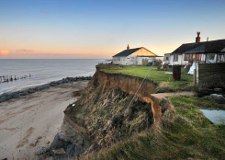
Coastal erosion at Beach Road, Happisburgh. PHOTO: ANTONY KELLY
The bulldozers are moving in on nine of the Happisburgh homes of owners who finally decided to sell their erosion threatened properties to North Norfolk District Council at between 40 and 50 per cent of their value, the funding for which comes out of NNDC's £3m provided by the government's pioneering 'Pathfinder' scheme. This now leaves just one permanently occupied bungalow standing which the owner refuses to sell.
What remains of the non-maintained original sea defences can be seen out to sea beyond the line of rock bunding on the left hand side of the photograph appended.
Photographs of Caribbean deep sea vent and a previously undiscovered species of shrimp
World's deepest sea vents reveal unknown creatures — in pictures. Eyeless shrimps and white-tentacled anemones are among the newly discovered life forms that scientists have found thriving near super-hot underwater geysers of the Beebe vent field, kilometres below the surface on the Caribbean seafloor in the Cayman trough.
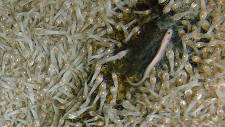
The Von Damm vent field is thronged with the new species of shrimp, along with other animals such as snake-like fish. Photograph: University of Southampton/NOC
Writing in the journal Nature Communications, a team led by Doug Connelly of the National Oceanography Centre and Jon Copley of the University of Southampton describe the discoveries from an expedition aboard the Royal Research Ship James Cook. The RRS James Cook is the UK's most advanced research vessel, with eight science laboratories aboard and deck space for carrying deep-diving underwater vehicles.
The scientists have revealed details of the world's most extreme deep-sea volcanic vents, 3.1 miles down in a rift in the seafloor of the Caribbean. The undersea hot springs, which lie half a mile deeper than any seen before, may be hotter than 450C and are shooting a jet of mineral-laden water two-thirds of a mile into the ocean above. The vents are nicknamed 'black smokers' for the smoky-looking hot fluids, laden with mineral particles, that gush from them.
"The Von Damm vent field was a complete surprise — hot vents have never been seen in a place like this before,' says Connelly. "Its discovery suggests that there may be more deep-sea vents out there than we previously thought".
For photographs of the marine life at these deep sea vents, visit the source/reference below.
"Seas At Risk" NGO urges adoption of marine litter reduction targets
A group of experts on marine litter has advised EU countries on setting reduction targets for marine litter for 2020. Member States now have 6 months to act on this advice and set ambitious reduction targets in order to combat this growing problem.
In 2010, Member States of the European Union agreed to consult a group of experts on the development of the Union's Marine Strategy Framework Directive (MSFD) specific to marine litter, in part to consider the sorts of targets that should be set for 2020. The final report of the group has just been published.
"This report makes a strong case for setting practical marine litter reduction targets for 2020. The problem of marine litter and particularly plastic pollution in our seas is growing and is a major concern for marine wildlife, marine industries, coastal communities and human health. Member States must take this advice on board and set out ambitious marine litter reduction targets for 2020," said Chris Carroll of Seas At Risk.
Beaches in the North East Atlantic have on average 712 pieces of litter per 100m of beach and almost all North Sea Fulmars, a bird that feeds exclusively at sea, are found with plastic in their stomachs. The economic costs are also damaging with coastal municipalities in the Netherlands and UK spending on average €28 million per year cleaning beaches.
With "garbage patches" forming across the world's oceans, most notably in the Pacific and the western part of the North Atlantic Ocean, urgent action is needed the stop the accumulation of marine litter.
Under the MSFD, Member States are obliged by July of this year to have set environmental targets for 2020 to improve the environmental status of their waters. Marine litter is one of 11 marine environmental problems that is accounted for under the MSFD. Other "descriptors" cover the over-exploitation of fish stocks, biodiversity loss and marine noise.
The report proposes a number of absolute reduction targets for marine litter on beaches, in marine biota and in the water column and sets out a number of different monitoring protocols for consideration by Member States
Risk of "bird strike" at proposed Thames estuary London airport
A new airport in the Thames Estuary would be the most dangerous in the UK because of the risk of a plane being brought down by a bird strike, the government has been warned by experts.
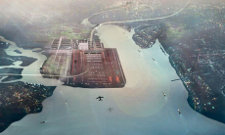
An artist's impression of the Thames Hub by Foster and Partners, a four-runway airport capable of handling 150 million passengers a year. Photograph: Foster And Partners/PA
A report, commissioned by ministers the last time they considered the option of a major new hub airport on the marshes east of London, found the risk of an "aircraft loss" after being hit by one or more birds was between one plane in 100 years and one plane in 300 years — higher than any of the other 10 major UK airports studied.
The high risk was calculated even after extensive work to make the area as unattractive as possible to birds, such as cutting down woodland, draining ponds, planting artificial grass and shooting birds when necessary. Without such measures "an aircraft could not operate safely in this location", said the report, adding: "Even with world-class management and mitigation measures in place… it is not considered possible to reduce the risk to a level similar to that experienced at other UK airports."
The report was commissioned in 2003 when Labour ministers were considering a new airport at Cliffe, on the north Kent coast; it was cited in the resulting white paper as one reason Labour rejected the Cliffe proposal, but was not published at the time. The experts' view will now add new difficulties for the coalition government, which is expected to announce in March a fresh consultation on building a new airport in the same area — an idea championed by London's Conservative mayor, Boris Johnson. Although the two proposals are not identical, they are likely to be on close or even overlapping sites on the north Kent coast, between the Thames and Medway estuaries. As a result, the findings and warnings of the 2003 report should be "broadly applicable," said Niall Burton, one of the original authors.
Simon Buck, chief executive of the British Air Transport Association, said the risk of bird strike was only one concern they have over the site. Another is possible "conflict" with flight paths for Amsterdam Schiphol's six-runway airport. "We feel as airlines there are lots of operational and technical issues that need to be addressed," said Buck. "It [the Thames Gateway proposal] is not what we see as being the solution to a problem [of shortage of runway space]."
Airlines, including British Airways, are known to favour expansion of existing airports, especially Heathrow in west London. However there is also huge opposition from environmental groups, who argue that no new runways are needed if the government invests in railways and taxes aircraft fuel equally with other transport.
The report will also fuel conservation concerns because, if a Thames airport was to go ahead, measures to reduce the risk of bird strikes would mean wildlife was affected far beyond the runways and buildings. Under European regulations, which cover much of the area's bird-rich salt-marshes and tidal mud-flats, developers would have to prove there was a genuine need to build a new airport, to try and mitigate environmental damage, and to compensate for any damage done. Because of the scale of the multi-billion pound project it would not be possible to compensate with alternative habitat in the area on such a big scale, said Nik Shelton, a spokesman for the RSPB. "Anyway [they would] have to destroy another bit of habitat to create it, so [they would] not add to the natural environment," added Shelton.
Ministers have not yet announced the exact site they will consider in the consultation, trailed by Johnson in the media last week. However a similar private proposal led by the Wembley Stadium and London "Gherkin" architect Sir Norman Foster appears to place a Thames Gateway airport on a site overlapping with the original Cliffe airport scheme, both of them on the Isle of Grain on the north Kent coast, between the Thames and Medway estuaries.
The Department for Transport stressed "no decisions have been taken" on the Thames Estuary or building a new runway at Gatwick or Stansted airports. "As the chancellor made clear in his autumn statement, we will explore all the options for maintaining the UK's aviation hub status with the exception of a third runway at Heathrow," said a department spokesman. "The government will consult on an overarching sustainable framework for UK aviation this spring and alongside this we will publish a call for evidence on maintaining effective UK hub airport connectivity."
The bird-strike report, prepared by experts from the government's Central Science Laboratory (now part of the Food and Environment Research Agency, Fera) and the British Trust for Ornithology, said the greatest risk to aircraft was from heavier birds, especially over 1kg, or flocks of 10 birds or more hitting a plane. It found that overall the highest risk bird species in the area were oystercatcher, curlew, herring gull, shelduck, wigeon, lapwing, great black-backed gull, cormorant, mute swan, greylag goose and redshank.
The mix of species affected by the different new airport schemes put forward would vary, but the overall impact in the "scale of numbers" was likely to be the same, said Burton, head of wetlands and marine research at the British Trust for Ornithology. Burton said he was not aware of any significant changes in bird-strike mitigation, though this was not his primary area of expertise.
MARINET notes: There is a further complication. During World War II the S.S. Richard Montgomery, a US Liberty Ship carrying munitions, sank on 20th August 1944 in the estuary off the coast of Sheerness. This wreck still contains 1,400 tons of unrecovered, unstable high explosive. If this unrecovered material were to explode, it would have the explosive force of a small atom bomb (i.e. equivalent to but without the radiation). See www.liveleak.com/view?i=0f1_1296339830 for further details.
86% of ocean debris is plastic
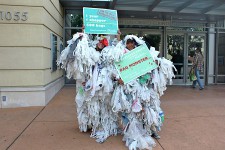
Bag to be Banned!!!
In a campaign to secure the banning of single use plastic bags in San Luis Obispo, California, the Surfrider Foundation which has led this local campaign has advised legislators that 86% of all debris in the ocean is made of plastic.
The Surfrider Foundation also advise in their latest email news that this campaign has proved successful, and a ban on single use plastic bags in San Luis Obispo and its county area has been passed. The use of plastic in single use bags will now be replaced by paper, and should encourage a greater use of cloth bags. This action has been taken to protect the seas and oceans which are currently heavily polluted by plastic, resulting in serious injury to marine life worldwide.
Renewable Energy Marine Park planned for SW England
The south-west of England is to be named as the UK's first marine energy park. The announcement has been made by the Climate Change Minister, Greg Barker MP, during a visit to Bristol. The South West Marine Energy Park will stretch from Bristol to Cornwall and as far as the Isles of Scilly.
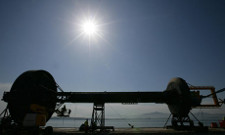
The PowerBuoy wave energy converter, which is to be used as part of the Wave Hub project, will see a giant National Grid-connected socket built on the seabed off the coast of Cornwall. Photograph: Handout/PA
The announcement establishes a partnership in the region between national and local government, Local Enterprise Partnerships, the Universities of Plymouth and Exeter and industry, including Cornwall's Wave Hub. The aim of the partnership will be to speed up the progress of marine power development.
Energy from the waves or tides has the potential to generate up to 27GW of power in the UK alone by 2050 — equivalent to the power generated from eight coal-fired power stations.
In a press release, the Minister stated: "This is a real milestone for the marine industry and for the south-west region in securing its place in renewables history as the first official marine energy park. The south-west can build on its existing unique mix of renewable energy resource and home-grown academic, technical and industrial expertise. Marine power has huge potential in the UK not just in contributing to a greener electricity supply and cutting emissions, but in supporting thousands of jobs in a sector worth a possible £15bn to the economy to 2050. The UK is already a world leader in wave and tidal power, so we should capitalise on this leadership to make marine power a real contender in the future energy market."
Chris Ridgers, cabinet member for economy at Cornwall council, welcomed the announcement. He said: "Cornwall's marine energy programme is reinforced by more than a thousand years of industrial heritage. The land and the sea have provided the foundation of Cornish entrepreneurship in engineering and innovation, recognised across the world."
Welcoming the Government's proposal for making the South West of England a marine park, Friends of the Earth's South West Campaigner Mike Birkin said: "This is exciting news for the South West and our economy — developing the UK's marine energy potential will create thousands of new jobs and help cut the nation's dependency on expensive fossil fuels long term. We need real action to make this a reality — we're still waiting for wave energy machines to be plugged in to Cornwall's Wave Hub a year after it was installed on the seabed. With cash-strapped households facing huge fuel bills there's no time for delay — the Government must get on with developing affordable clean power."
Generation IV Fast Reactor rejected for Sellafield
Advocates of a new breed of civil nuclear reactors using waste nuclear fuel, collectively known as "Generation IV Fast Reactors" have had the GE Hitachi version of this type of reactor, known as "Prism" (Power Reactor Innovative Small Modular), rejected by the Nuclear Decommissioning Authority (NDA) for use at Sellafield, Cumbria.

Flasks containing used fuel cooling down at Sellafield's reprocessing facility. The reactor plan was announced as a way of converting the UK's 82-tonne stockpile of plutonium into power. Photograph: Don Mcphee
The Guardian, 24th January 2012, reports:
"A plan to build a plutonium-burning reactor at Sellafield in Cumbria has been rejected by the UK government's Nuclear Decommissioning Authority (NDA). Internal e-mails seen by the Guardian reveal that the NDA regards the reactor technology as immature and commercially unproven. It would also create large amounts of plutonium-contaminated waste and increase the risk of terrorists acquiring nuclear weapons, the NDA says.
The reactor plan was announced by General Electric (GE) Hitachi in November as a way of converting the UK's 82-tonne stockpile of plutonium at Sellafield into power. Known as "Prism" (Power Reactor Innovative Small Modular), it is a new design of sodium-cooled fast reactor that is fuelled by plutonium.
In an e-mail to GE on 29th November 2011, the NDA's strategy and technology director, Adrian Simper, said that the two organisations "have struggled to reach a clear agreement on the work necessary to demonstrate credibility, without which neither NDA nor government can consider Prism further in the development of our strategy."
In a draft response to GE prepared for the Department of Energy and Climate Change (Decc), the NDA said it had carried out a "high-level assessment" of Prism. The technology was "still to be demonstrated commercially", it concluded, and "the technology maturity for the fuel, reactor and recycling plant are considered to all be low".
One drawback with Prism, according to the NDA, was that it would be fuelled by plutonium metal, rather than the oxide form in which UK plutonium is currently stored. Converting the oxide to metal would result in "a likely large amount of plutonium contaminated salt waste requiring management".
Plutonium metal is also thought to be easier to make into bombs. "This would introduce more security/proliferation risk," warned the NDA. "In summary the Prism concept is unlikely to start before 2050 and as such does not appear to meet the requirement for deployment within 25 years."
Jean McSorley, a Cumbria-based nuclear critic, obtained the e-mails under freedom of information law.
GE said that there had been "miscommunication" about Prism, which had been under development in the US for 30 years. "We haven't had a chance to explain it yet," the company's chief nuclear engineer, Eric Loewen, told the Guardian. "We're working on a framework with the NDA."
But Decc said that the alternative of turning plutonium into mixed oxide (Mox) fuel was "the most credible and technologically mature option" so it was prioritising work on that. "We are not closing off alternatives," added a Decc spokesman. "We remain open to any technically mature proposals that offer better value to the taxpayer and can be delivered in within a comparable timeframe as our preferred option."
California's Central Coast Kelp Forest captured on film
Terry Lilley, a marine biologist and former pro-surfer, and his assistant Sue Sloan, have made a film for the San Luis Obispo Surfrider Foundation which records the amazing marine life and exceptional biodiversity to be found in the California Central Coast's kelp forests.
This film shows many ocean creatures, including: giant lingcod, huge schools of rockfish, rare angle sharks, colourful sea slugs and anemones in every colour of the rainbow, 300 pound seals, giant crabs and lobsters and, as Lilley himself remarks in the film's commentary, there is no need to go to Mars to be an original explorer because the marine life in these Californian kelp forests is being recorded here for the first time, and many of the marine animals in this film will have never seen human beings before.
We provide an extract from this exceptional film on our new Planet Ocean webpage.
Strong community support, including amongst fishermen, for new Isle of Man marine reserve
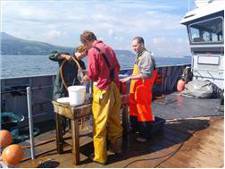
DEFA officers surveying Ramsey Bay from the fpv Barrule, sorting seabed samples
Ramsey Bay has been designated as the Isle of Man's first Marine Nature Reserve in a project welcomed by government, fishermen and Friends of the Earth.
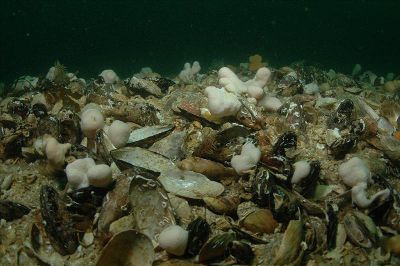
Horse mussel reef with soft corals off the Point of Ayre
Underwater surveys have revealed that the bay has a highly complex, thriving and diverse habitat and that it is ideal for the establishment of a reserve which will protect marine life, safeguard local fisheries and provide opportunities for Ramsey to develop as a centre for marine tourism, research and education.
The seabed also has lush eelgrass meadows, kelp forests, reef habitats and bright pink maerl beds as well as an abundance of shellfish and numerous fish species.
"The designation of the Ramsey Marine Nature Reserve is an exciting step forward for the Isle of Man," said DEFA (Dept. of Environment, Food and Agriculture) Minister John Shimmin MHK (Member of the House of Keys). "The area will provide a replenishment area for our important local fisheries and it will maintain and restore essential marine habitats. It will also help us contribute to reducing impacts of climate change by increasing the carbon storage capacity of our seas. Eelgrass meadows, kelp forests and reef habitats all store carbon in the same way as rainforests, contributing to lowering carbon dioxide concentration in the atmosphere."
"I am especially pleased" said the DEFA Minister "that at a time when fishermen across the British Isles are fighting a rearguard action against designation of Marine Protected Areas, the close partnership we have developed with our fishermen means that we were able to put out a joint press release when we announced the proposals, and continue to work with our fishermen to ensure that the benefit they obtain from this designation is maximised."
Chief Executive of the Manx Fish Producers' Organisation, Tom Bryan-Brown, added, "The fishing industry has been involved in the Ramsey Bay MNR from its inception. This particular MNR differs from the other closed areas around the Island in that they have been created primarily for fisheries management purposes whereas Ramsey Bay has been created for environmental reasons. However, we hope that there will be associated fisheries benefits from this MNR in Ramsey Bay and if that is the case then the industry will be able to take advantage and the environmental credentials of the Island will be maximised."
The Ramsey Bay designation is the result of a three year process to involve the Manx community in identifying possible sites for the Marine Nature Reserves and to work with users of the sea and the wider public to choose the best site to protect. Hundreds of people have attended workshops and presentations and responded to surveys and interviews, ensuring that the MNR is based on the best possible information. Ramsey Bay provides the perfect combination of important marine habitats and potential for benefiting local fisheries. The Marine Nature Reserve is also well supported by marine users.
In August scientists from the Fisheries Directorate of DEFA carried out comprehensive surveys of Ramsey Bay using special seabed mapping equipment and a camera on an underwater sledge. This will enable scientists to produce detailed maps of the marine life of Ramsey Bay to assist in the monitoring of the Reserve.
Tony Glen, Seasearch Isle of Man Co-ordinator who led the team of volunteer divers added, "Isle of Man Seasearch has been involved with the Fisheries Directorate for many years and is pleased that the Ramsey Marine Nature Reserve is now officially designated. This is not the end of the exercise, and we look forward to further dives to monitor the state of the seabed in the years to come. Credit should go to the Ministers both past and present who have supported this scheme and I look forward to our continued involvement in surveying the marine habitats around the Island in association with the officers of the Directorate."
The wider benefits of the Marine Nature Reserve have also been recognised by Isle of Man Friends of the Earth. Local co-ordinator Phil Corlett said, "It's really heartening to see the Ramsey Marine Reserve set up in the Island's territorial waters as it shows the Isle of Man is taking steps to protect biodiversity and helping at the same time to conserve vital habitats. "As a diver myself involved in the Seasearch surveys around the Island, I look forward to revisiting the area next year to survey it and document any changes".
Independent study says UK Government "stress test" of nuclear power plants was inadequate
A study undertaken by marine radioactivity consultant, Tim Deere-Jones, for the Nuclear Free Local Authorities (NFLA) has concluded that the "stress test" undertaken by the UK Office for Nuclear Regulation (ONR) to establish the safety of nuclear power plants in the UK following the Fukushima nuclear disaster was inadequate.
A key issue in the Fukushima accident has been the use of emergency cooling water in order to keep the damaged reactors and cooling ponds in a safe condition, and the NFLA report concludes that the Government's ONR report has failed to properly consider this issue should a similar emergency occur in the UK.
The NFLA report states that there was loss of containment at 3 reactors and one spent fuel cooling pond at Fukushima, and that emergency cooling water had to be used in vast quantities. Initially the emergency cooling water was applied in unquantified volumes, but later attempts to quantify the use of emergency cooling water on a daily basis has confirmed flow rates of up to 432 tonnes per day. Also initially, this emergency cooling water was discharged into the surrounding environment (watercourses and sea) in unquantified amounts, but in September 2011 the IRSN (Institut de Radioprotection et de Sûreté Nucléaire — the French public expert in nuclear and radiological risks) estimated that during the period from late March to the end of April 2011 about 27 PBq (Peta Becquerels) of radioactivity from the radio-isotope Caesium 137 alone, had entered the Pacific coastal waters as a result of the escape of primary and emergency cooling waters from the Fukushima disaster.
Now, after several months of preventative action, the amount of emergency cooling water in storage is estimated as being in the region of 195,000 tonnes. This cooling water has become highly contaminated with the entire range of 50 to 60 isotopes found within such environments, including several isotopes of plutonium and similar substances (americium, curium, etc).
The NFLA report notes that massive use of emergency cooling water was required at the Windscale and Chernobyl accidents, and also at 3 Mile Island, USA, at Mayak/Kyshtym in the Urals during the USSR era, and at the Hanford plant in the USA.
In the context of the UK, the NFLA notes that the UK's seas are relatively enclosed, with relatively slow flushing/dispersion/dilution rates, and thus the use of emergency cooling water in large quantities, and its ultimate fate in the environment, is a major issue.
The NFLA report expresses deep concern that the Office for Nuclear Regulation (ONR) report only discusses releases of radioactivity to atmosphere in the context of nuclear accidents, and believes that the ONR report has failed to give serious consideration to the use of emergency cooling water. The NFLA report concludes that the ONR report has failed to learn and respond to the most crucial outcomes of the Fukushima disaster, and the NFLA makes a number of recommendations for the construction of bunding, storage tanks and site drainage control in order to manage, capture and store escaped coolant and emergency cooling water at UK nuclear power plants.
A summary of the Nuclear Free Local Authorities report, prepared by Tim Deere-Jones, may be seen here on our Radiation page.
'Human rights at risk' in Shoreline Management Plan
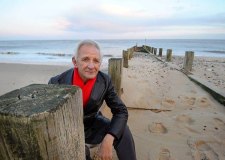
Brian Hardisty on Hopton Beach — Picture by James Bass
Brian Hardisty, chairman of the Hopton Coastal Action Group and Parish councillor, has threatened to invoke the Human Rights Act after proposals for a new Shoreline Management Plan revealed it would bring about the loss of five houses at Hopton within the next 40 years (one of these being Brian's).
"Human rights will be breached if Great Yarmouth Borough Council fails to protect more than a dozen cliff-top homes and businesses from the ocean" is Brian's stated concern, whose Hopton home will be engulfed with a total of fourteen houses and two holiday companies (Bourne Leisure and the Potters Leisure) by 2105 if the Kelling to Lowestoft Ness Shoreline Management Plan (SMP) is approved. His warning comes after plans revealed sea defences at Yarmouth and Gorleston would be maintained, while parts of Hopton would be allowed to fall into the sea, a recommendation he believes breaches Article 14 (discrimination) of the Human Rights Act 1998.
True Costs of Coastal Abandonment
Coastal Group member Richard Steward points out to us that the recent DEFRA 'puff piece' failed to mention that much of the £12 million the Environment Agency are removing from our coastal defence budget (now totalling £84 million since 2005) is required to pay for the relocation 32,000ha of EU designated habitat (i.e. habitat that should be protected in-situ under EU law) and 10,000ha of 'managed realignment' (flooding of productive farmland using HLS/CAP payments of £10,000/ha) and that the total bill for this is close to £2.6 billion.
He feels that until this absurdity is stopped we will never get the coastal protection we need.
Sea defences for Dungeness nuclear power station threaten surrounding SAC
The view from the windows of Ken and June Thomas's black-tarred cottage is extraordinary. The largest expanse of shingle beach in Europe is dotted with rare plants and desert flowers. Birds screech as they flock beneath the vast sky. Ken Thomas's fishing boats are pulled high above the tide mark as giant tankers pass by in deep channels scored close to the shore and anglers huddle along the water's edge, their tents hidden in the ridges of shingle. Strain to the right and you can see a lighthouse, built with a unique pigmented, spiralled concrete. Beyond is the weathered shack where Marconi sent the first radio messages across the Channel, and along to the left is Derek Jarman's celebrated Prospect Cottage, with its driftwood garden and John Donne's poetry carved in wood on its wall. At the tip of the promontory is the Dungeness nuclear power station. It is no ordinary backyard.

The artist Derek Jarman stands in the driftwood garden at the front of Prospect Cottage, his celebrated home on the beach at Dungeness. Photograph: Geraint Lewis/Rex Features
Residents of the 99 Dungeness houses — many of them built on top of Victorian railway carriages dragged on to the shingle a century ago — will attend a public meeting with Kent county council and EDF, the company operating the Dungeness B plant, to discuss a controversial planning application that would see this landscape change dramatically.
The proposal, from EDF and the Environment Agency, is to have between 50 and 100 quarry lorries a day, each weighing 30 tonnes and three metres wide, coming along the 3.1-metre wide unmade road for five days a week, trundling right past their front doors. Diggers will be out too, along a 300-metre stretch of seafront, pulling out up to 30,000 tonnes of shingle a year to dump it back into the sea a few miles away down the coast.
The idea is to "recycle" the shingle by piling it on to the eroding coastline on the Kent-East Sussex border and prop up the beach in front of the power station. Anglers who come to Dungeness from miles around for its cod and bass fishing have already been getting up petitions over the quarry works fencing, which would cut off access to some of the best fishing spots.
Now residents have started a campaign against the plans. They say it is a waste of time and money, because not all the shingle is washed back to its original location. Residents also fear that the huge dumper trucks will destroy the fragile ecosystem and turn away the growing numbers of tourists who have been starting to visit their stretch of the Romney marshes. Dungeness is also of international importance, designated as a national nature reserve, a special protection area, a special area of conservation and a site of special scientific interest.
A similar scheme of quarrying the eastern side ended in 2007 over concerns for the environment, and since then the Environment Agency, responsible for England's coastline defences, had been buying in shingle from inland quarries. But that costs three times as much as digging out the beach — or "borrow pit", as the area to be excavated is known.
In a statement, the Environment Agency said: "Recycling shingle has an effect on the Dungeness special area of conservation, and in 2007 we stopped using the borrow pit and started to explore how we might minimise this effect while still maintaining the defences. Recycling shingle from the borrow pit provides the best value for money for the taxpayer and means that we can stretch public funds further to reduce the risk of flooding to more homes and businesses."
It would seem to go against the Department for Energy and Climate Change which, in a recent report on sites for a new nuclear facility, rejected Dungeness, stating: "If shingle had to be sourced from Dungeness for sea defence purposes, then this could impact this nationally and internationally important conservation site".
For local people it could also radically set back the area's growing popularity as a tourist destination. "Since they stopped quarrying here in 2007 the tourists have been coming. We get coachloads of schoolchildren, students on photography courses, bird watchers, photographers, the anglers of course. With the power station going out of commission we need the tourism for the local economy," said June Thomas. "You can't expect anyone to come here when there are giant lorries constantly going up and down. It's not safe." She can see the "borrow pit" from her windows. I dread it. As they load the lorries the sound will be awful, a mass of shingle being dropped from a height into a metal container, all day, every day, awful."
Her husband Ken, 60, is from a family who have fished here for generations. For him the plan itself doesn't make sense. "They will just change the profile of the beach and the channels, but do nothing to stop coastal erosion. None of them has any idea of how shingle moves. They had no idea how the shingle would shift when they built the power station and they wouldn't listen to the fishermen who told them this would happen, that they were building it in the wrong place. "Now they're not listening again. They haven't done basic research to see what works and what doesn't by way of coastal defences. They stopped it once, when the conservationists stepped in and said that method can't be done. Now they want to save money and they've come back to it. They think Dungeness is a dump, a wasteland. Well, they're out of date, it's recognised now for what it is, somewhere special."
Paul Schwartfeger's house is built around a Victorian railway carriage, complete with parquet floor. He has been busy making up "No to Quarrying" posters that almost all the homes have in their windows. He says the EDF and Environment Agency proposals are short-sighted and won't provide any long-term defence against the longshore drift that affects the stretch of coast from Kent into East Sussex. "The quarrying at Dungeness is a cheap way of trying to tackle a major problem but all the expertise points to it not working. The Environment Agency says itself that flood defence strategies we need to be working with are those which manage risk — protecting and restoring and copying the natural regulating function of rivers, floodplains and coasts."
Mudflats and salt marshes provide a natural "sponge" for rising sea levels rather than hard barriers like shingle, while lifting the shingle also allows more water into the land — raising the water table and, in effect, raising the flood risk. "What makes me feel really angry is the hoops we have to jump through, and rightly so, about planning and the environment. We can't touch the land in our garden or put up a fence. It's a privilege to live here, but then the council can come along and decide quite arbitrarily to dig it all up. It's extraordinary," says Schwartfeger.
The protesters also make the point that EDF and the Environment Agency could dredge shingle offshore for a similar cost but without the noise and disruption. That's not something the owner of the fishing tackle shop in the nearby village of Greatstone is keen on. Tony Hills is chairman of Dungeness Angling Association and a Shepway district councillor. He believes the government's rejection of Dungeness as a nuclear site could still be overturned and is in favour of a quarry to provide the necessary shingle. "We need jobs desperately. Economic advantage shouldn't be put off by environmental needs. If we don't get sea defences, we don't get a power station, and vice versa." He adds: "What's going to happen if we don't do this? For starters, you're leaving the 30,000 people living in the marsh area to drown."
Ships could move from fossil oil to algal oil as their fuel
Giant cargo boats and US navy warships have been successfully powered on oil derived from genetically modified algae in a move which could herald a revolution in the fuel used by the world's fleets — and a reduction in the pollution they cause.
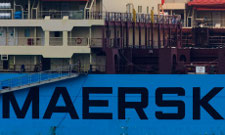
Trials of the algal oil have been carried out on a Maersk cargo ship. Photograph: Murdo Macleod for the Guardian
The results of substituting algal oil for low-grade, "bunker" fuel and diesel in a 98,000-tonne container ship are still being evaluated by Maersk, the world's biggest shipping company, which last week tested 30 tonnes of oil supplied by the US navy in a vessel travelling from Europe to India. Last month, the navy tested 20,000 gallons of algal fuel on a decommissioned destroyer for a few hours. Both ran their trials on a mix of algal oil — between 7% and 100% — and conventional bunker fuel.
"The tests are not complete yet, but we had very few problems," a Maersk spokesman said.
Collaboration between the world's two biggest shipping fleets is expected to lead to the deployment of renewable marine fuels. Maersk uses more than $6bn of bunker fuel a year for its 1,300 ships, and the US navy, the world's biggest single user of marine fuels, burns around 40m barrels of oil a year. The navy plans to test more ships on algal fuel next year as part of its "green fleet" initiative and has pledged to cut 50% of its conventional oil use a year by 2020. Maersk hopes to achieve similar cuts in the same time.
"Shipping takes 350m tonnes of oil a year and causes 3-4% of all greenhouse gas emissions, so it is very attractive to find alternatives. We can envisage [the world's] ships being 10% or more powered by biofuels in 20 years' time," Jacob Sterling, the Maersk head of climate and environment, said.
The exact nature of the algae, one of 30,000 single-cell organisms known to exist in the wild, is a secret closely guarded by Solazyme, the company that manufactures the fuel in giant fermentation tanks in Pennsylvania. The fast-growing algae are fed crop or forest waste and convert their sugars to oil.
"The technology is there. The question now is how to scale up," Tyler Painterm, the chief finance officer of Solazyme, which has a contract to produce 450,000 gallons of biofuels for the navy's trial, said. "We have tested thousands of algae, found in swamps, in mountains and at sea and we know we can be competitive. By using different strains of algae, we can produce different kinds of oils."
The company, which is set to expand shortly with a 50m gallon-a-year plant in Brazil, is backed by the oil company Chevron, the giant US agribusiness Bunge, and Sir Richard Branson, whose Virgin airline has tested planes on algal fuel.
Unlike early biofuels, which made transport fuel from food crops, the new "second generation" process uses only plant waste and does not displace foods which could be fed to people or animals. Nevertheless, immense amounts of feedstock would be needed to power the world's ships. Maersk estimates it could take the crop waste of an area half the size of Denmark to completely power its ships.
But even a partial switch to algal oils would massively reduce air pollution. Bunker fuel, which is little more than asphalt, can produce as much pollution from a single ship in a year as 50 million cars and is the most polluting fuel in the world.
But there is uncertainty over how much algal fuels would reduce greenhouse gas emissions. Algae sequester CO2 when growing, but release it when burned as oil. Solazyme and Maersk claim they reduce carbon emissions by 80% compared with petroleum-derived fuels in a "lifetime" analysis.
The race is on between different companies to produce competitive algal oils. In October 2010, the US Navy purchased 20,055 gallons on algae biofuel at $424 per gallon, but by December 2011, the price had reduced to $26.67 per gallon. Meanwhile, Craig Venter, the scientist who first sequenced the human genome and designed the first synthetic cell, is trying to develop a genetically-engineered algae fuel that depends only on sunlight and sea water and can be grown and harvested at sea. In an interview in this month's Scientific American, he said: "We need three major ingredients: CO2, sunlight and seawater, aside from having the facility and refinery to convert all those things. We're looking at sites around the world that have the major ingredient. To us, this is a long-term plan."
If the US navy does switch to algae or other biofuels, it would mark the end of an era of oil-burning navies ushered in by Winston Churchill. In 1911, as the British navy minister, he controversially ordered the huge British fleet to switch from coal to oil for efficiency. Two years later, he bought a 51% controlling interest in the then small Anglo-Persian Oil Company for the UK government. Within a few years, the company changed its name to BP, and is now the world's fourth-largest corporation.
Further concern over oil tanker transfers at sea
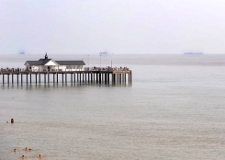
Tankers anchored off the the coast at Southwold
Fears of an oil spill along the Suffolk Coast were further elevated by the news of the stricken 54,000 tonnes oil tanker Genmar Companion, which ran into trouble off the Northern Irish coast on Friday 6th January when the crew spotted a crack in the deck as it was travelling from Rotterdam to New York. The tanker was taken to Belfast Lough for a transfer of the cargo of oil to take place, which was completed by the Saturday, safely and apparently without further incident or hazard.
Secretary of the Southwold and Reydon Society John Perkins opposes the Department for Transport plans that will see the Sole Bay area designated in April as the singular spot for oil transfer in UK waters, pointing out that the situation with the Genmar Companion identified potential hazards that could be posed to the Suffolk coast. He stated "Having looked at the details of this, it obviously highlights the risk and just shows the potential risk of transferring large quantities of oil by sea. Our concern is always that in Sole Bay these ships are very close to the shore.""> adding "These things are potentially more dangerous than modern boats. It highlights the risk and it is a concern." The Suffolk campaigners objecting to the Government legislation say the Genmar Companion episode raises question marks about the safety of the oil tanker industry and the sea-worthiness of the ships.
Suffolk Coastal MP Therese Coffey raised questions about the standard of some of the vessels used in the transfers, saying "It is fair to say people are concerned about the seaworthiness of the oil tankers. The boats going through our international waters — are they the appropriate standard and are they going to just break up?"
But a spokeswoman for the Department for Transport said the situation in Belfast with the Genmar Companion was a "one-off problem because of the ship" and that the change in legislation coming into place on 1st April was unaffected, stating "There is no plan to change our plans for ship-to-ship transfers."
£50K NNDC loan to FLAG
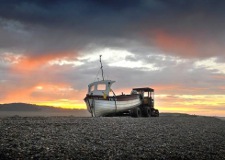
Photo by Antoy Kelly of fishing boat on Weybourne Beach
North Norfolk District Council Cabinet are about to approve a £50,000 interest free loan for a provide a working cash flow under the FLAG Scheme, to help the areas ailing fishing industry when the final grant payment is received from the Marine Management Organisation. Altogether £2.4m worth of projects are aimed at boosting Norfolk's fishing industry
The FLAG scheme, mainly funded by the European Fisheries Fund, will allow the cash needed to be spent on infrastructure, marketing, on education and in obtaining EU protection for the Cromer crab, with the long-term aim of creating a fisheries training school. It will benefit the wide sweep of the Norfolk fishing industry by being spread over a 59-mile stretch of the counties coastline, ranging from Thornham to Caister-on-Sea, and will also include inshore businesses with links to the trade.
The money will be due for repayment at the end of the three-year Marine Management Organisation programme.
New study records evidence of excess childhood leukaemia around nuclear power stations
A major epidemiological study published in the January 2012 edition of The International Journal of Cancer indicates there is "a possible excess risk" of acute leukaemia among children living in close vicinity to French nuclear power plants (NPP). The study called for an "investigation for potential risk factors to the vicinity of NPP, and collaborative analysis of multi-site studies conducted in various countries."
The study found a doubling of occurrence of childhood leukaemia between the years of 2002-2007 among children under 5 years living within 5 km of nuclear plants — similar to the findings of the German 2008 study by the Cancer Registry in Mainz which found an association between the nearness of residence to nuclear power plants and the risk of childhood leukaemia.
The epidemiological study was conducted by a team from the Institut National de la Santé et de la Recherche Médicale, the Institut de Radioprotection et de Sûreté Nucléaire (IRSN) and the National Register of haematological diseases of children in Villejuif. The results marked a surprising and encouraging change at IRSN which had endeavoured to discredit earlier French epidemiological studies that had shown an impact of nuclear facilities on health.
Could quotas for catching whales lead to their better protection?
Introducing tradable quotas for catching whales could reduce the number of the marine mammals killed each year, researchers have suggested.
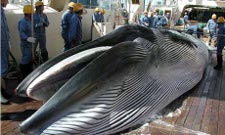
A whale caught and killed by a Japanese 'research' ship. Photograph: Reuters
Writing in the journal Nature, US academics said a market of quotas that could be bought and sold would allow environmental groups to "purchase whales" to save them and let whalers profit from the animals without killing them. Christopher Costello and Steven Gaines, of the University of California, and Leah R Gerber of Arizona State University have proposed the method of putting a "price tag" on whales in the face of the ongoing battle over whaling, which continues despite a global ban. The researchers said that although a global moratorium began in 1986, the number of whales being caught has more than doubled since the early 1990s to almost 2,000 each year.
"A fervent anti-whaler will be quick to argue that you cannot and should not put a price on the life of a whale; a species should be protected irrespective of its economic value," the researchers write. "But unless all nations can by convinced or forced to adopt this view, whaling will continue. It is precisely because of the lack of a real price tag in the face of different values that anti-whaling operations have had such limited success."
In 2010, a 10-year "peace plan" drawn up by the International Whaling Commission proposed limited quotas for those countries that continue to hunt the mammals despite the ban. The plan would have meant that Iceland and Norway, which hunt commercially, along with Japan, which exploits a loophole allowing it to catch whales under an exemption for "scientific" whaling, agree to catch limits set by the commission and based on scientific advice.
The bid to introduce quotas — which the IWC said would save several thousands of whales — failed, but the US academics said a trading market could benefit whales and whalers. In their comment piece, they propose that quotas be allocated, at sustainable levels, to all member nations of the IWC, who would have the choice of using them or retiring them. The majority of the quotas could be divided between whaling and non-whaling nations based on historical whaling patterns, with the remainder auctioned and the proceeds going to whale conservation.
The scientists said calculations based on market prices and whaling costs put the profit per whale at around $13,000 (£8,500) for a minke and $85,000 for an endangered fin whale. As a result, prices for whale quotas should be within the reach of conservation groups and even some individuals. The millions of pounds spent by conservation organisations on fighting whaling could be used to "purchase whales" by buying the quota, with the same or better effect. It could reduce the number of whales caught — possibly even to zero — and suitably compensate whalers, the scientists said.
The academics acknowledged that policing a whale quota market would not be simple, but they said: "By placing an appropriate price tag on the life of a whale, a whale conservation market provides an immediate and tangible way to save them."
15 new species found in Scottish seas during 2011
A brainless and faceless "fish" was one of 15 species discovered during a series of Scottish marine surveys during 2011.
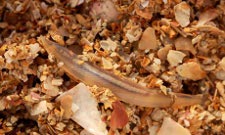
Prehistoric amphioxus, which have no face or brain, have been discovered in the waters off Tankerness in Orkney. Photograph: Andrew Want/Marine Scotland/PA
The prehistoric amphioxus, was found in waters off Tankerness in Orkney. It has a nerve cord down its back and is said to be regarded as a representative of the first animals to evolve a backbone.
Giant mussels with shells measuring up to 48cm (18in), were also discovered around the Small Isles and are said to have the largest sea shells in Scotland.
More than 100 specimens of the Fan Mussels were found around the islands, meaning the area has the largest aggregation of the fish in UK waters. The mussels are said to have golden threads similar to human hair, which are so fine they are able to attach to a single grain of sand. In Caithness, the country's largest horse mussel bed was found in waters near Noss Head. The species, known as clabbydhhu in Gaelic, which translates as "enormous black mouth", are slow-growing molluscs that can live for up to 50 years.
Other finds from the marine surveys, which covered more than 2,000 sq miles, included flame shell (Limaria hians) beds in Loch Linnhe, Argyll, as well as new communities of northern feather star, a brightly coloured species with 10 feather-like arms fanning out from a central disc, which were discovered off the Sound of Canna.
The Scottish government said the findings would further the country's knowledge of the biodiversity of its seas. Scotland's environment secretary, Richard Lochhead, said: "In an age where the lands of the world have been mapped out and recorded, it's amazing how many discoveries are waiting to be found under the waves. Spanning from the weird to the wonderful, discoveries this year have included the bizarre amphioxus and the beautiful yet elusive brightly coloured flame shell. The waters around Scotland are rich in such fascinating biodiversity and it's our responsibility to protect this fragile environment."
Dr Dan Barlow, head of policy at WWF Scotland, said: "These surveys highlight that Scotland's seas and coasts are home to a truly amazing range of weird and wonderful wildlife. By providing vital information on what lies beneath the waves, these surveys will help inform decisions on better ways to protect this important resource now and long into the future. From helping inform the appropriate deployment of marine renewables to supporting the rollout of a network of Marine Protected Areas, these survey findings will prove invaluable in helping ensure the recovery of Scotland's seas. It is important that the government builds on this survey work to further our knowledge of the marine environment."
Susan Davies, director of policy and advice with Scottish Natural Heritage, added: "Scotland's seas really are a fantastic asset. The findings from these surveys will help us to manage them sustainably and ensure future generations can also enjoy the benefits of a healthy and diverse marine environment."
Exotic creatures found in Indian Ocean hydrothermal vent, but mining is about to commence
British scientists have found a remarkable array of creatures, some of them new to science, in one of the most inhospitable regions of the deep sea. In the first ever expedition to explore and take samples from the "Dragon Vent" in the south-west Indian Ocean, remotely operated submarines spotted yeti crabs, sea cucumbers and snails living around the boiling column of mineral-rich water that spews out of the seafloor.
Dr Jon Copley, a marine biologist at the University of Southampton who led the exploration of the Dragon Vent, said his team found animals that had not been seen in neighbouring parts of the oceans.
"We found a new type of yeti crab. Yeti crabs are known at vents in the eastern Pacific and there are two species described so far, but they have very long, hairy arms — ours have short arms and their undersides are covered in bristles. They're quite different to the ones that are known from the Pacific," said Copley. "This is the first time a Yeti crab has been seen in the Indian Ocean." His team also found sea cucumbers, vent shrimps and scaly-foot snails. Sea cucumbers have previously only been seen at deep sea vents in the eastern Pacific. "This is the first time they've been seen at vents in the Indian Ocean and they're not known from the central Indian or mid-Atlantic vents so far," he said.
Deep-sea vents, also known as hydrothermal vents, are springs of superheated water that are powered by underwater volcanoes. They erupt from the sea bed and are usually found a few miles under the sea surface. The scalding temperatures and rich mineral content of the water give rise to vast rocky chimneys, which have been found to support a wide variety of life forms. The survey was part of a larger expedition to study underwater mountains aboard the RRS James Cook, which sailed from Cape Town on 7 November and returned to South Africa on 21 December. The exploration of the Dragon Vent took place in an intense three-day burst in the middle of the trip.
Copley's team took hundreds of samples of 17 different creatures, all of which are now being shipped back to his lab for detailed morphological and genetic examination. "Chances are that there will be several that are new species," he said. "We won't know for sure until we get them back into the lab and analyse them."
Copley's work builds on a Chinese expedition in 2007 that pinpointed the hydrothermal vents on the south-west Indian ridge for the first time. This chain of undersea volcanoes joins the mid-Atlantic ridge to the central Indian ridge. This part of the volcanic ridge is less volcanically active, so scientists think hydrothermal vents should be fewer and more scattered here. It therefore raises the question of whether life there is significantly different.
Copley said that characterising the life at the world's hydrothermal vents was a race against time. " Earlier this year, China was granted a licence by the UN International Seabed Authority for exploratory mining at deep-sea vents on the south-west Indian ridge," he said. "The vent chimneys are very rich in copper, zinc, gold and uranium. But we have no idea what's actually living there."
In evolutionary terms, hydrothermal vents were like the islands of the ocean floor, he added. "Just like the 19th century naturalists used to go to the Galápagos and other islands to find species there that are different to elsewhere and then use that to understand patterns of dispersal of dispersal and evolution, we can use deep-sea vents to do the same things beneath the waves," he said.
"And we need to do that because the exploitation of the deep ocean is overtaking its exploration. We're fishing in deeper and deeper waters, oil and gas is moving into deeper waters and now there's mining starting to take place in deep waters. We need to understand how species disperse and evolve in the deep oceans if we're going to make responsible decisions about managing their resources."
To see a video of this hydrothermal vent and the creatures living there, see www.guardian.co.uk/science/video/2011/dec/28/deep-sea-creatures-volcanic-vent-video
Sea Defences at Cromer
An Eastern Daily Press article of the 14th December entitled 'Town set for £6.5m sea defence scheme' by reporter Steve Downs:
reveals that Cromer is close to getting £6.5m with which to shore up its groynes and sea walls, this coming about more than 13 years after the project was first proposed.
At the end of this month (January 2012) the Environment Agency will finally decide whether to include in its forward programme the multi-million pound scheme to revamp the groynes and add new concrete armour to the protective walls, some of which date back to Victorian times. If agreed, the work will start in November 2012 and take two years, with all work performed outside the April to September tourist season. North Norfolk District Council (NNDC) is forecasting a March 2012 commencement for a long-awaited £1.2m project to repair the Victorian pier in order to give it another 20 years of life.
North Norfolk District Council Coastal Engineer Brian Farrow said that the existing groynes were "hugely effective" as they had been built to last. He said the plan was to rebuild them "like for like". He claimed that the overall scheme would give the defences 50 years of life adding "We want to encase the sea walls in concrete. But we will have to be careful because some of the walls are listed". He further said that there was no prospect of extra sand being put on the beaches at Cromer to replenish them, commenting "Over the years all the beaches have dropped because the sand is working its way towards Great Yarmouth. The North Sea is a very high energy sea. The problem with putting sand on the beach is that it will be carried away again." He added that if the project was not passed, the council would continue to do minimal maintenance and keep plugging away with the scheme, which had been through three sets of consultants since 1998 because the sea defence funding rules were changed. But it is now finally on the approved list, only now needing to be given the final go-ahead by the agency — a decision that local engineers are confident will be made.
In the meanwhile, the pier repair scheme has been delayed recently months because NNDC had to put it out to tender twice. It is currently out to five contractors, with the expected response this January. If all goes well there should be a commencement of planning by the end of February with work starting in March 2012, to continue for 68 weeks, without the necessity to close the pier.
MARINET takes Dredging threat to Parliament
MARINET has enlisted the aid of Norman Lamb, MP for North Norfolk (and since 14th May 2010 Assistant Whip to the House of Commons) in drawing the attention of DEFRA and the government in general to the now rapidly advancing and escalating threats facing East Anglia due to the many combined aggravating government policies on dredging and its licensing, and the lack of any that could help prevent the degradation. Norman Lamb has taken aboard our concerns by addressing them to Environment Minister Richard Benyon of DEFRA, seeking his response on the many issues that have further escalated and arisen over the past year.
The main expressed concerns of MARINET that we hope will be raised with the Parliamentary Under-Secretary for Natural Environment and Fisheries, in priority order, are:
- The continuing erosion brought about by the past and further dredging of marine aggregate off the East Anglian coastline, with even more now being planned.
- The damage to fish spawning beds, habitats and feeding grounds enacted by dredging, seabed stripping and silt smothering resulting from the dredging process. The MFA have recently consulted with the industrial companies, i.e. the dredgers, not with us, with the stakeholders or other environmental concerns, when deciding where protected areas are to be established. The dredgers will oppose Marine Protected Areas where they wish to dredge because they target those holding course sand and gravel, deposits, this aggregate producing concrete of the best quality and value. Unfortunately, these are the very areas where the fish spawn as well as feed and shelter. These are utterly destroyed when the 'topsoil' is removed, never to recover. It is essential that such vital spawning areas remain undamaged in the hope of re-establishing the declining fish stock of our seas.
- The implementation of the Shoreline Management Plan(s) now coming into force that will aid and abet the loss of much housing, agricultural land, infrastructure, seaside businesses and threaten local communities, this is a time of increasing austerity and growing food shortages. Large sections of our coastline are now being abandoned to the sea that were once protected under the (mis)Managed Retreat Policy which amazingly and incredulously claims that by abandonment to the sea the coastline will become stabilised.
- The further threat of escalation of damage from flooding and marine breakthrough that will be brought about by a yet further 25% cut in sea defences.
- The absence of meaningful and evidencing data and research in EIA 's that would have clearly identified the erosion and general damage created by offshore dredging.
- MFA, DEFRA, AODA and BMAPAs combined rejection of the findings of international research bodies long proving the link(s) between offshore dredging and coastal erosion.
- The elevated oil pollution threat due to the governments recent repeal of the bill that prevented ship-to-ship oil transfer at sea.
- The governments recent closure of the coastguard centres around the East Anglian coast at a time of increasing hazard.
- The removal of flood warning sirens around the most vulnerable parts of the East Anglian coast.
Arising from the these are many secondary effects, such as: - Salination of Land, Broads and Rivers. We now face an enhanced risk of widespread sea flooding and inundation in the Horsey/Brograve and Acle to Great Yarmouth areas, where, as well as rural villages, a sea surge breakthrough could destroy production from a huge acreage of vital arable farmland and many years due to salination.
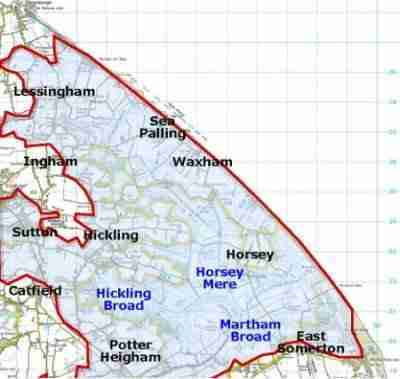
Furthermore, with rising sea levels and lowering river flows we are seeing an increase of saline water flowing up river and into the Broadland system, so soon Farmers may no longer be able to rely upon these sources for irrigation and/or for agricultural water supplies in the future. Much of the area depends upon riverine extraction in our increasingly dry Springs and Summers as droughts come about with climatic change. Thus the real loss of arable land yield could be far greater than just that stripped by erosion alone.
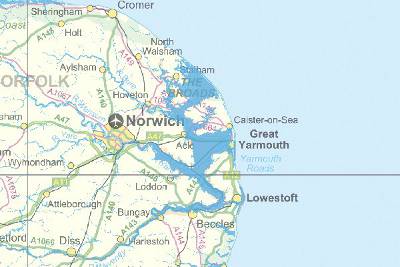
In the long term much of Norfolk, Suffolk, Cambridgeshire, Northants and Lincolnshire could be under the sea.
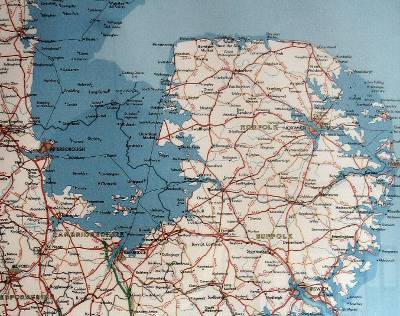
- Coastal Waste Toxic Tips.
The increasing loss of our land due to erosion will undoubtedly expose and wash out to sea from the shoreline a number of historic coastal waste tips. One such of particular threat is the unlined toxic waste tip at Gisleham Quarry, where a large amount of highly poisonous liquid was placed, including Mercury. What is even worse it also holds a large quantity of Chlorpiriphos, a deadly nerve toxin deposited by Cleanaway in the early 1970's.
This tip, close to the sea at Pakefield near Lowestoft, has already leached underground several hundred metres eastward to the sea. In 1989 it was estimated by Suffolk County Council assistant surveyor Colin Palmer that it would meet the ever nearing sea within 20 — 30 years.e.g. 2009 — 2019. Waveney District Council had proposed a contingency plan to safeguard the public by wiring off 8 miles of the coastline. (See at www.lickeyconcern.com/related/articles/a_crazy_decision.htm the item 'Timebomb Underground' from Surveyor of 14th December 1989 and my original article on this potential hazard by visiting http://members.aol.com/ruraleye/gowen4a.htm and also www.marinet.org.uk/coastaldefences/ourdisappearingcoastline.html for detail).
Coincidentally (?) in the past three years seven dogs have died during or immediately following being taken for a walk along Pakefield Beach. Their symptoms were highly characteristic of acetylcholine disruption considered to be brought about by organophosphate poisoning, There are other similar 'Special Waste' tips in Suffolk, many more still in Essex. It is thus essential that erosion is curtailed where such threats exist. - Nuclear Sites. Sizewell Beach upon which are sited the existing and now government promoted forthcoming nuclear reactors, is protected by the Sizewell Bank. Although neighbouring beaches and cliffs either side of Sizewell are eroding rapidly, Sizewell itself has up to now been fairly stable, thanks only to the interchange of beach material with the northern offshore sandbank which also protects the Sizewell 'A' and 'B' nuclear power plants from erosion and attack by wave action. Despite grave concern expressed in our opposition to granting a licence to dredge there by MARINET, aware locals and top world Coastal Geomorphologist Professor John Pethick, who recognise that the sand supply source to the shoreline comes from the Sizewell Bank, permission was given to dredge offshore sand and gravel aggregate. This is now ongoing, and a further application for further dredging has since been allowed. Professor Pethick stated "We must not dredge this bank, otherwise it will increase the erosion, the very reverse of what is required."
There exist other threats, but those given above should suffice to hopefully stimulate some consideration into government policies and a re-think of marine and coastal issues. Some of these are brought about by government inaction, and some by ongoing actions. The entire policy of the exploitation of our sea and seabed and the means by which it is licensed is in need of a vital revue, and has been ever since the government proposed a ban on marine aggregate dredging due to its proven coastal erosion impact over 100 years ago.
If members are able to lobby there own constituency MP's on this now serious issue, the resulting awareness and concern shown from numerous parliamentary constituencies may provoke debate and intervention, leading to a re-appraisal of the current system that permits and promotes the increasing hazard. We already have interest from several East Anglian MP's.
Canadian seal cull "unnecessary due to climate change"
Canada faces fresh calls to shut down its commercial seal hunt following new evidence that death rates among seal pups had dramatically increased due to thinning winter sea ice. The study, by scientists from Duke University and the International Fund for Animal Welfare, was the first to track declining sea ice cover in all four harp seal breeding grounds in the North Atlantic — with devastating effect.

A pup harp seal off the coast of the Magdalen Islands, Quebec, Canada. Photograph: David Boily/AFP/Getty Images
David Johnston, research scientist at the Duke University Marine Lab, said: "The kind of mortality we're seeing in eastern Canada is dramatic. Entire year classes may be disappearing from the population in low ice years. Essentially all of the pups die."
Satellite records of ice conditions since 1979 showed that ice cover had fallen by as much as 6% every decade. The research is published in the journal PLoS ONE. The loss of sea ice — and its threat to the future of seal populations — has been confirmed by Canadian government scientists, the International Fund for Animal Welfare said.
Up to 80% of the seal pups born in 2011 were thought to have died because of lack of ice, according to the department of fisheries and oceans. The study adds additional weight to the long campaign by animal protection groups against the seal hunt. IFAW said on Thursday that Canada should work towards ending the commercial seal hunt for good, compensating the hunters and retraining them for other jobs. "It is time for the Canadian government to face the reality that the commercial sealing is neither viable nor necessary," the organisation said.
Russia recently banned the import of harp seal pelts. The European Union allows only Inuit seal products.
Female harp seals depend on stable winter sea ice as a safe place to give birth and nurse their young, until the pups are grown enough to hunt on their own. The seals typically seek out the thickest, oldest patches of sea ice each February and March. The seals are able to adapt to short-term changes in ice conditions, Johnston said. But it was unclear the animals would be able to make a long-term move to new breeding grounds with more stable ice, such as those off east Greenland.
Thousands of seals still return each year to their traditional breeding grounds in the Gulf of St Lawrence or off Newfoundland — despite the declining ice.
"There's only so much ice out there, and declines in the quantity and quality of it across the region, coupled with the earlier arrival of spring ice breakup, is literally leaving these populations on thin ice," Johnston said. "It may take years of good ice and steady population gains to make up for the heavy losses sustained during the recent string of bad ice years in eastern Canada."
Spain faces crunch-time over CFP Reform
The incoming Spanish government is coming under intense diplomatic pressure to fall in line with EU proposals to ban wasteful fishing practices, after a leaked document showed that the previous administration was planning to derail the plans. The government must choose between supporting its new allies in the EU, on which Spain's economic future depends, or bowing to its powerful fishing industry.

Spain's former government, led by Rodriguez Zapatero (above), lobbied for the continuation of discards. Photograph: Ezequiel Scagnetti/Reuters
As Europe's biggest fishing industry, Spain could hold the key to the success or failure of the reforms, which would prevent fishermen discarding edible fish at sea. But according to a secret government document seen by the Guardian, Spain's previous administration was plotting a last-ditch attempt to bring down the reforms, and allow Spanish fishermen to continue throwing away edible fish as they have been doing so for decades.
The document is dated 2nd November, just weeks before the general election of 20th November, showing that lobbying for a continuation of discards was a key policy for the outgoing socialist government even in its dying days.
Hugh Fearnley-Whittingstall, the chef and Guardian food writer who has led the high-profile Fish Fight campaign against discards, said: "Throwing away thousands of tonnes of perfectly edible fish is completely unacceptable — and I'm sure that if the Spanish public knew about the scale of the problem in their fishing fleet, they too would demand an end to discards, and support a radical overhaul of the EU's common fisheries policy." He said that early in 2012, the campaign, which Europe's fisheries chief Maria Damanaki has credited as an important factor in generating public support for her anti-discards policy, would be extended to the rest of Europe.
Fearnley-Whittingstall said: "We're planning to launch our Fish Fight campaign in Spain, as well as in France, Germany and Poland. We need to get the whole of Europe as outraged about this senseless waste of fish as we are here in Britain. Then perhaps the Spanish government will spend more time working towards developing a sustainable and effective solution to the discards problem, rather than trying to build alliances to derail the proposed reforms."
If the new government reverses the stance of its predecessor, it would mark a major victory in the fight to end discards, which result in European fishermen throwing away — dead — as much as two-thirds of their catches of live, edible fish.
Discards are a perverse result of the current EU fishing policy: whenever fishermen accidentally land fish for which they have no quota, or when they exceed their quota, they must throw part of the catch away. Nearly three-quarters of the EU's fish stocks are now estimated to be overexploited. As Europe's biggest fishing nation, Spain is in pole position to obstruct or water down the reforms, which are aimed at protecting dwindling fish stocks and which the European Commission wants to finalise in 2012.
David Ritter, oceans campaigner at Greenpeace, said the current quota system was "indefensible", and the leaked Spanish policy document showed the sort of attitudes that must be overcome if radical reform of the Common Fisheries Policy was to succeed. He said: "[This is] a broken system that is destroying Europe's marine environment and the fishing industry that depends on it." He called on David Cameron to join in the fight against discards. "Cameron needs to give his full support to Richard Benyon [UK fisheries minister] in Europe. Our national interest isn't contained by the M25 — it extends to our coastal communities, and they're under severe threat [if the Spanish government opposes an end to discards]," he said.
There is all to play for in the next few days as the incoming Spanish ministerial teams work out their detailed policy responses. While the country's dire economic state will take precedence, fishing is a major economic and social issue for Spain, home to Europe's biggest fishing fleet in terms of volume, taking up more than a quarter of the EU's total fishing capacity and employing tens of thousands of people directly, and many more indirectly. The new ministers will be under huge pressure from the powerful Spanish fishing lobby to oppose the reforms. Although many fishermen support ending discards, because they hate the waste of throwing back edible fish to die, some want to continue the practice because it allows them to maximise their profits, by throwing away lower value fish and leaving room in their quota for higher-priced fish.
The extent of fish industry lobbying is shown by the secret document seen by the Guardian. It said that Spain wanted to retain discards as a way of allowing its fishermen to land only the most valuable fish, killing hundreds of thousands of healthy and edible fish in the process. The document said eliminating discards was "not realistic" and instead opted for a reduction in discards "with a gradual approach" that should be varied according to each region — meaning get-out clauses for large sections of the Spanish fleet.
The document said: "The terms and deadlines [on discards] are not realistic, particularly for specific sections of the Spanish fleet. Spain requests that this discards policy be set out in terms of reduction, with a gradual approach, rigorously planned and over a period no shorter than ten years. Furthermore, this will have to be implemented regionally, taking into account the different causes for discards in different fisheries."
The European Commission wants to change fishing quotas in order to reach a scientifically set "maximum sustainable yield" for all fisheries by 2015. But the previous Spanish government wanted to move this deadline to 2020.
From the document, it is clear that the previous administration in Madrid planned to cite the country's economic woes as an argument for watering down the reforms. But the European Commission has repeatedly said that allowing the exploitation of Europe's seas to continue at the current rate would store up economic problems for the near future, as stocks would decline further and fishermen find their livelihoods in peril as a result.
Maria Damanaki, the EU fisheries commissioner, has repeatedly said that urgent action must be taken for stocks to be preserved. On formally presenting her reform proposals this summer, she said: "Action is needed now to get all our fish stocks back into a healthy state to preserve them for present and future generations. Only under this precondition can fishermen continue to fish and earn a decent living out of their activities." She added: "It is not too late for the situation to be reversed, but we have now reached a crisis point. Overfishing must cease or there will be no more fish on the plate."
The European Commission has proposed compensation for fishermen, and ways to use the catch more efficiently, for instance by encouraging consumers to move away from the over-consumption of a few species, such as cod and haddock, to a wider range of fish that are currently undervalued. Damanaki has also proposed novel alternatives, such as trial projects for fishermen to sweep up plastic detritus from the seas instead of fishing, and to use their boats for tourism.
One Bluefin tuna fish sells for nearly £500,000
A Japanese restaurateur has parted with almost half a million pounds for a single bluefin tuna at the first auction of the year at Tokyo's Tsukiji market. Kiyoshi Kimura, who runs a chain of sushi restaurants, paid 56.5m yen (£473,000) for the 269-kg fish, which carries enough flesh for an estimated 10,000 pieces of sushi.
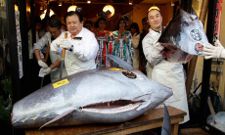
Kiyoshi Kimura, left, cuts the bluefin tuna outside his Sushi Zanmai restaurant in Tokyo. Photograph: Shizuo Kambayashi/AP
The sum is almost twice the 32.49m yen paid at last year's opening auction, a largely symbolic affair and not — diners will be relieved to hear — an accurate reflection of wholesale fish prices.
Japan has come under pressure to decrease its catch of Pacific and Atlantic bluefin, whose stocks have reached dangerously low levels, according to campaigners.
Kimura, however, said he has made his record-breaking bid in an attempt to "liven up Japan" as it attempts to recover from last year's tsunami. "Japan has been through a lot the last year due to the disaster," he said. "It needs to stay strong. That's what I tried to do and I ended up buying the most expensive one." The businessman, who runs the Sushi-Zanmai chain of 46 restaurants, also claimed he was acting on behalf of home-grown sushi lovers, who for the past three years have seen the first big fish of the season snapped up by overseas bidders.
Last year, the Hong Kong restaurateur Ricky Cheng joined forces with an upmarket sushi restaurant in Tokyo to produce the winning bid. But this year Kimura said his restaurants would slice up and serve the entire fish — caught in Oma off the northernmost tip of the main island of Honshu — in Japan, rather than let it go overseas.
Although the restaurant needs to sell each piece of sushi for more than 6,000 yen to break even, Kimura is already selling prized slices of fatty otoro for a far more affordable 418 yen each, with the cheaper akami cuts going for about 130 yen apiece. "It's unbelievable, Kosuke Shimogawara, a diner, told Associated Press. "President Kimura is so generous. All I can say is thank you."
Japan consumes about 80% of Pacific and Atlantic bluefin tuna, and has been accused of stifling international attempts to dramatically reduce fishing quotas or ban the trade altogether.
Pale octopus, hairy-chested yeti crab and other new species found in Southern Ocean
A world of previously unseen creatures has been found thriving next to boiling vents of water, several miles under the surface of the Southern Ocean near Antarctica. Hundreds of hairy-chested yeti crabs, a mysterious-looking pale octopus and colonies of limpets, snails and barnacles were found by British scientists at a hydrothermal vent located in the ocean's East Scotia Ridge.
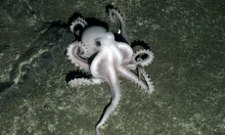
A pale octopus found in the Southern Ocean, near Antarctica. Photograph: Oxford University/PA
Prof Alex Rogers of Oxford University used a remotely operated vehicle called Isis to scout the sea bed around the ridge, which spans about 2.4km and features springs of black, smoky water that can reach temperatures of almost 400C (752F). The hydrothermal vents are powered by underwater volcanoes, and the scalding temperatures and rich mineral content of the water gives rise to vast rocky chimneys that support a wide variety of life forms.
"The visually dominant species are the yeti crabs, which occur in fantastically high densities, up to 600 per square metre around the southern ridge," said Rogers, who led the expedition aboard the RSS James Cook in January 2010. "Also high densities of stalked barnacles, a large snail from a group called the peltospiroids, and we've also got small, green limpets which occur all over the vents."
The first-known yeti crab, Kiwa hirsuta, was described living near a hydrothermal vent in the south pacific in 2005 and, since then, several species have been discovered in different parts of the undersea world. Around other hydrothermal vents, however, these creatures tend occur in lower numbers; and the new species found in the ESR are not only more numerous but also visually distinct.
"Hirsuta has long hairs on its limbs and its claws, whereas our yeti crabs have extremely hairy chests. One of the nicknames of the crabs which developed during the cruise was the Hasselhoff crabs because they had these dense mats of [hair] on their undersides, the equivalents of their chests."
Another striking creature spotted by the scientists was a pale octopus, which was photographed by the team. Rogers suspected it might be a new species related to the Vulcanoctopus hydrothermalis seen at other underwater vents around the world.
In total, the expedition brought back more than 12,000 samples of rocks, bacteria and animals. Rogers said: "One of the staggering things we did find is that these vents are completely different to those seen anywhere else — the animals existing at these vents are almost all new to science," he said. The findings have been published in the journal PLoS Biology.
"What we didn't find is almost as surprising as what we did," said Rogers. "Many animals such as tubeworms, vent mussels, vent crabs, and vent shrimps, which are found in hydrothermal vents in the Pacific, Atlantic, and Indian Oceans, simply weren't there."
Last week, scientists at the University of Southampton announced the discovery of new creatures in the so-called "Dragon Vent" in the south-west Indian Ocean. Dr Jon Copley, a marine biologist at the University of Southampton who led the exploration of the Dragon Vent and is also an author on the latest PLoS Biology research paper, said that exploration of the world's deep-sea vents was a race against time.
"The exploitation of the deep ocean is overtaking its exploration. We're fishing in deeper and deeper waters, oil and gas is moving into deeper waters and now there's mining starting to take place in deep waters. We need to understand how species disperse and evolve in the deep oceans if we're going to make responsible decisions about managing their resources."
Rogers added that the vents revealed much about how deep water communities have evolved, and how they are distributed across the world's oceans. "In the space of a single eight-week cruise, we've changed our level of understanding of these systems completely. We've changed our ideas about how vent systems are distributed and the factors that may influence that distribution. What that tells us is that our level of knowledge of the deep sea in general is extremely poor indeed."
He added that hydrothermal vents had already changed the way scientists thought about how life exists on earth. "They told scientists that life could exist in the absence of sunlight — you could have food webs based on mechanical energy. They were also informative about the extreme conditions under which life could exist, they told us about where else in the universe life may occur. Hydrothermal vent biology has stimulated a whole new science of astrobiology."
€3 billion plan to protect Belgium's coast against North Sea sea-surge
Ostend residents no longer see the poetic side of the town's broad sandy beach, immortalised by the French singer Léo Ferré. These days the North Sea is increasingly a source of anxiety and Ostend a multicoloured building site, throbbing with bulldozers, diggers and dredgers.
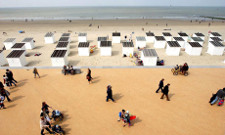
Regional authorities say about a third of Ostend's heavily populated coastline is inadequately protected against flooding. Photograph: Tanguy Jockmans/Rex Features
The Vlaams Gewest (Flemish) region has launched a coastal safety master plan, and at several points along the 67km coast work has already started to reshape beaches and dunes, reinforce breakwaters and raise protective walls.
Erosion, heavy rainfall, storms and rising sea levels due to climate change are fuelling fears for the medium-term survival of this part of prosperous Flanders. The shape of the Belgian coastline, a segment of the concave eastern shore of the North Sea running up from France towards the Frisian Islands, makes it even more fragile.
Not only is Vlaams Gewest a popular location for holidays and leisure activities, it is also densely populated. An industrial area, it has two ports, Ostend and Zeebrugge, open to shipping and pleasure boats, and two others, Nieuport and Blankenberge, just for leisure activities. It has four nature reserves as well, the most famous being Zwin, close to Knokke, now the most upmarket resort on what has been officially renamed the Vlaams Kust (Flemish coast), in place of the Côte Belge.
According to the regional authorities, about a third of the coastline is inadequately protected against flooding or a storm equivalent to the 1953 disaster, the most destructive to have occurred in the 20th century. So what would happen if nothing is done? "Potentially the loss of 250 lives and damage in the region of €2.1bn [$2.7bn]," says Nathalie Balcaen, a coastal development engineer.
The water would quickly flood a strip of polder (wetlands) about 20km wide, lying just inland, and could spread as far as Bruges. The motorway down to Ostend and Dunkirk would also be engulfed.
At the present rate of greenhouse gas emissions, climate change is forecast to cause a 30cm rise in the level of the North Sea by 2050, adding another 30cm by the end of the century. This is a direct threat for about 16 million residents of the various countries along its coast. In Flanders, experts are studying the risks entailed by a severe storm and the likelihood of 5m waves punching holes in the dykes.
Philippe Konings, a specialist in geomorphology at Ghent University, says: "a storm on this scale will happen some day". As things stand it would destroy part of the coastline. The resorts at Blankenberge and Wenduine are under immediate threat, and port facilities would be particularly badly affected. The top priority is to protect the weakest links by 2020, by raising various beaches, protecting the entrances to ports and building stone walls designed to break the force of the waves.
It has become "a sort of routine", jokes Denis Seurynck, of the Deme dredging firm, a world leader in this business, with a workforce of 4,000. Its fleet is at work all over the world, often in waters far more hostile than the Belgian coast, where the only real difficulty is steering ships round the countless sandbanks. The dredgers suck up sand from the seabed and deposit it on adjoining beaches.
The cost of the work currently under way is estimated at a modest €300m ($390m), and a group of Flemish industrialists are proposing far more radical solutions. Their plan would cost an estimated €3bn, and would include a sustainable initiative to reduce the pressure on this heavily exploited area. The scheme includes wind farms, artificial islands and even an airport for freight. Policy makers have so far not responded.
Sea Shepherd uses airborne "drones" in its Southern Ocean whaling campaign
Environmental activists in the rough Antarctic seas have launched a new tool in the fight to stop a Japanese operation to kill hundreds of whales — remote-controlled drones.
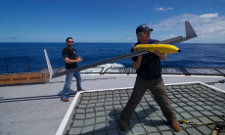
The drone is launched from the deck of the Steve Irwin
Every morning for the past week, a battery-powered drone with a range of 300km (190 miles) has been launched from the MV Steve Irwin, which is attempting to disrupt the annual Japanese whale hunts in the waters off Antarctica. "We first found the Japanese fleet when they were 28 nautical miles away," said Paul Watson, founder of the Sea Shepherd Conservation Society, an international marine wildlife protection group based in the United States.
Subsequent attempts by Japanese whaling ships to block the anti-whaling flotilla and allow the whale factory ship Nisshin Maru to escape were foiled by the activists, who repeatedly launched the drone, which uses GPS co-ordinates and provides both video and still images to track the whaling ships.
"Our helicopter pilot, Chris Aultman, has been lobbying for this technology for the past two years and now that we have this 'eye in the sky' it makes it much harder for the whaling fleet to escape," said Watson in a telephone interview from the Steve Irwin. "The other day they switched back from east to west and we detected this with the drone."
Watson has 88 crew on three ships, two of which are equipped with drones. They act as spotters, finding the whalers in the vast expanse of ocean and allowing Watson's ships to home in on them. Watson has embarked on his annual expedition to stop the slaughter of thousands of whales — the Japanese consider this to be scientific research while critics call it cruel and archaic. "Last year they had a quota of over 1,000 whales and only caught 16%. We saved at least 800 whales," said Watson, who has been known to ram the Japanese boats as part of his anything-goes tactics.
The advent of new technologies such as drones may finally put an end to the Japanese hunt, said Watson, who is also bringing publicity to the cause in Whale Wars, the Discovery channel documentary series that tracks the hunts: "Our goal is to bankrupt them and destroy them economically. Now that we can track them, it is getting easier."
Once exclusive to Israeli spy forces and the US air force, drones and other types of unmanned aerial vehicles (UAVs) are being sent on civilian missions such as crop inspections or marine mammal surveys. In April, drones hovered inside highly radioactive areas at Japan's Fukushima Daiichi nuclear power plant and recorded data from areas too dangerous for humans to enter.
Federal bodies in the US, including the Federal Aviation Administration (FAA), are scrambling to monitor the burgeoning industry. According to the Los Angeles Times, the FAA will issue proposals this month to clarify rules for the use of UAVs in civilian and commercial roles. While drones used to cost hundreds of thousands of pounds, some are now available for less than £500. The unit used by Sea Shepherd is a highly durable model known as the Osprey, which can run for hundreds of hours.
It was given to Sea Shepherd by Bayshore Recycling, a New Jersey-based solid waste recycling company committed to environmental protection. In addition to paying for the drone at an estimated cost of £10,000, Bayshore also paid for pilot training to run the remote control equipment. "Everyone here at Bayshore is thrilled with the Sea Shepherd's news of not only saving the lives of many whales, but knowing our drone will continue to track the Japanese whaling fleet in this chase," said Elena Bagarozza, marketing co-ordinator at Bayshore.
Watson expects drones will be used to patrol environmentally sensitive areas ranging from the Galapagos Islands to other famed wildlife areas, including South Africa's Kruger National Park. "There is huge potential and great value in this technology — for our expedition it is wonderful," said Eleanor Lister, 20, a Sea Shepherd crew member from Jersey, who spoke by satellite phone from aboard the Steve Irwin from a location that, she said, "was about 1,000 miles south-west of Australia". She described the daily routine that begins when the ship's first mate holds aloft the Osprey drone, then tosses it into the headwinds. After tracking the Japanese whalers, the drone ends its mission as it homes in on the Steve Irwin and is flown into a thick net, where crew members inspect it for damage and download the video and photographs from the latest mission.
Despite severe weather in the Antarctic, the drone has flown dozens of flights and had no problems so far with ice build-up on the wings or trouble negotiating the gusty winds. "The Osprey is comfortable in the wind and can handle 40 knots," said Jimmy Prouty, systems engineer at Hangar 18, the Kansas-based company that manufactures it. "This unit is waterproofed and has multiple security backups so that if it has problems or low battery it automatically returns to base."
Exceptional marine algal event covers seafront near Blackpool in foam
A thick white blanket settled gently on the seaside town of Cleveleys, near Blackpool, but this was no seasonal dusting of snow from above.
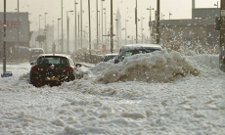
There's no place like foam… Cleveleys, near Blackpool gets in a lather with foam blown in from the ocean. Photograph: MEN Syndication
The Environment Agency dispatched officers to Princess Promenade to gather evidence as gobs of foam blew in from the sea and smothered streets, cars and houses. The foam is whipped up by strong winds once or twice a year along the town's seafront and vanishes soon after, a spokeswoman for the agency told the Guardian.
Lab tests on samples collected in earlier years have found no signs of pollution. Decomposing algal matter is the prime suspect for the mysterious lather.
"It appears to be naturally occurring. When the tides and winds combine to churn dead algal matter up from the bottom of the sea, it produces this foam, which is quite dramatic," the spokeswoman said. Officers visited Cleveleys on Wednesday and again on Thursday to collect more specimens to analyse. The results of the tests are expected to confirm the foam is natural and not caused by detergent in seawater or other pollution.
By studying the foam, the agency hopes to learn how and why it forms and so predict when the froth will return. "If we can understand what conditions cause it, that will help us predict it and help local authorities involved in the clean-up operations," the spokeswoman said.
East Anglian Film Archive film of the last major North Sea surges
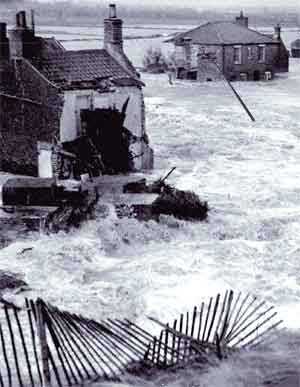
Readers may wish to view a thirteen minute film of the disastrous 1953 East Anglian Sea Flood just made available by the East Anglian Film Archive. Just as now, the flood defences were allowed decay and be lost, resulting in a huge inundation from a major North Sea Surge. For details of the mechanism of North Sea Surges please visit 'Sea Flooding 1' at the Norfolk RAYNET Website.
It will bring back memories of fifty-nine years ago to many mature people, and hopefully act as a stark warning to those who are now aiding and abetting the loss of our sea defences.
Another worth seeing from the same East Anglian Film Archives is The Horsey Mail which is a Post Office film showing how the mail got through in the previous major 1938 sea flood.
Now New Zealand's 'Worst Maritime Disaster'
Yet another major oil polluting incident was reported by BBC News Asia on 8th January 2012 when the Greek owned cargo ship 'Rena' grounded on the Astrolabe Reef off Tauranga, North Island New Zealand on 5th October 2011, then broke up, spilling its cargo including a significant volume of oil to sea.
Maritime New Zealand report that they were unsure as to the precise loss, but container recovery company Braemar Howells said it believed 200-300 containers of the some 800 which had remained on the ship went overboard when the ship split, and whilst salvage crews have removed more than 1,100 tons of oil from the stricken vessel, some 385 tonnes remain onboard. Already hundreds of tonnes of tonnes of fuel have spilled into the sea, killing more than 20,000 seabirds in the area.
It seems that most of the worlds problems, be they economic, military, political, social, ethical or environmental, emanate either directly or indirectly from oil these days.
MARINET addresses e-petition to UK Fisheries Minister : CFP reform must restore "food security" and historic levels of fish stocks
The message from MARINET and members of the public supporting its new e-petition on Common Fisheries Policy (CFP) reform is that current fishing practices in Europe have pushed us to the edge. If they continue unchecked:
- Fish species — like cod, tuna, mackerel and herring — will become extinct.
- The marine ecosystem which supports them will collapse and never return.
The rules governing European fishing — known as the Common Fisheries Policy — are now being rewritten. And most importantly, the UK Government is directly involved in this rewriting and reform process.
To comply with EU law, the rewritten rules have to ensure that all commercial fish stocks are restored to a sound and healthy condition by 2020. However at the moment, the European Union's proposals only aim to keep fish stocks at their current, much depleted levels.
The UK Government is a key player in the negotiations which are currently hanging in the balance. This is why MARINET has drawn up an e-petition which tells the UK Fisheries Minister, Richard Benyon, to do all he can to make sure:
- CFP reform re-establishes food security
- Fish stocks are restored to historically referenced levels
- The new rules for the CFP follow EU law, and
- Fish stocks are restored to a sound and healthy condition by 2020
The e-petition reads:
"Dear Minister,
"I understand that you are involved in negotiations around reforming the Common Fisheries Policy (CFP).
"I'm sure you are aware that nearly 90% of all commercial fish stocks are over-fished in European seas. And of the very real threat of extinction to most common commercial fish species — like cod, tuna, mackerel and herring — and the ecosystem which supports them.
"Indeed, cod is now extinct in the North West Atlantic because of similar practices.
"The EU's Marine Strategy Framework Directive requires that by 2020 'populations of all commercially exploited fish and shellfish are within safe biological limits, exhibiting a population age and size distribution that is indicative of a healthy stock' (Ref. MSFD, Annex I).
"Yet, in discussions on CFP reform, the EU is calling for maximum sustainable yields (MSYs) to be based on current depleted levels of stocks, rather than historically referenced levels (i.e. prior to over-fishing).
"That risks contravening EU law by making it impossible for fish stocks to return to healthy levels. It would also hamper both the re-building of the fishing industry, and our marine food security.
"Please can you reassure me that you'll be pushing for the new CFP to follow EU law and for any MSYs to be based on historically referenced levels of fish stocks."
To sign the petition, visit www.foe.co.uk/campaigns/biodiversity/press_for_change/fish_extinction_33701.html
Defra is looking for contractors to establish the scientific basis for "recommended MCZs"
Defra needs to collect new evidence from a number of pre-defined recommended Marine Conservation Zones (rMCZs) during the 2011/12 financial year (FY2011/12).
Cefas as an executive agency of Defra, has been appointed by Defra to act as R&D Programme Managers for this work. Cefas' main responsibilities are to co-ordinate the collection of scientifically robust and cost-effective R&D evidence from within a selection of rMCZs during the remainder of FY2011/12, and to manage the delivery of the resulting survey / data outputs. The work will be undertaken via marine R&D surveys and the programme will be conducted in close consultation with Defra, Natural England, JNCC and the Environment Agency.
In order to successfully deliver survey requirements for FY2011/12, Cefas is inviting expressions of interest (EOI) from contractors who can provide vessels and/or technical staff and/or equipment capable of undertaking R&D multibeam and biological validation surveys during February and March 2012.
Where possible, Cefas' preference is that any multibeam data that is collected under this programme of work will meet IHO Order 1A specifications. Biological validation will entail the use of grabs and/or corers suitable for sampling in particular substrates, and also the deployment of drop-down and towed video/stills techniques using recognised guidance. R&D surveys may be conducted from the intertidal zone through inshore estuarine and coastal waters, to offshore areas in all geographic regions of English waters. Any intertidal work will be limited to field sampling techniques appropriate for habitat surveys on both soft and hard substrates, rather than remote methodologies (e.g. LIDAR, aerial photography).
Cefas is aware that there may also be a number of useful datasets that have already been collected from within rMCZs. As part of this EOI exercise, Cefas is inviting contractors to identify relevant datasets they may own that they may wish to make available as part of any future competitive tendering exercise.
It is expected that a competitive tender exercise will be conducted during January 2012 and following a short tender deadline contractors appointed to commence work in February 2012. All survey work should be completed by 31st March 2012.
Cefas may choose to appoint contractors for one or all of the following:
- Provision of vessels
- Provision of scientific marine survey expertise
- Provision of scientific intertidal survey expertise
- Provision of survey equipment
- Provision of existing datasets
MARINET observes: We believe it is most important that Marine Conservation Zones (MCZs) are designated on a sound scientific basis, indeed science forms the foundation of properly designed and managed conservation, and therefore Marinet welcomes this step by Defra.
However, we do have to point out that this process is back to front — the scientific basis for the identification and validation of sites should have led the MCZ identification process, and not now be applied after the MCZs have been nominated by the regional Stakeholder Groups for consideration by the Minister.
This back to front process highlights a serious weakness in the UK's proposed network of Marine Conservation Zones.
These sites were meant to be designated on the basis of those places which are of most importance in scientific (conservation) terms; and yet, the sites which we now actually have are what has been left over after economic interests have ruled out substantial areas of the sea for MCZ designation because they conflict with their interests.
Moreover, these sites were meant to be "ecologically coherent" — that is to say, the sites of greatest importance in terms of scientific (conservation) need were meant to be linked and knitted together as a network which would serve a wider ecosystem function which viewed the MCZ exercise as protecting the ecosystem as a whole in our seas.
However because what we have is set of second choice sites MCZs, whose scientific basis is, in all too many cases, vague (hence the Defra programme) it is clear that their function in terms of "ecological coherence" is uncertain, and second-rate at best.
MARINET has continually argued throughout the MCZ identification process that the process should be scientifically-led. This is what the Minister assured Parliament would be the case at the time of the Marine and Coastal Access Act's enactment in 2009. However the identification of MCZs has actually been led by economic interests, and only now is the science being seriously applied.
MARINET has tried hard to secure the primacy and integrity of the scientific procedure in the MCZ identification process, asserting the vital importance of this principle to the current Minister and Defra officials, the statutory nature conservation agencies (Natural England and JNCC) and to other marine NGOs.
However whilst it might not be true to say that the call to uphold this principle has fallen on deaf ears, it is certainly evident that those who have been implementing the MCZ identification process have not been in a consistent position that has given primacy to the science. The present situation is the clear evidence that proves this statement.
It is to be hoped that the scientific process now about to be implemented will go some way, indeed it is to be hoped some large way, to redeeming the situation. Nevertheless one cannot help feeling that marine conservation for the UK's seas has been "short changed" in terms of its integrity and currency.
Our seas are under enormous pressure from mineral exploitation and over-fishing, and the marine ecosystem as a whole is in a poor condition and is a pale shadow of its former self. The Marine Conservation Zone process was meant to go a substantial way towards pulling our seas back from this state of perilous decline, but the culture of exploitation for economic gain over the protection of the integrity of the marine environment still remains dominant, and has managed to keep marine conservation firmly confined to the back seat.
We still have a great deal to learn and understand — our economic wealth depends on a sound environment. A clean, healthy and biologically productive environment is the source of our own health and wealth, and a degraded environment can only lead to our decline into poverty.
Therefore in terms of sustainable definitions of society and economic activity, it is absolutely essential that the health of the environment is given primacy because our own wealth and health stems from, and originates from, and is dependent upon the sound health of the environment.
This is why conservation is so important and central to our current situation and economic ethic. And, this is why the decline in our seas, and the disappointing delivery of the conservation process that we have waited so long for in order to protect our seas is such a grave matter. We do indeed play with peril. The meaning of conservation and the lesson it teaches remains unlearnt or, at best, misunderstood and misapplied. We cannot go on in this manner forever. At some point, we have to change. Or events will do that very harshly for us.
Government backs loss of vital Wildlife protection
In his Autumn statement Chancellor George Osborne clearly showed his intention of defying the European Habitats Directive when he announced (quote) "That the gold-plating of EU rules on things like habitats" was holding back British industry. This was immediately followed by DEFRA deferentially announcing a review of how the EU Habitats and Birds directives are being applied in England, with (quote) "a view to reducing the burdens on businesses". Coming as this does from a regime whose pre-election pledge was to be 'the greenest government ever' shows contempt for any promises and undertakings made prior to its election, although Environment Secretary Caroline Spelman still claims that the government is 'determined to maintain the integrity of the habitats and birds directives while freeing British firms from excessive bureaucracy' — hardly a compatible objective!
The proposals provoked outrage among conservationists, environmental groups and wildlife trusts charities, who fear the government's relentless drive for financial growth at the expense of our natural heritage could cause lasting damage to both the environment and the multi-million pound tourism industry which depends on it. Norfolk Wildlife Trust chief executive Brendan Joyce said: "We are not standing in the way of progress. We should have modern networks and housing and we do need economic security, but to be prepared to trash the wildlife jewels in the crown for the sake of it seems to me to be crazy."
But, rather as could be expected, the review was warmly welcomed by business and landowner representatives, who could profit well from the exploitation likely to result, such as the conversion of greenfield and wildlife areas to building sites and the industrial use of previously safeguarded areas. It is probable that the current legal protection of these could be taken away and self-regulation provided, so allowing developers a free hand to convert to their own wishes.
Isle of Wight offshore oil drilling licence awarded
Northern Petroleum Plc announced 5th January 2012 that they have been awarded the rights to carry out oil drilling operations in two areas off the shores of the Isle of Wight.
Initially exploration will be carried out there, "to evaluate the oil and gas potential of the mapped well-defined prospect that extends from the Isle of Wight into the English Channel," say the company. They add, "There is no firm drilling commitment attached to the licence award."
The area extends from the shoreline of the Island on the South West, along the line of the Military Road. Its outer boundaries form the other two sides of a large triangle. Part of it attaches to the company's onshore licence (PEDL 240) area on the Island, which they gained in May 2008.
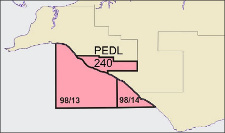
Map of area
Appearing sensitive to concerns about carrying out works in an AONB, Derek Musgrove, Managing Director of Northern said, "Northern recognises that the prospect is in an Area of Outstanding Natural Beauty (AONB) and a Heritage Coast. At Northern we well understand the attendant challenges that are posed in conducting field operations in an environmentally safe and responsible manner. To date, Northern has an exemplary track record for its drilling operations, the most recent of which was Markwells Wood-1, completed in January 2011, which is currently undergoing flow testing operations in West Sussex."
A new company, NP Solent Limited, is being formed to carry out the business. This will be the majority licensee, alongside four other companies.
EU Commissioner calls for natural resources, like fish, to be used more responsibly
The overuse and waste of valuable natural resources is threatening to produce a fresh economic crisis, the European Union's environment chief has warned.
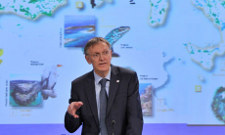
The EU environment commissioner Janez Potocnik says resources like water, fish and precious metals need to be used more responsibly. Photograph: Georges Gobet/AFP/Getty Images
Janez Potocnik, the EU commissioner for the environment, linked the current economic crisis gripping the eurozone with potential future crises driven by price spikes in key resources, including energy and raw materials.
"It's very difficult to imagine [lifting Europe out of recession] without growth, and very difficult to imagine growth without competitiveness, and very difficult to be competitive without resource efficiency." Unless consumers and businesses take action to use resources more efficiently — from energy and water to food and waste, and raw materials such as precious metals — then their increasing scarcity, rising prices and today's wasteful methods of using them will drive up costs yet further and reduce Europe's standard of living, Potocnik warned. He said: "We have simply no choice. We have to use what we have more efficiently, or we will fail to compete. Resource efficiency is a real competitiveness issue for European companies."
Some European regulations will have to be altered in order to ensure the efficient use of energy, water and raw materials, and to protect the natural environment.
Potocnik gave notice that his department was scouring through existing regulations and proposed new ones in order to ensure that none would encourage resources to be used profligately, and to safeguard the EU's natural resources for the future.
The stark warning highlighted the increasing scarcity and rising price of some key resources, including energy and water, but also food and raw materials from metals, ores and minerals. Although most of the west is still mired in economic woes, much of the developing world including rapidly emerging economies such as China and India are forging ahead financially, and as a consequence are consuming a far greater share of the world's resources. The current economic models used by businesses and governments have failed so far to take this rapid change into account, and one of the associated problems is that many business models are predicated on cheap resources and an inefficient use of raw materials and energy.
"This is an issue of competitiveness," Potocnik said. "China is understanding that this is a mega-trend. We can't ignore it." Resources are under increasing constraint, as developing countries lift more of their population out of poverty. "If our current living standards are to be maintained, and the aspirations of developing countries satisfied, then the global economy will need to be changed drastically," Potocnik said. "If we want things to stay the same, things will have to change." He added: "This will be an enormous pressure on resources, which we are already overusing."
Labour costs now make up a much smaller proportion of most manufacturers' overheads than the cost of raw materials and energy, according to Potocnik. A greater proportion of those resources is also coming from overseas, with the attendant potential problems around security of supply. "Europe is importing more than half its resource use in many areas," he said.
Concerns have grown in recent months over the supply of some key resources, such as rare earths. These are used in many modern products, from mobile phones to renewable energy equipment, but the supply is small and China controls many of the sources. China has about a third of global rare earth deposits in its territory, but it accounts for nearly all of the production because of its efforts in this key market. Recently, the Beijing government has made moves to reduce exports, in order to help its indigenous manufacturers, and this trend has worried western governments. But these supply constraints are not yet fully priced in to world markets, and while the economic crisis continues the issue is likely to remain overshadowed — which could lay up future problems, according to the European commission.
"There are real problems with security of supply and this is not yet on the radar screen," Potocnik said. Potocnik called for resource use to become a "mainstream" issue in economics. Recalling his own education as an economist, he noted: "I was taught that water was a free commodity, like air. We really do need to have the internalisation of these costs."
"SMP application breaches Human rights" says Hopton Chairman
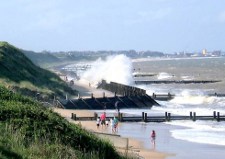
Hopton Beach taken July 2001 — now much reduced
Brian Hardisty, Hopton parish councillor and chairman of Hopton Coastal Action Group (HCAG) says that if Great Yarmouth Borough Council (GYBC) (in partnership with Waveney District Council) fails to protect a score of cliff-top homes and businesses from the sea then human rights will be breached by their discriminatory policy made under the auspices of the Shoreline Management Plan. This is to allow the coast to retreat through a policy of 'managed realignment' once the sea defences fail, *** so allowing fifteen properties to be lost to the sea by 2015 as well as five seafront properties including the major Bourne Leisure and the Potters Leisure resorts lost by 2055 (Although MARINET believes that this could come about much sooner).
Even when looked at in purely economic terms this policy appears rather surprising when it is known that Hopton brings in revenue of £10m to the local economy each year, plus 1,000 jobs from holiday resorts. Yet similar situations exist along many parts Great Yarmouth area coastline and much more in greater East Anglia.
The HAAC Chairman says that if he is able to raise the financial backing he would take the Great Yarmouth Borough Council to the European Court of Human Rights for breaching the Article 14 (discrimination) of the Human Rights Act 1988.
*** 'Allow the coast to retreat through a policy of 'managed realignment' once the sea defences fail' is Orwell-speak meaning 'do nothing to address the cause or to attempt to save the shoreline and vital infrastructure, but just to surrender everything to the eroding shoreline and encroaching sea'.
RSPB Concerns on MCZs
Mike Jones, Marine Conservation Officer of the RSPB, believes the MCZs will fail to create a coherent network of protected areas if there are no sites looking after seabirds in the North Sea, so has called for seabirds to be protected in plans to create a number of marine conservation zones (MCZ) along the Norfolk coast. He said "We were very shocked that seabirds were not going to be included. You cannot have an ecological coherent network if it doesn't protect all the wildlife… marine conservation zones are the foundation stone for a healthy marine environment. If we look after the environment this will protect the micro organisms at the bottom of the food chain upon which everything else feeds. The predators feeding higher in the chain will then thrive. What we now need is the protection of some important cetacean and seabird feeding areas not covered by current legislation".
As it stands some seabirds (and mammals, e.g. dolphins and seals) will not be safeguarded at sea under the projected MCZ policies, which fail to include Norfolk's little tern colonies. In the UK, the Little Tern is afforded some degree of protection through its inclusion on Schedule 1 (part1) of the Wildlife and Countryside Act 1981. In Europe, it is included in the Species of European Conservation Concern (SPEC) list, classified as SPEC 3. Over half of Britain's Little Tern population breed in coastal colonies in East Anglia, obtaining their food as small fish and invertebrates collected from feeding areas within 3 to 4km from the breeding site.
Peoples concern over seabird protection has led over 3,500 people in the East to sign up to the RSPB Safeguard our Sealife campaign to try to ensure that seabirds are better protected in the future. The alarm was raised by a recent study which revealed the UK had lost 9% of its breeding seabird population in the last decade — the equivalent to 600,000 birds.
EU halts cod fishing in Irish Sea and West of Scotland, and says only 8% of the 136 fish stocks in EU waters could still be at sustainable levels within next 10 years
Cod stocks in the Irish Sea and the west coast of Scotland have collapsed because of overfishing and politicians' refusal to fix low enough catch quotas, according to a leading fisheries scientist who advises the European commission on fish quotas.
Dr Paul Connolly's comments followed the European commission's decision on Wednesday to recommend for the first time that all fishing cod in the two sea areas is stopped. The commission has previously stopped short of pushing for such draconian measures in such a wide area of sea because of the political difficulty of placing a ban on fishing such a key species.
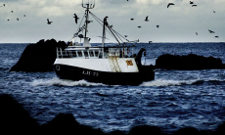
A fishing boat off the Scottish coast, which has seen dramatic declines in cod stocks. Photograph: David Cheskin/PA
Dr. Paul Connolly, who is the director of Fisheries Science Services at the Marine Institute in Galway, advises the commission on "total allowable catches" and in 2013 is due to take over as president of the International Council for the Exploration of the Seas (ICES), the oldest marine scientific body. He said: "Continuous over-fishing has led to a collapse in cod in both these areas. The signs have been there for years and scientists have repeatedly warned quotas must be cut but fisheries ministers have time and time again ignored us. We do not know now whether the stocks will recover."
The continuing crisis in the Common Fisheries Policy, where 88% of European stocks are overexploited and 30% in danger of collapse, has led the commission to label its own policy a failure. It has not achieved any of its objectives: to protect stocks, provide a sustainable food source and help fishing communities to be profitable.
The proposed bans were the most drastic measures the Commission has demanded and are designed to reduce the continued overfishing in many waters controlled by the EU. In all quotas for 53 stocks were reduced.
Maria Damanaki, the commissioner for fisheries, warned that if the EU did not reform the policy and reduce overfishing, only 8% of the 136 fish stocks in EU waters would be at sustainable levels by 2022.
According to ICES two of the biggest fishing nations France and Spain repeatedly failed to provide data on fish landings. This effectively prevented a realistic assessment of how many fish were actually caught and what was the state of the stock.
"The governments concerned say because there is not sufficient scientific evidence available that the stock is going down, then a higher quota should be fixed. Hiding the information is a political ploy to try and get higher quotas," said Connolly. Aware that this is a problem, the Commission has reduced its recommended quotas for some of the major fisheries by up to 25%, to try and force governments to supply scientists with the data.
The Commission's decision puts pressure on governments to accept reforms and bring an end to the system where fishing ministers compete to get the best deal for their home industries without considering long-term consequences. As a result, the average quota for catches is fixed 48% higher than scientists advise.
Mike Parks, from the Scottish White Fish Producers Association, based in north-west Scotland, said a "state of anarchy" still exists in parts of the fishing industry where everyone was out for what they could get from a diminishing stock.
Orkney is becoming Scotland's centre for marine renewable energy
The winds and stormy seas that dominate the 70 islands that make up the Orkneys has shaped the life of islanders as well as the island itself — most evident from the lack of trees or crops able to grow there. Today it's no different; the weather and the climate caused by its open exposure to the Atlantic and North Seas continues to provide inspiration, but this time it's for a new generation of pioneers using the land and sea to produce renewable electricity.
Despite being on the outer fringes of the British Isles, these islands are producing cutting edge wave and tidal technology, demonstrating innovation that's putting the UK on the map as a global leader, and regenerating island communities; bringing new jobs, new skills and creating a strong supply chain. If Scotland is the envy of Europe when it comes to renewable energy then Orkney is the envy of Scotland.
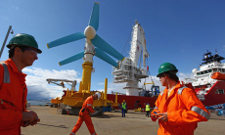
Atlantis's AK-1000 tidal energy turbine is loaded onto a barge to be shipped to a test site off Orkney. Photograph: Jeff J Mitchell/Getty Images
The Scottish National party recently announced the ambitious target of sourcing 100% of our electricity demand from renewables by 2020. Lessons from Orkney about community engagement, supply chain development and research and development will help us reach this target.
Orkney-based companies such as the European Marine Energy Centre (EMEC) are hugely celebrated for their work in the wave and tidal sector. It is the first centre of its kind to offer developers the opportunity to test full scale prototypes in the sea, and no stranger to world firsts. In 2004 Pelamis, a wave power device became the world's first to successfully generate electricity for the National Grid. A few weeks ago the world's largest single-rotor tidal turbine, built by Atlantis, became the first in Scotland to be grid-connected at the marine energy centre. It has also brought visitors and researchers from all over the globe and is attracting people to live, work, and study on the island. EMEC along with companies like Xodus Aurora and ScotRenewables are all employing graduates on Orkney.
These are opportunities which did not previously exist on an island that has traditionally relied on farming and fishing. Where students would have left for university believing they could not return to the Orkneys, there are now real opportunities for returning graduates. Fred. Olsen, the Norwegian-based cruise company that is also involved in renewable energy activities, has just announced four scholarships for Heriot Watt University campus in Stromness. The university is also home to the world's first MSc in marine renewables, with the first intake of students this year.
Anecdotal evidence from those involved with this new industry suggests that already a couple of hundred people are dependent on renewables for their livelihood. All of these benefits come from just a few installed megawatts (MW) of renewable technology. With plans for 1,600MW by 2020 there is genuine potential for many hundreds of jobs, with talk of commuting workers coming in by boat from other islands and Caithness on the Scottish mainland.
There are plenty of examples of how renewable energy is changing the working lives of Orcadians. Two local companies have purchased new work boats on the demand for diving and other services from companies like Aquamarine who are now looking for crew. Tugs dedicated to the Flotta oil terminal are also likely to be increasingly used on marine renewables in future.
The white van drivers on Orkney aren't just the construction workers or delivery guys we know so well on the roads of the mainland. On Orkney the white van man can also be a tidal turbine technician, hinting at what Scotland's workforce may look like in the near future. It's the promise of jobs for this and future generations, inward investment from international companies as well as improved infrastructure, (a former naval base at Lyness has received £3m to upgrade the port for future marine developments) that has helped forge support from local people.
The desire for renewables was made clear after a wind turbine in an industrial estate on the edge of Kirkwall provoked an online petition by opponents. This prompted a rival petition from supporters, which got more signatures than the naysayers, with the turbine now constructed and soon to be operational. Figures available in real time on the Orkney Renewable Energy Forum website show that output from commercial, community and agricultural wind turbines is often so high the island is now self-sufficient in electricity, relying less on imported fossil-fuel based power from the mainland.
Like many of Scotland's islands, tourism plays a key role in the local economy. With so many wave and tidal devices working in the waters, Orkney Council has had to train local tour guides on marine renewables to help deal with questions from tourists. EMEC is now looking at converting office space to help educate and inform the visitors that burst into their office anxious to hear more about these strange looking devices in the waters off the islands.
Like centuries of islanders before them, Orcadians have come to use their natural environment to support and sustain their way of life. If you want to know what Scotland could look like in 10 years then take the 90-minute ferry journey from Scrabster to Stromness and find out.
Yes
No
Other
If other or you have any general comments please make them here.
Yes
No
Other
If other or you have any general comments please make them here.
Yes
No
Other
If other or you have any general comments please make them here.